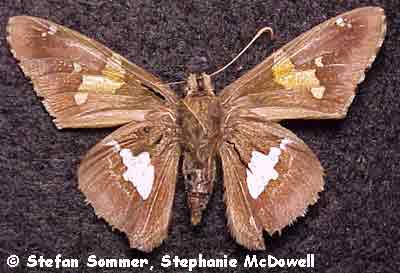
Silver-Spotted Skippe
Family: Hesperiidae
Sub-Family Description:
Description:
Caterpillar: The caterpillar is yellowish green, striped around the body with dark rings, with a reddish black head spotted with yellowish orange. The legs and "throat" region (behind the head on the underside) are reddish.
Adult: This is a fairly large skipper, with a wingspan of 1 3/4 to 2 5/8 inches. The upperside is several different shades of brown, with transparent patches of golden yellow on the main portion of the forewing and several spots near the tip. The hindwing has a small lobe (rounded projection) extending off the bottom portion. Underneath is brownish, with a fairly large white to silver patch on the hindwing.
Range:
This is a widespread species of the U.S., ranging from the extreme northeast through the entire eastern half of the U.S., and west to the north Pacific Coast and parts of California and the southwest. It is found scattered throughout Idaho.
Habitat:
It can be found in canyons, open woodlands, prairies, and along streams.
Diet:
Caterpillar: Caterpillars eat the leaves of a variety of tree and herbaceous legumes, including locusts (Robinia and Gleditsia spp.), tick-trefoils (Desmodium spp.), and beans (Phaseolus spp.).
Adult: Butterflies drink flower nectar, typically from flowers colored blue, red, pink, or purple.
Ecology:
Young caterpillars live in shelters made from folded leaves, while older caterpillars live in nests made of silk and leaves. The number of generations of caterpillars each summer depends on the location, with one in the north and west, two in the east, and three or four in the south. Pupae overwinter in a physiological state called diapause. In the case of multiple generations of caterpillars in a single growing season, only the last generation overwinters after pupating. Adults generally fly from late May to July. Butterflies hang upside down from leaves.
Reproduction:
Males perch to wait for receptive females, or may actively patrol for them. Females lay greenish eggs singly on the leaves of host plants or on plants near host species.
Conservation:
| Global Rank: | G5 populations are widespread, abundant, and secure. |
References:
Ferris, C. D. and F. M. Brown. (eds.) 1981. Butterflies of the Rocky Mountain States. Univ. of Oklahoma Press, Norman, Oklahoma, 442 pp.
Opler, P. A., H. Pavulaan, and R. E. Stanford. 1995. Butterflies of North America. Jamestown, North Dakota, USA: Northern Prairie Wildlife Research Center Home Page. http://www.npwrc.usgs.gov/resource/distr/lepid/bflyusa/bflyusa.htm (Version 05Nov98).
Opler, P. A. and A. B.Wright. 1999. A Field Guide to the Western Butterflies. Second Edition. Peterson Field Guide Series. Houghton Mifflin Company, New York, New York, USA, 540 pp.
Pyle, R. M. 1981. National Audubon Society Field Guide to North American Butterflies. Alfred A. Knopf, Inc., New York, New York, USA, 924 pp.
Scott, J. A. 1986. The Butterflies of North America. Stanford University Press, Stanford, California, USA, 583 pp.
Stanford, R. E. and P. A. Opler. 1993. Atlas of Western U.S.A. Butterflies (Including Adjacent Parts of Canada and Mexico). Published by authors, Denver, Colorado, USA, 275 pp.
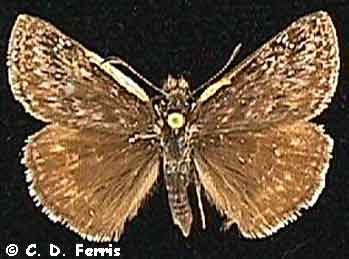
Afranius Duskywing
Family: Hesperiidae.
Family Description:
Alternate Common Name: Bald Duskywing
Description:
Caterpillar: The caterpillar is light green, dotted with white, and striped lengthwise with a dark line along the back and yellow on either side. The head is black, also dotted with white, with an orange and black "face."
Adult: This is a small to medium-sized skipper, with a wingspan of 1 to 1 3/8 inches. It is medium to dark brown on the upperside, with the forewing marked with white shading and streaks (males more than females). Males from the season’s spring brood tend to have more white on the forewing than males occurring later in the summer. The hindwing is edged with a pale-tipped fringe of short hairs. Underneath is light to dark brown, with white spots and shading near the outer edges of the wings. Males have a small fold (called a costal fold) on the front inside edge of the forewing, which covers yellow scent scales. Males also possess long "hairs" on the upper sections of the hind legs, called tibial tufts, used to direct pheromones towards a female during courtship.
Range:
This species ranges from southern Alberta and Saskatchewan south to Mexico, with an isolated population in southern California. It occurs in isolated patches in Idaho.
Habitat:
It occurs in open areas such as prairies and forest openings and edges.
Diet:
Caterpillar: Caterpillars feed on the leaves of certain legume species, including lupine (Lupinus spp.), milk vetch (Astragalus spp.), and lotus (Lotus spp.).
Adult: Butterflies drink flower nectar.
Ecology:
Caterpillars live in nests made from leaves rolled or tied together with silk. There are two generations of caterpillars each year in most of the range, and possibly more in the Californian population. The overwintering stage has not been observed or reported. Adults generally fly from March through August.
Reproduction:
Males perch to wait for receptive females. Females lay eggs singly under the leaves of host plants.
Conservation:
| Global Rank: | G5 population levels are secure, but may be of concern in the future |
References:
Ferris, C. D. and F. M. Brown. (eds.) 1981. Butterflies of the Rocky Mountain States. Univ. of Oklahoma Press, Norman, Oklahoma, USA, 442 pp.
Opler, P. A., H. Pavulaan, and R. E. Stanford. 1995. Butterflies of North America. Jamestown, North Dakota, USA: Northern Prairie Wildlife Research Center Home Page. http://www.npwrc.usgs.gov/resource/distr/lepid/bflyusa/bflyusa.htm (Version 05Nov98).
Opler, P. A. and A. B.Wright. 1999. A Field Guide to the Western Butterflies. Second Edition. Peterson Field Guide Series. Houghton Mifflin Company, New York, New York, USA, 540 pp.
Pyle, R. M. 1981. National Audubon Society Field Guide to North American Butterflies. Alfred A. Knopf, Inc., New York, New York, USA, 924 pp.
Scott, J. A. 1986. The Butterflies of North America. Stanford University Press, Stanford, California, USA, 583 pp.
Stanford, R. E. and P. A. Opler. 1993. Atlas of Western U.S.A. Butterflies (Including Adjacent Parts of Canada and Mexico). Published by authors, Denver, Colorado, USA, 275 pp.
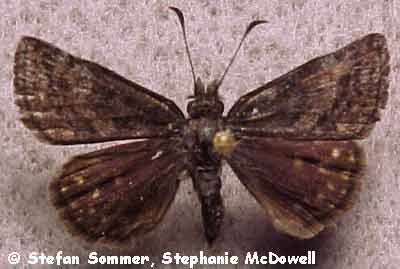
Dreamy Duskywing
Family: Hesperiidae
Family Description:
Alternate Common Name: Aspen Duskywing.
Description:
Caterpillar: The caterpillar is light green, dotted with white, and covered with short hairs. The body is marked lengthwise with a dark line along the back and a white stripe along the side. The head is black and may be marked with red, orange, or yellow.
Adult: This is a medium-sized skipper, with a wingspan of 1 to 1 ½ inches. It is dark brown on the upperside. The forewing is marked with gray to brown hazy spots that form a band, outlined in black; the wing appears dusted with gray or silver. The hindwing is slightly lighter in color and has two rows of hazy white dots along the outside edge. Underneath is similarly marked but paler in color. Males have a small fold (called a costal fold) on the front inside edge of the forewing, which covers yellow scent scales. Males also possess long "hairs" called tibial tufts on the upper sections of the hind legs. They are used to direct pheromones towards a female during courtship. The head has two noticeable, furry appendages (called palpi) that project straight ahead.
Range:
This species ranges in Canada from northern Alberta south and east to Nova Scotia. In the U.S., its range extends through the Pacific Northwest south into eastern California and patchily in the southwest, east across Montana and North Dakota, and throughout the eastern third of the U.S. as far south as northern Georgia. It occurs through much of Idaho.
Habitat:
It occurs in open areas such as sagebrush steppe, mountain meadows, and forest edges and openings.
Diet:
Caterpillar: Caterpillars eat the leaves of willows (Salix spp.), poplars (Populus spp.), birches (Betula spp.), and locusts (Robinia spp.).
Adult: Butterflies drink flower nectar from a variety of preferred species, including hawkweed (Hieracium spp.), blueberry (Vaccinium spp.), dogbane (Apocynum spp.), and lupine (Lupinus spp.).
Ecology:
Caterpillars make nests of leaves and silk. There is usually only one generation of caterpillars each summer, but there may be two in the southeastern parts of its range. Older caterpillars overwinter in a physiological state called diapause. Adults fly from April to early July.
Reproduction:
Males perch to wait for receptive females, and may occasionally actively patrol for them. Females lay green eggs singly on the new leaves of young host plants. The eggs become pink before hatching.
Conservation:
| Global Rank: | G5 populations are widespread, abundant, and secure. |
References:
Ferris, C. D. and F. M. Brown. (eds.) 1981. Butterflies of the Rocky Mountain States. Univ. of Oklahoma Press, Norman, Oklahoma, USA, 442 pp.
Opler, P. A., H. Pavulaan, and R. E. Stanford. 1995. Butterflies of North America. Jamestown, North Dakota, USA: Northern Prairie Wildlife Research Center Home Page. http://www.npwrc.usgs.gov/resource/distr/lepid/bflyusa/bflyusa.htm (Version 05Nov98).
Opler, P. A. and A. B.Wright. 1999. A Field Guide to the Western Butterflies. Second Edition. Peterson Field Guide Series. Houghton Mifflin Company, New York, New York, USA, 540 pp.
Pyle, R. M. 1981. National Audubon Society Field Guide to North American Butterflies. Alfred A. Knopf, Inc., New York, New York, USA, 924 pp.
Scott, J. A. 1986. The Butterflies of North America. Stanford University Press, Stanford, California, USA, 583 pp.
Stanford, R. E. and P. A. Opler. 1993. Atlas of Western U.S.A. Butterflies (Including Adjacent Parts of Canada and Mexico). Published by authors, Denver, Colorado, USA, 275 pp.
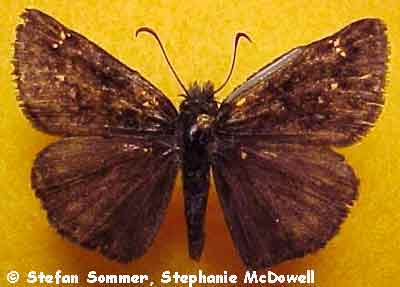
Pacuvius Duskywing
Family: Hesperiidae.
Sub-Family Description:
Description:
Caterpillar: The caterpillar is light green, dotted with white, and has short hair. The head is black and marked with red, orange, or yellow.
Adult: This skipper is medium-sized to fairly large, with a wingspan of 1 1/4 to 1 3/8 inches. It is dark brown to black on the upperside. The forewing is marked with irregular brown, gray and black spots or bands, and a row of hazy white dots along the outside edge. The hindwing varies in color, from brown to gray to black, has little to no markings, and has a light brown or white fringe. Males have a small fold, called a costal fold, on the front inside edge of the forewing, which covers yellow scent scales. They lack the hindleg "hair" (tibial tuft) found on other duskywings.
Range:
This species displays a patchy range, from southern British Columbia south through California, and in parts of the southwestern U.S. down to Mexico. It occurs in Idaho mainly in the north.
Habitat:
Its preferred habitats include open woodlands, chaparral, and mountain meadows.
Diet:
Caterpillar: Caterpillars feed on various species of buck brush (Ceanothus spp.).
Adult: Butterflies drink flower nectar, often from buck brush (Ceanothus spp.).
Ecology:
There is typically one generation of caterpillars each growing season in the north and two in the south. Caterpillars overwinter in a physiological state called diapause. Adults generally fly from May through July.
Reproduction:
Males perch to wait for receptive females, or may actively patrol for them if competition is heavy. Females lay green eggs on host plants. The eggs turn pink before hatching.
Conservation:
| Global Rank: | G5 populations levels are secure, but may be of concern in the future. |
References:
Ferris, C. D. and F. M. Brown. (eds.) 1981. Butterflies of the Rocky Mountain States. Univ. of Oklahoma Press, Norman, Oklahoma, USA, 442 pp.
Opler, P. A., H. Pavulaan, and R. E. Stanford. 1995. Butterflies of North America. Jamestown, North Dakota, USA: Northern Prairie Wildlife Research Center Home Page. http://www.npwrc.usgs.gov/resource/distr/lepid/bflyusa/bflyusa.htm (Version 05Nov98).
Opler, P. A. and A. B.Wright. 1999. A Field Guide to the Western Butterflies. Second Edition. Peterson Field Guide Series. Houghton Mifflin Company, New York, New York, USA, 540 pp.
Pyle, R. M. 1981. National Audubon Society Field Guide to North American Butterflies. Alfred A. Knopf, Inc., New York, New York, USA, 924 pp.
Scott, J. A. 1986. The Butterflies of North America. Stanford University Press, Stanford, California, USA, 583 pp.
Stanford, R. E. and P. A. Opler. 1993. Atlas of Western U.S.A. Butterflies (Including Adjacent Parts of Canada and Mexico). Published by authors, Denver, Colorado, USA, 275 pp.
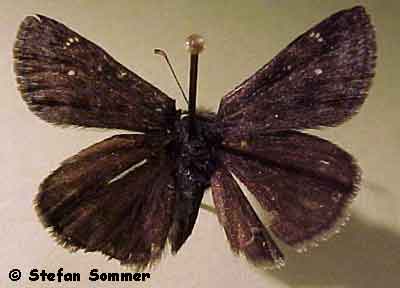
Persius Duskywing
Family: Hesperiidae
Family Description:
Alternate Common Name: Hairy Duskywing.
Description:
Caterpillar: The caterpillar is light green, dotted with white, and covered with hairs. It is marked lengthwise with a dark green stripe along the back and a yellowish stripe along the side. The head is red to yellow and marked with white.
Adult: This is a medium-sized skipper, with a wingspan of 1 to 1 5/8 inches. It is light to dark brown on the upperside. The forewing is marked with light dots and hazy streaks. Males have a small fold (called a costal fold) on the front inside edge of the forewing, which covers yellow scent scales, and their forewing is noticeably hairy. Males also possess long "hairs" on the upper sections of the hind legs, called tibial tufts, used to direct pheromones towards a female during courtship. The hindwing of both sexes is lightly marked with rows of hazy black and brown spots. Underneath is similarly marked but paler in color.
Range:
This species has a fairly large western range and a smaller range in the east. In the west, it ranges from central Alaska south through the western half of Canada and the northwestern U.S., extending patchily into northern California and the southwest. In the east, it ranges from Wisconsin west to the north Atlantic states, and south to the Appalachian Mountains. It occurs throughout most of Idaho.
Habitat:
It can be found in a variety of open areas, such as grasslands, open woodlands, and sandy plains.
Diet:
Caterpillar: In the east, the caterpillar feeds on the leaves of lupine (Lupinus spp.), and possibly willows (Salix spp.) and poplars (Populus spp.); in the west, hosts are legumes including golden banner (Thermopsis spp.) and lotus (Lotus spp.).
Adult: Butterflies drink flower nectar.
Ecology:
Caterpillars live in nests made from leaves rolled or tied with silk. In most of its range, there is one generation of caterpillars each growing season; there may be two or more in California. Older caterpillars overwinter in a physiological state called diapause. Adults fly from April through June.
Reproduction:
Males perch to wait for receptive females. Females lay green eggs singly on the undersides of leaves of the host plant. The egg turns pink before hatching.
Conservation:
| Global Rank: | G5 populations levels are secure, but may be of concern in the future. |
References:
Ferris, C. D. and F. M. Brown. (eds.) 1981. Butterflies of the Rocky Mountain States. Univ. of Oklahoma Press, Norman, Oklahoma, USA, 442 pp.
Opler, P. A., H. Pavulaan, and R. E. Stanford. 1995. Butterflies of North America. Jamestown, North Dakota, USA: Northern Prairie Wildlife Research Center Home Page. http://www.npwrc.usgs.gov/resource/distr/lepid/bflyusa/bflyusa.htm (Version 05Nov98).
Opler, P. A. and A. B.Wright. 1999. A Field Guide to the Western Butterflies. Second Edition. Peterson Field Guide Series. Houghton Mifflin Company, New York, New York, USA, 540 pp.
Pyle, R. M. 1981. National Audubon Society Field Guide to North American Butterflies. Alfred A. Knopf, Inc., New York, New York, USA, 924 pp.
Scott, J. A. 1986. The Butterflies of North America. Stanford University Press, Stanford, California, USA, 583 pp.
Stanford, R. E. and P. A. Opler. 1993. Atlas of Western U.S.A. Butterflies (Including Adjacent Parts of Canada and Mexico). Published by authors, Denver, Colorado, USA, 275 pp.
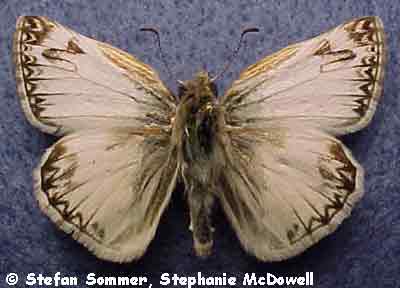
Northern White-Skipper
Family: Hesperiidae
Family Description:
Alternate Common Names: Large White Skipper, Great Basin White Skipper.
Description:
Caterpillar: The caterpillar is yellow-green and marked lengthwise with yellow and green stripes. The head is black and covered with hair.
Adult: This skipper is medium-sized, with a wingspan of 1 1/8 to 1 1/2 inches. It is creamy white on the upperside, and marked with bluish gray where the wings attach to the body. There are one or two rows of blackish ">"-shaped marks along the outer edge of the wings. Females may have extensive blackish markings. Underneath is creamy white to beige and marked with tan to light brown. The wing fringes above and below have a faint checkered appearance.
Range:
This species occurs in patches of the western U.S., including eastern Washington, parts of Idaho, and Nevada and Utah, extending into parts of Colorado, Arizona, and New Mexico; also through much of California.
Habitat:
It occurs in open areas including woodlands, chaparral, deserts, and rocky areas along waterways.
Diet:
Caterpillar: Caterpillars feed on the leaves of members of the mallow family (Malvaceae), such as hollyhock (Althaea spp.) and globemallow (Sphaeralcea spp.).
Adult: Butterflies feed on flower nectar.
Ecology:
Caterpillars live in shelters made of leaves rolled or tied with silk. There are multiple generations of caterpillars every year. The stage that overwinters has not been reported by scientists. Adults fly from April through October.
Reproduction:
Males actively patrol in search of receptive females, often in canyon bottoms. Females lay yellow eggs singly on new leaves of host plants. The eggs turn white before hatching.
Conservation:
| Global Rank: | G5 populations levels are secure, but may be of concern in the future. |
References:
Ferris, C. D. and F. M. Brown. (eds.) 1981. Butterflies of the Rocky Mountain States. Univ. of Oklahoma Press, Norman, Oklahoma, USA, 442 pp.
Opler, P. A., H. Pavulaan, and R. E. Stanford. 1995. Butterflies of North America. Jamestown, North Dakota, USA: Northern Prairie Wildlife Research Center Home Page. http://www.npwrc.usgs.gov/resource/distr/lepid/bflyusa/bflyusa.htm (Version 05Nov98).
Opler, P. A. and A. B.Wright. 1999. A Field Guide to the Western Butterflies. Second Edition. Peterson Field Guide Series. Houghton Mifflin Company, New York, New York, USA, 540 pp.
Pyle, R. M. 1981. National Audubon Society Field Guide to North American Butterflies. Alfred A. Knopf, Inc., New York, New York, USA, 924 pp.
Scott, J. A. 1986. The Butterflies of North America. Stanford University Press, Stanford, California, USA, 583 pp.
Stanford, R. E. and P. A. Opler. 1993. Atlas of Western U.S.A. Butterflies (Including Adjacent Parts of Canada and Mexico). Published by authors, Denver, Colorado, USA, 275 pp.
Mohave Sootywing
Family: Hesperiidae
Family Description:
Alternate Common Name: Great Basin Sootywing.
Note: This species is referred to with the genus name Pholisora by some authors.
Description:
Caterpillar: The caterpillar is colorful – bluish green, dotted with black and covered with white bristles. The head is black and is covered with short red hair.
Adult: This is a small to medium-sized skipper, with a wingspan of 7/8 to 1 1/4 inches. It is dark brown to black on the upperside and fringed with white along the edges of the wings. The forewing is marked with two small rows of white spots; the hindwing may have a few white dots as well. Underneath is golden brown, and marked with small white dots on the tip of the forewing and one or two curved rows of white spots on the hindwing.
Range:
This species ranges from eastern Oregon south through California and Nevada to Mexico, and from eastern Montana and western North Dakota southwest through parts of Wyoming, Colorado, Utah, and Arizona. It occurs in Idaho only in the southwestern corner of the state.
Habitat:
It is restricted to dry areas with little relief, such as flat sagebrush steppe and deserts.
Diet:
Caterpillar: Caterpillars feed on the leaves of four-winged salt bush (Atriplex canescens) and shadscale (other Atriplex spp.).
Adult: Butterflies feed on flower nectar.
Ecology:
Caterpillars live in nests made from leaves tied with silk. The number of generations of caterpillars each year varies geographically, with only one in the northern part of its range, two in the central part, and several in the south. The overwintering stage is unreported. Adults generally fly from March through October.
Reproduction:
Males actively patrol in search of receptive females. Females lay large eggs, colored light orange or off-white, singly on host plant leaves.
Conservation:
| Global Rank: | G5 populations are widespread, abundant, and secure. |
References:
Ferris, C. D. and F. M. Brown. (eds.) 1981. Butterflies of the Rocky Mountain States. Univ. of Oklahoma Press, Norman, Oklahoma, USA, 442 pp.
Opler, P. A., H. Pavulaan, and R. E. Stanford. 1995. Butterflies of North America. Jamestown, North Dakota, USA: Northern Prairie Wildlife Research Center Home Page. http://www.npwrc.usgs.gov/resource/distr/lepid/bflyusa/bflyusa.htm (Version 05Nov98).
Opler, P. A. and A. B.Wright. 1999. A Field Guide to the Western Butterflies. Second Edition. Peterson Field Guide Series. Houghton Mifflin Company, New York, New York, USA, 540 pp.
Pyle, R. M. 1981. National Audubon Society Field Guide to North American Butterflies. Alfred A. Knopf, Inc., New York, New York, USA, 924 pp.
Scott, J. A. 1986. The Butterflies of North America. Stanford University Press, Stanford, California, USA, 583 pp.
Stanford, R. E. and P. A. Opler. 1993. Atlas of Western U.S.A. Butterflies (Including Adjacent Parts of Canada and Mexico). Published by authors, Denver, Colorado, USA, 275 pp.
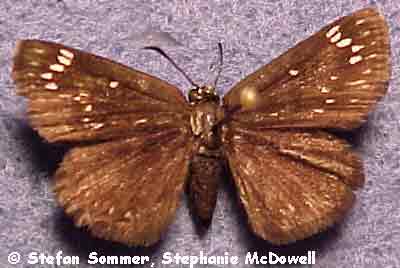
Common Sootywing
Family: Hesperiidae
Family Description:
Alternate Common Name: Roadside Rambler.
Description:
Caterpillar: The caterpillar is light to yellowish green, marked with yellowish dots, each dot with a tiny hair. The head is black and hairy.
Adult: This is a fairly small skipper, with a wingspan of 1 to 1¼ inches. It is brownish black to black on the upperside, with very few markings – only a scattering of small white dots on the forewing. The hindwing is typically solid black or brown; however, females may have a row of white spots. Underneath is similarly marked. Because the underside is dark, the white on the underside of the head and thorax region is striking.
Range:
This widespread species ranges from southern Canada south through the U.S. to central Mexico. It does not occur along the Pacific coast, in parts of the deserts of the southwest, or in the peninsula of Florida. It can be found in much of Idaho.
Habitat:
It utilizes a variety of open habitats including fields, pastures, gardens, and disturbed or waste areas.
Diet:
Caterpillar: Caterpillars feed on the leaves of three common plant genera: lamb’s-quarters (Chenopodium spp.), amaranths (Amaranthus spp.), and cock’s comb (Celosia spp.).
Adult: Butterflies drink flower nectar, most often from flowers close to the ground.
Ecology:
Caterpillars construct shelters from leaves rolled and tied with silk. There are two generations of caterpillars each growing season. Those from the second generation overwinter in their leaf shelters, in a physiological state called diapause. Adults generally fly from May through August. Butterflies often bask in the sun with their wings open.
Reproduction:
Males actively patrol in search of receptive females. Females lay eggs singly on the uppersides of host plant leaves.
Conservation:
| Global Rank: | G5 populations are widespread, abundant, and secure. |
References:
Ferris, C. D. and F. M. Brown. (eds.) 1981. Butterflies of the Rocky Mountain States. Univ. of Oklahoma Press, Norman, Oklahoma, USA, 442 pp.
Opler, P. A., H. Pavulaan, and R. E. Stanford. 1995. Butterflies of North America. Jamestown, North Dakota, USA: Northern Prairie Wildlife Research Center Home Page. http://www.npwrc.usgs.gov/resource/distr/lepid/bflyusa/bflyusa.htm (Version 05Nov98).
Opler, P. A. and A. B.Wright. 1999. A Field Guide to the Western Butterflies. Second Edition. Peterson Field Guide Series. Houghton Mifflin Company, New York, New York, USA, 540 pp.
Pyle, R. M. 1981. National Audubon Society Field Guide to North American Butterflies. Alfred A. Knopf, Inc., New York, New York, USA, 924 pp.
Scott, J. A. 1986. The Butterflies of North America. Stanford University Press, Stanford, California, USA, 583 pp.
Stanford, R. E. and P. A. Opler. 1993. Atlas of Western U.S.A. Butterflies (Including Adjacent Parts of Canada and Mexico). Published by authors, Denver, Colorado, USA, 275 pp.
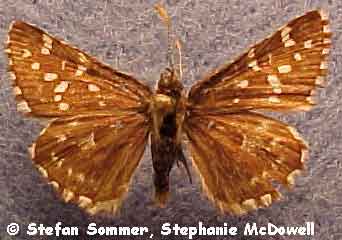
Grizzled Skipper
Family: Hesperiidae
Family Description:
Alternate Common Name: Alpine Checkered Skipper.
Description:
Caterpillar: Scientists currently have not described the caterpillar in detail.
Adult: This skipper is fairly small to medium-sized, with a wingspan of 1 to 1 ½ inches. It varies slightly in its size and color according to location, with western individuals being larger and paler than those found in the east. Typically, the upperside is dark brown and marked with white square-shaped spots; the hindwing has fewer and less distinct spots than the forewing. There may be a patch of short yellow hairs on the wings above, and there is a black-and-white checkered fringe as a border. Underneath is grayish brown and checked with white; the white marks may form continuous bands. The fringe from below is noticeably black-and-white checked. Males possess scent scales, used in attracting females, in a small, folded over section of the leading edge of the forewing (called a costal fold). Males also have tibial tufts, specialized hairs on the fourth segment of the hind leg, which are used to waft pheromones (sex attractant chemicals) to a female during mating. The hairs are tucked into special pockets on the body during flight.
Range:
This species ranges from central Alaska south and east to Manitoba and Ontario, and throughout northeastern Canada. It also extends through British Columbia to northern Washington, central Idaho, and western Montana. Isolated populations occur in the Rockies, Great Lakes, and Appalachians.
Habitat:
The preferred habitat varies across its Range: mountainous or subarctic coniferous forests in the west and north, scrubby oak woodlands in the Great Lakes, and heath or pine barrens in the east.
Diet:
Caterpillar: Caterpillars feed on members of the rose family (Rosaceae), such as cinquefoils (Potentilla spp.), wild strawberry (Fragaria virginiana), and blackberry (Rubus chamaemorus).
Adult: Butterflies drink flower nectar, often from yellow flowers.
Ecology:
There is one generation of caterpillars each summer. Caterpillars construct feeding shelters from leaves tied with silk. While the overwintering stage is not verified, it is believed that in some parts of its range (primarily the far north), individuals require two years to fully develop. Adults generally fly from May to August.
Reproduction:
Males actively patrol and may occasionally perch to wait for receptive females. Females lay eggs singly on the leaves of host plants.
Conservation:
| Global Rank: | G5 populations are widespread, abundant, and secure.However, the subspecies P. centaureae wyandot in the east may be declining. |
References:
Ferris, C. D. and F. M. Brown. (eds.) 1981. Butterflies of the Rocky Mountain States. Univ. of Oklahoma Press, Norman, Oklahoma, USA, 442 pp.
Opler, P. A., H. Pavulaan, and R. E. Stanford. 1995. Butterflies of North America. Jamestown, North Dakota, USA: Northern Prairie Wildlife Research Center Home Page. http://www.npwrc.usgs.gov/resource/distr/lepid/bflyusa/bflyusa.htm (Version 05Nov98).
Opler, P. A. and A. B.Wright. 1999. A Field Guide to the Western Butterflies. Second Edition. Peterson Field Guide Series. Houghton Mifflin Company, New York, New York, USA, 540 pp.
Pyle, R. M. 1981. National Audubon Society Field Guide to North American Butterflies. Alfred A. Knopf, Inc., New York, New York, USA, 924 pp.
Scott, J. A. 1986. The Butterflies of North America. Stanford University Press, Stanford, California, USA, 583 pp.
Stanford, R. E. and P. A. Opler. 1993. Atlas of Western U.S.A. Butterflies (Including Adjacent Parts of Canada and Mexico). Published by authors, Denver, Colorado, USA, 275 pp.
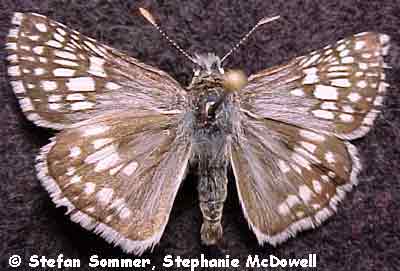
Common Checkered-Skipper
Family: Hesperiidae
Family Description:
Alternate Common Name: Checkered Skipper.
Note: This species represents a complex of several subspecies.
Description:
Caterpillar: The caterpillar varies in color from yellowish to light brown, and is dotted with white. It is marked lengthwise with brown and white lines along the sides. The head is black and covered with reddish brown hairs.
Adult: This is a small to medium-sized skipper, with a wingspan of ¾ to 1 ½ inches. It varies in its appearance, between the sexes and between individuals in general. Males: The upperside of the male is grayish brown and marked with bands of whitish checks. There are two rows of dots near the edge of the wings, with the dots in the innermost row being the largest. The body and wing bases may appear covered with grayish or bluish hair. Males possess scent scales, used in attracting females, in a small, folded over section of the leading edge of the forewing (called a costal fold). Males of this species complex also have tibial tufts, specialized hairs on the fourth segment of the hind leg, which are used to waft pheromones (sex attractant chemicals) to a female during mating; however, males of the subspecies common to our area often lack these tufts. Females: Females tend to be darker than males on the upperside, and are marked with scattered white checks on the forewing and fewer checks, possibly appearing cloudy, on the hindwing. Underneath, both sexes are grayish white and marked with uneven bands of brown or greenish gray. Both above and below, the wings are fringed with black-and-white checks.
Range:
This widespread species ranges throughout the entire U.S., extending north as far south central Canada and south into South America. It can be found in most of Idaho.
Habitat:
It occurs in a variety of open habitats, such as fields, prairies, woodland openings, and disturbed areas.
Diet:
Caterpillar: Caterpillars feed on the leaves of several species of wild and cultivated mallows (Malva spp., Sphaeralcea spp., Althaea spp., and other species).
Adult: Butterflies drink flower nectar, often from white flowers belonging to the sunflower family (Asteraceae), and also obtain moisture and salts from mud.
Ecology:
There are many generations of caterpillars each spring and summer in most of its range, and year-round in the south. Caterpillars construct shelters from folded leaves tied with silk. Older caterpillars overwinter in a physiological state called diapause. Where winters are particularly harsh, they cannot survive. Adults re-colonize these areas each year. Adults generally fly from February to November. The butterflies when at rest are found with their forewings partially open and their hindwings fully open. Male butterflies are aggressive and defend territories.
Reproduction:
Males both perch and actively patrol, typically in the afternoon, for receptive females. Females lay pale greenish white or greenish blue eggs singly on leaf buds and the topsides of mature leaves. The eggs turn cream-colored before hatching.
Conservation:
| Global Rank: | G5 populations are widespread, abundant, and secure. |
References:
Ferris, C. D. and F. M. Brown. (eds.) 1981. Butterflies of the Rocky Mountain States. Univ. of Oklahoma Press, Norman, Oklahoma, USA, 442 pp.
Opler, P. A., H. Pavulaan, and R. E. Stanford. 1995. Butterflies of North America. Jamestown, North Dakota, USA: Northern Prairie Wildlife Research Center Home Page. http://www.npwrc.usgs.gov/resource/distr/lepid/bflyusa/bflyusa.htm (Version 05Nov98).
Opler, P. A. and A. B.Wright. 1999. A Field Guide to the Western Butterflies. Second Edition. Peterson Field Guide Series. Houghton Mifflin Company, New York, New York, USA, 540 pp.
Pyle, R. M. 1981. National Audubon Society Field Guide to North American Butterflies. Alfred A. Knopf, Inc., New York, New York, USA, 924 pp.
Scott, J. A. 1986. The Butterflies of North America. Stanford University Press, Stanford, California, USA, 583 pp.
Stanford, R. E. and P. A. Opler. 1993. Atlas of Western U.S.A. Butterflies (Including Adjacent Parts of Canada and Mexico). Published by authors, Denver, Colorado, USA, 275 pp.
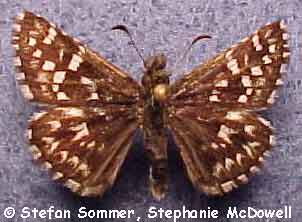
Two-Banded Checkered-Skipper
Family: Hesperiidae
Family Description:
Description:
Caterpillar: Scientists currently have not described the caterpillar in detail.
Adult: This is a small skipper, with a wingspan of one inch. The upperside is brown to blackish brown; the forewing is marked with scattered, white, square-shaped spots, while the hindwing’s white spots are arranged in two rows. The hindwing also has a small white spot near its base. Underneath is brown to gray, spotted with white. The underside of the hindwing is often marked with a row of white "<"-shaped spots. Above and below, the wing edges are bordered with a black-and-white checked fringe. Males posses scent scales, used in attracting females, in a small, folded over section of the leading edge of the forewing (called a costal fold). Males also have tibial tufts, specialized hairs on the fourth segment of the hind leg, which are used to waft pheromones (sex attractant chemicals) to a female during mating. The hairs are tucked into special pockets on the body during flight.
Range:
This western species ranges from southern British Columbia through the Pacific Northwest to central California, and east through Idaho and western Montana to parts of Utah, Wyoming, and Colorado.
Habitat:
It is typically found in mountain meadows and forest openings.
Diet:
Caterpillar: Caterpillars feed on certain members of the rose family (Rosaceae), including horkelia (Horkelia spp.) and cinquefoil (Potentilla spp.).
Adult: Butterflies drink flower nectar.
Ecology:
There is one generation of caterpillars each summer. Caterpillars construct shelters from leaves tied with silk. The overwintering stage is unreported. Adults generally fly from May to mid-July. Butterflies tend to remain fairly local and are uncommon.
Reproduction:
Males perch and actively patrol in search of receptive females. Females lay yellow or green eggs on host plants.
Conservation:
| Global Rank: | G5 most populations are secure, but may be of concern in the future. Subspecies P. ruralis lagunae of California is listed as Endangered. |
References:
Ferris, C. D. and F. M. Brown. (eds.) 1981. Butterflies of the Rocky Mountain States. Univ. of Oklahoma Press, Norman, Oklahoma, USA, 442 pp.
Opler, P. A., H. Pavulaan, and R. E. Stanford. 1995. Butterflies of North America. Jamestown, North Dakota, USA: Northern Prairie Wildlife Research Center Home Page. http://www.npwrc.usgs.gov/resource/distr/lepid/bflyusa/bflyusa.htm (Version 05Nov98).
Opler, P. A. and A. B.Wright. 1999. A Field Guide to the Western Butterflies. Second Edition. Peterson Field Guide Series. Houghton Mifflin Company, New York, New York, USA, 540 pp.
Pyle, R. M. 1981. National Audubon Society Field Guide to North American Butterflies. Alfred A. Knopf, Inc., New York, New York, USA, 924 pp.
Scott, J. A. 1986. The Butterflies of North America. Stanford University Press, Stanford, California, USA, 583 pp.
Stanford, R. E. and P. A. Opler. 1993. Atlas of Western U.S.A. Butterflies (Including Adjacent Parts of Canada and Mexico). Published by authors, Denver, Colorado, USA, 275 pp.
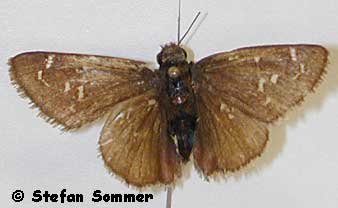
Mexican Cloudywing
Family: Hesperiidae
Family Description:
Alternate Common Name: Mountain Cloudywing.
Note: Some authors refer to this species with a new but similar name, T. mexicanus.
Description:
Caterpillar: Scientists currently have not described the caterpillar in detail.
Adult: This is a medium-sized skipper, with a wingspan of 1 1/8 to 1 1/2 inches. The upperside is brown and marked with a scattering of white spots and small bars on the forewing. The wings are fringed with brownish gray or may have a checkerboard appearance. The underside is brown, faintly mottled with dark brown, and frosted with gray at the outer edges. The forewing spots from above show through.
Range:
This species occurs only at high elevations in Oregon south through California, and southeastern Idaho south to Mexico.
Habitat:
It can be found in alpine and subalpine meadows and clearings.
Diet:
Caterpillar: Caterpillars feed on legume species including clover (Trifolium spp.), vetch (Vicia spp.), and wild pea (Lathyrus spp.).
Adult: Butterflies drink flower nectar.
Ecology:
There is one generation of caterpillars each year. The overwintering stage has not been reported. Adults generally fly from the end of April through August.
Reproduction:
Males perch on hilltops all day to wait for receptive females. Eggs are laid singly under the leaves of host plants.
Conservation:
| Global Rank: | G5 populations levels are secure, but may be of concern in the future. |
References:
Ferris, C. D. and F. M. Brown. (eds.) 1981. Butterflies of the Rocky Mountain States. Univ. of Oklahoma Press, Norman, Oklahoma, USA, 442 pp.
Opler, P. A., H. Pavulaan, and R. E. Stanford. 1995. Butterflies of North America. Jamestown, North Dakota, USA: Northern Prairie Wildlife Research Center Home Page. http://www.npwrc.usgs.gov/resource/distr/lepid/bflyusa/bflyusa.htm (Version 05Nov98).
Opler, P. A. and A. B.Wright. 1999. A Field Guide to the Western Butterflies. Second Edition. Peterson Field Guide Series. Houghton Mifflin Company, New York, New York, USA, 540 pp.
Pyle, R. M. 1981. National Audubon Society Field Guide to North American Butterflies. Alfred A. Knopf, Inc., New York, New York, USA, 924 pp.
Scott, J. A. 1986. The Butterflies of North America. Stanford University Press, Stanford, California, USA, 583 pp.
Stanford, R. E. and P. A. Opler. 1993. Atlas of Western U.S.A. Butterflies (Including Adjacent Parts of Canada and Mexico). Published by authors, Denver, Colorado, USA, 275 pp.
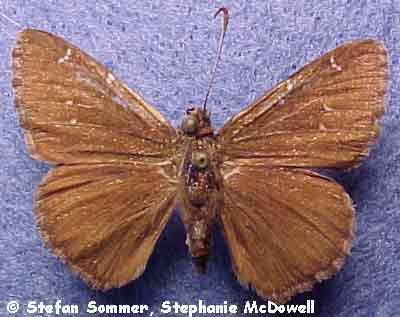
Northern Cloudywing
Family: Hesperiidae
Family Description:
Alternate Common Name: Cloudy Wing.
Description:
Caterpillar: The caterpillar varies in color from golden orange to dark green. It is dotted with yellow, marked with patches of reddish purple, and striped lengthwise with purple, red, and/or pink.
Adult: This is a medium-sized to large skipper, with a wingspan of 1 1/4 to 1 7/8 inches. The tip of the forewing appears more rounded than pointed. It is dark brown on the upperside and marked with a scattering of white spots, triangles, and small bars on the forewing. The fringe edging the wings has a checkerboard appearance. Underneath is brown frosted with gray along the outer edge. The spots from the forewing above show through. The underside of the hindwing is additionally marked with two bands of dark brown. Males possess a costal fold which contains scent scales (used in attracting females) along the leading edge of the forewing.
Range:
This species exhibits an extensive in Canada, from Alberta east to the Atlantic; throughout the entire eastern half of the U.S.; and from southern British Columbia south through parts of California, and south through the Rocky Mountain states to the southwest and Mexico. It has been documented to occur in three counties of Idaho: Adams, Boise, and Elmore.
Habitat:
It occurs in or near wooded or brushy areas.
Diet:
Caterpillar: Caterpillars feed on the leaves of a variety of legumes (Fabaceae family), including beggar’s tick (Desmodium spp.), bush clover (Lespedeza spp.), and wild pea (Lathyrus spp.).
Adult: Butterflies drink flower nectar from a wide variety of flowers, often those white, pink, or purple in color.
Ecology:
Caterpillars live in nests of leaves rolled or tied with silk. Older caterpillars overwinter in a physiological state called diapause. The number of generations of caterpillars each year varies regionally, with there being only one in the north or at high elevation and two or more in the south. Adults generally fly from May through July.
Reproduction:
Males perch all day in shrubs and small trees, often on hilltops, to wait for receptive females. Eggs are laid singly under the leaves of host plants.
Conservation:
| Global Rank: | G5 populations are widespread, abundant, and secure. |
References:
Ferris, C. D. and F. M. Brown. (eds.) 1981. Butterflies of the Rocky Mountain States. Univ. of Oklahoma Press, Norman, Oklahoma, USA, 442 pp.
Opler, P. A., H. Pavulaan, and R. E. Stanford. 1995. Butterflies of North America. Jamestown, North Dakota, USA: Northern Prairie Wildlife Research Center Home Page. http://www.npwrc.usgs.gov/resource/distr/lepid/bflyusa/bflyusa.htm (Version 05Nov98).
Opler, P. A. and A. B.Wright. 1999. A Field Guide to the Western Butterflies. Second Edition. Peterson Field Guide Series. Houghton Mifflin Company, New York, New York, USA, 540 pp.
Pyle, R. M. 1981. National Audubon Society Field Guide to North American Butterflies. Alfred A. Knopf, Inc., New York, New York, USA, 924 pp.
Scott, J. A. 1986. The Butterflies of North America. Stanford University Press, Stanford, California, USA, 583 pp.
Stanford, R. E. and P. A. Opler. 1993. Atlas of Western U.S.A. Butterflies (Including Adjacent Parts of Canada and Mexico). Published by authors, Denver, Colorado, USA, 275 pp.
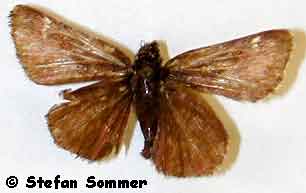
Common Roadside-Skipper
Family: Hesperiidae.
Family Description:
Alternate Common Names:Roadside Skipper, Black Little Skipper.
Description:
Caterpillar: The caterpillar has a light green body, dotted with green, and a whitish head with brown stripes. It is covered with fine hair.
Adult: This is a small skipper, with a wingspan of approximately one inch. The upperside is dark brown to black, with two to three small white spots in a row near the tip of each forewing. The wings have a distinct, checkerboard-like outer fringe of dark and light brown. Underneath, the fore- and hindwing are both dark brown close to the body and grayish violet on the outer half towards the tip.
Range:
This species occurs throughout southern Canada and most of the U.S., but can be found only in patches of the southwest. It occurs in northern and central Idaho.
Habitat:
These skippers can be found in woodlands or open areas.
Diet:
Caterpillar: Caterpillars eat a variety of grasses including bentgrass (Agrostis spp.), wild oats (Avena spp.), bluegrass (Poa spp.), and Bermuda grass (Cynodon dactylon).
Adult: Butterflies obtain nectar from flowers close to the ground, such as verbena (Verbena spp.) and self-heal (Prunella vulgaris).
Ecology:
Caterpillars construct shelters of rolled leaves tied with silk. While in the shelter, the caterpillar produces a white, waxy, outer covering for itself. Once the wax shield is complete, the caterpillar exits and remains outside. Usually there is only one generation of caterpillars each summer, but two may occur in the southern parts of its range. Caterpillars overwinter in a physiological state called diapause. Adults generally fly from March through July. This is the most common skipper of North America.
Reproduction:
Males perch and wait for receptive females. Greenish-white eggs are laid singly on host plants.
Conservation:
| Global Rank: | G5 populations are widespread, abundant, and secure. |
References:
Ferris, C. D. and F. M. Brown. (eds.) 1981. Butterflies of the Rocky Mountain States. Univ. of Oklahoma Press, Norman, Oklahoma, USA, 442 pp.
Opler, P. A., H. Pavulaan, and R. E. Stanford. 1995. Butterflies of North America. Jamestown, North Dakota, USA: Northern Prairie Wildlife Research Center Home Page. http://www.npwrc.usgs.gov/resource/distr/lepid/bflyusa/bflyusa.htm (Version 05Nov98).
Opler, P. A. and A. B.Wright. 1999. A Field Guide to the Western Butterflies. Second Edition. Peterson Field Guide Series. Houghton Mifflin Company, New York, New York, USA, 540 pp.
Pyle, R. M. 1981. National Audubon Society Field Guide to North American Butterflies. Alfred A. Knopf, Inc., New York, New York, USA, 924 pp.
Scott, J. A. 1986. The Butterflies of North America. Stanford University Press, Stanford, California, USA, 583 pp.
Stanford, R. E. and P. A. Opler. 1993. Atlas of Western U.S.A. Butterflies (Including Adjacent Parts of Canada and Mexico). Published by authors, Denver, Colorado, USA, 275 pp.
Sachem
Family: Hesperiidae
Sub-Family Description:
Description:
Caterpillar: The caterpillar is brownish green with a black head. It is covered with black tubercles and black hair.
Adult: This is a medium-sized skipper, with a wingspan of 1 to 1 5/8 inches. The male is yellowish to brownish orange on the upperside and marked with wide brown borders. Males have a large stigma (region of scent scales used in attracting females) in the shape of a rectangle near the center of the forewing. The female is yellowish to dark brown on the upperside and is marked with one to several whitish (possibly transparent) spots on the forewing. The underside of the male is golden yellow, light brown along the outer edges of the wings, and marked with black on the forewing where it attaches to the body. The underside of the forewing of the female is golden yellow while the underside of the hindwing is brownish and marked with a curved band of off-white spots.
Range:
This species is a resident of the extreme southern U.S., from southern California east to Virginia, south into South America. Each year it colonizes north as far as southern British Columbia, Idaho, Wyoming, and North Dakota east to Pennsylvania. Just recently it has been documented in Idaho in Nez Perce and Lewis Counties, where the Snake River crosses the border into Washington.
Habitat:
It occurs in open, grassy areas including prairies, fields, disturbed areas, and along watercourses.
Diet:
Caterpillar: Caterpillars feed on the leaves of grasses (Poaceae), such as Bermuda grass (Cynodon dactylon).
Adult: Butterflies drink nectar from a wide variety of flowers belonging to several families including the milkweed family (Asclepiadaceae), the dogbane family (Apocynaceae), and the sunflower family (Asteraceae).
Ecology:
Caterpillars live and feed in shelters constructed from leaves rolled and tied with silk at the bases of host grasses. There are several generations of caterpillars in the southern part of its range, and one to three where it colonizes in the northern part of its range. Adults generally fly from March to December in the south and from June to October in the north. The overwintering stage is unreported.
Reproduction:
Males perch to wait for receptive females. Females lay light green eggs singly on host grasses.
Conservation:
| Global Rank: | G5 populations are widespread, abundant, and secure. |
References:
Ferris, C. D. and F. M. Brown. (eds.) 1981. Butterflies of the Rocky Mountain States. Univ. of Oklahoma Press, Norman, Oklahoma, USA, 442 pp.
Opler, P. A., H. Pavulaan, and R. E. Stanford. 1995. Butterflies of North America. Jamestown, North Dakota, USA: Northern Prairie Wildlife Research Center Home Page. http://www.npwrc.usgs.gov/resource/distr/lepid/bflyusa/bflyusa.htm (Version 05Nov98).
Opler, P. A. and A. B.Wright. 1999. A Field Guide to the Western Butterflies. Second Edition. Peterson Field Guide Series. Houghton Mifflin Company, New York, New York, USA, 540 pp.
Pyle, R. M. 1981. National Audubon Society Field Guide to North American Butterflies. Alfred A. Knopf, Inc., New York, New York, USA, 924 pp.
Scott, J. A. 1986. The Butterflies of North America. Stanford University Press, Stanford, California, USA, 583 pp.
Stanford, R. E. and P. A. Opler. 1993. Atlas of Western U.S.A. Butterflies (Including Adjacent Parts of Canada and Mexico). Published by authors, Denver, Colorado, USA, 275 pp.
Dun Skipper
Family: Hesperiidae
Family Description:
Alternate Common Names:Dun Sedge Skipper, Sedge Witch.
Note: This species is also referred to as Euphyes ruricola by some authors.
Description:
Caterpillar: The caterpillar is green with a silvery cast. The region behind the head is white and ringed with a thin black stripe. The cream-colored head is marked with a black spot in front and a brown stripe on each side.
Adult: This is a small to medium-sized skipper, with a wingspan of 1 to 1 3/8 inches. It is medium to dark brown on the upperside, while the head and thorax may be orangish. The male has a black stigma (patch of scent scales) on the forewing; the female may have several tiny whitish dots. Underneath is brown, with the interior of the wings sometimes darker where they attach to the body.
Range:
This species has a fairly extensive range, from the southeastern portion of Canada west to southeastern Alberta, south through the eastern half of the U.S. to central Texas. Isolated populations also occur along the Pacific coast, in the Rockies, and in Colorado, New Mexico, and Arizona. In Idaho, it has only been documented in Idaho and Clearwater counties.
Habitat:
It can be found in moist, open areas, such as meadows, open woods, and along swamps and streams.
Diet:
Caterpillar: Caterpillars feed on the leaves of certain sedges including Carex and Cyperus species.
Adult: Butterflies drink nectar mostly from white, pink, and purple flowers.
Ecology:
Caterpillars live in nests of leaves and silk. Each year, there is only one generation of caterpillars in the northern part of its range, two in the middle and several in the south. Young caterpillars, those from the season’s last brood, overwinter in a physiological state called diapause. Adults generally fly from June to early August. Butterflies rest with their forewings held up while their hindwings lie flat.
Reproduction:
Males perch to wait for receptive females. Females lay light green eggs singly on the leaves of host plants. The eggs change to a red color before hatching.
Conservation:
| Global Rank: | G5 populations are widespread, abundant, and secure. |
References:
Ferris, C. D. and F. M. Brown. (eds.) 1981. Butterflies of the Rocky Mountain States. Univ. of Oklahoma Press, Norman, Oklahoma, USA, 442 pp.
Opler, P. A., H. Pavulaan, and R. E. Stanford. 1995. Butterflies of North America. Jamestown, North Dakota, USA: Northern Prairie Wildlife Research Center Home Page. http://www.npwrc.usgs.gov/resource/distr/lepid/bflyusa/bflyusa.htm (Version 05Nov98).
Opler, P. A. and A. B.Wright. 1999. A Field Guide to the Western Butterflies. Second Edition. Peterson Field Guide Series. Houghton Mifflin Company, New York, New York, USA, 540 pp.
Pyle, R. M. 1981. National Audubon Society Field Guide to North American Butterflies. Alfred A. Knopf, Inc., New York, New York, USA, 924 pp.
Scott, J. A. 1986. The Butterflies of North America. Stanford University Press, Stanford, California, USA, 583 pp.
Stanford, R. E. and P. A. Opler. 1993. Atlas of Western U.S.A. Butterflies (Including Adjacent Parts of Canada and Mexico). Published by authors, Denver, Colorado, USA, 275 pp.
Western Branded Skipper
Family: Hesperiidae
Family Description:
Note: This species is included as a subspecies of Hesperia comma, the Common Branded Skipper, by some authors.
Description:
Caterpillar: The caterpillar is brown and has a dark brown head marked with light brown.
Adult: This is a small to medium-sized skipper, with a wingspan of 7/8 to1 3/8 inches, and it is highly variable in its appearance. The upperside is typically brown to orange with a dark border, with males generally brighter than females. Males have a stigma (patch of scent scales used in attracting females) that forms a slanted blackish streak on the forewing. The forewing may appear rounded but is more frequently pointed. Southwestern forms may appear reddish. Underneath varies in color and can be greenish, brownish, reddish, or orange. The underside of the hindwing may be marked with whitish to yellow spots; the spots may be merged into a curved band.
Range:
This species ranges from southern British Columbia south to southern California, southeastern Arizona, and southwestern New Mexico, and extends east in the U.S. as far as central Nebraska. It occurs throughout much of Idaho.
Habitat:
It occurs in open and often grassy areas.
Diet:
Caterpillar: Caterpillars feed on the leaves of various grasses and sedges.
Adult: Adults drink flower nectar, often from asters (Aster and Machaeranthera spp.) and thistles (Cirsium spp.).
Ecology:
Caterpillars live in nests of leaves tied with silk. Each summer, there is one generation of caterpillars. The caterpillars overwinter in a physiological state called diapause. Adults generally fly from July to September.
Reproduction:
Males perch to wait for receptive females. Females lay eggs on or near host plants.
Conservation:
| Global Rank: | G5 populations are widespread, abundant, and secure. |
References:
Ferris, C. D. and F. M. Brown. (eds.) 1981. Butterflies of the Rocky Mountain States. Univ. of Oklahoma Press, Norman, Oklahoma, USA, 442 pp.
Opler, P. A., H. Pavulaan, and R. E. Stanford. 1995. Butterflies of North America. Jamestown, North Dakota, USA: Northern Prairie Wildlife Research Center Home Page. http://www.npwrc.usgs.gov/resource/distr/lepid/bflyusa/bflyusa.htm (Version 05Nov98).
Opler, P. A. and A. B.Wright. 1999. A Field Guide to the Western Butterflies. Second Edition. Peterson Field Guide Series. Houghton Mifflin Company, New York, New York, USA, 540 pp.
Pyle, R. M. 1981. National Audubon Society Field Guide to North American Butterflies. Alfred A. Knopf, Inc., New York, New York, USA, 924 pp.
Scott, J. A. 1986. The Butterflies of North America. Stanford University Press, Stanford, California, USA, 583 pp.
Stanford, R. E. and P. A. Opler. 1993. Atlas of Western U.S.A. Butterflies (Including Adjacent Parts of Canada and Mexico). Published by authors, Denver, Colorado, USA, 275 pp.
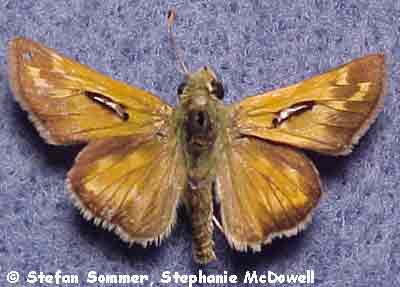
Hesperia comma
Common Branded Skipper
Note: This is really a complex comprised of many species or subspecies.
Family: Hesperiidae.
Idaho Status: Unprotected nongame species.
Global Rank: G5; populations are widespread, abundant, and secure.
Description:
- Caterpillar: When young, the caterpillar is offwhite to yellow with a brownish head. It becomes a dull green when older.
- Adult: This is a medium-sized skipper, with a wingspan of 1 to 1 1/4 inches, and it is highly variable in its appearance. The upperside is typically brown to orange, with males generally brighter than females. Males have a stigma (patch of scent scales used in attracting females) that forms a slanted blackish streak on the forewing. The forewing may appear stubby and the tip rounded. Northern forms may be darker while western forms are often more orange. The upperside may be faintly marked with a wavy pattern of orange. Underneath is brownish to greenish brown. The underside of the hindwing may be marked with whitish to yellow spots; the spots may be merged into a curved band.
Range: This widespread species is holarctic, which means it can be found in the temperate regions of the entire Northern Hemisphere. In North America, it occurs from central Alaska and the northwestern Canadian territories south to northern Idaho and western Montana, and east across Canada to the east coast, extending south into the northern portions of the Great Lakes states and Maine.
Habitat:
The preferred habitat is open, sunny areas such as fields, meadows, and forest openings.
Diet:
- Caterpillar: Caterpillars feed on the leaves of various grasses and sedges, including bluegrass (Poa spp.), fescue (Festuca spp.), and brome (Bromus spp.).
- Adult: Adults drink flower nectar.
Ecology:
Caterpillars live in nests of leaves tied with silk. Each summer, there is one generation of caterpillars. In most of its range, the eggs overwinter. In the arctic, the species may be biennial, with the older caterpillars or pupae also overwintering in a physiological state called diapause. Adults generally fly from early June to mid-September.
Reproduction:
Males perch to wait for receptive females. Females lay eggs on or near host plants.
References:
Ferris, C. D. and F. M. Brown. (eds.) 1981. Butterflies of the Rocky Mountain States. Univ. of Oklahoma Press, Norman, Oklahoma, USA, 442 pp.
Opler, P. A., H. Pavulaan, and R. E. Stanford. 1995. Butterflies of North America. Jamestown, North Dakota, USA: Northern Prairie Wildlife Research Center Home Page. http://www.npwrc.usgs.gov/resource/distr/lepid/bflyusa/bflyusa.htm (Version 05Nov98).
Opler, P. A. and A. B.Wright. 1999. A Field Guide to the Western Butterflies. Second Edition. Peterson Field Guide Series. Houghton Mifflin Company, New York, New York, USA, 540 pp.
Pyle, R. M. 1981. National Audubon Society Field Guide to North American Butterflies. Alfred A. Knopf, Inc., New York, New York, USA, 924 pp.
Scott, J. A. 1986. The Butterflies of North America. Stanford University Press, Stanford, California, USA, 583 pp.
Stanford, R. E. and P. A. Opler. 1993. Atlas of Western U.S.A. Butterflies (Including Adjacent Parts of Canada and Mexico). Published by authors, Denver, Colorado,

Juba Skipper
Family: Hesperiidae
Family Description:
Alternate Common Name: Jagged-Border Skipper.
Description:
Caterpillar: When young, the caterpillar is offwhite to yellow with a brownish head. It becomes a dull green with a dark head when older.
Adult: This is a medium to large-sized skipper, with a wingspan of 1 1/4 to 1 5/8 inches. The forewings appear pointed. Males are orange on the upperside and marked with brown, particularly along the outer edges of the wings, and on the interior of the hindwing. Males have a stigma (patch of scent scales used in attracting females) that forms a blackish streak on the forewing. Females are larger and brighter orange, and are marked with brown. Underneath, both sexes are brownish orange on the forewing and greenish orange on the hindwing. The underside of the hindwing is marked with an uneven white band or row of spots.
Range:
This species ranges from central British Columbia south to southern California, and east to Montana south to northern New Mexico. In Idaho, it is found throughout most of the state.
Habitat:
It occurs in open areas such as sagebrush steppe, chaparral, grasslands, and open woodlands.
Diet:
Caterpillar: Caterpillars feed on the leaves of several grasses, including slender hairgrass (Deschampsia elongata), needlegrass (Stipa spp.), and bluegrass (Poa spp.).
Adult: Butterflies drink flower nectar.
Ecology:
Caterpillars live in nests made from leaves tied with silk. There are two generations of caterpillars each summer, the second of which some experts report overwinters in a physiological state called diapause. However, other experts point to the fact that adults can be observed in flight as early as April, suggesting the pupae overwinter as well. Adults generally fly from late April through June and from August to early October.
Reproduction:
Males perch to wait for receptive females. Females lay pinkish eggs singly on or near host plants. The eggs turn white or gray before hatching.
Conservation:
| Global Rank: | G5 populations are widespread, abundant, and secure. |
References:
Ferris, C. D. and F. M. Brown. (eds.) 1981. Butterflies of the Rocky Mountain States. Univ. of Oklahoma Press, Norman, Oklahoma, USA, 442 pp.
Opler, P. A., H. Pavulaan, and R. E. Stanford. 1995. Butterflies of North America. Jamestown, North Dakota, USA: Northern Prairie Wildlife Research Center Home Page. http://www.npwrc.usgs.gov/resource/distr/lepid/bflyusa/bflyusa.htm (Version 05Nov98).
Opler, P. A. and A. B.Wright. 1999. A Field Guide to the Western Butterflies. Second Edition. Peterson Field Guide Series. Houghton Mifflin Company, New York, New York, USA, 540 pp.
Pyle, R. M. 1981. National Audubon Society Field Guide to North American Butterflies. Alfred A. Knopf, Inc., New York, New York, USA, 924 pp.
Scott, J. A. 1986. The Butterflies of North America. Stanford University Press, Stanford, California, USA, 583 pp.
Stanford, R. E. and P. A. Opler. 1993. Atlas of Western U.S.A. Butterflies (Including Adjacent Parts of Canada and Mexico). Published by authors, Denver, Colorado, USA, 275 pp.
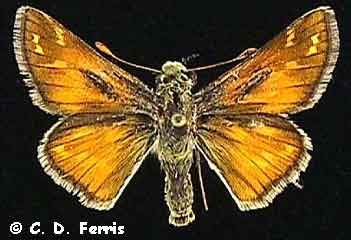
Nevada Skipper
Family: Hesperiidae
Family Description:
Alternate Common Name: Montane Skipper.
Description:
Caterpillar: The caterpillar is brownish green, with a black head marked with offwhite.
Adult: This is a medium-sized skipper, with a wingspan of 1 to 1 7/16 inches. The male is brownish orange on the upperside, and marked with a dark border and several scattered paler spots. Males have a stigma (patch of scent scales used in attracting females) that forms a blackish streak on the forewing. The female is brown with patches of orange but otherwise is marked similarly to the male. Underneath, both sexes have an orange forewing, darker where the wing attaches to the body, and tipped with greenish brown. There may be several small white spots. The underside of the hindwing is green to gray to brown, and is marked with several larger patches of white.
Range:
This species ranges from southern British Columbia east to Saskatchewan, from the eastern Pacific Northwest east to central Montana and Wyoming; and in western Colorado and patches of California and the southwest. It occurs in portions of central and southern Idaho.
Habitat:
Typically found at higher elevations, it occurs in open areas such as sagebrush steppe, meadows, grasslands, and open woodlands.
Diet:
Caterpillar: Caterpillars feed on grasses including western needlegrass (Stipa occidentalis) and fescue (Festuca spp.).
Adult: Butterflies drink flower nectar.
Ecology:
Caterpillars live in tubes made of silk at the bases of host plants. There is only one generation of caterpillars each summer. They overwinter in partially buried shelters, in a physiological state called diapause. Adults generally fly from late May to early August.
Reproduction:
Males perch to wait for receptive females. Females lay white eggs singly on or near host plants.
Conservation:
| Global Rank: | G5 populations levels are secure, but may be of concern in the future. |
References:
Ferris, C. D. and F. M. Brown. (eds.) 1981. Butterflies of the Rocky Mountain States. Univ. of Oklahoma Press, Norman, Oklahoma, USA, 442 pp.
Opler, P. A., H. Pavulaan, and R. E. Stanford. 1995. Butterflies of North America. Jamestown, North Dakota, USA: Northern Prairie Wildlife Research Center Home Page. http://www.npwrc.usgs.gov/resource/distr/lepid/bflyusa/bflyusa.htm (Version 05Nov98).
Opler, P. A. and A. B.Wright. 1999. A Field Guide to the Western Butterflies. Second Edition. Peterson Field Guide Series. Houghton Mifflin Company, New York, New York, USA, 540 pp.
Scott, J. A. 1986. The Butterflies of North America. Stanford University Press, Stanford, California, USA, 583 pp.
Stanford, R. E. and P. A. Opler. 1993. Atlas of Western U.S.A. Butterflies (Including Adjacent Parts of Canada and Mexico). Published by authors, Denver, Colorado, USA, 2
Uncas Skipper
Family: Hesperiidae
Sub-Family Description:
Alternate Common Names:White-Vein Skipper.
Description:
Caterpillar: The caterpillar is light brown with a dark brown head that is marked with off-white.
Adult: This is a medium-sized skipper, with a wingspan of 1 to 1 5/8 inches. The upperside is brownish orange, darker along the edges, and marked with white, irregularly-shaped patches on the tip of the forewing. Males have a stigma (patch of scent scales used in attracting females) that forms a slanted blackish streak on the forewing. The underside of the forewing is marked as above but appears duller and may have more white. The underside of the hindwing is greenish brown and marked extensively with white, both along the veins and in a curved row across the center of the wing.
Range:
This species ranges from central Alberta to southern Manitoba, south through the western halves of the Dakotas to northern Texas, and west to northern Arizona, Nevada, and in parts of Idaho, Montana, and Colorado. In Idaho, it occurs in the south central part of the state.
Habitat:
It occurs in prairies, sagebrush steppe, and open woodlands.
Diet:
Caterpillar: Caterpillars feed on the leaves of grasses including blue grama grass (Boutelous gracilis).
Adult: Butterflies drink flower nectar.
Ecology:
Caterpillars construct shelters from leaves tied with silk. There are two generations of caterpillars each year through most of its range, with possibly several in the south and only one at high elevations. Adults generally fly from late April through September through most of its range, and from mid-June through July at high elevations. Occasionally adults may stray into Iowa and Minnesota. The overwintering stage is unreported.
Reproduction:
Males perch generally on small hilltops to wait for receptive females. Females lay light green eggs singly on or near host plants
Conservation:
| Global Rank: | G5 populations levels are secure, but may be of concern in the future. |
References:
Ferris, C. D. and F. M. Brown. (eds.) 1981. Butterflies of the Rocky Mountain States. Univ. of Oklahoma Press, Norman, Oklahoma, USA, 442 pp.
Opler, P. A., H. Pavulaan, and R. E. Stanford. 1995. Butterflies of North America. Jamestown, North Dakota, USA: Northern Prairie Wildlife Research Center Home Page. http://www.npwrc.usgs.gov/resource/distr/lepid/bflyusa/bflyusa.htm (Version 05Nov98).
Opler, P. A. and A. B.Wright. 1999. A Field Guide to the Western Butterflies. Second Edition. Peterson Field Guide Series. Houghton Mifflin Company, New York, New York, USA, 540 pp.
Pyle, R. M. 1981. National Audubon Society Field Guide to North American Butterflies. Alfred A. Knopf, Inc., New York, New York, USA, 924 pp.
Scott, J. A. 1986. The Butterflies of North America. Stanford University Press, Stanford, California, USA, 583 pp.
Stanford, R. E. and P. A. Opler. 1993. Atlas of Western U.S.A. Butterflies (Including Adjacent Parts of Canada and Mexico). Published by authors, Denver, Colorado, USA, 275 pp.
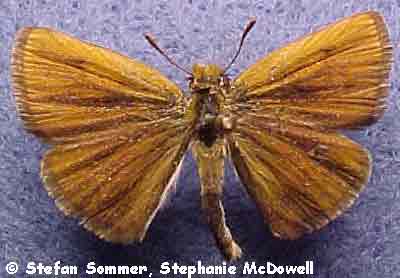
Garita Skipperling
Family: Hesperiidae
Family Description:
Description:
Caterpillar: The caterpillar is green and striped lengthwise with white along the back and sides.
Adult: This is a fairly small skipper, with a wingspan of one inch. It can vary in its appearance, from golden to brownish to blackish on the upperside, with no distinct markings. Underneath, the forewing varies in color from orange to reddish. The hindwing is generally brownish gold and marked with white veins; its leading edge is marked with orange, from the body to the wing tip.
Range:
This species ranges from southern British Columbia, central Alberta and Saskatchewan, and southern Manitoba, south through the Intermountain and Rocky Mountain states to parts of Arizona and New Mexico, and extending into Mexico. It occurs through much of Idaho, particularly the panhandle region.
Habitat:
The preferred habitat is open, often moist sites, including mountain meadows, fields, open woodlands, and prairies.
Diet:
Caterpillar: Caterpillars feed on a variety of grasses (Poaceae), such as bluegrass (Poa spp.) and blue grama grass (Bouteloua gracilis).
Adult: Butterflies drink flower nectar.
Ecology:
There is one generation of caterpillars each summer. Fourth instar caterpillars overwinter in a physiological state called diapause. Adults generally fly from June through July.
Reproduction:
Males actively patrol in search of receptive females. Females lay eggs singly on the leaves and stems of host plants.
Conservation:
| Global Rank: | G5 populations are widespread, abundant, and secure. |
References:
Ferris, C. D. and F. M. Brown. (eds.) 1981. Butterflies of the Rocky Mountain States. Univ. of Oklahoma Press, Norman, Oklahoma, USA, 442 pp.
Opler, P. A., H. Pavulaan, and R. E. Stanford. 1995. Butterflies of North America. Jamestown, North Dakota, USA: Northern Prairie Wildlife Research Center Home Page. http://www.npwrc.usgs.gov/resource/distr/lepid/bflyusa/bflyusa.htm (Version 05Nov98).
Opler, P. A. and A. B.Wright. 1999. A Field Guide to the Western Butterflies. Second Edition. Peterson Field Guide Series. Houghton Mifflin Company, New York, New York, USA, 540 pp.
Pyle, R. M. 1981. National Audubon Society Field Guide to North American Butterflies. Alfred A. Knopf, Inc., New York, New York, USA, 924 pp.
Scott, J. A. 1986. The Butterflies of North America. Stanford University Press, Stanford, California, USA, 583 pp.
Stanford, R. E. and P. A. Opler. 1993. Atlas of Western U.S.A. Butterflies (Including Adjacent Parts of Canada and Mexico). Published by authors, Denver, Colorado, USA, 275 pp.
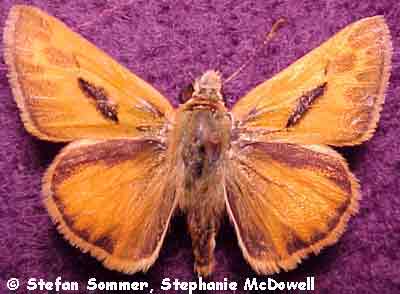
Woodland Skipper
Family: Hesperiidae
Family Description:
Alternate Common Name: Western Skipper.
Description:
Caterpillar: The caterpillar can vary in appearance, from light green with a dark line down the back to yellowish and lined with black.
Adult: This is a fairly small skipper, with a wingspan ranging from 1 to 1 ¼ inches. It is orange to coppery on the upperside with a jagged, dark brown border. The male has a black stigma (region of scent scales used in attracting females) on the forewing; the female has a black band of color in the same area, running diagonally across the wing. The hindwing of males is orange bordered by brownish black; in females, it is mostly brownish black with a small orange portion. Underneath is particularly variable, ranging from orange to yellow to tan. The borders are often darker than the rest of the wing, and there may be a band or patch of yellowish to cream spots on both the fore- and hindwing.
Range:
This species ranges from southern British Columbia and Alberta south through the western U.S. to southern California and northern Arizona and New Mexico, from the coast to central Montana, eastern Wyoming, and central Colorado. It occurs throughout most of Idaho.
Habitat:
It can utilize a wide range of habitats, including marshes, along streams, woodlands, sagebrush steppe, chaparral, gardens, and vacant lots.
Diet:
Caterpillar: Caterpillars feed on a variety of grasses, such as Bermuda grass (Cynodon dactylon) and canary grass (Phalaris spp.).
Adult: Butterflies drink flower nectar, often from flowers rarely visited by other butterfly species, such as ox-eye daisy (Chrysanthemum leucanthemum) and everlasting (Antennaria racemosa).
Ecology:
There is one new generation of caterpillars each year through most of its range; there may be two or more in parts of California. Young caterpillars overwinter in a physiological state called diapause. In the spring, they emerge to continue feeding and molting. They re-enter diapause in the summer, now fully grown, and later they emerge to pupate. Adults emerge and fly generally from July to October, mating and laying eggs in the fall; the eggs hatch and the cycle continues. Caterpillars feeding in large numbers can damage solid tracts of cultivated grasses, such as golf courses. This skipper is a very common butterfly, likely due in part to its habitat versatility.
Reproduction:
Males perch to wait for receptive females. The locations chosen by females to lay eggs have not been observed or reported.
Conservation:
| Global Rank: | G5 populations are widespread, abundant, and secure. |
References:
Ferris, C. D. and F. M. Brown. (eds.) 1981. Butterflies of the Rocky Mountain States. Univ. of Oklahoma Press, Norman, Oklahoma, USA, 442 pp.
Opler, P. A., H. Pavulaan, and R. E. Stanford. 1995. Butterflies of North America. Jamestown, North Dakota, USA: Northern Prairie Wildlife Research Center Home Page. http://www.npwrc.usgs.gov/resource/distr/lepid/bflyusa/bflyusa.htm (Version 05Nov98).
Opler, P. A. and A. B.Wright. 1999. A Field Guide to the Western Butterflies. Second Edition. Peterson Field Guide Series. Houghton Mifflin Company, New York, New York, USA, 540 pp.
Pyle, R. M. 1981. National Audubon Society Field Guide to North American Butterflies. Alfred A. Knopf, Inc., New York, New York, USA, 924 pp.
Scott, J. A. 1986. The Butterflies of North America. Stanford University Press, Stanford, California, USA, 583 pp.
Stanford, R. E. and P. A. Opler. 1993. Atlas of Western U.S.A. Butterflies (Including Adjacent Parts of Canada and Mexico). Published by authors, Denver, Colorado, USA, 275 pp.
Yuma Skipper
Family: Hesperiidae
Family Description:
Alternate Common Name: Giant Reed Skipper.
Description:
Caterpillar: Young caterpillars are orange and have a black head. Older caterpillars are light green, marked lengthwise with brown stripes, and have an off-white colored head.
Adult: This is a medium-sized skipper, with a wingspan of 1 1/8 to 1 3/8 inches. The male is yellowish orange on the upperside, bordered with dark brown. There is a black stigma (patch of scent scales used in attracting females) near the center of the forewing. The female is yellowish brown on the upperside, marked with scattered patches of yellowish white, and has no stigma. Underneath, both sexes are golden yellow with a region of brown or black at the base of the forewing and possibly with pale spots on the hindwing.
Range:
This species ranges from central California east through Nevada, southern Utah, Colorado, and Arizona. Also, isolated populations occur in Washington, New Mexico, and Idaho (Twin Falls County).
Habitat:
It can be found in wet spots where the host plant, the common reed, occurs, including marshes, canals, seeps, and desert oases.
Diet:
Caterpillar: Caterpillars feed on the leaves of the common reed (Phragmites australis).
Adult: Butterflies drink flower nectar.
Ecology:
There are one to two generations of caterpillars each summer. Caterpillars form nests from reed leaves rolled and tied with silk. The overwintering stage has not been reported. Adults generally fly from June through September. Butterflies live in localized, isolated colonies.
Reproduction:
Males perch in low spots to wait for receptive females. Greenish white eggs are laid on or near the host plant.
Conservation:
| Global Rank: | G5 populations are widespread, abundant, and secure. |
References:
Ferris, C. D. and F. M. Brown. (eds.) 1981. Butterflies of the Rocky Mountain States. Univ. of Oklahoma Press, Norman, Oklahoma, USA, 442 pp.
Opler, P. A., H. Pavulaan, and R. E. Stanford. 1995. Butterflies of North America. Jamestown, North Dakota, USA: Northern Prairie Wildlife Research Center Home Page. http://www.npwrc.usgs.gov/resource/distr/lepid/bflyusa/bflyusa.htm (Version 05Nov98).
Opler, P. A. and A. B.Wright. 1999. A Field Guide to the Western Butterflies. Second Edition. Peterson Field Guide Series. Houghton Mifflin Company, New York, New York, USA, 540 pp.
Pyle, R. M. 1981. National Audubon Society Field Guide to North American Butterflies. Alfred A. Knopf, Inc., New York, New York, USA, 924 pp.
Scott, J. A. 1986. The Butterflies of North America. Stanford University Press, Stanford, California, USA, 583 pp.
Stanford, R. E. and P. A. Opler. 1993. Atlas of Western U.S.A. Butterflies (Including Adjacent Parts of Canada and Mexico). Published by authors, Denver, Colorado, USA, 275 pp.
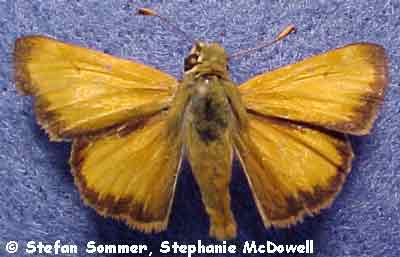
Poanes taxiles
Taxiles Skipper
Family: Hesperiidae
Family Description:
Alternate Common Name: Golden Skipper.
Note: This species is listed as a subspecies of Poanes zabulon by some authors.
Description:
Caterpillar: The caterpillar is orangish to light brown, striped lengthwise along the back and sides thinly with brown, and dotted with brown.
Adult: These skippers are sexually dimorphic, which means males and females differ in their appearance. The wingspan ranges from 1¼ to 1½ inches. Males: The male is bright yellowish orange on the upperside, with the wings edged in black, appearing scalloped. Underneath is brownish orange. The underside of the forewing may be slightly darker at the tip and edges; the underside of the hindwing is brown with patches of yellow, or yellow with patches of brown. Females: The female is orangish brown on the upperside, with patches of orange or yellow. Underneath is brownish. The underside of the forewing may have patches of golden orange; the underside of the hindwing may have a faint band of orange to yellow across the center, and bluish to purplish shading near the body and/or at the edge.
Range:
This species ranges from eastern Wyoming and western South Dakota and Nebraska south through Colorado and New Mexico across the border to northern Mexico; it also occurs from extreme southeastern Idaho south in a narrow strip to southern Utah and northern Arizona.
Habitat:
It can be found in valleys and gulches, grassy fields, and in forest openings.
Diet:
Caterpillar: Caterpillars feed on the leaves of a variety of grasses, including bluegrass (Poa spp.), wheatgrass (Agropyron spp.), and orchard grass (Dactylis spp.).
Adult: Butterflies drink flower nectar.
Ecology:
There is one generation of caterpillars each summer. Caterpillars construct nests of leaves tied with silk. The overwintering stage is unreported. Adults generally fly from mid-June through august. At rest, these butterflies are found with their forewings partially open and their hindwings fully open. Adult males may be territorial. Additionally, they are often active during cloudy weather, an uncommon behavior for butterflies.
Reproduction:
Males perch to wait for receptive females. Females lay eggs singly on the leaves of host plants.
Conservation:
| Global Rank: | G5 populations levels are secure, but may be of concern in the future. |
References:
Ferris, C. D. and F. M. Brown. (eds.) 1981. Butterflies of the Rocky Mountain States. Univ. of Oklahoma Press, Norman, Oklahoma, USA, 442 pp.
Opler, P. A., H. Pavulaan, and R. E. Stanford. 1995. Butterflies of North America. Jamestown, North Dakota, USA: Northern Prairie Wildlife Research Center Home Page. http://www.npwrc.usgs.gov/resource/distr/lepid/bflyusa/bflyusa.htm (Version 05Nov98).
Opler, P. A. and A. B.Wright. 1999. A Field Guide to the Western Butterflies. Second Edition. Peterson Field Guide Series. Houghton Mifflin Company, New York, New York, USA, 540 pp.
Pyle, R. M. 1981. National Audubon Society Field Guide to North American Butterflies. Alfred A. Knopf, Inc., New York, New York, USA, 924 pp.
Scott, J. A. 1986. The Butterflies of North America. Stanford University Press, Stanford, California, USA, 583 pp.
Stanford, R. E. and P. A. Opler. 1993. Atlas of Western U.S.A. Butterflies (Including Adjacent Parts of Canada and Mexico). Published by authors, Denver, Colorado, USA, 275 pp.
Draco Skipper
Family: Hesperiidae
Family Description:
Alternate Common Name: Rocky Mountain Skipper.
Description:
Caterpillar: The caterpillar is dark brown with a blackish head and blackish bands.
Adult: This skipper has a wingspan of 7/8 to 1 1/4 inches. The upperside of the male butterfly is dark brown, with patches of orange. The forewing has a black stigma (patch of scent scales used in attracting females); the hindwing has several streaks of orange. The female is dark brown on the upperside, with patches of orange and golden yellow, and no stigma. Underneath, both sexes are greenish gray. The underside of the forewing may be shaded with orange; the underside of the hindwing is marked with whitish patches and spots.
Range:
This species ranges from the Yukon Territory, south through British Columbia and Alberta, through the Rocky Mountains to Arizona and New Mexico. In Idaho, it occurs primarily in the central and southeastern portions of the state.
Habitat:
It can be found in high elevation meadows, along streams, and in wet valleys.
Diet:
Caterpillar: Records are sparse, but caterpillars are believed to feed on a variety of grasses (Family Poaceae).
Adult: Butterflies drink flower nectar, often from yellow flowers belonging to the sunflower family (Asteraceae).
Ecology:
There is one generation of caterpillars each summer. The overwintering stage is unreported. Adults generally fly from early June to early August. At rest, these butterflies are found with their forewings partially open and their hindwings fully open. Though little is known or reported about its ecology, this is one of the most common skippers in the western U.S.
Reproduction:
Males perch to wait for receptive females. Females are believed to lay eggs on host plants but this has yet to be confirmed.
Conservation:
| Global Rank: | G5 populations are widespread, abundant, and secure. |
References:
Ferris, C. D. and F. M. Brown. (eds.) 1981. Butterflies of the Rocky Mountain States. Univ. of Oklahoma Press, Norman, Oklahoma, USA, 442 pp.
Opler, P. A., H. Pavulaan, and R. E. Stanford. 1995. Butterflies of North America. Jamestown, North Dakota, USA: Northern Prairie Wildlife Research Center Home Page. http://www.npwrc.usgs.gov/resource/distr/lepid/bflyusa/bflyusa.htm (Version 05Nov98).
Opler, P. A. and A. B.Wright. 1999. A Field Guide to the Western Butterflies. Second Edition. Peterson Field Guide Series. Houghton Mifflin Company, New York, New York, USA, 540 pp.
Pyle, R. M. 1981. National Audubon Society Field Guide to North American Butterflies. Alfred A. Knopf, Inc., New York, New York, USA, 924 pp.
Scott, J. A. 1986. The Butterflies of North America. Stanford University Press, Stanford, California, USA, 583 pp.
Stanford, R. E. and P. A. Opler. 1993. Atlas of Western U.S.A. Butterflies (Including Adjacent Parts of Canada and Mexico). Published by authors, Denver, Colorado, USA, 275 pp.
Long Dash
Family: Hesperiidae
Family Description:
Description:
Caterpillar: The caterpillar is greenish to dark brown, sometimes mottled with white and marked lengthwise along the back with a dark line. The body is covered with short black hair.
Adult: This skipper has a wingspan of 1 to 1 ½ inches. The male is brownish orange on the upperside, marked with brown along the edges. The forewing has a black stigma (patch of scent scales used in attracting females) that runs diagonally across the wing from the body towards the wing tip. The female is brown to brownish orange on the upperside, with patches or bands of golden yellow, and possibly a patch of orange along the leading edge of the forewing. The female has no stigma, but may have a patch of black on the forewing near the body. Underneath, both sexes are golden orange; the underside of the hindwing is marked with a curved band of yellow, or it may be entirely yellow.
Range:
This species ranges across southern Canada from Alberta to Nova Scotia, and across the northern U.S. from eastern Washington and northeastern Oregon to the east coast, extending south as far as northern Colorado. In Idaho, it can be found from the panhandle to the central part of the state.
Habitat:
It occurs in moist areas such as marshes, meadows, and along streams.
Diet:
Caterpillar: Caterpillars feed on the leaves of various grasses, including bluegrass (Poa spp.).
Adult: Butterflies drink flower nectar.
Ecology:
There is usually one generation of caterpillars each summer, but there may be two in certain locations. Caterpillars construct nests of leaves tied with silk. Caterpillars overwinter in a physiological state called diapause. Adults generally fly from late May to early August. The butterflies when at rest are found with their forewings partially open and their hindwings fully open.
Reproduction:
Males perch to wait for receptive females. Females lay eggs singly on or near host grasses.
Conservation:
| Global Rank: | G5 populations are widespread, abundant, and secure. |
References:
Ferris, C. D. and F. M. Brown. (eds.) 1981. Butterflies of the Rocky Mountain States. Univ. of Oklahoma Press, Norman, Oklahoma, USA, 442 pp.
Opler, P. A., H. Pavulaan, and R. E. Stanford. 1995. Butterflies of North America. Jamestown, North Dakota, USA: Northern Prairie Wildlife Research Center Home Page. http://www.npwrc.usgs.gov/resource/distr/lepid/bflyusa/bflyusa.htm (Version 05Nov98).
Opler, P. A. and A. B.Wright. 1999. A Field Guide to the Western Butterflies. Second Edition. Peterson Field Guide Series. Houghton Mifflin Company, New York, New York, USA, 540 pp.
Pyle, R. M. 1981. National Audubon Society Field Guide to North American Butterflies. Alfred A. Knopf, Inc., New York, New York, USA, 924 pp.
Scott, J. A. 1986. The Butterflies of North America. Stanford University Press, Stanford, California, USA, 583 pp.
Stanford, R. E. and P. A. Opler. 1993. Atlas of Western U.S.A. Butterflies (Including Adjacent Parts of Canada and Mexico). Published by authors, Denver, Colorado, USA, 275 pp.
Peck’s Skipper
Family: Hesperiidae
Family Description:
Alternate Common Name: Yellowpatch Skipper.
Note: Some authors refer to this species as Polites coras.
Description:
Caterpillar: The caterpillar is dark reddish brown, mottled with light brown and striped lengthwise along the back with black.
Adult: This is a fairly small skipper, with a wingspan of ¾ to 1 ¼ inches. The male is brownish on the upperside, marked with patches and bars of orange and golden yellow. The forewing has a black stigma (patch of scent scales used in attracting females). The female is dark brown on the upperside, with smaller patches and bars of orange and golden yellow, and has no stigma. Underneath, both sexes are brown. The underside of the forewing has several patches of yellow. The underside of the hindwing has a curved, thick band of yellow, rectangular-shaped spots towards the outer edge, the center spot extending the farthest; additionally, there is a patch of yellow where the wing attaches to the body.
Range:
This species ranges across Canada from eastern British Columbia to Nova Scotia, and across the U.S. from eastern Washington and Oregon to the east coast, extending south as far as central Colorado, northern Arkansas, and northern Georgia. It occurs in Idaho in both the panhandle and central regions of the state.
Habitat:
It can be found in open, grassy places such as meadows, fields, prairies, and pastures.
Diet:
Caterpillar: Caterpillars feed on the leaves of a variety of grasses (Family Poaceae).
Adult: Butterflies drink flower nectar.
Ecology:
There are generally two generations of caterpillars each summer in most of its range, but there may be only one in the north or at high elevations. Caterpillars construct nests from leaves and silk. Caterpillars and pupae may overwinter in a physiological state called diapause. Adults generally fly either from July to August (one generation) or from May to June and from August to September (two generations). The butterflies when at rest are found with their forewings partially open and their hindwings fully open.
Reproduction:
Males perch to wait for receptive females. Females lay green eggs singly on grasses, and occasionally on other plants.
Conservation:
| Global Rank: | G5 populations are widespread, abundant, and secure. |
References:
Ferris, C. D. and F. M. Brown. (eds.) 1981. Butterflies of the Rocky Mountain States. Univ. of Oklahoma Press, Norman, Oklahoma, USA, 442 pp.
Opler, P. A., H. Pavulaan, and R. E. Stanford. 1995. Butterflies of North America. Jamestown, North Dakota, USA: Northern Prairie Wildlife Research Center Home Page. http://www.npwrc.usgs.gov/resource/distr/lepid/bflyusa/bflyusa.htm (Version 05Nov98).
Opler, P. A. and A. B.Wright. 1999. A Field Guide to the Western Butterflies. Second Edition. Peterson Field Guide Series. Houghton Mifflin Company, New York, New York, USA, 540 pp.
Pyle, R. M. 1981. National Audubon Society Field Guide to North American Butterflies. Alfred A. Knopf, Inc., New York, New York, USA, 924 pp.
Scott, J. A. 1986. The Butterflies of North America. Stanford University Press, Stanford, California, USA, 583 pp.
Stanford, R. E. and P. A. Opler. 1993. Atlas of Western U.S.A. Butterflies (Including Adjacent Parts of Canada and Mexico). Published by authors, Denver, Colorado, USA, 275 pp.
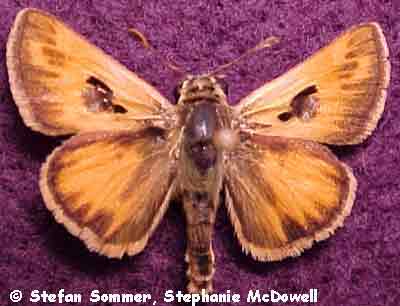
Sandhill Skipper
Family: Hesperiidae
Family Description:
Alternate Common Name: Saltgrass Skipper.
Description:
Caterpillar: The caterpillar can vary in color, from purplish brown, to green, to gray mottled with brown. It may be marked lengthwise with dark lines along the back and sides. The face is black and marked with white.
Adult: This skipper is fairly small, with a wingspan of 7/8 to 1 1/4 inches. Though it varies in its appearance, generally it is yellowish orange on the upperside with dark brown borders, appearing jagged towards the inside. The male has a black stigma (patch of scent scales used in attracting females) on the forewing. The female lacks a stigma, but may have several whitish to yellow spots in the border of the forewing. Underneath, the forewing is orangish in the center, dark near the body and more yellowish to brownish elsewhere. The underside of the hindwing generally is brownish to yellow, with a yellow to white patch that extends to the outer edge along the veins. The veins end with small dark spots at the edge.
Range:
This species ranges from southern British Columbia south through Washington and parts of Idaho to southern and Baja California, extending east as far as Wyoming, Colorado, and New Mexico.
Habitat:
It can be found in a number of habitats, including dunes, marshes, alkali flats, meadows, and sagebrush steppe.
Diet:
Caterpillar: Caterpillars feed on the leaves of a variety of grasses (Family Poaceae).
Adult: Butterflies drink flower nectar.
Ecology:
The number of generations of caterpillars each year varies with location, from one to two in the north to many in the south. Caterpillars construct nests from leaves tied with silk. Pupae of the last generation of the growing season overwinter in a physiological state called diapause. Adults generally fly from March to November (July to August at high elevations). The butterflies when at rest are found with their forewings partially open and their hindwings fully open.
Reproduction:
Males perch to wait for receptive females. Females lay bluish green eggs singly on or near host plants.
Conservation:
| Global Rank: | G5 populations are widespread, abundant, and secure. |
References:
Ferris, C. D. and F. M. Brown. (eds.) 1981. Butterflies of the Rocky Mountain States. Univ. of Oklahoma Press, Norman, Oklahoma, USA, 442 pp.
Opler, P. A., H. Pavulaan, and R. E. Stanford. 1995. Butterflies of North America. Jamestown, North Dakota, USA: Northern Prairie Wildlife Research Center Home Page. http://www.npwrc.usgs.gov/resource/distr/lepid/bflyusa/bflyusa.htm (Version 05Nov98).
Opler, P. A. and A. B.Wright. 1999. A Field Guide to the Western Butterflies. Second Edition. Peterson Field Guide Series. Houghton Mifflin Company, New York, New York, USA, 540 pp.
Pyle, R. M. 1981. National Audubon Society Field Guide to North American Butterflies. Alfred A. Knopf, Inc., New York, New York, USA, 924 pp.
Scott, J. A. 1986. The Butterflies of North America. Stanford University Press, Stanford, California, USA, 583 pp.
Stanford, R. E. and P. A. Opler. 1993. Atlas of Western U.S.A. Butterflies (Including Adjacent Parts of Canada and Mexico). Published by authors, Denver, Colorado, USA, 275 pp.
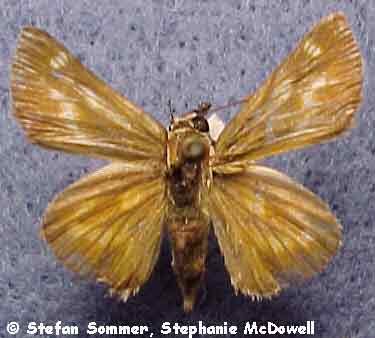
Sonora Skipper
Family: Hesperiidae
Family Description:
Alternate Common Name: Western Long Dash.
Description:
Caterpillar: The caterpillar is light green with a black head.
Adult: This is a fairly small skipper, with a wingspan of 1 to 1 ¼ inches. Although the color varies slightly, generally the upperside is brownish orange, with a darker border and several golden yellow spots. Males have a black stigma (patch of scent scales used in attracting females) on the forewing. The underside varies in color from greenish brown to light brown to blackish brown. The underside of the hindwing is marked with a curved row of whitish, square-shaped spots, with a single spot to the inside.
Range:
This species ranges from southern British Columbia south to central California, and from central and southeastern Idaho south and east to central Utah, Wyoming, and Colorado.
Habitat:
It occurs in moist areas such as meadows, along streams, and in coastal plains.
Diet:
Caterpillar: Caterpillars feed on grasses; the preferred species is currently thought to be Idaho fescue (Festuca idahoensis).
Adult: Butterflies drink flower nectar, often from white-flowered thistles.
Ecology:
There is one generation of caterpillars each summer. The overwintering stage is unreported. Adults generally fly from June through September. The butterflies when at rest are found with their forewings partially open and their hindwings fully open.
Reproduction:
Males perch to wait for receptive females. The sites chosen by females for oviposition have not been reported.
Conservation:
| Global Rank: | G5 populations levels are secure, but may be of concern in the future. |
References:
Ferris, C. D. and F. M. Brown. (eds.) 1981. Butterflies of the Rocky Mountain States. Univ. of Oklahoma Press, Norman, Oklahoma, USA, 442 pp.
Opler, P. A., H. Pavulaan, and R. E. Stanford. 1995. Butterflies of North America. Jamestown, North Dakota, USA: Northern Prairie Wildlife Research Center Home Page. http://www.npwrc.usgs.gov/resource/distr/lepid/bflyusa/bflyusa.htm (Version 05Nov98).
Opler, P. A. and A. B.Wright. 1999. A Field Guide to the Western Butterflies. Second Edition. Peterson Field Guide Series. Houghton Mifflin Company, New York, New York, USA, 540 pp.
Pyle, R. M. 1981. National Audubon Society Field Guide to North American Butterflies. Alfred A. Knopf, Inc., New York, New York, USA, 924 pp.
Scott, J. A. 1986. The Butterflies of North America. Stanford University Press, Stanford, California, USA, 583 pp.
Stanford, R. E. and P. A. Opler. 1993. Atlas of Western U.S.A. Butterflies (Including Adjacent Parts of Canada and Mexico). Published by authors, Denver, Colorado, USA, 275 pp.
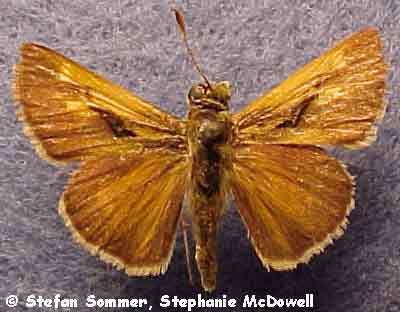
Tawny-Edged Skipper
Family: Hesperiidae
Family Description:
Description:
Caterpillar: The caterpillar varies in color and can be yellowish, greenish, maroon, or brown. It is dotted and faintly striped lengthwise with black. The head is black and marked with white.
Adult: This is a small skipper (wingspan ¾ to 1 inch), with wings that look like little triangles. The upperside is brown to dark brown, shaded with orange on the leading edge of the forewing. The male has a black stigma (patch of scent scales used in attracting females) near the center of the forewing; the female instead has several yellowish spots. The hindwing is unmarked. Underneath is brownish orange, sometimes darker where the wings attach to the body, and without any distinct markings. The underside of the hindwing may have several faint spots in a curved row.
Range:
This widespread species ranges from southern British Columbia east across southern Canada to Nova Scotia. In the U.S., it ranges from northern Washington, western Montana, central Colorado, and eastern Texas east to the Atlantic; it also occurs in Utah, Arizona, and New Mexico, as well as in isolated portions of Oregon and California. It is rare in Idaho, and has been documented to occur only in three counties along the eastern border: Fremont, Caribou, and Bear Lake.
Habitat:
The preferred habitat varies across its near high elevation lakes in the northwest, forests in California, and prairies and grassy places in the east.
Diet:
Caterpillar: Caterpillars feed on the leaves of several varieties of grasses, including panic grass (Panicum spp.), slender crabgrass (Digitaria filiformis), and bluegrass (Poa spp.).
Adult: Butterflies drink flower nectar.
Ecology:
The number of generations of caterpillars each year varies throughout the range of this species, with only one in the north and west, two to several in the Plains states to the east coast, and many throughout the year in Florida. Caterpillars construct nests with leaves tied with silk. Pupae from the last generation of the growing season may overwinter in a physiological state called diapause. Adults generally fly in July (northern part of its range and at higher elevations) or from April through September (southern part of its range and at lower elevations). The butterflies when at rest are found with their forewings partially open and their hindwings fully open.
Reproduction:
Males perch to wait for receptive females. Females lay eggs singly on or in the vicinity of host plants.
Conservation:
| Global Rank: | G5 populations are widespread, abundant, and secure. |
References:
Ferris, C. D. and F. M. Brown. (eds.) 1981. Butterflies of the Rocky Mountain States. Univ. of Oklahoma Press, Norman, Oklahoma, USA, 442 pp.
Opler, P. A., H. Pavulaan, and R. E. Stanford. 1995. Butterflies of North America. Jamestown, North Dakota, USA: Northern Prairie Wildlife Research Center Home Page. http://www.npwrc.usgs.gov/resource/distr/lepid/bflyusa/bflyusa.htm (Version 05Nov98).
Opler, P. A. and A. B.Wright. 1999. A Field Guide to the Western Butterflies. Second Edition. Peterson Field Guide Series. Houghton Mifflin Company, New York, New York, USA, 540 pp.
Pyle, R. M. 1981. National Audubon Society Field Guide to North American Butterflies. Alfred A. Knopf, Inc., New York, New York, USA, 924 pp.
Scott, J. A. 1986. The Butterflies of North America. Stanford University Press, Stanford, California, USA, 583 pp.
Stanford, R. E. and P. A. Opler. 1993. Atlas of Western U.S.A. Butterflies (Including Adjacent Parts of Canada and Mexico). Published by authors, Denver, Colorado, USA, 275 pp.
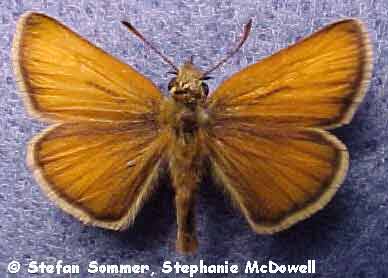
European Skipper
Family: Hesperiidae
Family Description:
Alternate Common Name: European Skipperling.
Description:
Caterpillar: The caterpillar is green and marked lengthwise with a dark stripe along the back and two yellow lines along each side. The head is tan and the face is striped with yellow.
Adult: This is a fairly small skipper, with a wingspan of 3/4 to 1 1/8 inch. The wings appear somewhat squared off and are golden orange to brownish orange on the upperside, bordered with black. The wing veins are outlined in black, particularly thick near the outer edges. Males have a small stigma (patch of scent scales used in attracting females) on the forewing, which looks like a diagonal black streak near the center. Underneath, the forewing is orange while the hindwing ranges in color from greenish yellow to greenish gray to brownish orange.
Range:
This skipper occurs in two distinct populations in North America. In the east, it ranges from southeastern Manitoba to Newfoundland and south to northeastern Missouri and Tennessee. In the west, it occurs in British Columbia, Idaho, Montana, and Colorado. Its range is continuing to expand.
Habitat:
It can be found in fields, meadows, pastures, and other grassy places.
Diet:
Caterpillar: Caterpillars feed on the leaves of timothy (Phleum pratense) and other grasses.
Adult: Butterflies drink nectar from short-stemmed flowers such as clover (Trifolium spp.), milkweed (Asclepias spp.), and thistle (Cirsium spp.).
Ecology:
Eggs overwinter and hatch in the spring. There is one generation of caterpillars each summer. Caterpillars live in nests made of leaves tied with silk. Adults generally fly from mid-May to mid-July. Butterflies roost at night in tall grasses; in some areas, the butterflies have been observed roosting together by the hundreds. A strange and detrimental behavior of some of the butterflies, reported by one expert, is crawling within orchid flowers (Cypripedium spp.) in search of nectar. Once inside the flower, the butterfly is trapped and cannot get out. Interestingly, native skippers have not been observed behaving similarly. The European Skipper was introduced to Ontario, Canada from Europe in 1910 and to British Columbia in 1960, and the species has spread considerably since. Its progressive expansion is believed by experts to be the result of the inadvertent transport of its eggs through the shipment of hay.
Reproduction:
Males actively patrol all day among grasses in search of receptive females. Strings of eggs are laid on the stems of grasses.
Conservation:
| Global Rank: | G5 populations are widespread, abundant, and secure. |
References:
Ferris, C. D. and F. M. Brown. (eds.) 1981. Butterflies of the Rocky Mountain States. Univ. of Oklahoma Press, Norman, Oklahoma, USA, 442 pp.
Opler, P. A., H. Pavulaan, and R. E. Stanford. 1995. Butterflies of North America. Jamestown, North Dakota, USA: Northern Prairie Wildlife Research Center Home Page. http://www.npwrc.usgs.gov/resource/distr/lepid/bflyusa/bflyusa.htm (Version 05Nov98).
Opler, P. A. and A. B.Wright. 1999. A Field Guide to the Western Butterflies. Second Edition. Peterson Field Guide Series. Houghton Mifflin Company, New York, New York, USA, 540 pp.
Pyle, R. M. 1981. National Audubon Society Field Guide to North American Butterflies. Alfred A. Knopf, Inc., New York, New York, USA, 924 pp.
Scott, J. A. 1986. The Butterflies of North America. Stanford University Press, Stanford, California, USA, 583 pp.
Stanford, R. E. and P. A. Opler. 1993. Atlas of Western U.S.A. Butterflies (Including Adjacent Parts of Canada and Mexico). Published by authors, Denver, Colorado, USA, 275 pp.
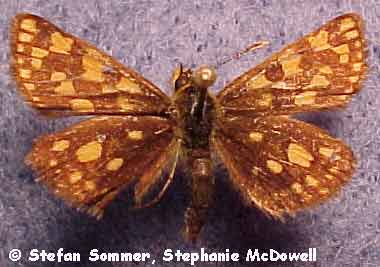
Arctic Skipper
Family: Hesperiidae
Sub-Family Description:
Alternate Common Name: Arctic Skipperling.
Description:
Caterpillar: The caterpillar is whitish green to off-white, marked lengthwise with a dark green stripe just below the back and a pale yellow stripe above a row of black spots on each side.
Adult: This is a medium-sized skipper, with a wingspan of 1 to 1¼ inches. The upperside is dark brown to black, checked with large yellow to orange squares and spots, and edged in yellow. A row of yellow spots borders the wings. Underneath is red to orange; the forewing is marked with blackish spots while the hindwing has off-white spots.
Range:
It occurs in Europe, central Alaska and across the southern half of Canada, in the Pacific Northwest south to northern California, in the Rockies to western Wyoming, and in northern Minnesota east through the Great Lakes to New England. It occurs throughout northern Idaho and along the eastern border of the state.
Habitat:
This species frequents woodlands, meadows, bogs, and grassy lowlands.
Diet:
Caterpillar: The caterpillars eat the leaves of a variety of grasses, including reed grasses (Calamagrostis spp.) and bromes (Bromus spp.).
Adult: Butterflies drink flower nectar, often from irises.
Ecology:
Caterpillars make nests of leaves tied together with silk. Older caterpillars overwinter within these nests in a physiological state called diapause, and pupate in them in the spring. There is only one generation of caterpillars each summer. Adults generally fly from May to early August. The butterflies will bask in the sun with their forewings open halfway and their hindwings open fully.
Reproduction:
Males perch to wait for receptive females, and may occasionally actively patrol. Females lay eggs on host plant leaves.
Conservation:
| Global Rank: | G5 populations are widespread, abundant, and secure. In England, however, it is an endangered species. |
References:
Ferris, C. D. and F. M. Brown. (eds.) 1981. Butterflies of the Rocky Mountain States. Univ. of Oklahoma Press, Norman, Oklahoma, USA, 442 pp.
Opler, P. A., H. Pavulaan, and R. E. Stanford. 1995. Butterflies of North America. Jamestown, North Dakota, USA: Northern Prairie Wildlife Research Center Home Page. http://www.npwrc.usgs.gov/resource/distr/lepid/bflyusa/bflyusa.htm (Version 05Nov98).
Opler, P. A. and A. B.Wright. 1999. A Field Guide to the Western Butterflies. Second Edition. Peterson Field Guide Series. Houghton Mifflin Company, New York, New York, USA, 540 pp.
Pyle, R. M. 1981. National Audubon Society Field Guide to North American Butterflies. Alfred A. Knopf, Inc., New York, New York, USA, 924 pp.
Scott, J. A. 1986. The Butterflies of North America. Stanford University Press, Stanford, California, USA, 583 pp.
Stanford, R. E. and P. A. Opler. 1993. Atlas of Western U.S.A. Butterflies (Including Adjacent Parts of Canada and Mexico). Published by authors, Denver, Colorado, USA, 275 pp.
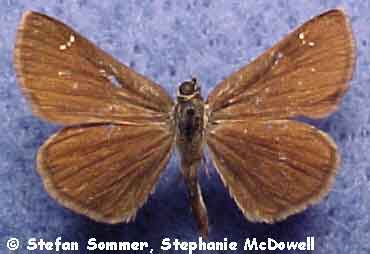
Russet Skipperling
Family: Hesperiidae
Family Description:
Alternate Common Name: Pirus Skipperling.
Description:
Caterpillar: The caterpillar is green, covered with whitish hair, and marked lengthwise with several white and green lines. The head is brownish green and marked with orangish brown and offwhite stripes.
Adult: This is a fairly small skipper, with a wingspan of 1 to 1 1/8 inches. The upperside is brown, velvety in appearance, and unmarked except for a scattering of tiny white dots, three of which are in a row at the tip of the forewing. Underneath, the forewing is mostly dark brown with the outer edge reddish brown, or it may be entirely reddish brown; the dots from above show through. The underside of the hindwing is reddish brown and unmarked.
Range:
This species exhibits a small range in the intermountain west and southwestern U.S., extending from southeastern Idaho and southern Wyoming, through Utah and Colorado, to parts of Arizona and New Mexico.
Habitat:
It occurs in moist valleys and gulches, open oak woodlands, and in riparian areas.
Diet:
Caterpillar: Though records are sparse, caterpillars are believed to feed on the leaves of grasses (Poa spp.).
Adult: Butterflies drink flower nectar, often from dogbane (Apocynum spp.) and alfalfa (Medicago spp.).
Ecology:
There is one generation of caterpillars each summer. Caterpillars construct nests from leaves tied with silk. Mature caterpillars overwinter in a physiological state called diapause. Adults generally fly from the end of May through the first of August. Butterflies bask in the sun with their forewings partially open and their hindwings fully open.
Reproduction:
Males actively patrol in search of receptive females. The site chosen by females for oviposition has not been reported.
Conservation:
| Global Rank: | G5 populations levels are secure, but may be of concern in the future. |
References:
Ferris, C. D. and F. M. Brown. (eds.) 1981. Butterflies of the Rocky Mountain States. Univ. of Oklahoma Press, Norman, Oklahoma, USA, 442 pp.
Opler, P. A., H. Pavulaan, and R. E. Stanford. 1995. Butterflies of North America. Jamestown, North Dakota, USA: Northern Prairie Wildlife Research Center Home Page. http://www.npwrc.usgs.gov/resource/distr/lepid/bflyusa/bflyusa.htm (Version 05Nov98).
Opler, P. A. and A. B.Wright. 1999. A Field Guide to the Western Butterflies. Second Edition. Peterson Field Guide Series. Houghton Mifflin Company, New York, New York, USA, 540 pp.
Pyle, R. M. 1981. National Audubon Society Field Guide to North American Butterflies. Alfred A. Knopf, Inc., New York, New York, USA, 924 pp.
Scott, J. A. 1986. The Butterflies of North America. Stanford University Press, Stanford, California, USA, 583 pp.
Stanford, R. E. and P. A. Opler. 1993. Atlas of Western U.S.A. Butterflies (Including Adjacent Parts of Canada and Mexico). Published by authors, Denver, Colorado, USA, 275 pp.
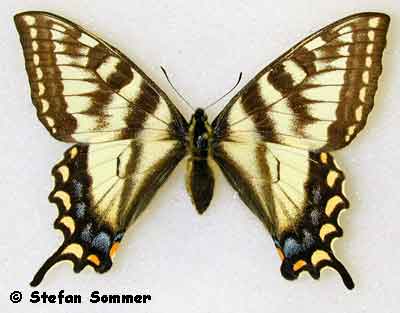
Canadian Tiger Swallowtail
Family: Papilionidae
Family Description:
Note: This species may be referred to as a subspecies of Papilio glaucus, the Tiger Swallowtail, by some authors.
Description:
Caterpillar: The caterpillar is green, enlarged in the front, and marked near the head with four yellow dots and two yellowish eyespots with bluish centers.
Adult: The butterfly is large (but small for a Swallowtail), with a wingspan of 2 1/2 to 3 1/4 inches, and tailed. The upperside is bright yellow and edged with a thick, black border marked with yellow dashes. The forewing is marked four broad, fairly parallel black bands. The hindwing is marked diagonally with a long and narrow black band, and is edged with black along the inside edge, next to the body. The rear of the hindwing is marked with two crescent-shaped blue spots, one of which edges an orange, similarly-shaped spot. The underside of the forewing is similar to the upperside, but the yellow dashes marking the black border are joined forming a continuous line. The underside of the hindwing is also similar to the upperside but is additionally clouded with orange. Note that a rare black form of female can occur.
Range:
This Swallowtail ranges from Alaska and the Yukon Territory south through British Columbia and east across Canada to the east coast. It extends into the extreme northern U.S. from northeastern Washington to central Michigan, and from northern New York into New England. It occurs in the panhandle of Idaho.
Habitat:
It can be found in and along deciduous and mixed forests.
Diet:
Caterpillar: Caterpillars feed on the leaves of several species of trees: birches (Betula spp.), aspen (Populus spp.), crabapple (Malus spp.), and black cherry (Prunus serotina.).
Adult: Butterflies drink flower nectar.
Ecology:
Caterpillars construct small feeding structures from folded leaves tied and lined with silk. There is only one generation of caterpillars each year. Pupae overwinter in a physiological state called diapause, with the adults generally emerging to fly from May to mid-August. Males may often be observed puddling. This species may hybridize with Papilio rutulus, the Western Tiger Swallowtail, but such pairings are rare.
Reproduction:
Males actively patrol in search of receptive females. Females lay eggs singly on the leaves of host plants.
Conservation:
| Global Rank: |
G5; populations are widespread, abundant, and secure. |
References:
Ferris, C. D. and F. M. Brown. (eds.) 1981. Butterflies of the Rocky Mountain States. Univ. of Oklahoma Press, Norman, Oklahoma, USA, 442 pp.
Opler, P. A., H. Pavulaan, and R. E. Stanford. 1995. Butterflies of North America. Jamestown, North Dakota, USA: Northern Prairie Wildlife Research Center Home Page. http://www.npwrc.usgs.gov/resource/distr/lepid/bflyusa/bflyusa.htm (Version 05Nov98).
Opler, P. A. and A. B.Wright. 1999. A Field Guide to the Western Butterflies. Second Edition. Peterson Field Guide Series. Houghton Mifflin Company, New York, New York, USA, 540 pp.
Pyle, R. M. 1981. National Audubon Society Field Guide to North American Butterflies. Alfred A. Knopf, Inc., New York, New York, USA, 924 pp.
Scott, J. A. 1986. The Butterflies of North America. Stanford University Press, Stanford, California, USA, 583 pp.
Stanford, R. E. and P. A. Opler. 1993. Atlas of Western U.S.A. Butterflies (Including Adjacent Parts of Canada and Mexico). Published by authors, Denver, Colorado, USA, 275 pp.
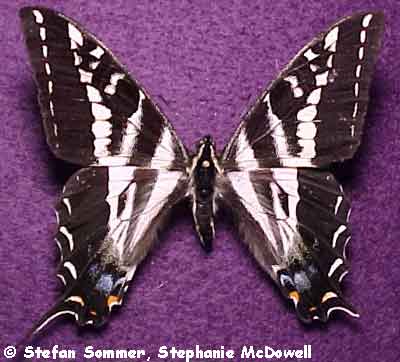
Pale Swallowtail
Family: Papilionidae
Family Description:
Alternate Common Names:Pale Tiger Swallowtail, Pallid Tiger Swallowtail.
Note: Some authors use an alternate genus name for this species, Pterourus. Occasionally the older genus name, Euphoeades, may still be used.
Description:
Caterpillar: The caterpillar is green (brown right before pupating) with a brownish head. It is marked with two yellowish eyespots with blue centers towards the head, followed by a yellow and black band across the "neck", and several longitudinal rows of small blue dots along the body.
Adult: This is a large butterfly, with a wingspan of 3 inches, and it bears the characteristic long "tail" extending from the rear of the hindwing. The upperside is white or cream and marked with wide, diagonal and almost parallel black bands. The black wing borders may have a row of white bars. The rear of the hindwing is marked with several patches of blue and orange. Underneath is similarly marked but may be paler; the wing veins are dark.
Range:
This western species ranges from southern British Columbia south through the Pacific Northwest to southern California and northern Nevada; and from northern Idaho and western Montana south to central Utah and northern New Mexico.
Habitat:
It occurs in open, hilly areas, often with chaparral and scrubby woodlands; often found upslope, towards hilltops.
Diet:
Caterpillar: Caterpillars feed on the leaves of a variety of trees and shrubs, including cherry (Prunus spp.), coffeeberry (Rhamnus spp.), and particularly Ceanothus species such as wild lilac and mountain balm.
Adult: Butterflies drink flower nectar.
Ecology:
Caterpillars construct silken mats attached to leaves which they rest on while feeding. There is only one generation of caterpillars each year in most of its range; there may be several in southern California. A pupa’s color depends upon the number of hours of sunlight (photoperiod) the pupa is exposed to, with pupae from the long days of summer being green and those from later in the season being brown. Late season pupae overwinter in a physiological state called diapause. Adults generally fly from late April through July in most of its range. Adults can often be found "puddling" on muddy spots or moist dung where they collect salts and other nutrients.
Reproduction:
Males actively patrol in search of receptive females, but may occasionally perch to wait for them to pass by. Courting males and females will often congregate at high points in the landscape in order to find potential mates. This behavior is called "hill topping." Females lay eggs singly on the leaves of host plants.
Conservation:
| Global Rank: |
G5; populations are widespread, abundant, and secure. |
References:
Ferris, C. D. and F. M. Brown. (eds.) 1981. Butterflies of the Rocky Mountain States. Univ. of Oklahoma Press, Norman, Oklahoma, USA, 442 pp.
Opler, P. A., H. Pavulaan, and R. E. Stanford. 1995. Butterflies of North America. Jamestown, North Dakota, USA: Northern Prairie Wildlife Research Center Home Page. http://www.npwrc.usgs.gov/resource/distr/lepid/bflyusa/bflyusa.htm (Version 05Nov98).
Opler, P. A. and A. B.Wright. 1999. A Field Guide to the Western Butterflies. Second Edition. Peterson Field Guide Series. Houghton Mifflin Company, New York, New York, USA, 540 pp.
Pyle, R. M. 1981. National Audubon Society Field Guide to North American Butterflies. Alfred A. Knopf, Inc., New York, New York, USA, 924 pp.
Scott, J. A. 1986. The Butterflies of North America. Stanford University Press, Stanford, California, USA, 583 pp.
Stanford, R. E. and P. A. Opler. 1993. Atlas of Western U.S.A. Butterflies (Including Adjacent Parts of Canada and Mexico). Published by authors, Denver, Colorado, USA, 275 pp.
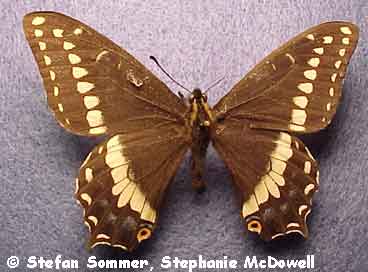
Indra Swallowtail
Family: Papilionidae
Family Description:
Alternate Common Names:Short-Tailed Black Swallowtail, Cliff Swallowtail.
Description:
Caterpillar: The caterpillars vary in appearance both with age and subspecies. Young caterpillars are mottled with black, brown and white, looking much like a bird dropping (a good camouflage strategy). Older caterpillars are generally black and ringed with white, pink, or yellow; at or near each ring are spots of orange, yellow, or white.
Adult: This is a large species, with a wingspan of 2½ to 3 inches, and it has a very short to medium length tail extending from each hindwing. The butterfly’s coloration varies a great deal. Generally, however, the upperside is mostly brownish black and usually marked with a thin to broad, yellowish white band which runs from wingtip to wingtip, forming a flattened out "V". The edges of the wings are lined with a row of whitish spots. The hindwing is marked with several patches of blue and an orange eyespot with a dark center. Underneath is similarly marked. The abdomen is often used in identification of this species: it is either completely black or marked only with a small whitish dash on each side, towards the rear.
Range:
Primarily a western species, it occurs from Washington south to southern California, and east to southeastern Montana south to northern New Mexico. In Idaho, it occurs in the north central to the southwestern parts of the state, and in patches of the southeast.
Habitat:
It occurs in dry, open areas such as deserts, canyons, and pinyon-juniper woodlands, in mountains, and in ponderosa pine forests.
Diet:
Caterpillar: Caterpillars feed on the leaves of members of the parsley family (Apiaceae), including lomatium (Lomatium spp.) and cymopterus (Cymopterus spp.).
Adult: Butterflies drink flower nectar.
Ecology:
There is generally only one generation of caterpillars each summer. Caterpillars hide at the bases of their host plants which are most often growing among rocks. Pupae overwinter in a physiological state called diapause, and may remain in diapause for several seasons if conditions are unfavorably dry. Adults generally fly from May through early July inmost of its range. Butterflies frequent the tops of rocky slopes. This behavior is called "hill topping" and is an important strategy for finding mates.
Reproduction:
Males perch to wait for receptive females, and may defend a territory from competing males. Females lay eggs singly on the bottom side of host plant leaves.
Conservation:
| Global Rank: |
G5; populations are widespread, abundant, and secure. |
References:
Ferris, C. D. and F. M. Brown. (eds.) 1981. Butterflies of the Rocky Mountain States. Univ. of Oklahoma Press, Norman, Oklahoma, USA, 442 pp.
Opler, P. A., H. Pavulaan, and R. E. Stanford. 1995. Butterflies of North America. Jamestown, North Dakota, USA: Northern Prairie Wildlife Research Center Home Page. http://www.npwrc.usgs.gov/resource/distr/lepid/bflyusa/bflyusa.htm (Version 05Nov98).
Opler, P. A. and A. B.Wright. 1999. A Field Guide to the Western Butterflies. Second Edition. Peterson Field Guide Series. Houghton Mifflin Company, New York, New York, USA, 540 pp.
Pyle, R. M. 1981. National Audubon Society Field Guide to North American Butterflies. Alfred A. Knopf, Inc., New York, New York, USA, 924 pp.
Scott, J. A. 1986. The Butterflies of North America. Stanford University Press, Stanford, California, USA, 583 pp.
Stanford, R. E. and P. A. Opler. 1993. Atlas of Western U.S.A. Butterflies (Including Adjacent Parts of Canada and Mexico). Published by authors, Denver, Colorado, USA, 275 pp.
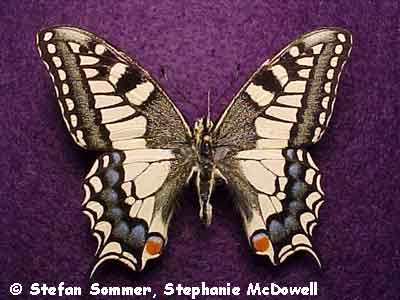
Old World Swallowtail
Family: Papilionidae
Family Description:
Alternate Common Name: Artemisia Swallowtail.
Description:
Caterpillar: The caterpillars vary in appearance both according to age and location. Young caterpillars are mottled with black, brown and white, looking much like a bird dropping (a good camouflage strategy). Older caterpillars are generally green and ringed with black, often heavily; the rings are dotted with orange, yellow, or red spots.
Adult: Butterflies vary in appearance as well, particularly in the amount of yellow and black present both above and below. They are fairly large, with a wingspan of 2 ½ to 2 ¾ inches, and have a tail extending from the hindwing. Generally, the upperside is brownish black marked with yellow. A band of yellow, elongated spots spans across the wings; along the wings’ edges is a row of yellow bars. The part of each wing close to the body is black and is often hairy on the hindwing. The hindwing has a wide, curved band of blue; also present is an orange spot, outlined in black, possibly with the black curving into the center of the spot. The underside of the wings is marked similarly but more faintly; there may be more orange bordering the blue on the hindwing.
Range:
This species is holarctic, which means it can be found in parts of the northern temperate regions of the entire Northern Hemisphere. In North America, it ranges from Alaska across most of Canada, and from southern British Columbia through the western third of the U.S. to Arizona and New Mexico (not along the Pacific coast or in most of California). It has been documented in a number of counties in Idaho, scattered throughout the state. It is generally an uncommon butterfly.
Habitat:
It occurs in arctic and alpine areas, along forests, and on open hilltops.
Diet:
Caterpillar: Caterpillars feed on certain members of the parsley family (Apiaceae), and on arctic sagebrush (Artemisia arctica). Young caterpillars eat leaves while older ones prefer flowers and associated structures.
Adult: Butterflies drink flower nectar.
Ecology:
There is one generation of caterpillars each summer in the northern part of its range, and two in the south. Pupae present in autumn will overwinter in a physiological state called diapause, and may remain in diapause for several seasons if conditions are unfavorably dry. Adults generally fly from June through July in the northern part of its range, and from April to September in the southern part of its range. Butterflies frequent the tops of slopes, a behavior called "hill topping." It is an important strategy for finding mates. This species has not been studied extensively in the U.S., and much of what we know comes from detailed studies conducted in Europe.
Reproduction:
Males both perch and actively patrol to find receptive females, and spend most of their time on hilltops when seeking a mate. Females lay eggs singly on host plants.
Conservation:
| Global Rank: |
G5; populations are widespread, abundant, and secure. |
References:
Opler, P. A., H. Pavulaan, and R. E. Stanford. 1995. Butterflies of North America. Jamestown, North Dakota, USA: Northern Prairie Wildlife Research Center Home Page. http://www.npwrc.usgs.gov/resource/distr/lepid/bflyusa/bflyusa.htm (Version 05Nov98).
Opler, P. A. and A. B.Wright. 1999. A Field Guide to the Western Butterflies. Second Edition. Peterson Field Guide Series. Houghton Mifflin Company, New York, New York, USA, 540 pp.
Pyle, R. M. 1981. National Audubon Society Field Guide to North American Butterflies. Alfred A. Knopf, Inc., New York, New York, USA, 924 pp.
Scott, J. A. 1986. The Butterflies of North America. Stanford University Press, Stanford, California, USA, 583 pp.
Stanford, R. E. and P. A. Opler. 1993. Atlas of Western U.S.A. Butterflies (Including Adjacent Parts of Canada and Mexico). Published by authors, Denver, Colorado, USA, 275 pp.
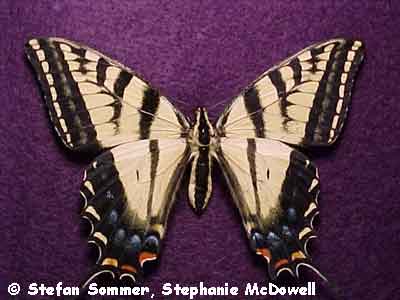
Two-Tailed Swallowtail
Family: Papilionidae
Family Description:
Alternate Common Name: Two-Tailed Tiger Swallowtail.
Note: Some sources refer to this species with an alternate genus name, Pterourus. Occasionally, the older genus name, Euphoeades, may be used.
Description:
Caterpillar: The caterpillar is light green and marked near the head with four yellow dots and two yellowish eyespots with blue centers. The "neck" is banded with black and yellow, and the body has several rows of tiny blue dots. The caterpillar turns brownish or reddish in the last stage prior to pupation.
Adult: The butterfly is large, with a wingspan of 3 ½ to 5 inches. The upperside is yellow to orangish yellow and edged thickly with black. Each side of the butterfly has four narrow, diagonal, nearly parallel stripes; the innermost stripe is the longest, while the outermost two may simply be bars. The hindwing has a curved row of blue patches; below the blue are several bars or spots of orange. There are two tails extending from the rear of the hindwing, with the innermost tail considerably shorter. The underside is marked similarly. The underside of the hindwing is edged with black, then blue, then yellow bars.
Range:
This species ranges from southern British Columbia and Alberta south through the western half of the U.S. to western Texas and into Mexico. The range extends east as far as the western edge of the Dakotas, central Nebraska, and Oklahoma’s panhandle. In Idaho, it occurs throughout much of the state.
Habitat:
It uses a variety of habitats, including canyonlands, foothills, valleys, woodlands, and gardens.
Diet:
Caterpillar: Caterpillars feed on the leaves of a variety of trees and shrubs, including ash (Fraxinus spp.) and cherry (Prunus spp.).
Adult: Butterflies drink flower nectar.
Ecology:
Caterpillars construct small feeding structures from folded leaves tied and lined with silk. The number of generations of caterpillars produced each year varies with location, with only one in the north, several in the south, and many in Texas. Pupae present at the end of the growing season overwinter in a physiological state called diapause, although occasionally some finish pupating and emerge as adults that same autumn. Adults generally fly from April to October in the northern part of its range, and fly most of the year in the southern part of its range.
Reproduction:
Males actively patrol in search of receptive females. Females lay eggs singly on host plant leaves.
Conservation:
| Global Rank: |
G5; populations are widespread, abundant, and secure. |
References:
Ferris, C. D. and F. M. Brown. (eds.) 1981. Butterflies of the Rocky Mountain States. Univ. of Oklahoma Press, Norman, Oklahoma, USA, 442 pp.
Opler, P. A., H. Pavulaan, and R. E. Stanford. 1995. Butterflies of North America. Jamestown, North Dakota, USA: Northern Prairie Wildlife Research Center Home Page. http://www.npwrc.usgs.gov/resource/distr/lepid/bflyusa/bflyusa.htm (Version 05Nov98).
Opler, P. A. and A. B.Wright. 1999. A Field Guide to the Western Butterflies. Second Edition. Peterson Field Guide Series. Houghton Mifflin Company, New York, New York, USA, 540 pp.
Pyle, R. M. 1981. National Audubon Society Field Guide to North American Butterflies. Alfred A. Knopf, Inc., New York, New York, USA, 924 pp.
Scott, J. A. 1986. The Butterflies of North America. Stanford University Press, Stanford, California, USA, 583 pp.
Stanford, R. E. and P. A. Opler. 1993. Atlas of Western U.S.A. Butterflies (Including Adjacent Parts of Canada and Mexico). Published by authors, Denver, Colorado, USA, 275 pp.
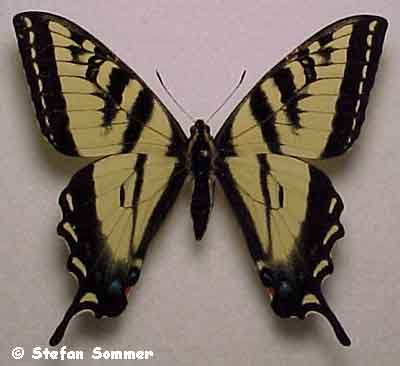
Western Tiger Swallowtail
Family: Papilionidae
Family Description:
Note: Authors address this species in several alternate ways. Some refer to it with the genus name, Pterourus. Occasionally it may be referred to with the older genus name, Euphoeades. Finally, it may be referred to as a subspecies of Papilio glaucus, the Tiger Swallowtail.
Description:
Caterpillar: The caterpillar is green, enlarged in the front, and marked near the head with four yellow dots and two yellowish eyespots with bluish centers. The "neck" is banded with black and yellow, and the body has several rows of tiny blue dots. The caterpillar turns brownish in the last stage prior to pupation. It can reach a maximum length of two inches.
Adult: The butterfly is large, with a wingspan of 2 ¾ to 4 inches, and tailed. The upperside is bright yellow and edged with a thick, black border. Each side of the butterfly is marked with four wide, diagonal, nearly parallel stripes; the innermost stripe is the longest, while the outermost two are simply bars. The hindwing has several patches of blue and only one or two spots or crescents of orange. Underneath is similarly marked; the hindwing is edged with a continuous blue line followed by a row of yellow bars, and there is little orange.
Range:
This species ranges from southern British Columbia and Alberta south through the western third of the U.S. to southern California, Arizona, and New Mexico; it ranges east as far as western South Dakota and central Colorado. It occurs throughout all of Idaho.
Habitat:
This Swallowtail utilizes a variety of habitats, including canyonlands, sagebrush steppe, woodlands, and gardens.
Diet:
Caterpillar: Caterpillars feed on the leaves of several species of trees and shrubs: cottonwoods, poplars, and aspen (Populus spp.), willows (Salix spp.), alders (Alnus spp.), cherry (Prunus spp.), and ash (Fraxinus spp.).
Adult: Butterflies drink flower nectar.
Ecology:
Caterpillars construct small feeding structures from folded leaves tied and lined with silk. There is only one generation of caterpillars each year in those parts of its range with shorter summers, while there may be up to three generations where conditions are more favorable. Adults generally fly from June through July in most of its range, but from February to November along the coast of the Pacific and throughout the year in southern California. While this is the primary Swallowtail of the west, it has an eastern counterpart, Papilio glaucus, which occurs throughout Canada and the eastern half of the U.S. as far as central Montana, eastern Wyoming and Colorado, and central Texas. Papilio glaucus has recently been documented in Idaho, in Latah and Clearwater Counties. The two species may hybridize where they meet.
Reproduction:
Males actively patrol in search of receptive females. Females lay shiny green eggs singly on the leaves of host plants.
Conservation:
| Global Rank: |
G5; populations are widespread, abundant, and secure. |
References:
Ferris, C. D. and F. M. Brown. (eds.) 1981. Butterflies of the Rocky Mountain States. Univ. of Oklahoma Press, Norman, Oklahoma, USA, 442 pp.
Opler, P. A., H. Pavulaan, and R. E. Stanford. 1995. Butterflies of North America. Jamestown, North Dakota, USA: Northern Prairie Wildlife Research Center Home Page. http://www.npwrc.usgs.gov/resource/distr/lepid/bflyusa/bflyusa.htm (Version 05Nov98).
Opler, P. A. and A. B.Wright. 1999. A Field Guide to the Western Butterflies. Second Edition. Peterson Field Guide Series. Houghton Mifflin Company, New York, New York, USA, 540 pp.
Pyle, R. M. 1981. National Audubon Society Field Guide to North American Butterflies. Alfred A. Knopf, Inc., New York, New York, USA, 924 pp.
Scott, J. A. 1986. The Butterflies of North America. Stanford University Press, Stanford, California, USA, 583 pp.
Stanford, R. E. and P. A. Opler. 1993. Atlas of Western U.S.A. Butterflies (Including Adjacent Parts of Canada and Mexico). Published by authors, Denver, Colorado, USA, 275 pp.
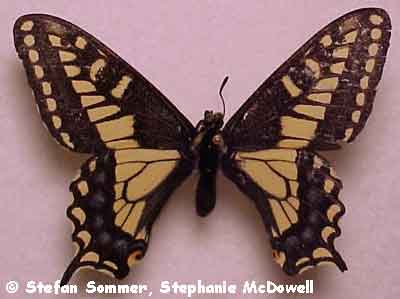
Anise Swallowtail
Family: Papilionidae
Family Description:
Description:
Caterpillar: The caterpillar is typically green to bluish green and marked with alternating thick and thin black bands. The thick bands are dotted with yellow to orange spots, and each segment is marked with one or two black spots on the bottom of each side, right above the "leg." It can reach a maximum length of two inches.
Adult: The butterfly is large, with a wingspan 2 ¾ to 3 ½ inches, and tailed. The upperside is yellow marked with black. Specifically, the black occurs near the body, in a thick band spotted with yellow on the front leading edge of the forewing, and in a thick border, dotted with yellow, from the forewing tip to the rear. The yellow occurs as a straight band spanning the wings, curving down towards the abdomen on the hindwing. The hindwing is marked with several patches of blue and at the rear with an orange eyespot that has an isolated black center. Underneath, the butterfly is similarly marked. Both the fore- and the hindwing have more blue than on the upperside, and the hindwing has several hazy spots of orange on both sides of the blue patches. The butterfly’s abdomen is black and marked with a wide yellow stripe on the side. Note that a rare, black form of the species can occur.
Range:
This species ranges from central British Columbia and Alberta south through the western half of the U.S. to southern California and northern Arizona and New Mexico. It ranges east as far as the western edge of the Dakotas and Nebraska and central Colorado. In Idaho, it occurs throughout most of the state.
Habitat:
It utilizes almost every type of habitat except within forests.
Diet:
Caterpillar: Caterpillars feed on the leaves, buds, and flowers of a variety of plant species, primarily from the parsley family (Apiaceae) and several from the citrus family (Rutaceae).
Adult: Butterflies drink flower nectar.
Ecology:
There are two generations of caterpillars each year in most of the range. There may be only one generation in higher elevations and there are many each year in California. Younger caterpillars feed on leaves and switch to flowers when older. They may cause damage to citrus groves in California. Pupae present when temperatures drop will overwinter in a physiological state called diapause, and can remain in diapause for several seasons. Adults generally fly from April through July inmost of its range.
Reproduction:
Males both perch and actively patrol in search of receptive females. Courting males and females will often congregate at high points in the landscape in order to find potential mates. This behavior is called "hill topping." Females lay eggs on the leaves and flowers of host plants.
Conservation:
| Global Rank: |
G5; populations are widespread, abundant, and secure. |
References:
Ferris, C. D. and F. M. Brown. (eds.) 1981. Butterflies of the Rocky Mountain States. Univ. of Oklahoma Press, Norman, Oklahoma, USA, 442 pp.
Opler, P. A., H. Pavulaan, and R. E. Stanford. 1995. Butterflies of North America. Jamestown, North Dakota, USA: Northern Prairie Wildlife Research Center Home Page. http://www.npwrc.usgs.gov/resource/distr/lepid/bflyusa/bflyusa.htm (Version 05Nov98).
Opler, P. A. and A. B.Wright. 1999. A Field Guide to the Western Butterflies. Second Edition. Peterson Field Guide Series. Houghton Mifflin Company, New York, New York, USA, 540 pp.
Pyle, R. M. 1981. National Audubon Society Field Guide to North American Butterflies. Alfred A. Knopf, Inc., New York, New York, USA, 924 pp.
Scott, J. A. 1986. The Butterflies of North America. Stanford University Press, Stanford, California, USA, 583 pp.
Stanford, R. E. and P. A. Opler. 1993. Atlas of Western U.S.A. Butterflies (Including Adjacent Parts of Canada and Mexico). Published by authors, Denver, Colorado, USA, 275 pp.

Clodius Parnassian
Family: Papilionidae
Family Description:
Alternate Common Name: American Apollo.
Description:
Caterpillar: The caterpillar is generally black, covered with short black hair, and marked with a row of orange or yellow spots along the bottom of each side. Caterpillars from high altitude may be grayish brown to grayish pink, shaded with yellow and marked with black. The black, spotted form is believed to mimic a poisonous centipede while the high altitude form is colored to camouflage with its environment. Both strategies provide protection from predators.
Adult: The butterfly is fairly large, with a wingspan of 2 to 3 inches. It has a black body and black antennae. The upperside of the wings is white to creamy white. The forewing has three dark gray to black bars on the leading edge; the outer edge and tip are marked with varying amounts and shades of gray, in striated bars or checks. Portions of the forewing may appear transparent. The hindwing is mostly white, may be lightly shaded with gray stripes or checks, and marked with two red (rarely orange, yellow, or black) spots and/or a red bar. The underside of the wings is similarly marked. Females, if they have mated, have a white pouch (called a sphragis) at the tip of the abdomen. Placed there by the male, it contains the sperm and important nutrients and prevents the female from mating again.
Range:
This species ranges from the western coast of British Columbia south through the Pacific Northwest of the U.S. It extends south into California and east to western Montana and Wyoming and northern Utah. In Idaho, it is found throughout much of the state.
Habitat:
It can be found in open woodlands, alpine meadows, forest edges, and in moist forests.
Diet:
Caterpillar: Caterpillars feed at night on species of the bleeding-heart family (Fumariaceae, Dicentra spp.).
Adult: Butterflies drink flower nectar.
Ecology:
There is one generation of caterpillars each summer. Butterflies have two tiny hooks on the surface of the forewing which provide assistance when emerging from the silk cocoon. Eggs overwinter and the caterpillars emerge in the spring. At high elevations, the caterpillars may overwinter as well, thus requiring two years to fully develop. Adults generally fly from May through July. Butterflies exhibit a strong, high flight pattern. Only three species of Parnassians occur in North America, two of which occur in Idaho.
Reproduction:
Males actively patrol in search of receptive females. After mating, the male attaches a waxy secretion (the sphragis) to the tip of the female’s abdomen, to prevent her from mating again. Females lay eggs on or near host plants.
Conservation:
| Global Rank: |
G5; populations are widespread, abundant, and secure. |
References:
Ferris, C. D. and F. M. Brown. (eds.) 1981. Butterflies of the Rocky Mountain States. Univ. of Oklahoma Press, Norman, Oklahoma, USA, 442 pp.
Opler, P. A., H. Pavulaan, and R. E. Stanford. 1995. Butterflies of North America. Jamestown, North Dakota, USA: Northern Prairie Wildlife Research Center Home Page. http://www.npwrc.usgs.gov/resource/distr/lepid/bflyusa/bflyusa.htm (Version 05Nov98).
Opler, P. A. and A. B.Wright. 1999. A Field Guide to the Western Butterflies. Second Edition. Peterson Field Guide Series. Houghton Mifflin Company, New York, New York, USA, 540 pp.
Pyle, R. M. 1981. National Audubon Society Field Guide to North American Butterflies. Alfred A. Knopf, Inc., New York, New York, USA, 924 pp.
Scott, J. A. 1986. The Butterflies of North America. Stanford University Press, Stanford, California, USA, 583 pp.
Stanford, R. E. and P. A. Opler. 1993. Atlas of Western U.S.A. Butterflies (Including Adjacent Parts of Canada and Mexico). Published by authors, Denver, Colorado, USA, 275 pp.
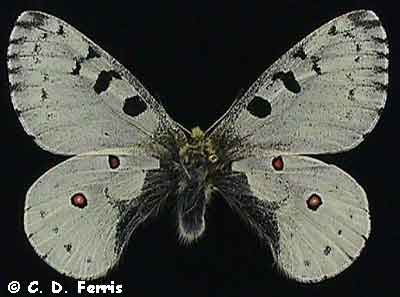
Rocky Mountain Parnassian
Family: Papilionidae
Family Description:
Alternate Common Names:Small Apollo, Phoebus Parnassian.
Note: This species is listed as a subspecies of P. phoebus, a species found in Alaska and northwestern Canada, by some authors.
Description:
Caterpillar: The caterpillar is black, covered with short black hair, and is marked with one or two rows of yellow or orange spots on each side. It is small, reaching a maximum length of one inch.
Adult: The butterfly is fairly large, with a wingspan of 2 to 3 inches, and has black-and-white ringed antennae. The male is white to offwhite on the upperside. The forewing is marked with grayish shading at the tip and outer edge. There are several irregularly-shaped spots; usually three are black and two to three are reddish, pinkish, yellow, or brown. The hindwing is mostly white and has one or two reddish spots or rings. The female is grayish to white, and may appear transparent; the markings are similar to the male’s, but the gray shading may be more extensive. Females, if they have mated, have a white pouch (called a sphragis) at the tip of the abdomen. Placed there by the male, it contains the sperm and important nutrients and prevents the female from mating again.
Range:
This species ranges from Alaska south and east to central New Mexico; it also extends into California in the Sierra Nevadas. It occurs through much of Idaho.
Habitat:
It can be found in tundra, mountain meadows, grasslands, and sagebrush steppe.
Diet:
Caterpillar: Caterpillars feed on the leaves and sometimes flowers and fruits of stonecrop (Sedum spp.).
Adult: Butterflies drink flower nectar, especially from host plant flowers and yellow flowers belonging to the sunflower family (Asteraceae).
Ecology:
There is one generation of caterpillars each summer, hatching from eggs that were laid the previous year and overwintered. At high elevations, the caterpillars may overwinter as well, thus requiring two years to fully develop. Caterpillars can crawl into tiny spaces, like those found in soil. Pupation occurs within a silk cocoon located in ground debris. Adults generally fly from late May through August. Butterflies have two tiny hooks on the surface of the forewing which provide assistance when emerging from where they were pupating. Only three species of Parnassians occur in North America, two of which occur in Idaho.
Reproduction:
Males actively patrol in search of receptive females. After mating, the male attaches a waxy secretion (the sphragis) to the tip of the female’s abdomen, to prevent her from mating again. Females lay eggs randomly on soil, debris, and plants of many species.
Conservation:
| Global Rank: |
G5; populations are widespread, abundant, and secure. |
References:
Ferris, C. D. and F. M. Brown. (eds.) 1981. Butterflies of the Rocky Mountain States. Univ. of Oklahoma Press, Norman, Oklahoma, USA, 442 pp.
Opler, P. A., H. Pavulaan, and R. E. Stanford. 1995. Butterflies of North America. Jamestown, North Dakota, USA: Northern Prairie Wildlife Research Center Home Page. http://www.npwrc.usgs.gov/resource/distr/lepid/bflyusa/bflyusa.htm (Version 05Nov98).
Opler, P. A. and A. B.Wright. 1999. A Field Guide to the Western Butterflies. Second Edition. Peterson Field Guide Series. Houghton Mifflin Company, New York, New York, USA, 540 pp.
Pyle, R. M. 1981. National Audubon Society Field Guide to North American Butterflies. Alfred A. Knopf, Inc., New York, New York, USA, 924 pp.
Scott, J. A. 1986. The Butterflies of North America. Stanford University Press, Stanford, California, USA, 583 pp.
Stanford, R. E. and P. A. Opler. 1993. Atlas of Western U.S.A. Butterflies (Including Adjacent Parts of Canada and Mexico). Published by authors, Denver, Colorado, USA, 275 pp.
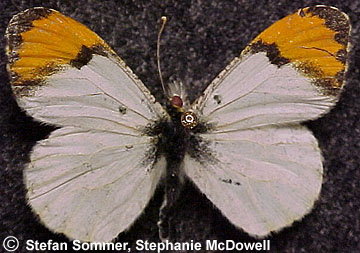
Sara Orangetip
Family: Pieridae
Family Description:
Alternate Common Name: Western Orange Tip.
Note: Some authors consider this to be a complex of subspecies, including sara, stella, julia, and thoosa. Others split out several of the subspecies, considering them instead to be independent species of Orangetips, and consider Anthocharis sara to be a more strictly defined species occurring only along the Pacific coast.
Description:
Caterpillar: The caterpillar is green and marked with a stripe of white bordered by green on both sides. It is covered with short black hair.
Adult: The butterfly has a wingspan of 1 1/4 to 1 7/8 inches. The upperside is yellowish white to white. At the tip of the forewing is a large orange patch, outlined in black; the patch is smaller in females than in males. The border of the wings may be spotted with black. Underneath, the forewing is marked similarly to above, but paler; the hindwing is mottled with greenish brown and white.
Range:
This species ranges from Alaska south to southern California, east to the eastern side of the Rockies, and south through New Mexico. It occurs through most of Idaho.
Habitat:
The Sara Orangetip can be found in a variety of open places, such as meadows, fields, ridge tops, canyons, and deserts.
Diet:
Caterpillar: Caterpillars feed on members of the mustard family (Brassicaceae), including cresses (Arabis spp.), tumble mustard (Sisymbrium spp.) and tansy mustard (Descurainia spp.). Young caterpillars eat leaves while older ones feed on flowers and fruits.
Adult: Butterflies drink flower nectar.
Ecology:
There is usually one generation of caterpillars during the summer. Pupae overwinter in a physiological state called diapause. There may be two generations in some locations in California, in which case only the second overwinters. Adults generally fly from March through July. Butterflies typically fly close to the ground and close to vegetation.
Reproduction:
Males actively patrol valleys for receptive females. Females lay eggs singly on various parts of host plants, typically towards the top of the plant.
Conservation:
| Global Rank: |
G5; populations are widespread, abundant, and secure. |
References:
Ferris, C. D. and F. M. Brown. (eds.) 1981. Butterflies of the Rocky Mountain States. Univ. of Oklahoma Press, Norman, Oklahoma, USA, 442 pp.
Opler, P. A., H. Pavulaan, and R. E. Stanford. 1995. Butterflies of North America. Jamestown, North Dakota, USA: Northern Prairie Wildlife Research Center Home Page. http://www.npwrc.usgs.gov/resource/distr/lepid/bflyusa/bflyusa.htm (Version 05Nov98).
Opler, P. A. and A. B.Wright. 1999. A Field Guide to the Western Butterflies. Second Edition. Peterson Field Guide Series. Houghton Mifflin Company, New York, New York, USA, 540 pp.
Pyle, R. M. 1981. National Audubon Society Field Guide to North American Butterflies. Alfred A. Knopf, Inc., New York, New York, USA, 924 pp.
Scott, J. A. 1986. The Butterflies of North America. Stanford University Press, Stanford, California, USA, 583 pp.
Stanford, R. E. and P. A. Opler. 1993. Atlas of Western U.S.A. Butterflies (Including Adjacent Parts of Canada and Mexico). Published by authors, Denver, Colorado, USA, 275 pp.
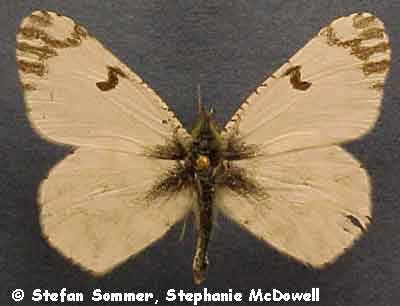
Large Marble
Family: Pieridae
Family Description:
Alternate Common Names:Large Marble White, Dappled Marble, Ausonides Marble, Creamy Marblewing.
Description:
Caterpillar: The caterpillar is dark green to bluish gray and marked lengthwise with yellow and white stripes along the back and sides. It is covered with tiny black dots, and reaches a maximum length of ¾ inch.
Adult: The butterfly is medium-sized, with a wingspan of 1 ½ to 2 inches. It is white on the upperside, with the interior of the wings shaded with black close to the body. The forewing is tipped with black to brown and spotted with white; there may be a single, dark crescent-shaped spot near the edge. The hindwing is offwhite, and the marks on its underside slightly show through. Underneath, the forewing is white with yellowish tips and marked similarly to the topside. The underside of the hindwing is marbled with thick lines of yellowish green to brown, and has noticeable yellow veins.
Range:
This is a butterfly of primarily western North America, ranging from central Alaska south to California and northern Arizona and New Mexico, and east to the western portions of the Plains states, and to northern Minnesota and southwestern Ontario. It occurs through most of Idaho.
Habitat:
It can be found in open, often moist areas, including fields, meadows, and open forests.
Diet:
Caterpillar: Caterpillars eat the buds, flowers, and fruits of members of the mustard family (Brassicaceae), such as rock cress (Arabis spp.) and various mustards (Brassica spp., Descurainia spp., and Sisymbrium spp.).
Adult: Butterflies drink nectar, most often from yellow or white flowers of their host plants.
Ecology:
There is one generation of caterpillars per growing season through most of its range, but there may be two in California, the first of which occurs in early spring. Pupae overwinter in a physiological state called diapause. Adults generally fly from late April through August.
Reproduction:
Males actively patrol to find receptive females. Females lay eggs singly on the flower buds of host plants.
Conservation:
| Global Rank: |
G5; populations are widespread, abundant, and secure. |
References:
Ferris, C. D. and F. M. Brown. (eds.) 1981. Butterflies of the Rocky Mountain States. Univ. of Oklahoma Press, Norman, Oklahoma, USA, 442 pp.
Opler, P. A., H. Pavulaan, and R. E. Stanford. 1995. Butterflies of North America. Jamestown, North Dakota, USA: Northern Prairie Wildlife Research Center Home Page. http://www.npwrc.usgs.gov/resource/distr/lepid/bflyusa/bflyusa.htm (Version 05Nov98).
Opler, P. A. and A. B.Wright. 1999. A Field Guide to the Western Butterflies. Second Edition. Peterson Field Guide Series. Houghton Mifflin Company, New York, New York, USA, 540 pp.
Pyle, R. M. 1981. National Audubon Society Field Guide to North American Butterflies. Alfred A. Knopf, Inc., New York, New York, USA, 924 pp.
Scott, J. A. 1986. The Butterflies of North America. Stanford University Press, Stanford, California, USA, 583 pp.
Stanford, R. E. and P. A. Opler. 1993. Atlas of Western U.S.A. Butterflies (Including Adjacent Parts of Canada and Mexico). Published by authors, Denver, Colorado, USA, 275 pp.
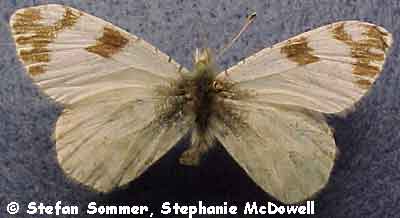
Desert Marble
Family: Pieridae
Family Description:
Alternate Common Names:Pearly Marble White, Pearly Marblewing, Western Marble, Hyantis Marble.
Note: Some authors consider this species to be a subspecies of Euchloe hyantis, the Pearly Marble. As presented here, Euchloe lotta occurs throughout Idaho and Euchloe hyantis is a more strictly defined species occurring primarily in northern and central California.
Description:
Caterpillar: The caterpillar is green to grayish green and marked lengthwise along the sides with white edged with purple along the top.
Adult: The butterfly is small to medium-sized, with a wingspan of 1 to 1 ¼ inches. It is pearly white on the upperside, with the interior of the wings shaded black close to the body. The forewing is spotted with black at the tip, and has a solid black bar just in from the edge. The hindwing is white, and the underside markings partially show through. Underneath, the forewing is white and marked similarly to the top, but more greenish in color. The underside of the hindwing is marbled with thick green to brown lines.
Range:
A western butterfly, it ranges from southern British Columbia south through eastern Washington and Oregon to southeastern California, and east to western Montana south to western New Mexico. It occurs throughout most of the state of Idaho.
Habitat:
It is found in dry, open areas, including sagebrush steppe, chaparral, deserts, open woodlands, and rocky canyons.
Diet:
Caterpillar: Caterpillars typically eat the flowers and fruits of members of the mustard family (Brassicaceae), such as rock cress (Arabia spp.), tansy mustard (Descurainia spp.), and jewel flower (Streptanthus spp.).
Adult: Butterflies drink flower nectar.
Ecology:
There is one generation of caterpillars each growing season. Pupae overwinter in a physiological state called diapause. Adults generally fly from February to June.
Reproduction:
Males actively patrol for receptive females. Females lay yellow, elongated eggs singly typically on the leaves of host plants.
Conservation:
| Global Rank: |
Unranked. |
References:
Ferris, C. D. and F. M. Brown. (eds.) 1981. Butterflies of the Rocky Mountain States. Univ. of Oklahoma Press, Norman, Oklahoma, USA, 442 pp.
Opler, P. A., H. Pavulaan, and R. E. Stanford. 1995. Butterflies of North America. Jamestown, North Dakota, USA: Northern Prairie Wildlife Research Center Home Page. http://www.npwrc.usgs.gov/resource/distr/lepid/bflyusa/bflyusa.htm (Version 05Nov98).
Opler, P. A. and A. B.Wright. 1999. A Field Guide to the Western Butterflies. Second Edition. Peterson Field Guide Series. Houghton Mifflin Company, New York, New York, USA, 540 pp.
Pyle, R. M. 1981. National Audubon Society Field Guide to North American Butterflies. Alfred A. Knopf, Inc., New York, New York, USA, 924 pp.
Scott, J. A. 1986. The Butterflies of North America. Stanford University Press, Stanford, California, USA, 583 pp.
Stanford, R. E. and P. A. Opler. 1993. Atlas of Western U.S.A. Butterflies (Including Adjacent Parts of Canada and Mexico). Published by authors, Denver, Colorado, USA, 275 pp.
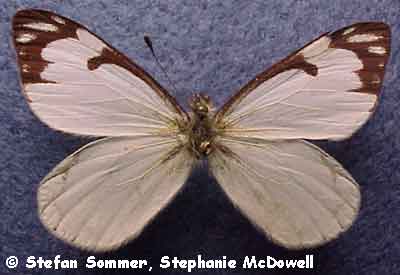
Pine White
Family: Pieridae
Family Description:
Description:
Caterpillar: The caterpillar is dark green to purplish green in color, and is marked lengthwise with white stripes along the back and sides. It has two short "tails" at the rear.
Adult: The butterfly is medium-sized, with a wingspan of 1 ¾ to 2 inches. It is white on the upperside and marked with black on the forewing, mostly at the tip and along the forward edge. Females may also have black veins on the hindwing. Underneath, the forewing is white and marked with thick black lines; the entire underside of the hindwing is marked with black veins. The hindwing of females may be edged in yellowish orange to red.
Range:
This species ranges from southern British Columbia and Alberta south through the western U.S. to California and northern Arizona and New Mexico. A small portion of its range extends into western South Dakota and northwestern Nebraska. In Idaho, it occurs in the panhandle and central portions of the state.
Habitat:
This species can be found in coniferous forests.
Diet:
Caterpillar: Caterpillars feed on the needles of a variety of conifers including pines (Pinus spp.), firs (Abies spp.), and Douglas-fir (Pseudotsuga menziesii).
Adult: Butterflies drink flower nectar, often from yellow flowers belonging to the sunflower family (Asteraceae), such as from rabbitbrush (Chrysothamnus spp.).
Ecology:
Eggs overwinter and hatch in the spring. There is one generation of caterpillars each year. Young caterpillars feed in groups; occasional outbreaks of caterpillars can result in the defoliation of conifer stands. Caterpillars may pupate on bark, twigs, or on vegetation of the forest floor. One researcher found that pupae on bark or twigs were brown while pupae on vegetation were green; another researcher attributes pupal color to sex. Adults generally fly from late June through September. They can be seen flying among the treetops in the afternoon. This is the only white butterfly found in stands of pines in most of the U.S., except in parts of Arizona where there may be additional species of white butterflies in conifer forests.
Reproduction:
Males patrol in search of receptive females. Females lay green eggs in tight rows on conifer needles.
Conservation:
| Global Rank: |
G5; populations are widespread, abundant, and secure. |
References:
Ferris, C. D. and F. M. Brown. (eds.) 1981. Butterflies of the Rocky Mountain States. Univ. of Oklahoma Press, Norman, Oklahoma, USA, 442 pp.
Opler, P. A., H. Pavulaan, and R. E. Stanford. 1995. Butterflies of North America. Jamestown, North Dakota, USA: Northern Prairie Wildlife Research Center Home Page. http://www.npwrc.usgs.gov/resource/distr/lepid/bflyusa/bflyusa.htm (Version 05Nov98).
Opler, P. A. and A. B.Wright. 1999. A Field Guide to the Western Butterflies. Second Edition. Peterson Field Guide Series. Houghton Mifflin Company, New York, New York, USA, 540 pp.
Pyle, R. M. 1981. National Audubon Society Field Guide to North American Butterflies. Alfred A. Knopf, Inc., New York, New York, USA, 924 pp.
Scott, J. A. 1986. The Butterflies of North America. Stanford University Press, Stanford, California, USA, 583 pp.
Stanford, R. E. and P. A. Opler. 1993. Atlas of Western U.S.A. Butterflies (Including Adjacent Parts of Canada and Mexico). Published by authors, Denver, Colorado, USA, 275 pp.
Margined White
Family: Pieridae
Family Description:
Note: This species is considered a variety of Artogeia napi by some sources.
Description:
Caterpillar: The caterpillar is dark green and striped lengthwise along the back and sides with yellow.
Adult: This butterfly is medium-sized, with a wingspan ranging from 1 ½ to 2 ¼ inches. It varies in its appearance depending on when it emerges. Spring butterflies are white on the upperside, with the tip of the forewing marked with black. Underneath is white except for the tip of the forewing and the entire hindwing, both of which are marked with yellowish to grayish green on the veins. Summer butterflies are entirely white both on the upper- and undersides.
Range:
This species ranges from southern British Columbia and Alberta south to California, Arizona, and New Mexico; it extends east as far as Wyoming and Colorado. It occurs through most of Idaho.
Habitat:
It can be found in meadows, forests, and woodlands.
Diet:
Caterpillar: Caterpillars feed on the leaves of native species in the mustard family (Brassicaceae).
Adult: Butterflies drink flower nectar, often from host plants.
Ecology:
There are two generations of caterpillars each year. Caterpillars of the second generation pupate, then overwinter within their chrysalises in a physiological state called diapause. Adults generally fly from May through August in most of its range.
Reproduction:
Males actively patrol in search of receptive females. Females lay eggs singly on the undersides of leaves of host plants.
Conservation:
| Global Rank: |
G5; populations are widespread, abundant, and secure. |
References:
Ferris, C. D. and F. M. Brown. (eds.) 1981. Butterflies of the Rocky Mountain States. Univ. of Oklahoma Press, Norman, Oklahoma, USA, 442 pp.
Opler, P. A., H. Pavulaan, and R. E. Stanford. 1995. Butterflies of North America. Jamestown, North Dakota, USA: Northern Prairie Wildlife Research Center Home Page. http://www.npwrc.usgs.gov/resource/distr/lepid/bflyusa/bflyusa.htm (Version 05Nov98).
Opler, P. A. and A. B.Wright. 1999. A Field Guide to the Western Butterflies. Second Edition. Peterson Field Guide Series. Houghton Mifflin Company, New York, New York, USA, 540 pp.
Pyle, R. M. 1981. National Audubon Society Field Guide to North American Butterflies. Alfred A. Knopf, Inc., New York, New York, USA, 924 pp.
Stanford, R. E. and P. A. Opler. 1993. Atlas of Western U.S.A. Butterflies (Including Adjacent Parts of Canada and Mexico). Published by authors, Denver, Colorado, USA, 275 pp.
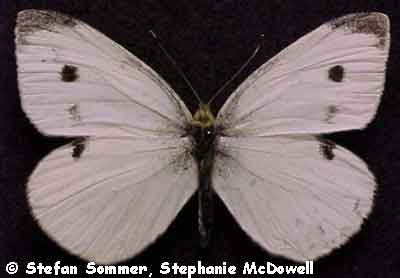
Cabbage White
Family: Pieridae
Family Description:
Alternate Common Name: Small White.
Note: This species is listed with the genus name Artogeia by some authors.
Description:
Caterpillar: The caterpillar is small, typically less than 1 inch long. It is green to bluish green, dotted lightly with tiny black dots, and striped lengthwise with yellow along the back and a row of yellow dashes along the side. The body is covered with short, white hairs.
Adult: The butterfly is medium-sized, with a wingspan of 1 ž to 2 ź inches. It varies in appearance slightly between the sexes and the seasons. Generally, the upperside is white to yellowish white. The forewing is marked with brownish to black shading at the tip; there is a single black spot in males, two in females. The hindwing is entirely white. Underneath, most of the forewing is white while its tip, and the hindwing, are light yellowish green to grayish green. Butterflies from the first and last generations of each year (early spring and late fall, respectively) tend to be smaller, with more white than yellow and very little black.
Range:
This widespread species ranges from central Canada south throughout the entire U.S. into Mexico. It occurs in almost all of Idaho.
Habitat:
It occurs in virtually all open areas, most often in gardens, cultivated fields, and in urban habitats.
Diet:
Caterpillar: Caterpillars feed on the leaves of a variety of plants, primarily members of the mustard family (Brassicaceae), the caper family (Capparidaceae), and the nasturtium family (Tropaeolaceae).
Adult: Butterflies drink flower nectar, preferring purple, blue and yellow flowers.
Ecology:
The number of generations of caterpillars each growing season varies with the length of that season, ranging from two to three in the north and as many as eight in the south. Caterpillars can cause damage to gardens and certain crops. Pupae overwinter in a physiological state called diapause. Butterflies typically can be observed from the last frost of spring until the first frosts of autumn. Studies of their flight patterns indicate that they are able to fly significant distances, and tend to fly in a single direction on a given day, but that the preferred direction of flight changes from one day to the next. This species was introduced in Canada and in California in the 1860s, from Europe.
Reproduction:
Males actively patrol in search of receptive females. Females lay yellowish white eggs singly on the leaves of host plants.
Conservation:
| Global Rank: |
G5; populations are widespread, abundant, and secure. |
References:
Ferris, C. D. and F. M. Brown. (eds.) 1981. Butterflies of the Rocky Mountain States. Univ. of Oklahoma Press, Norman, Oklahoma, USA, 442 pp.
Opler, P. A., H. Pavulaan, and R. E. Stanford. 1995. Butterflies of North America. Jamestown, North Dakota, USA: Northern Prairie Wildlife Research Center Home Page. http://www.npwrc.usgs.gov/resource/distr/lepid/bflyusa/bflyusa.htm (Version 05Nov98).
Opler, P. A. and A. B.Wright. 1999. A Field Guide to the Western Butterflies. Second Edition. Peterson Field Guide Series. Houghton Mifflin Company, New York, New York, USA, 540 pp.
Pyle, R. M. 1981. National Audubon Society Field Guide to North American Butterflies. Alfred A. Knopf, Inc., New York, New York, USA, 924 pp.
Scott, J. A. 1986. The Butterflies of North America. Stanford University Press, Stanford, California, USA, 583 pp.
Stanford, R. E. and P. A. Opler. 1993. Atlas of Western U.S.A. Butterflies (Including Adjacent Parts of Canada and Mexico). Published by authors, Denver, Colorado, USA, 275 pp.
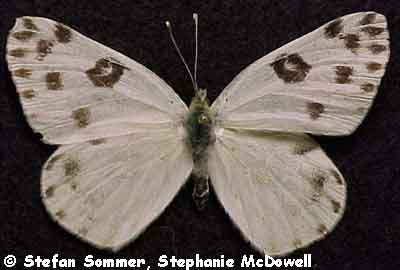
Becker’s White
Family: Pieridae
Family Description:
Alternate Common Name: Sagebrush White.
Description:
Caterpillar: The caterpillar is light green, ringed with yellow, and dotted with black.
Adult: The butterfly is medium-sized, with a wingspan of 1 ½ to 2 inches. It is white on the upperside. The forewing has a large black spot with a white center, and black markings at the tip and along the edge. Females may have black spots on the hindwing, as well. Underneath, the forewing is whitish; the spot from above shows through as black, while the other markings show through as grayish green. The underside of the hindwing is marbled with grayish green at the base while the outer edge is striped.
Range:
This species ranges from southern British Columbia and western Montana south to southern California and northern Arizona and New Mexico, extending east as far as western South Dakota and eastern Colorado. It occurs through most of Idaho.
Habitat:
It can be found in dry, often hot habitats, such as sagebrush steppe, desert foothills, and canyons.
Diet:
Caterpillar: Caterpillars feed on various parts of members of the mustard family (Brassicaceae), including mustards (Brassica spp.) and hedge mustards (Sisymbrium spp.), and bladderpod (Isomeris arborea) of the caper family (Capparidaceae).
Adult: Butterflies drink flower nectar.
Ecology:
There are generally two generations of caterpillars each year, and possibly more in the south. Pupae from the last generation of the year overwinter in a physiological state called diapause. Adults generally fly from March to October.
Reproduction:
Males actively patrol in search of receptive females. Females lay eggs singly on all parts of host plants.
Conservation:
| Global Rank: |
G5; populations are widespread, abundant, and secure. |
References:
Ferris, C. D. and F. M. Brown. (eds.) 1981. Butterflies of the Rocky Mountain States. Univ. of Oklahoma Press, Norman, Oklahoma, USA, 442 pp.
Opler, P. A., H. Pavulaan, and R. E. Stanford. 1995. Butterflies of North America. Jamestown, North Dakota, USA: Northern Prairie Wildlife Research Center Home Page. http://www.npwrc.usgs.gov/resource/distr/lepid/bflyusa/bflyusa.htm (Version 05Nov98).
Opler, P. A. and A. B.Wright. 1999. A Field Guide to the Western Butterflies. Second Edition. Peterson Field Guide Series. Houghton Mifflin Company, New York, New York, USA, 540 pp.
Pyle, R. M. 1981. National Audubon Society Field Guide to North American Butterflies. Alfred A. Knopf, Inc., New York, New York, USA, 924 pp.
Scott, J. A. 1986. The Butterflies of North America. Stanford University Press, Stanford, California, USA, 583 pp.
Stanford, R. E. and P. A. Opler. 1993. Atlas of Western U.S.A. Butterflies (Including Adjacent Parts of Canada and Mexico). Published by authors, Denver, Colorado, USA, 275 pp.
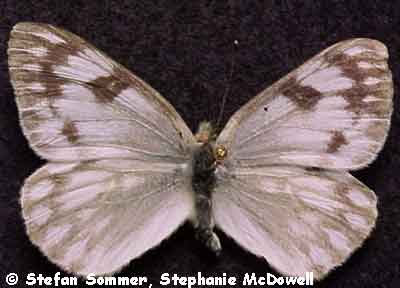
Western White
Family: Pieridae
Family Description:
Description:
Caterpillar: The caterpillar is green and ringed with alternating light and dark bands.
Adult: The butterfly has a wingspan of 1 ¼ to 2 inches. Its coloration and markings vary both between the sexes and with the time of year. Generally, the upperside is white and marked with black and gray. Specifically, the forewing is bordered by a row of triangle-shaped, blackish spots, followed by an incomplete row of similar spots. There are two black spots, one on the leading edge and one near the inside edge. The hindwing has a black or faint gray border marked with white, diamond-shaped spots. The veins may be marked in gray, especially in females. Underneath, the wings are white and marked with grayish green lines, at the tip of the forewing and over the entire hindwing. Periods of short daylength (in the spring and fall) result in butterflies with the most pronounced markings.
Range:
This species ranges from Alaska south and east across Canada to western Ontario. In the U.S., it occurs throughout the northwest quarter, as far south as central California to central Colorado. It can be found throughout most of Idaho.
Habitat:
It occurs in sunny, open areas, such as alpine meadows, open plains, fields, and in the arctic.
Diet:
Caterpillar: Caterpillars feed on various parts of members of the mustard family (Brassicaceae) and the caper family (Capparaceae).
Adult: Butterflies drink flower nectar.
Ecology:
There is one generation of caterpillars each summer in the northernmost part of its range, and two to three where the climate is more mild. Pupae of the last generation overwinter in a physiological state called diapause. Adults generally fly from February to November in most of its range, but may fly only in June and July where the climate is harsh.
Reproduction:
Males actively patrol in search of receptive females. Females lay eggs singly on host plants.
Conservation:
| Global Rank: |
G5; populations are widespread, abundant, and secure. |
References:
Ferris, C. D. and F. M. Brown. (eds.) 1981. Butterflies of the Rocky Mountain States. Univ. of Oklahoma Press, Norman, Oklahoma, USA, 442 pp.
Opler, P. A., H. Pavulaan, and R. E. Stanford. 1995. Butterflies of North America. Jamestown, North Dakota, USA: Northern Prairie Wildlife Research Center Home Page. http://www.npwrc.usgs.gov/resource/distr/lepid/bflyusa/bflyusa.htm (Version 05Nov98).
Opler, P. A. and A. B.Wright. 1999. A Field Guide to the Western Butterflies. Second Edition. Peterson Field Guide Series. Houghton Mifflin Company, New York, New York, USA, 540 pp.
Pyle, R. M. 1981. National Audubon Society Field Guide to North American Butterflies. Alfred A. Knopf, Inc., New York, New York, USA, 924 pp.
Scott, J. A. 1986. The Butterflies of North America. Stanford University Press, Stanford, California, USA, 583 pp.
Stanford, R. E. and P. A. Opler. 1993. Atlas of Western U.S.A. Butterflies (Including Adjacent Parts of Canada and Mexico). Published by authors, Denver, Colorado, USA, 275 pp.
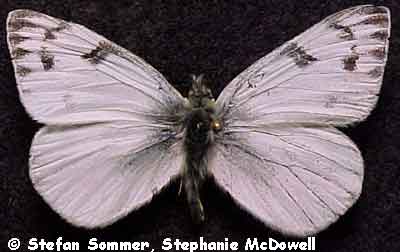
Checkered White
Family: Pieridae
Family Description:
Alternate Common Name: Common White.
Note: Some sources refer to this species with the older genus name Pieris.
Description:
Caterpillar: The caterpillar is bluish green to bluish gray, striped lengthwise with yellow on the back and sides, and dotted with black. The head is yellow; the body is covered with downy hair.
Adult: The butterfly is medium-sized, with a wingspan of 1 ¼ to 2 ½ inches. It varies considerably in the intensity of its markings, both between the sexes and seasonally. Generally, the upperside is white marked with black. The forewing has two large black patches, and a black border marked with white triangles. The hindwing is also bordered with black; the border is interrupted with white triangle- or diamond-shaped spots. The veins may be outlined in gray. The underside varies from nearly pure white with a few brownish spots, to white spotted with brown on the forewing and striped with brown or grayish green on the hindwing. Variations: Females may have brown instead of black, and the markings may appear more cloudy. Also, males may be entirely white except for a black spot on the forewing, if they developed during the summer months.
Range:
This widespread species ranges from south central Canada, through most of the U.S. to northern Mexico. It is absent from the state of Washington and northern New England. It is a yearlong resident in the southern part of its range. It occurs through much of Idaho.
Habitat:
It occurs in a variety of common habitats, including fields, vacant lots, pastures, and weedy and disturbed areas.
Diet:
Caterpillar: Caterpillars feed on most parts of native and introduced members of the mustard family (Brassicaceae) and the caper family (Capparidaceae).
Adult: Butterflies drink flower nectar.
Ecology:
There are generally three generations of caterpillars each year through most of its range. There may be four in parts of the south, and in certain regions there may be continuous generations. Pupae can overwinter in a physiological state called diapause. Adults generally fly from February to November, but may fly all year long in the southernmost part of its range.
Reproduction:
Males actively patrol in search of receptive females, although females have been reported to seek out males as well. Females lay yellow eggs singly on the leaves and flowers of host plants.
Conservation:
| Global Rank: |
G4; population levels are secure, but may be of concern in the future. |
References:
Ferris, C. D. and F. M. Brown. (eds.) 1981. Butterflies of the Rocky Mountain States. Univ. of Oklahoma Press, Norman, Oklahoma, USA, 442 pp.
Opler, P. A., H. Pavulaan, and R. E. Stanford. 1995. Butterflies of North America. Jamestown, North Dakota, USA: Northern Prairie Wildlife Research Center Home Page. http://www.npwrc.usgs.gov/resource/distr/lepid/bflyusa/bflyusa.htm (Version 05Nov98).
Opler, P. A. and A. B.Wright. 1999. A Field Guide to the Western Butterflies. Second Edition. Peterson Field Guide Series. Houghton Mifflin Company, New York, New York, USA, 540 pp.
Pyle, R. M. 1981. National Audubon Society Field Guide to North American Butterflies. Alfred A. Knopf, Inc., New York, New York, USA, 924 pp.
Scott, J. A. 1986. The Butterflies of North America. Stanford University Press, Stanford, California, USA, 583 pp.
Stanford, R. E. and P. A. Opler. 1993. Atlas of Western U.S.A. Butterflies (Including Adjacent Parts of Canada and Mexico). Published by authors, Denver, Colorado, USA, 275 pp.
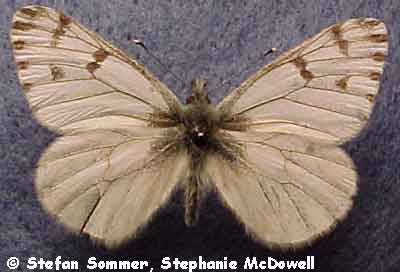
Spring White
Family: Pieridae
Family Description:
Alternate Common Names:California White, Sisymbrium White.
Note: This species is referred to by the older genus name Pieris by some sources.
Description:
Caterpillar: The caterpillar is brightly marked with horizontal stripes: thin white and black, thick and wavy black, and thick yellow. The head is black and marked with white.
Adult: The butterfly is medium-sized, with a wingspan of 1 ź to 1 ž inches. The upperside is white to yellowish white. The forewing is marked with a black or gray spot in the center, and black or gray marks at the tip and along the edge. Underneath is white to beige. The underside of the hindwing is marked along the veins with brown to blackish brown, which may be dusted with off-white in freshly emerged individuals. The forewing tip or the entire forewing may have brownish veins on the underside as well.
Range:
This species ranges from the Yukon and western Northwest Territories south to southern California and Mexico, extending east as far as central Alberta, western Montana, western South Dakota, and central Colorado. It occurs through much of Idaho.
Habitat:
It can be found in coniferous forests, dry slopes and canyons, deserts, and in alpine areas of west coast mountains.
Diet:
Caterpillar: Caterpillars feed on the leaves and flowers of members of the mustard family (Brassicaceae), such as hedge mustards (Sisymbrium spp.), rock cresses (Arabis spp.), and jewel flower (Streptanthus spp.).
Adult: Butterflies drink flower nectar.
Ecology:
There is one generation of caterpillars each year. Pupae overwinter in a physiological state called diapause, and butterflies emerge in the spring, often very early. Adults generally fly from February to June.
Reproduction:
Males actively patrol in search of receptive females. Females lay yellow eggs singly on all parts of host plants.
Conservation:
| Global Rank: |
G5; populations are widespread, abundant, and secure. |
References:
Ferris, C. D. and F. M. Brown. (eds.) 1981. Butterflies of the Rocky Mountain States. Univ. of Oklahoma Press, Norman, Oklahoma, USA, 442 pp.
Opler, P. A., H. Pavulaan, and R. E. Stanford. 1995. Butterflies of North America. Jamestown, North Dakota, USA: Northern Prairie Wildlife Research Center Home Page. http://www.npwrc.usgs.gov/resource/distr/lepid/bflyusa/bflyusa.htm (Version 05Nov98).
Opler, P. A. and A. B.Wright. 1999. A Field Guide to the Western Butterflies. Second Edition. Peterson Field Guide Series. Houghton Mifflin Company, New York, New York, USA, 540 pp.
Pyle, R. M. 1981. National Audubon Society Field Guide to North American Butterflies. Alfred A. Knopf, Inc., New York, New York, USA, 924 pp.
Scott, J. A. 1986. The Butterflies of North America. Stanford University Press, Stanford, California, USA, 583 pp.
Stanford, R. E. and P. A. Opler. 1993. Atlas of Western U.S.A. Butterflies (Including Adjacent Parts of Canada and Mexico). Published by authors, Denver, Colorado, USA, 275 pp.
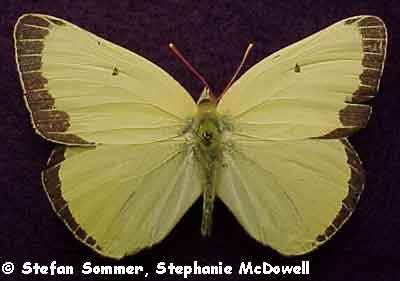
Queen Alexandra’s Sulphur
Family: Pieridae
Family Description:
Note: This species has both yellow and orange morphs, or types; however, the orange morphs occur only in northern and central Canada and parts of the Midwest so are not described here.
Description:
Caterpillar: The caterpillar is yellowish green and marked with tiny black dots and white side stripes.
Adult: This is a medium-sized butterfly, with a wingspan of 1 ½ to 2 ¼ inches. The adult male and female of this species look slightly different from one another. Males are bright yellow on the upperside, the forewing pointed at the tip and marked with a small black spot. The fore- and hindwings are edged with a brown to black border, which may be thicker on the forewing. The male butterflies reflect ultraviolet light from the outer portions of their wings. Females are yellow to white on the upperside and may have a faint border on the forewing or no border at all. Underneath, both sexes are yellowish on the forewing and grayish green on the hindwing, which is marked with a white spot.
Range:
The yellow morphs of this species occur in British Columbia and Alberta, south to eastern California and northern Arizona and New Mexico. They occur through much of Idaho.
Habitat:
This species prefers open habitats, including fields, meadows, sagebrush steppe, and forest openings.
Diet:
Caterpillar: Caterpillars eat the leaves of plants of the pea family (Fabaceae), such as milk vetch (Astragalus spp.) and lupines (Lupinus spp.).
Adult: Butterflies drink flower nectar.
Ecology:
There is only one generation of caterpillars each year. The caterpillars overwinter in a physiological state called diapause, and emerge in the spring to pupate. Adults generally fly from mid-may to September. Large numbers of adult males can frequently be observed congregating at muddy sites where they obtain salt, a behavior called puddling.
Reproduction:
Males actively patrol in search of receptive females. Females lay yellowish eggs singly on the topsides of host plant leaves.
Conservation:
| Global Rank: |
G5; populations are widespread, abundant, and secure. |
References:
Ferris, C. D. and F. M. Brown. (eds.) 1981. Butterflies of the Rocky Mountain States. Univ. of Oklahoma Press, Norman, Oklahoma, USA, 442 pp.
Opler, P. A., H. Pavulaan, and R. E. Stanford. 1995. Butterflies of North America. Jamestown, North Dakota, USA: Northern Prairie Wildlife Research Center Home Page. http://www.npwrc.usgs.gov/resource/distr/lepid/bflyusa/bflyusa.htm (Version 05Nov98).
Opler, P. A. and A. B.Wright. 1999. A Field Guide to the Western Butterflies. Second Edition. Peterson Field Guide Series. Houghton Mifflin Company, New York, New York, USA, 540 pp.
Pyle, R. M. 1981. National Audubon Society Field Guide to North American Butterflies. Alfred A. Knopf, Inc., New York, New York, USA, 924 pp.
Scott, J. A. 1986. The Butterflies of North America. Stanford University Press, Stanford, California, USA, 583 pp.
Stanford, R. E. and P. A. Opler. 1993. Atlas of Western U.S.A. Butterflies (Including Adjacent Parts of Canada and Mexico). Published by authors, Denver, Colorado, USA, 275 pp.
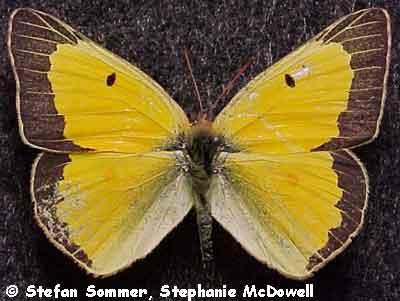
Orange Sulphur
Family: Pieridae
Family Description:
Alternate Common Name: Alfalfa Butterfly.
Description:
Caterpillar: The caterpillar is dark green, marked lengthwise with pinkish and white side stripes, and covered with white hair.
Adult: The butterfly is medium-sized to large, with a wingspan of 1 3/8 to 2 3/4 inches. It varies in color regionally, seasonally, and between the sexes. Generally, males are yellow to orange on the upperside, marked with a thick black border, a small black spot on the forewing, and possibly a small orange spot on the hindwing. Females can be orange to yellow to white and marked similarly, but the border is irregular and interrupted with yellow spots. The underside of both sexes can be orange to yellow to greenish yellow, with the edges of the wings fringed in pinkish white. The underside of the fore- and hindwings may each have a white spot outlined in brown or black, with the forewing spot appearing darker and the hindwing spot topped with a tiny, second spot. A faint row of dark spots spaced apart spans the outer portion of the underside of both wings.
Range:
This is a widespread species, found throughout southern Canada and the continental U.S., south to central Mexico. It occurs throughout Idaho.
Habitat:
It is most often found in open areas, such as lawns, meadows, and fields, particularly those with clover or alfalfa.
Diet:
Caterpillar: Caterpillars eat the leaves of legume plants, such as alfalfa (Medicago sativa), milk vetches (Astragulus spp.), and clovers (Trifolium and Melilotus spp.).
Adult: Butterflies drink flower nectar.
Ecology:
Caterpillars typically feed at night. When young, they chew holes in the tops of leaves; later they feed on the tips of leaves, while the oldest caterpillars eat one side of a leaf at a time. There can be two to three generations of caterpillars each summer in the north, and up to five in the south. Either the older caterpillars or the pupae of the last brood of the season overwinter in a physiological state called diapause. Adults generally fly from May through October. Large numbers of adult males can frequently be observed congregating at muddy sites where they obtain salt and nutrients, a behavior called puddling. This species can occasionally hybridize with the Common Sulphur, Colias philodice, where both are present. The Orange Sulphur is one of the most common butterflies in North America, and the caterpillars’ presence in large numbers can cause significant damage to alfalfa crops.
Reproduction:
Males actively patrol in search of receptive females. Females lay eggs singly on host plant leaves, often on the upperside.
Conservation:
| Global Rank: |
G5; populations are widespread, abundant, and secure. |
References:
Ferris, C. D. and F. M. Brown. (eds.) 1981. Butterflies of the Rocky Mountain States. Univ. of Oklahoma Press, Norman, Oklahoma, USA, 442 pp.
Opler, P. A., H. Pavulaan, and R. E. Stanford. 1995. Butterflies of North America. Jamestown, North Dakota, USA: Northern Prairie Wildlife Research Center Home Page. http://www.npwrc.usgs.gov/resource/distr/lepid/bflyusa/bflyusa.htm (Version 05Nov98).
Opler, P. A. and A. B.Wright. 1999. A Field Guide to the Western Butterflies. Second Edition. Peterson Field Guide Series. Houghton Mifflin Company, New York, New York, USA, 540 pp.
Pyle, R. M. 1981. National Audubon Society Field Guide to North American Butterflies. Alfred A. Knopf, Inc., New York, New York, USA, 924 pp.
Scott, J. A. 1986. The Butterflies of North America. Stanford University Press, Stanford, California, USA, 583 pp.
Stanford, R. E. and P. A. Opler. 1993. Atlas of Western U.S.A. Butterflies (Including Adjacent Parts of Canada and Mexico). Published by authors, Denver, Colorado, USA, 275 pp.
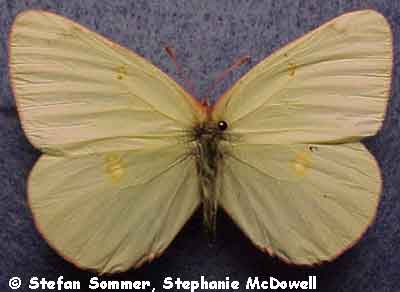
Giant Sulphur
Family: Pieridae
Family Description:
Alternate Common Name: Great Northern Sulphur.
Description:
Caterpillar: A detailed scientific description of the caterpillar has not been published.
Adult: This is a medium-sized butterfly, with a wingspan of 1½ to 2 inches. The males are bright yellow on the upperside, with the outside edges of the wings marked with black. The females are yellow or white on the upperside and lack the solid black border but may have traces of it. The wings of both sexes are fringed in pinkish white. Underneath is white to gray, with the hindwings possibly slightly darker. The undersides of the fore- and hindwings are each marked with a small spot; the hindwing may have a second, smaller spot directly above the first.
Range:
It ranges from Alaska, south and east across the middle portion of Canada, south along the Rockies to Wyoming. It has been documented in isolated portions of northern and central Idaho.
Habitat:
It can be found primarily in willow bogs.
Diet:
Caterpillar: Caterpillars feed on the leaves of willow (Salix spp.) and possibly blueberry (Vaccinium spp.).
Adult: Butterflies drink flower nectar.
Ecology:
There is only one generation of caterpillars each summer. Young caterpillars overwinter in a physiological state called diapause, and emerge in spring to continue feeding, molting, and eventually to pupate. Adults generally fly from early June to early August.
Reproduction:
Males actively patrol in search of receptive females. Females lay eggs singly on the leaves of host plants.
Conservation:
| Global Rank: |
G4; population levels are secure, but may be of concern in the future. |
References:
Ferris, C. D. and F. M. Brown. (eds.) 1981. Butterflies of the Rocky Mountain States. Univ. of Oklahoma Press, Norman, Oklahoma, USA, 442 pp.
Opler, P. A., H. Pavulaan, and R. E. Stanford. 1995. Butterflies of North America. Jamestown, North Dakota, USA: Northern Prairie Wildlife Research Center Home Page. http://www.npwrc.usgs.gov/resource/distr/lepid/bflyusa/bflyusa.htm (Version 05Nov98).
Opler, P. A. and A. B.Wright. 1999. A Field Guide to the Western Butterflies. Second Edition. Peterson Field Guide Series. Houghton Mifflin Company, New York, New York, USA, 540 pp.
Pyle, R. M. 1981. National Audubon Society Field Guide to North American Butterflies. Alfred A. Knopf, Inc., New York, New York, USA, 924 pp.
Scott, J. A. 1986. The Butterflies of North America. Stanford University Press, Stanford, California, USA, 583 pp.
Stanford, R. E. and P. A. Opler. 1993. Atlas of Western U.S.A. Butterflies (Including Adjacent Parts of Canada and Mexico). Published by authors, Denver, Colorado, USA, 275 pp.
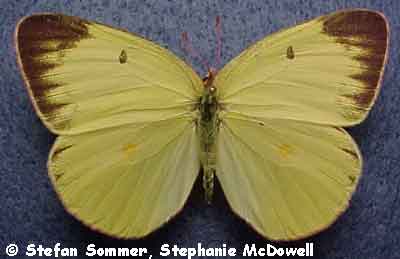
Pink-Edged Sulphur
Family: Pieridae
Family Description:
Description:
Caterpillar: The caterpillar is yellow-green, lightly dotted with black and marked with light or dark stripes along the back and a white and red stripe along the side.
Adult: This butterfly is medium-sized, with a wingspan of 1 ½ to 2 inches. The male butterfly is bright yellow on the upperside and marked with black on the outside edges of the wings. The female is yellow to white on the upperside, with a lighter, incomplete black border on the wing edges. Both sexes have a faint spot on the forewing and an orangish spot on the hindwing. Underneath, the forewing is yellow to white and may have a small spot; the hindwing is yellow to white to gray, with a small white spot outlined in pink. There is a noticeably pink fringe outlining the wings.
Range:
This species ranges from British Columbia, Alberta, and the Pacific Northwest, east across the southern portion of Canada to the coast, through the Great Lakes states and New England. There may be isolated populations in certain eastern states, including Pennsylvania, Maryland, and the Virginias. In Idaho, it can be found in the northern half of the state.
Habitat:
It is found in open areas, including forest openings, clearings, or burned areas, and bogs.
Diet:
Caterpillar: Caterpillars feed on the leaves of blueberry (Vaccinium spp.).
Adult: Butterflies drink flower nectar, often from sarsaparilla (Aralia nudicaulis), orange hawkweed (Hieracium aurantiacum), and various asters (Aster spp.).
Ecology:
There is one generation of caterpillars each summer. The young caterpillars overwinter in a physiological state called diapause, and emerge in spring to feed, molt, and eventually pupate. Adults generally fly from mid-June to late August. The butterflies exhibit a slow flight.
Reproduction:
Males actively patrol in search of receptive females. Females lay eggs on the leaves of host plants.
Conservation:
| Global Rank: |
G5; populations are widespread, abundant, and secure. |
References:
Ferris, C. D. and F. M. Brown. (eds.) 1981. Butterflies of the Rocky Mountain States. Univ. of Oklahoma Press, Norman, Oklahoma, USA, 442 pp.
Opler, P. A., H. Pavulaan, and R. E. Stanford. 1995. Butterflies of North America. Jamestown, North Dakota, USA: Northern Prairie Wildlife Research Center Home Page. http://www.npwrc.usgs.gov/resource/distr/lepid/bflyusa/bflyusa.htm (Version 05Nov98).
Opler, P. A. and A. B.Wright. 1999. A Field Guide to the Western Butterflies. Second Edition. Peterson Field Guide Series. Houghton Mifflin Company, New York, New York, USA, 540 pp.
Pyle, R. M. 1981. National Audubon Society Field Guide to North American Butterflies. Alfred A. Knopf, Inc., New York, New York, USA, 924 pp.
Scott, J. A. 1986. The Butterflies of North America. Stanford University Press, Stanford, California, USA, 583 pp.
Stanford, R. E. and P. A. Opler. 1993. Atlas of Western U.S.A. Butterflies (Including Adjacent Parts of Canada and Mexico). Published by authors, Denver, Colorado, USA, 275 pp.
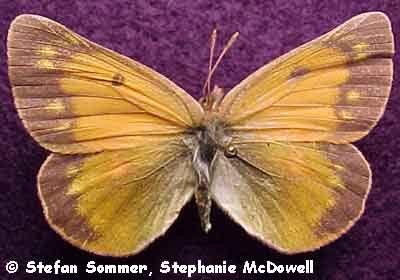
Mead’s Sulphur
Family: Pieridae
Family Description:
Alternate Common Name: Alpine Orange.
Description:
Caterpillar: The thin caterpillar is yellowish green to green, dotted with black, and lined lengthwise with yellow and white stripes. The body has many black bumps (tubercles) and black hairs.
Adult: The butterfly is medium-sized, with a wingspan of 1 ¼ to 2 inches. The male is orange on the upperside, the wings edged with a wide black border. The female may be a lighter orange, and the brown to black border on the wings is interrupted with orange spots. Both sexes may have a small dark spot on the forewing and an orange spot on the hindwing on the upperside. Underneath is gray to green, with a white spot on the hindwing, outlined in red. The wings have a pinkish fringe.
Range:
This species has a narrow range, as it is found only in the Rocky Mountains, from southern Alberta to Colorado. Its presence has been documented in Idaho only in Lemhi County, but it may also occur in the panhandle portion of the state along the Montana border.
Habitat:
Typically it is found at higher elevations in alpine meadows and on rocky slopes, but it may also occur in forests and along streams.
Diet:
Caterpillar: Caterpillars feed on the leaves of members of the pea family (Fabaceae), such as clovers (Trifolium spp.) and milk vetch (Astragalus spp.).
Adult: Butterflies drink flower nectar, often from composite flowers.
Ecology:
There is one generation of caterpillars each summer. The young caterpillars overwinter in a physiological state called diapause, and emerge in the spring to feed, molt, and eventually pupate. Adults genrally fly from July through August. Butterflies fly very quickly and erratically, and upon landing, often make their way down into the vegetation where they are well camouflaged.
Reproduction:
Males actively patrol in search of receptive females. Females lay eggs singly on the leaves of host plants.
Conservation:
| Global Rank: |
G4; population levels are secure, but may be of concern in the future. |
References:
Ferris, C. D. and F. M. Brown. (eds.) 1981. Butterflies of the Rocky Mountain States. Univ. of Oklahoma Press, Norman, Oklahoma, USA, 442 pp.
Opler, P. A., H. Pavulaan, and R. E. Stanford. 1995. Butterflies of North America. Jamestown, North Dakota, USA: Northern Prairie Wildlife Research Center Home Page. http://www.npwrc.usgs.gov/resource/distr/lepid/bflyusa/bflyusa.htm (Version 05Nov98).
Opler, P. A. and A. B.Wright. 1999. A Field Guide to the Western Butterflies. Second Edition. Peterson Field Guide Series. Houghton Mifflin Company, New York, New York, USA, 540 pp.
Pyle, R. M. 1981. National Audubon Society Field Guide to North American Butterflies. Alfred A. Knopf, Inc., New York, New York, USA, 924 pp.
Scott, J. A. 1986. The Butterflies of North America. Stanford University Press, Stanford, California, USA, 583 pp.
Stanford, R. E. and P. A. Opler. 1993. Atlas of Western U.S.A. Butterflies (Including Adjacent Parts of Canada and Mexico). Published by authors, Denver, Colorado, USA, 275 pp.
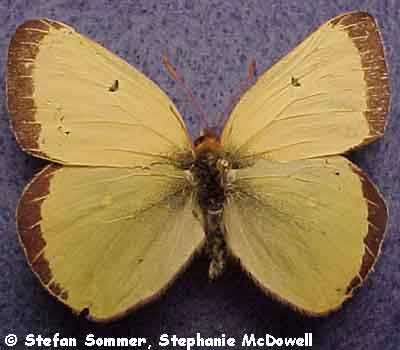
Western Sulphur
Family: Pieridae
Family Description:
Note: This is really a complex of species or subspecies, including astraea, christina, krauthii, pheudochristina, wasatchia, and possibly others.
Description:
Caterpillar: The caterpillar is yellowish green, marked lengthwise on each side with a white line dashed with orange, and dottedwith black.
Adult: The butterfly is medium-sized, with a wingspan of 1 ½ to 2 ½ inches. Its appearance varies, both between and within the sexes: Males: They can be one of two types, or morphs. The first type is bright yellow on the upperside, with a black border on the edges of the wings, a small spot on the forewing and an orange spot on the hindwing; underneath is yellow, darker on the hindwing which also has a ringed spot, and fringed with pink. The second type is orange on the upperside, with yellow on the wings at the edges and near the body; underneath is greenish gray to orange. Females: They can be one of two morphs, as well. The first type is light yellow to white on the upperside, with the dark wing border either interrupted or missing; underneath is yellow, darker on the hindwing which also has a ringed spot, and fringed in pink. The second type is orange on the upperside with black wing borders and dark wing veins; underneath is greenish gray to orange.
Range:
This species ranges from Alaska, south through the western portion of Canada and the northwestern quarter of the U.S., and east to North Dakota. The yellow morphs occur in the northern portion of Idaho, while the orange morphs occur mainly in the central and western portions of the state.
Habitat:
It frequents open areas, including meadows, prairies, sagebrush steppe, and forest openings.
Diet:
Caterpillar: Caterpillars feed on members of the pea family (Fabaceae), such as lupines (Lupinus spp.), vetch (Vicia angustifolia), and white sweet clover (Melilotus alba).
Adult: Butterflies drink flower nectar.
Ecology:
There is one generation of caterpillars each summer. Older caterpillars overwinter in a physiological state called diapause, and emerge in the spring to feed and pupate. Adults generally fly from May to August, with most flying during June and July.
Reproduction:
Males actively patrol in search of receptive females. Females lay eggs singly on the leaves of host plants.
Conservation:
| Global Rank: |
G3; vulnerable to population decline and extinction. |
References:
Opler, P. A., H. Pavulaan, and R. E. Stanford. 1995. Butterflies of North America. Jamestown, North Dakota, USA: Northern Prairie Wildlife Research Center Home Page. http://www.npwrc.usgs.gov/resource/distr/lepid/bflyusa/bflyusa.htm (Version 05Nov98).
Opler, P. A. and A. B.Wright. 1999. A Field Guide to the Western Butterflies. Second Edition. Peterson Field Guide Series. Houghton Mifflin Company, New York, New York, USA, 540 pp.
Pyle, R. M. 1981. National Audubon Society Field Guide to North American Butterflies. Alfred A. Knopf, Inc., New York, New York, USA, 924 pp.
Scott, J. A. 1986. The Butterflies of North America. Stanford University Press, Stanford, California, USA, 583 pp.
Stanford, R. E. and P. A. Opler. 1993. Atlas of Western U.S.A. Butterflies (Including Adjacent Parts of Canada and Mexico). Published by authors, Denver, Colorado, USA, 275 pp.
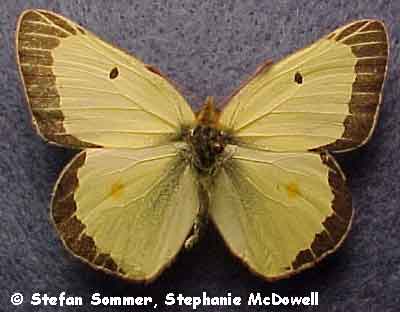
Pelidne Sulphur
Family: Pieridae
Family Description:
Alternate Common Name: Blueberry Sulphur.
Description:
Caterpillar: A detailed scientific description of the caterpillar has not been published.
Adult: This is a small to medium-sized butterfly, with a wingspan of 1 ź to 1 ž inches. The male is pale yellow on the upperside, with a black border edging the wings, a small dark spot on the forewing and possibly a faint orange spot on the hindwing. Females can be white or yellow on the upperside, with a faint or interrupted black wing border and similar spots. Underneath, both sexes are yellow to white, with a spot on the hindwing and possibly on the forewing, and black shading which makes the wings appear to be dusted with soot. The wings have a pinkish fringe.
Range:
This species occurs in eastern Alaska, in the Rockies from southern Alberta to Wyoming, and in the far northeastern portion of Canada. It occurs throughout much of Idaho.
Habitat:
It generally occurs in high elevation habitats such as tundra or subalpine meadows and forest openings.
Diet:
Caterpillar: Caterpillars feed on species of blueberry (Vaccinium spp.) and on wintergreen (Gaultheria humifusa).
Adult: Butterflies drink flower nectar.
Ecology:
There is one generation of caterpillars each summer. Adults generally fly from the end of June to September. Little about the life cycle of this species is known or reported in the scientific literature.
Reproduction:
Males actively patrol for receptive females. The sites chosen by females for laying eggs has not been observed or reported.
Conservation:
| Global Rank: |
G5; populations are widespread, abundant, and secure. |
References:
Ferris, C. D. and F. M. Brown. (eds.) 1981. Butterflies of the Rocky Mountain States. Univ. of Oklahoma Press, Norman, Oklahoma, USA, 442 pp.
Opler, P. A., H. Pavulaan, and R. E. Stanford. 1995. Butterflies of North America. Jamestown, North Dakota, USA: Northern Prairie Wildlife Research Center Home Page. http://www.npwrc.usgs.gov/resource/distr/lepid/bflyusa/bflyusa.htm (Version 05Nov98).
Opler, P. A. and A. B.Wright. 1999. A Field Guide to the Western Butterflies. Second Edition. Peterson Field Guide Series. Houghton Mifflin Company, New York, New York, USA, 540 pp.
Pyle, R. M. 1981. National Audubon Society Field Guide to North American Butterflies. Alfred A. Knopf, Inc., New York, New York, USA, 924 pp.
Scott, J. A. 1986. The Butterflies of North America. Stanford University Press, Stanford, California, USA, 583 pp.
Stanford, R. E. and P. A. Opler. 1993. Atlas of Western U.S.A. Butterflies (Including Adjacent Parts of Canada and Mexico). Published by authors, Denver, Colorado, USA, 275 pp.
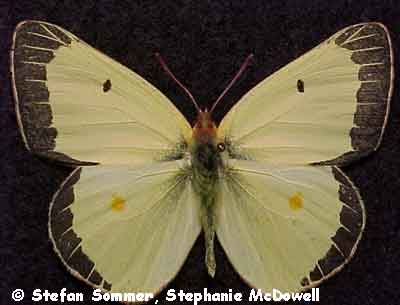
Clouded Sulphur
Family: Pieridae
Family Description:
Alternate Common Name: Common Sulphur.
Description:
Caterpillar: The caterpillar is typically bright green, but may be yellowish or even bluish green. It is striped lengthwise with darker green along the back, and white and pink along the sides.
Adult: This is a medium-sized to large butterfly, with a wingspan of 1 3/8 to 2 3/4 inches. Its appearance varies seasonally and between the sexes. The male is bright yellow on the upperside, possibly with a dark spot on the forewing and an orange spot on the hindwing; the wing edges are bordered by solid black. The female can be either greenish white or yellow on the upperside, with similar markings and a fainter border interrupted with yellow spots. Underneath, both sexes are marked with a row of blurred spots near the outside edge of the wings, a forewing spot, and a white hindwing spot outlined in pink. Early and late season adults may be paler and smaller.
Range:
This is a widespread species, which ranges from Alaska south and east across the southern half of Canada, and through most of the continental U.S. except for parts of California and Florida. It occurs throughout all of Idaho.
Habitat:
It can be found in many varieties of open areas, including meadows, fields, and pastures.
Diet:
Caterpillar: Caterpillars eat the leaves of members of the pea family (Fabaceae), such as clovers (Trifolium spp.) and alfalfa (Medicago sativa).
Adult: Butterflies drink flower nectar.
Ecology:
There are generally three generations of caterpillars in the northern part of its range, and up to five in the south. The last brood of caterpillars of the season overwinters in a physiological state called diapause. Adults generally fly from May to October.
Reproduction:
Males actively patrol for receptive females. Females lay eggs singly on the leaves of host plants.
Conservation:
| Global Rank: |
G5; populations are widespread, abundant, and secure. |
References:
Ferris, C. D. and F. M. Brown. (eds.) 1981. Butterflies of the Rocky Mountain States. Univ. of Oklahoma Press, Norman, Oklahoma, USA, 442 pp.
Opler, P. A., H. Pavulaan, and R. E. Stanford. 1995. Butterflies of North America. Jamestown, North Dakota, USA: Northern Prairie Wildlife Research Center Home Page. http://www.npwrc.usgs.gov/resource/distr/lepid/bflyusa/bflyusa.htm (Version 05Nov98).
Opler, P. A. and A. B.Wright. 1999. A Field Guide to the Western Butterflies. Second Edition. Peterson Field Guide Series. Houghton Mifflin Company, New York, New York, USA, 540 pp.
Pyle, R. M. 1981. National Audubon Society Field Guide to North American Butterflies. Alfred A. Knopf, Inc., New York, New York, USA, 924 pp.
Scott, J. A. 1986. The Butterflies of North America. Stanford University Press, Stanford, California, USA, 583 pp.
Stanford, R. E. and P. A. Opler. 1993. Atlas of Western U.S.A. Butterflies (Including Adjacent Parts of Canada and Mexico). Published by authors, Denver, Colorado, USA, 275 pp.
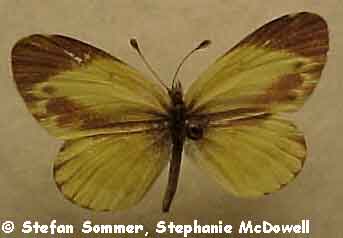
Dainty Sulphur
Family: Pieridae
Family Description:
Alternate Common Name: Dwarf Yellow.
Description:
Caterpillar: The caterpillar is small, reaching a maximum length of 5/8 inch. It can vary in color, but generally is light to dark green and striped lengthwise along the back with a purplish or brownish stripe. The sides may be marked with dark brown and/or yellow. The body is covered with short hair. Alternatively, the caterpillar may be solid green with a yellowish head.
Adult: The butterfly is small, with a wingspan of 3/4 to 1 1/4 inches, and varies in its appearance. Generally the upperside is yellow to orangish yellow and heavily marked with brownish black on the tip of the forewing and along the edge where it meets the hindwing. Females have more black than males, and their wings may be edged with black as well. Underneath, the forewing is yellowish orange towards the body and faded black towards the tip; there may be several black spots near the outside edge. The underside of the hindwing is yellowish in summer individuals and greenish brown in winter individuals.
Range:
This species is a yearlong resident of the extreme southern U.S., from southernmost California to Florida, and Mexico. In the spring and summer, adults migrate north throughout most of the U.S. into Canada, primarily in the Great Plains. In Idaho, it has been documented to occur in three counties: Ada, Canyon, and Franklin.
Habitat:
It occurs in open, often drier areas, such as fields, grasslands, and disturbed areas, and along corridors such as rivers, railroads, and roadsides.
Diet:
Caterpillar: Caterpillars feed on flowers belonging to the sunflower family (Asteraceae) including sneezeweed (Helenium spp.), bur marigold (Bidens pilosa), cultivated marigold (Tagetes spp.), and fetid marigold (Dyssodia spp.).
Adult: Butterflies drink flower nectar.
Ecology:
There are continuous generations of caterpillars where the species occurs year-round. Scientists have not yet confirmed whether the northward migration is either accomplished by individual adults or by successive generations of adults. No stage is believed to be capable of enduring winter frosts; individuals occurring in the north when summer ends die.
Reproduction:
Males patrol near the ground in search of receptive females. Females lay eggs singly on the leaves of young host plants.
Conservation:
| Global Rank: |
G5; populations are widespread, abundant, and secure. |
References:
Ferris, C. D. and F. M. Brown. (eds.) 1981. Butterflies of the Rocky Mountain States. Univ. of Oklahoma Press, Norman, Oklahoma, USA, 442 pp.
Opler, P. A., H. Pavulaan, and R. E. Stanford. 1995. Butterflies of North America. Jamestown, North Dakota, USA: Northern Prairie Wildlife Research Center Home Page. http://www.npwrc.usgs.gov/resource/distr/lepid/bflyusa/bflyusa.htm (Version 05Nov98).
Opler, P. A. and A. B.Wright. 1999. A Field Guide to the Western Butterflies. Second Edition. Peterson Field Guide Series. Houghton Mifflin Company, New York, New York, USA, 540 pp.
Pyle, R. M. 1981. National Audubon Society Field Guide to North American Butterflies. Alfred A. Knopf, Inc., New York, New York, USA, 924 pp.
Scott, J. A. 1986. The Butterflies of North America. Stanford University Press, Stanford, California, USA, 583 pp.
Stanford, R. E. and P. A. Opler. 1993. Atlas of Western U.S.A. Butterflies (Including Adjacent Parts of Canada and Mexico). Published by authors, Denver, Colorado, USA, 275 pp.
Arctic Blue
Family: Lycaenidae
Family Description:
Alternate Common Names:High Mountain Blue, Glandon Blue, Primrose Blue.
Note: This species is a complex made up of several species or subspecies, including A. aquilo, A. franklinii, A. rusticus, and A. podarce. This species is referred to with the genus name Plebejus by some authors.
Description:
Caterpillar: The caterpillar is green with red markings.
Adult: This is a small butterfly, with a wingspan of approximately one inch. Its appearance varies considerably depending on its location. The upperside of males is typically grayish to greenish blue, and appears iridescent. The forewing is bordered with black along the side, and there is a single black spot near the center. The hindwing may have a row of small black dots along the edge. Females are orangish brown on the upperside, possibly with patches of pale blue, and are marked similarly to males. Underneath, both sexes are grayish brown. The underside of the forewing is marked with white spots, possibly with tiny black centers; the hindwing may be spotted with white, black or both.
Range:
Generally, this species is found throughout the temperate regions of the Northern Hemisphere. Specifically, it occurs commonly in the northwestern quarter of North America and patchily in the northeastern quarter. It also may be found in the mountainous regions of the southwestern U.S. In Idaho, it has been documented in the southeastern and central portions of the state.
Habitat:
Arctic Blues occur in harsher environments, such as tundra, alpine and subalpine forests and meadows, and bogs.
Diet:
Caterpillar: While records are sparse, it is thought that host plants include diapensia (Diapensia lapponica), shooting star (Dodecatheon spp.), rock-jasmine (Androsace septentionalis), and blueberry (Vaccinium spp.).
Adult: Butterflies use flower nectar for food.
Ecology:
Either caterpillars or pupae can overwinter in a physiological state called diapause. There is one generation each year. Adults generally fly from early May through late September.
Reproduction:
Males actively patrol for receptive females near host plants. Females lay eggs singly on the bracts or sepals of host plants, or on the underside of leaves.
Conservation:
| Global Rank: | G5 populations are widespread, abundant, and secure. |
References:
Ferris, C. D. and F. M. Brown. (eds.) 1981. Butterflies of the Rocky Mountain States. Univ. of Oklahoma Press, Norman, Oklahoma, USA, 442 pp.
Opler, P. A., H. Pavulaan, and R. E. Stanford. 1995. Butterflies of North America. Jamestown, North Dakota, USA: Northern Prairie Wildlife Research Center Home Page. http://www.npwrc.usgs.gov/resource/distr/lepid/bflyusa/bflyusa.htm (Version 05Nov98).
Opler, P. A. and A. B.Wright. 1999. A Field Guide to the Western Butterflies. Second Edition. Peterson Field Guide Series. Houghton Mifflin Company, New York, New York, USA, 540 pp.
Pyle, R. M. 1981. National Audubon Society Field Guide to North American Butterflies. Alfred A. Knopf, Inc., New York, New York, USA, 924 pp.
Scott, J. A. 1986. The Butterflies of North America. Stanford University Press, Stanford, California, USA, 583 pp.
Stanford, R. E. and P. A. Opler. 1993. Atlas of Western U.S.A. Butterflies (Including Adjacent Parts of Canada and Mexico). Published by authors, Denver, Colorado, USA, 275 pp.

Western Pygmy-Blue
Family: Lycaenidae
Family Description:
Alternate Common Name: Pygmy Blue.
Note: This species is referred to as Brephidium exilis by some authors.
Description:
Caterpillar: The coloring of the caterpillar can vary, but generally it is yellowish green to tan and shaded or striped with yellow on the back and sides. Alternatively, it may be green, shaded or striped with dark green or dark pink, or it may be green with a dark colored head and lacking stripes altogether. Often it is covered with brownish or whitish bumps. Its average, full-grown length is 7/16 inch.
Adult: This is the world’s smallest butterfly, with a wingspan of 2/5 to 3/4 inch. The upperside is an orangey-brown, with blue shading on the bases of the wings. Underneath, the wings are grayish white towards the base. The forewing is shaded with orange on the outermost half; the hindwing is marked with brown patches in the middle and is edged with a row of dark blue spots lined in metallic gold.
Range:
This species ranges from southeastern Oregon and southern Idaho south to South America, and east through the southwestern quarter of the U.S. to Nebraska, Arkansas, and Missouri.
Habitat:
It is typically found in lowland areas, often those that have been recently disturbed or are alkaline, such as salt marshes, deserts, or prairies.
Diet:
Caterpillar: Caterpillars eat the leaves, flowers, and fruits of members of the goosefoot family (Chenopodiaceae), including pigweed (Chenopodium spp.), saltbush (Atriplex spp.), and pickleweed (Salicornia spp.).
Adult: Butterflies use flower nectar for food.
Ecology:
The caterpillar is equipped with a honey gland, also known as a dorsal nectary organ, which emits a sugary solution agreeable to ants. The ants feed on the solution and in turn protect the caterpillar from predators. Also for protection, the caterpillar bears a pair of everscible tubercles or tentacles on the eighth segment. These tubercles are usually housed within the body, but when the caterpillar feels threatened by the approach of a potential predator, they can be pushed out to release a chemical which mimics an ant alarm pheromone. This scent causes the ants to become frenzied and aggressive, and the potential predator takes leave or is eaten by the ants. Each caterpillar undergoes four stages of growth, or instars. There are multiple generations of caterpillars each year in most of its range. The pupal stage can overwinter in a physiological state called diapause. Adults are yearlong residents in the southern part of its range and migrate each year into the north where they generally fly from June through November. This is the smallest butterfly in the world.
Reproduction:
Males actively patrol for receptive females. Females lay eggs singly on all parts of the host plant with most placed on the topsides of leaves and near flowering stems.
Conservation:
| Global Rank: | G5 populations are widespread, abundant, and secure. |
References:
Ballmer, G. R. and G. F. Pratt. 1988. A survey of the last instar larvae of the Lycaenidae of California. Journal of Research on the Lepidoptera 27:1-81.
Ferris, C. D. and F. M. Brown. (eds.) 1981. Butterflies of the Rocky Mountain States. Univ. of Oklahoma Press, Norman, Oklahoma, USA, 442 pp.
Opler, P. A., H. Pavulaan, and R. E. Stanford. 1995. Butterflies of North America. Jamestown, North Dakota, USA: Northern Prairie Wildlife Research Center Home Page. http://www.npwrc.usgs.gov/resource/distr/lepid/bflyusa/bflyusa.htm (Version 05Nov98).
Opler, P. A. and A. B.Wright. 1999. A Field Guide to the Western Butterflies. Second Edition. Peterson Field Guide Series. Houghton Mifflin Company, New York, New York, USA, 540 pp.
Pyle, R. M. 1981. National Audubon Society Field Guide to North American Butterflies. Alfred A. Knopf, Inc., New York, New York, USA, 924 pp.
Scott, J. A. 1986. The Butterflies of North America. Stanford University Press, Stanford, California, USA, 583 pp.
Stanford, R. E. and P. A. Opler. 1993. Atlas of Western U.S.A. Butterflies (Including Adjacent Parts of Canada and Mexico). Published by authors, Denver, Colorado, USA, 275 pp.
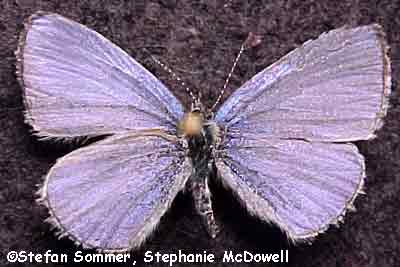
Spring Azure
Family: Lycaenidae
Family Description:
Note: This is really a complex comprised of several species or subspecies, including C. echo, C. lucia, and possibly others. Some authors refer to this species as Celastrina argiolus.
Description:
Caterpillar: The caterpillars vary a great deal in color, and can be green, yellow, pink, or brown. The back may be striped lengthwise with green or brown and spotted with white. The average, full-grown length is 1/2 inch.
Adult: This is a small butterfly, with a wingspan of 3/4 to 1 3/8 inches. Its appearance varies seasonally and between the sexes. Spring: Typically in spring, the upperside is a silvery violet blue, with black shading on the outer edge of the forewings of females. Underneath is grayish, with a black-and-white checkerboard border and possibly with black spots. It may have a blotchy appearance. Late spring/early summer: Upperside is similar to spring’s but marked with white; females’ wings are edged in black. Underneath is gray to white and may be marked faintly.
Range:
A widespread species, it can be found in Alaska, throughout Canada and the U.S., and south through Mexico and the mountains of Central America. It occurs throughout much of Idaho.
Habitat:
It occupies a variety of habitat types, including fields, roadsides, meadows, marshes, swamps, in or near woodlands, and sagebrush steppe.
Diet:
Caterpillar: Caterpillars feed on the flowers and fruits of a variety of plant species, including dogwoods (Cornus spp.), buck brush (Ceanothus spp.), meadowsweet (Spirea spp.), and viburnum (Viburnum spp.).
Adult: Butterflies use flower nectar food. They can often be seen puddling at mud or dung.
Ecology:
The caterpillar is equipped with a honey gland, also known as a dorsal nectary organ, which emits a sugary solution agreeable to ants. The ants feed on the solution and in turn protect the caterpillar from predators. Also for protection, the caterpillar bears a pair of everscible tubercles or tentacles on the eighth segment. These tubercles are usually housed within the body, but when the caterpillar feels threatened by the approach of a potential predator, they can be pushed out to release a chemical which mimics an ant alarm pheromone. This scent causes the ants to become frenzied and aggressive, and the potential predator takes leave or is eaten by the ants. Each caterpillar undergoes four stages of growth, or instars. There can be several generations of caterpillars each growing season, with the last generation pupating before overwintering in a physiological state called diapause. Adults generally fly from March to early July. The spring butterflies are one of the first species to emerge after winter.
Reproduction:
Males actively patrol in search of receptive females, and may occasionally perch. Females lay eggs singly on the flower buds of host plants.
Conservation:
| Global Rank: | Unranked; some species/subspecies have low population levels that are of concern. |
References:
Ballmer, G. R. and G. F. Pratt. 1988. A survey of the last instar larvae of the Lycaenidae of California. Journal of Research on the Lepidoptera 27:1-81.
Ferris, C. D. and F. M. Brown. (eds.) 1981. Butterflies of the Rocky Mountain States. Univ. of Oklahoma Press, Norman, Oklahoma, USA, 442 pp.
Opler, P. A., H. Pavulaan, and R. E. Stanford. 1995. Butterflies of North America. Jamestown, North Dakota, USA: Northern Prairie Wildlife Research Center Home Page. http://www.npwrc.usgs.gov/resource/distr/lepid/bflyusa/bflyusa.htm (Version 05Nov98).
Opler, P. A. and A. B.Wright. 1999. A Field Guide to the Western Butterflies. Second Edition. Peterson Field Guide Series. Houghton Mifflin Company, New York, New York, USA, 540 pp.
Pyle, R. M. 1981. National Audubon Society Field Guide to North American Butterflies. Alfred A. Knopf, Inc., New York, New York, USA, 924 pp.
Scott, J. A. 1986. The Butterflies of North America. Stanford University Press, Stanford, California, USA, 583 pp.
Stanford, R. E. and P. A. Opler. 1993. Atlas of Western U.S.A. Butterflies (Including Adjacent Parts of Canada and Mexico). Published by authors, Denver, Colorado, USA, 275 pp.
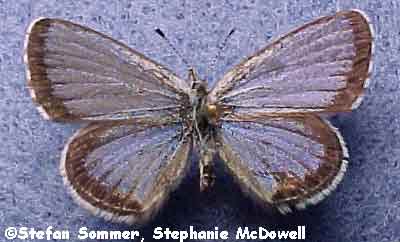
Square-Spotted Blue
Family: Lycaenidae
Family Description:
Alternate Common Name: Buckwheat Blue.
Note: There are many subspecies of E. battoides, the distinctions being based primarily on differences in the species of host plants. Each subspecies utilizes a specific variety of buckwheat (Eriogonum spp.).
Description:
Caterpillar: The appearance of the caterpillar varies, and it usually matches the flowers of the host plant. Caterpillars can be bluish green, green, yellow, brownish, or pink. They may be marked with brown spots or stripes. The average length is ― inch.
Adult: The appearance of the butterfly varies widely as well. It is a small butterfly, with a wingspan of ū to 1 ž inches. Typically, males are blue on the upperside, edged in black, and possibly with a row of orange spots or an orange patch just inside the edge of the hindwing. Females are brown to blue on the upperside and marked similarly. Underneath, both sexes are white to gray and marked with either square or round black spots of different sizes. The underside of the hindwing is marked with orange just in from the edge.
Range:
It ranges from southern British Columbia south to Mexico, and east to western Montana and central Colorado and New Mexico. In Idaho, it occurs primarily in the central and southwestern portions of the state.
Habitat:
A species of drier habitats, it can be found in deserts, chaparral, open woodlands, and dunes.
Diet:
Caterpillar: Caterpillars feed on the flowers and fruits of various species of wild buckwheat (Eriogonum spp.).
Adult: Butterflies drink nectar, most often from host plant flowers.
Ecology:
The caterpillar is equipped with a honey gland, also known as a dorsal nectary organ, which emits a sugary solution agreeable to ants. The ants feed on the solution and in turn protect the caterpillar from predators. Also for protection, the caterpillar bears a pair of everscible tubercles or tentacles on the eighth segment. These tubercles are usually housed within the body, but when the caterpillar feels threatened by the approach of a potential predator, they can be pushed out to release a chemical which mimics an ant alarm pheromone. This scent causes the ants to become frenzied and aggressive, and the potential predator takes leave or is eaten by the ants. There is one generation of caterpillars each growing season. Each caterpillar undergoes four stages of growth, called instars. Pupae overwinter in a physiological state called diapause; chrysalises are often in the soil or leaf litter below host plants. Adults generally fly from mid-April to August, primarily when the host plants in the area are in bloom.
Reproduction:
Males actively patrol in search of receptive females. Females lay eggs singly on the flowers of host plants.
Conservation:
| Global Rank: | Varies with subspecies. Several subspecies are listed as T1, which means each is critically imperiled because of extreme rarity and is imminently vulnerable to extinction. This includes the El Segundo Blue (Euphilotes battoides allyni) of California, which is listed as an Endangered Species. |
References:
Ballmer, G. R. and G. F. Pratt. 1988. A survey of the last instar larvae of the Lycaenidae of California. Journal of Research on the Lepidoptera 27:1-81.
Ferris, C. D. and F. M. Brown. (eds.) 1981. Butterflies of the Rocky Mountain States. Univ. of Oklahoma Press, Norman, Oklahoma, USA, 442 pp.
Opler, P. A., H. Pavulaan, and R. E. Stanford. 1995. Butterflies of North America. Jamestown, North Dakota, USA: Northern Prairie Wildlife Research Center Home Page. http://www.npwrc.usgs.gov/resource/distr/lepid/bflyusa/bflyusa.htm (Version 05Nov98).
Opler, P. A. and A. B.Wright. 1999. A Field Guide to the Western Butterflies. Second Edition. Peterson Field Guide Series. Houghton Mifflin Company, New York, New York, USA, 540 pp.
Pyle, R. M. 1981. National Audubon Society Field Guide to North American Butterflies. Alfred A. Knopf, Inc., New York, New York, USA, 924 pp.
Scott, J. A. 1986. The Butterflies of North America. Stanford University Press, Stanford, California, USA, 583 pp.
Stanford, R. E. and P. A. Opler. 1993. Atlas of Western U.S.A. Butterflies (Including Adjacent Parts of Canada and Mexico). Published by authors, Denver, Colorado, USA, 275 pp.
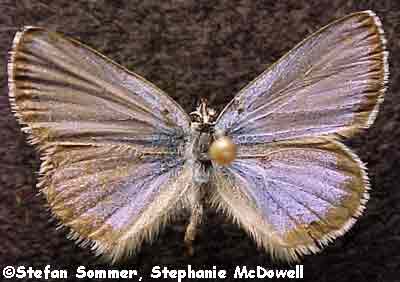
Dotted Blue
Family: Lycaenidae
Family Description:
Description:
Caterpillar: The appearance of the caterpillar varies. It can be offwhite to yellow to pinkish in color, and may be marked with pink to brown stripes, dashes, or other marks. The body may be hairy. Its average, full-grown length is approximately 1/2 inch.
Adult: This is a small butterfly, with a wingspan of 3/4 to 1 1/8 inches, and its appearance varies. Males are generally bright blue on the upperside, with the wings edged with black. The black edging may be spotty on the hindwing, and there may be an orange band in from the edge. Females are brown on the upperside and have an orange band near the edge on the hindwing. Both sexes are gray to white underneath and marked with black spots. The fore- and hindwing may each have black spots in rows along the edge; the hindwing often has an additional row of orange spots. The fringe on the wings is checked with black and white.
Range:
This species is found in patches of the western U.S., from Washington east to Montana, and south to California and northern Arizona and New Mexico. In Idaho, it occurs primarily along the eastern and southern borders.
Habitat:
It tends to occur in drier areas, often in sagebrush steppe, chaparral, open woodlands, and desert.
Diet:
Caterpillar: Caterpillars feed on the flowers and fruits of various species of wild buckwheat (Eriogonum spp.).
Adult: Butterflies drink flower nectar, often from host plants.
Ecology:
The caterpillar is equipped with a honey gland, also known as a dorsal nectary organ, which emits a sugary solution agreeable to ants. The ants feed on the solution and in turn protect the caterpillar from predators. Also for protection, the caterpillar bears a pair of everscible tubercles or tentacles on the eighth segment. These tubercles are usually housed within the body, but when the caterpillar feels threatened by the approach of a potential predator, they can be pushed out to release a chemical which mimics an ant alarm pheromone. This scent causes the ants to become frenzied and aggressive, and the potential predator takes leave or is eaten by the ants. There is one generation of caterpillars each summer. Each caterpillar undergoes four stages of growth, called instars. Pupae overwinter in a physiological state called diapause. Adults generally fly from mid-May to October. Butterflies do not fly far from where they emerge during their lifespan and the entire lifecycle of this species is spent in close proximity to wild buckwheat. The subspecies E. enoptes smithi, Smith’s Blue, was one of the first insects to be listed as Endangered by the U.S. Fish and Wildlife Service. A resident of the coastal dunes of California, it has been severely impacted by loss of habitat.
Reproduction:
Males actively patrol near host plants in search of receptive females. Females lay eggs singly on the flowers or flower buds of host plants.
Conservation:
| Global Rank: | Varies with subspecies. Subspecies smithi of California is ranked as T2, imperiled and endangered because of rarity and/or because of other factors making it very vulnerable to extinction. |
References:
Arnold, R.A. 1983. Conservation and management of the endangered Smith’s Blue butterfly, Euphilotes enoptes smithi (Lepidoptera: Lycaenidae). Journal of Research on the Lepidoptera 22:135-153.
Ballmer, G. R. and G. F. Pratt. 1988. A survey of the last instar larvae of the Lycaenidae of California. Journal of Research on the Lepidoptera 27:1-81.
Ferris, C. D. and F. M. Brown. (eds.) 1981. Butterflies of the Rocky Mountain States. Univ. of Oklahoma Press, Norman, Oklahoma, USA, 442 pp.
Opler, P. A., H. Pavulaan, and R. E. Stanford. 1995. Butterflies of North America. Jamestown, North Dakota, USA: Northern Prairie Wildlife Research Center Home Page. http://www.npwrc.usgs.gov/resource/distr/lepid/bflyusa/bflyusa.htm (Version 05Nov98).
Opler, P. A. and A. B.Wright. 1999. A Field Guide to the Western Butterflies. Second Edition. Peterson Field Guide Series. Houghton Mifflin Company, New York, New York, USA, 540 pp.
Pyle, R. M. 1981. National Audubon Society Field Guide to North American Butterflies. Alfred A. Knopf, Inc., New York, New York, USA, 924 pp.
Scott, J. A. 1986. The Butterflies of North America. Stanford University Press, Stanford, California, USA, 583 pp.
Stanford, R. E. and P. A. Opler. 1993. Atlas of Western U.S.A. Butterflies (Including Adjacent Parts of Canada and Mexico). Published by authors, Denver, Colorado, USA, 275 pp.
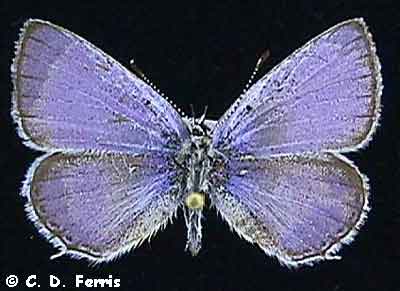
Western Tailed-Blue
Family: Lycaenidae
Family Description:
Description:
Caterpillar: The caterpillar can vary in its color, from brownish yellow to green, and is covered with fine white hair. It is marked with a red or green stripe running lengthwise along the back, and pinkish or reddish purple diagonal dashes on the side. It reaches an average length of 1/2 inch.
Adult: This is a small butterfly, with a wingspan of 7/8 to 1 1/8 inches, which bears a thin tail extending from the rear of the hindwing. The male butterfly is purplish blue on the upperside and outlined in black. The female is brownish on the upperside, outlined in black, and may have bluish shading at the bases of the wings. Underneath, both sexes are white and may be marked with black dots and a faint row of grayish dots along the outer edge of the wings. There may be a small orange spot on the outer edge of the hindwing from where the tail extends.
Range:
This species has a fairly extensive range, from Alaska south to southern California and the southwestern U.S., east across Canada to Ontario and across the northern U.S. to northern Wisconsin and Michigan’s Upper Peninsula. It occurs through much of Idaho.
Habitat:
It can be found in open areas, including meadows, open woodlands, forest edges, and chaparral.
Diet:
Caterpillar: Caterpillars feed on the flowers and fruits of legumes, such as milk vetches (Astragalus spp.), other vetches (Vicia spp.), and peas (Lathyrus spp.).
Adult: Butterflies drink flower nectar.
Ecology:
The caterpillar is equipped with a honey gland, also known as a dorsal nectary organ, which emits a sugary solution agreeable to ants. The ants feed on the solution and in turn protect the caterpillar from predators. Also for protection, the caterpillar bears a pair of everscible tubercles or tentacles on the eighth segment. These tubercles are usually housed within the body, but when the caterpillar feels threatened by the approach of a potential predator, they can be pushed out to release a chemical which mimics an ant alarm pheromone. This scent causes the ants to become frenzied and aggressive, and the potential predator takes leave or is eaten by the ants. There is one generation of caterpillars each growing season through much of the range, but there may be several in the west and in southern California. Each caterpillar undergoes four stages of growth, or instars. Caterpillars overwinter in a physiological state called diapause, often in the seedpods of the host. The entrance hole to the pod is sealed with silk. Pupation may occur within the pod as well. Adults in most of its range generally fly from May through June, but adults may be seen as late as October in the southernmost parts of its range.
Reproduction:
Males both perch and actively patrol for receptive females. Females lay eggs singly on host plant flowers, seedpods, and stems.
Conservation:
| Global Rank: | G5; populations are widespread, abundant, and secure. |
References:
Ballmer, G. R. and G. F. Pratt. 1988. A survey of the last instar larvae of the Lycaenidae of California. Journal of Research on the Lepidoptera 27:1-81.
Ferris, C. D. and F. M. Brown. (eds.) 1981. Butterflies of the Rocky Mountain States. Univ. of Oklahoma Press, Norman, Oklahoma, USA, 442 pp.
Opler, P. A., H. Pavulaan, and R. E. Stanford. 1995. Butterflies of North America. Jamestown, North Dakota, USA: Northern Prairie Wildlife Research Center Home Page. http://www.npwrc.usgs.gov/resource/distr/lepid/bflyusa/bflyusa.htm (Version 05Nov98).
Opler, P. A. and A. B.Wright. 1999. A Field Guide to the Western Butterflies. Second Edition. Peterson Field Guide Series. Houghton Mifflin Company, New York, New York, USA, 540 pp.
Pyle, R. M. 1981. National Audubon Society Field Guide to North American Butterflies. Alfred A. Knopf, Inc., New York, New York, USA, 924 pp.
Scott, J. A. 1986. The Butterflies of North America. Stanford University Press, Stanford, California, USA, 583 pp.
Stanford, R. E. and P. A. Opler. 1993. Atlas of Western U.S.A. Butterflies (Including Adjacent Parts of Canada and Mexico). Published by authors, Denver, Colorado, USA, 275 pp.
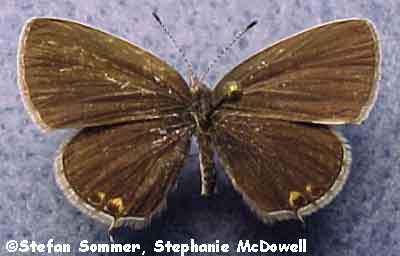
Eastern Tailed-Blue
Family: Lycaenidae
Family Description:
Alternate Common Name: Tailed Blue.
Description:
Caterpillar: Caterpillars are variable in color, often green to brown with a row of dots or a stripe on the sides, and hairy. The average, full-grown length of the caterpillar is 1/2 inch.
Adult: This is a small butterfly, with a wingspan of 3/4 to 1 1/8 inches. The male is silvery blue on the upperside with a black line edging the wings. It is gray to white underneath with a curved band of small black dots and two to three large orange spots at the bottom of the hindwing. The female is blue in spring and more brownish on the upperside in summer, with similar markings as the male. Both sexes have a white fringe and a thin tail off the hindwing.
Range:
This species is found east of the Rockies, from southern Canada to Central America. It may also occur in patches in the intermountain west and southwestern U.S. Eastern-tailed blues occur in isolated sections of northern and west central Idaho.
Habitat:
Adults occur in open areas, particularly those recently disturbed.
Diet:
Caterpillar: Caterpillars feed on the buds, flowers, seeds, and sometimes leaves of legumes, including species of clover (Trifolium spp.), alfalfa (Medicago spp.), pea (Lathyrus spp.), vetch (Vicia spp.), and bean (Phaseolus spp.).
Adult: Butterflies obtain nectar from relatively short plants with open, shallow flowers, such as wild strawberry (Fragaria spp.) and white sweet clover (Melilotus alba).
Ecology:
The caterpillar is equipped with a honey gland, also known as a dorsal nectary organ, which emits a sugary solution agreeable to ants. The ants feed on the solution and in turn protect the caterpillar from predators. Also for protection, the caterpillar bears a pair of everscible tubercles or tentacles on the eighth segment. These tubercles are usually housed within the body, but when the caterpillar feels threatened by the approach of a potential predator, they can be pushed out to release a chemical which mimics an ant alarm pheromone. This scent causes the ants to become frenzied and aggressive, and the potential predator takes leave or is eaten by the ants. Caterpillars overwinter within the pods of host plants in a physiological state called diapause, and pupate in the spring. Each year, there are three generations in the northern part of its range and many generations in the south; in the case of multiple generations during a given summer, only the caterpillars of the last generation overwinter. Each caterpillar undergoes four stages of growth, called instars. Adults generally fly from March to December. This is one of the few members of the family Lycaenidae that can be found resting with its wings open.
Reproduction:
Males patrol near host plants for receptive females. Females lay eggs on flower buds and stems.
Conservation:
| Global Rank: | G5; populations are widespread, abundant, and secure. |
References:
Ballmer, G. R. and G. F. Pratt. 1988. A survey of the last instar larvae of the Lycaenidae of California. Journal of Research on the Lepidoptera 27:1-81.
Ferris, C. D. and F. M. Brown. (eds.) 1981. Butterflies of the Rocky Mountain States. Univ. of Oklahoma Press, Norman, Oklahoma, USA, 442 pp.
Opler, P. A., H. Pavulaan, and R. E. Stanford. 1995. Butterflies of North America. Jamestown, North Dakota, USA: Northern Prairie Wildlife Research Center Home Page. http://www.npwrc.usgs.gov/resource/distr/lepid/bflyusa/bflyusa.htm (Version 05Nov98).
Opler, P. A. and A. B.Wright. 1999. A Field Guide to the Western Butterflies. Second Edition. Peterson Field Guide Series. Houghton Mifflin Company, New York, New York, USA, 540 pp.
Pyle, R. M. 1981. National Audubon Society Field Guide to North American Butterflies. Alfred A. Knopf, Inc., New York, New York, USA, 924 pp.
Scott, J. A. 1986. The Butterflies of North America. Stanford University Press, Stanford, California, USA, 583 pp.
Stanford, R. E. and P. A. Opler. 1993. Atlas of Western U.S.A. Butterflies (Including Adjacent Parts of Canada and Mexico). Published by authors, Denver, Colorado, USA, 275 pp.
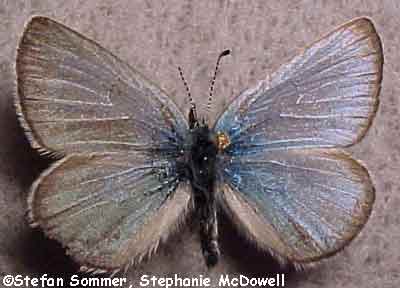
Silvery Blue
Family: Lycaenidae
Family Description:
Note: This species consists of approximately ten races or subspecies, all of which vary slightly in appearance.
Description:
Caterpillar: The caterpillar varies in color, ranging from gray to green to brown, and is covered with white hair. It may be marked with a dark green or red stripe running lengthwise along the back and light diagonal dashes on the side. Its average, full-grown length is 3/4 inch.
Adult: This is a fairly small butterfly, with a wingspan of 7/8 to 1 1/4 inches. The male is silvery blue on the upperside, with the wings edged in black. The female is blue to brown on the upperside, and the wings are edged with a thicker black border. Both the male and the female may have a purplish cast. Underneath, both sexes are gray to brown and marked with an uneven row of white-edged black dots.
Range:
This widespread species ranges from Alaska through most of Canada to Nova Scotia; through the western third of the U.S.; through the northern U.S. and a portion of the southeastern U.S. It occurs through most of Idaho.
Habitat:
It can be found in a variety of habitats, including meadows, fields, open woodlands, coastal dunes, and along streams.
Diet:
Caterpillar: Caterpillars feed on new leaves, flowers, and fruits of legumes, such as milk vetches (Astragalus spp.), other vetches (Vicia spp.), peas (Lathyrus spp.), lupines (Lupinus spp.), and deer weed (Lotus scoparius).
Adult: Butterflies drink flower nectar
Ecology:
The caterpillar is equipped with a honey gland, also known as a dorsal nectary organ, which emits a sugary solution agreeable to ants. The ants feed on the solution and in turn protect the caterpillar from predators. Also for protection, the caterpillar bears a pair of everscible tubercles or tentacles on the eighth segment. These tubercles are usually housed within the body, but when the caterpillar feels threatened by the approach of a potential predator, they can be pushed out to release a chemical which mimics an ant alarm pheromone. This scent causes the ants to become frenzied and aggressive, and the potential predator takes leave or is eaten by the ants. There is only one new generation of caterpillars each growing season. Each caterpillar undergoes four stages of growth, called instars. Pupae overwinter in a physiological state called diapause. Adults generally fly from April to June, but may be seen as early as February and as late as August in some locations. The butterflies are one of the first species typically seen in the spring.
Reproduction:
Males actively patrol in search of receptive females. Females lay eggs singly on the flower buds or new leaves of host plants.
Conservation:
| Global Rank: | G5; most populations are widespread, abundant, and secure. One subspecies in California, once thought to be extinct, is ranked T1, which means it is critically imperiled because of extreme rarity and is imminently vulnerable to extinction. |
References:
Ballmer, G. R. and G. F. Pratt. 1988. A survey of the last instar larvae of the Lycaenidae of California. Journal of Research on the Lepidoptera 27:1-81.
Ferris, C. D. and F. M. Brown. (eds.) 1981. Butterflies of the Rocky Mountain States. Univ. of Oklahoma Press, Norman, Oklahoma, USA, 442 pp.
Opler, P. A., H. Pavulaan, and R. E. Stanford. 1995. Butterflies of North America. Jamestown, North Dakota, USA: Northern Prairie Wildlife Research Center Home Page. http://www.npwrc.usgs.gov/resource/distr/lepid/bflyusa/bflyusa.htm (Version 05Nov98).
Opler, P. A. and A. B.Wright. 1999. A Field Guide to the Western Butterflies. Second Edition. Peterson Field Guide Series. Houghton Mifflin Company, New York, New York, USA, 540 pp.
Pyle, R. M. 1981. National Audubon Society Field Guide to North American Butterflies. Alfred A. Knopf, Inc., New York, New York, USA, 924 pp.
Scott, J. A. 1986. The Butterflies of North America. Stanford University Press, Stanford, California, USA, 583 pp.
Stanford, R. E. and P. A. Opler. 1993. Atlas of Western U.S.A. Butterflies (Including Adjacent Parts of Canada and Mexico). Published by authors, Denver, Colorado, USA, 275 pp.
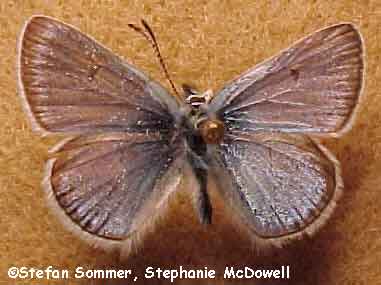
Greenish Blue
Family: Lycaenidae
Family Description:
Alternate Common Name: Greenish Clover Blue.
Description:
Caterpillar: The caterpillar varies in color, from greenish, to greenish white tinged with purplish at the ends, to reddish. It has a bumpy appearance, with each individual segment appearing fat. It reaches an average, full-grown length of ½ inch.
Adult: The butterflies vary greatly in appearance between populations, the sexes, and even from individual to individual. They are fairly small, each with a wingspan of 1 to 1 ¼ inches. Males: Typically, the male is silvery blue on the upperside, possibly tinged with green. The borders of the wings are black and fringed with white. The forewing may have a dark spot near the middle, and the hindwing may have a faint row of blackish dots at the rear. Underneath is grayish white to gray, possibly bluish where the wings meet the body. Both the fore- and hindwings are dotted with black underneath; the hindwing may have one large spot and/or several small, orange spots. Females: The female is brownish on the upperside, possibly with orange near the edge of the wings, or brownish with blue shading, sometimes extensive, where the wings attach to the body. The forewing may have a dark spot near the middle. The edges are black and fringed with white. Underneath is beige and marked similarly to the male.
Range:
This species ranges from central Alaska south to the mountains of southern California and northern Arizona and New Mexico, extending east as far as western Montana and Wyoming; it also extends east across central and southern Canada and the Great Lakes states to New England and Nova Scotia. It occurs through most of Idaho.
Habitat:
It can be found in moist areas such as bogs, meadows, grassy fields, open forests, and along streams. Most commonly, it occurs above 6,000 feet elevation.
Diet:
Caterpillar: Caterpillars feed on the flowers and fruits of clovers (Trifolium spp.).
Adult: Butterflies drink flower nectar, often from clovers. Males are often found "puddling" at muddy seeps where they gather salts and nutrients by sipping moisture.
Ecology:
The caterpillar is equipped with a honey gland, also known as a dorsal nectary organ, which emits a sugary solution agreeable to ants. The ants feed on the solution and in turn protect the caterpillar from predators. Also for protection, the caterpillar bears a pair of everscible tubercles or tentacles on the eighth segment. These tubercles are usually housed within the body, but when the caterpillar feels threatened by the approach of a potential predator, they can be pushed out to release a chemical which mimics an ant alarm pheromone. This scent causes the ants to become frenzied and aggressive, and the potential predator takes leave or is eaten by the ants. There is usually only one generation of caterpillars each summer. They feed all summer and then overwinter in a physiological state called diapause until spring. In spring they emerge to continue feeding and molting and eventually to pupate. Each caterpillar undergoes four stages of growth, called instars. Adults generally fly from mid-May to mid-August. Butterflies tend to remain near clovers.
Reproduction:
Males actively patrol in search of receptive females. Females lay eggs singly in the buds and young flowers of clovers.
Conservation:
| Global Rank: | G5; most populations are widespread, abundant, and secure. However, one subspecies from southern California, the San Gabriel Blue, is now extinct due to destruction of its habitat. |
References:
Ballmer, G. R. and G. F. Pratt. 1988. A survey of the last instar larvae of the Lycaenidae of California. Journal of Research on the Lepidoptera 27:1-81.
Ferris, C. D. and F. M. Brown. (eds.) 1981. Butterflies of the Rocky Mountain States. Univ. of Oklahoma Press, Norman, Oklahoma, USA, 442 pp.
Opler, P. A., H. Pavulaan, and R. E. Stanford. 1995. Butterflies of North America. Jamestown, North Dakota, USA: Northern Prairie Wildlife Research Center Home Page. http://www.npwrc.usgs.gov/resource/distr/lepid/bflyusa/bflyusa.htm (Version 05Nov98).
Opler, P. A. and A. B.Wright. 1999. A Field Guide to the Western Butterflies. Second Edition. Peterson Field Guide Series. Houghton Mifflin Company, New York, New York, USA, 540 pp.
Pyle, R. M. 1981. National Audubon Society Field Guide to North American Butterflies. Alfred A. Knopf, Inc., New York, New York, USA, 924 pp.
Scott, J. A. 1986. The Butterflies of North America. Stanford University Press, Stanford, California, USA, 583 pp.
Stanford, R. E. and P. A. Opler. 1993. Atlas of Western U.S.A. Butterflies (Including Adjacent Parts of Canada and Mexico). Published by authors, Denver, Colorado, USA, 275 pp.
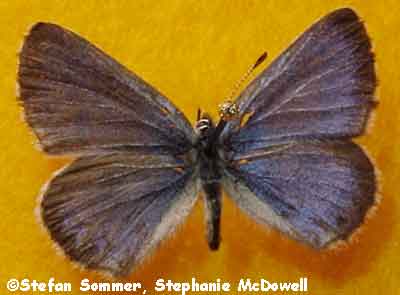
Arrowhead Blue
Family: Lycaenidae
Family Description:
Description:
Caterpillar: The caterpillar is quite variable in appearance. It may be bluish green and marked lengthwise along the back with a lighter stripe and on the sides with pink. Another form is greenish white, marked with white and red dots and red side dashes. A third form is yellowish brown, marked with a back stripe and whitish red side dashes. Its average, full-grown length is 3/4 inch.
Adult: This is a medium-sized butterfly, with a wingspan of 1 to 1 3/8 inches; for a "Blue," it is quite large. The male is violet blue on the upperside and edged in brown; the brown may extend inwardly on portions of the wing. The female is dull blue and brown. Underneath, both sexes are gray to brownish gray and marked with black dots. The hindwing has a curved row of white "arrowheads", and an uneven white spot. The wings are edged with a black-and-white checkered border.
Range:
A western butterfly, it ranges from southern British Columbia and Alberta south through the western third of the U.S. It occurs through much of Idaho. Typically, it is an uncommon butterfly.
Habitat:
This species occurs in meadows, grassy fields, woodlands, and in coastal dunes and lowlands.
Diet:
Caterpillar: Caterpillars eat the flowers and fruits of legumes such as milk vetches (Astragalus spp.) and lupines (Lupinus spp.).
Adult: Butterflies drink flower nectar.
Ecology:
The caterpillar is equipped with a honey gland, also known as a dorsal nectary organ, which emits a sugary solution agreeable to ants. The ants feed on the solution and in turn protect the caterpillar from predators. Also for protection, the caterpillar bears a pair of everscible tubercles or tentacles on the eighth segment. These tubercles are usually housed within the body, but when the caterpillar feels threatened by the approach of a potential predator, they can be pushed out to release a chemical which mimics an ant alarm pheromone. This scent causes the ants to become frenzied and aggressive, and the potential predator takes leave or is eaten by the ants. There is one generation of caterpillars each growing season. Each caterpillar undergoes four stages of growth, called instars. Pupae overwinter in a physiological state called diapause. Butterflies typically fly from March to early July.
Reproduction:
Males actively patrol in search of females. Females lay eggs singly on host plants, primarily on flower buds.
Conservation:
| Global Rank: | G5; most populations are widespread, abundant, and secure. Certain populations in California, however, may be in jeopardy. |
References:
Ballmer, G. R. and G. F. Pratt. 1988. A survey of the last instar larvae of the Lycaenidae of California. Journal of Research on the Lepidoptera 27:1-81.
Ferris, C. D. and F. M. Brown. (eds.) 1981. Butterflies of the Rocky Mountain States. Univ. of Oklahoma Press, Norman, Oklahoma, USA, 442 pp.
Opler, P. A., H. Pavulaan, and R. E. Stanford. 1995. Butterflies of North America. Jamestown, North Dakota, USA: Northern Prairie Wildlife Research Center Home Page. http://www.npwrc.usgs.gov/resource/distr/lepid/bflyusa/bflyusa.htm (Version 05Nov98).
Opler, P. A. and A. B.Wright. 1999. A Field Guide to the Western Butterflies. Second Edition. Peterson Field Guide Series. Houghton Mifflin Company, New York, New York, USA, 540 pp.
Pyle, R. M. 1981. National Audubon Society Field Guide to North American Butterflies. Alfred A. Knopf, Inc., New York, New York, USA, 924 pp.
Scott, J. A. 1986. The Butterflies of North America. Stanford University Press, Stanford, California, USA, 583 pp.
Stanford, R. E. and P. A. Opler. 1993. Atlas of Western U.S.A. Butterflies (Including Adjacent Parts of Canada and Mexico). Published by authors, Denver, Colorado, USA, 275 pp.
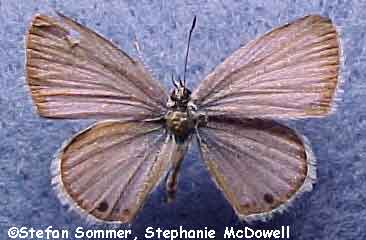
Reakirt’s Blue
Family: Lycaenidae
Family Description:
Alternate Common Names:Solitary Blue, Mexican Blue.
Note: This species is referred to by the genus name Echinargus by some authors; others consider Echinargus to be a subgenus of Hemiargus.
Description:
Caterpillar: The caterpillar is light green and marked with red. Its average, full-grown length is reported to be 1/2 inch.
Adult: The butterfly is small to medium-sized, with a wingspan of 3/4 to 1 1/8 inches. The male is light purplish blue on the upperside, while the female is bluish brown with blue where the wings attach to the body. The hindwing of both sexes may have one or two black spots near the outside edge. Underneath is brownish white and marked with a curved row of five or six black spots, outlined in white, on the forewing. The underside of the hindwing is marked with several smaller black or brown spots.
Range:
This species is a resident of the extreme southwestern U.S., Mexico, and Central America. It migrates north in the summer up to Nevada, southern Idaho, Wyoming, and east through the Plains states as far as Ohio.
Habitat:
It can be found in open areas such as fields, grasslands, meadows, and deserts.
Diet:
Caterpillar: Caterpillars feed on the flowers, fruits, and young leaves of a variety of legumes, including acacias (Albizzia and Acacia spp.), indigos (Dalea and Indigofera spp.), and mesquite (Prosopis spp.).
Adult: Butterflies drink flower nectar.
Ecology:
The caterpillar is equipped with a honey gland, also known as a dorsal nectary organ, which emits a sugary solution agreeable to ants. The ants feed on the solution and in turn protect the caterpillar from predators. Also for protection, the caterpillar bears a pair of everscible tubercles or tentacles on the eighth segment. These tubercles are usually housed within the body, but when the caterpillar feels threatened by the approach of a potential predator, they can be pushed out to release a chemical which mimics an ant alarm pheromone. This scent causes the ants to become frenzied and aggressive, and the potential predator takes leave or is eaten by the ants. There are three or more generations of caterpillars each year. Each caterpillar undergoes four stages of growth, called instars. Adults migrate north in the summer, generally flying from March to Novemeber but occurring all year long in some parts of its range. While this species may overwinter in a physiological state of diapause in parts of its range, the stage in which it does so has not been observed or reported.
Reproduction:
Males actively patrol in search of receptive females. Females lay eggs singly on the flower buds of host plants.
Conservation:
| Global Rank: | G5; populations are widespread, abundant, and secure. |
References:
Ballmer, G. R. and G. F. Pratt. 1988. A survey of the last instar larvae of the Lycaenidae of California. Journal of Research on the Lepidoptera 27:1-81.
Ferris, C. D. and F. M. Brown. (eds.) 1981. Butterflies of the Rocky Mountain States. Univ. of Oklahoma Press, Norman, Oklahoma, USA, 442 pp.
Opler, P. A., H. Pavulaan, and R. E. Stanford. 1995. Butterflies of North America. Jamestown, North Dakota, USA: Northern Prairie Wildlife Research Center Home Page. http://www.npwrc.usgs.gov/resource/distr/lepid/bflyusa/bflyusa.htm (Version 05Nov98).
Opler, P. A. and A. B.Wright. 1999. A Field Guide to the Western Butterflies. Second Edition. Peterson Field Guide Series. Houghton Mifflin Company, New York, New York, USA, 540 pp.
Pyle, R. M. 1981. National Audubon Society Field Guide to North American Butterflies. Alfred A. Knopf, Inc., New York, New York, USA, 924 pp.
Scott, J. A. 1986. The Butterflies of North America. Stanford University Press, Stanford, California, USA, 583 pp.
Stanford, R. E. and P. A. Opler. 1993. Atlas of Western U.S.A. Butterflies (Including Adjacent Parts of Canada and Mexico). Published by authors, Denver, Colorado, USA, 275 pp.
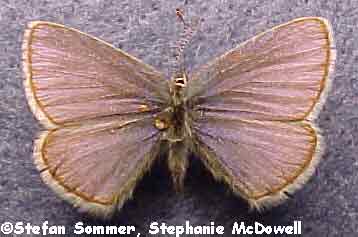
Northern Blue
Family: Lycaenidae
Family Description:
Note: Some authors refer to this species as Lycaeides argyrognomon, and others list it with the genus name Plebejus. This species is very similar to the Melissa Blue (L. melissa) and in certain parts of its range can only be distinguished by dissection.
Description:
Caterpillar: The appearance of the caterpillar varies from greenish to brownish, and it may be marked with reddish lines along the back and faint whitish marks on the side. Its average, full-grown length is 1/2 inch.
Adult: This is a small to medium-sized butterfly, with a wingspan of 7/8 to 1 1/2 inches, and its appearance is variable. Generally, the male is shiny purplish blue on the upperside, with a thin black outline and white fringe. The female is bluish gray to brown, fringed with white, and marked with a row of brownish orange spots along the rear of the hindwing, possibly extending more faintly along the edge of the forewing. Underneath, both sexes are grayish white to light brown and dotted with black. The edges of the wings, especially the hindwing, may be marked with a curved row of orange spots; additionally, there may be silvery green spots here as well. There is a black line outlining the wings that becomes a line of connected dots on the hindwing.
Range:
This species is holarctic, which means it occurs in the temperate regions of the Northern Hemisphere. In North America, it ranges from Alaska south and east across Canada to the east coast; south through western Washington and Oregon to central California; in portions of Idaho, Montana, Wyoming, and Colorado; and in the Great Lakes states.
Habitat:
It occurs in open areas including tundra, meadows, forest openings, and bogs.
Diet:
Caterpillar: Caterpillars feed on various members of the heath family (Ericaceae) in the eastern part of its range, and on legumes (Lupinus, Astragalus, and Lotus spp.) in the west.
Adult: Butterflies drink flower nectar.
Ecology:
The caterpillar is equipped with a honey gland, also known as a dorsal nectary organ, which emits a sugary solution agreeable to ants. The ants feed on the solution and in turn protect the caterpillar from predators. Also for protection, the caterpillar bears a pair of everscible tubercles or tentacles on the eighth segment. These tubercles are usually housed within the body, but when the caterpillar feels threatened by the approach of a potential predator, they can be pushed out to release a chemical which mimics an ant alarm pheromone. This scent causes the ants to become frenzied and aggressive, and the potential predator takes leave or is eaten by the ants. There is one generation of caterpillars each summer. Each caterpillar undergoes four stages of growth, called instars. Both eggs and young caterpillars can overwinter in a physiological state called diapause. Adults generally fly from June to early October.
Reproduction:
Males actively patrol, most often near host plants, in search of receptive females. Females lay eggs singly on the stems of host plants or in the litter below.
Conservation:
| Global Rank: | G5; most populations are widespread, abundant, and secure. However, subspecies L. idas lotis of California is ranked as T1, which means it is critically imperiled because of extreme rarity and is imminently vulnerable to extinction. |
References:
Ballmer, G. R. and G. F. Pratt. 1988. A survey of the last instar larvae of the Lycaenidae of California. Journal of Research on the Lepidoptera 27:1-81.
Ferris, C. D. and F. M. Brown. (eds.) 1981. Butterflies of the Rocky Mountain States. Univ. of Oklahoma Press, Norman, Oklahoma, USA, 442 pp.
Opler, P. A., H. Pavulaan, and R. E. Stanford. 1995. Butterflies of North America. Jamestown, North Dakota, USA: Northern Prairie Wildlife Research Center Home Page. http://www.npwrc.usgs.gov/resource/distr/lepid/bflyusa/bflyusa.htm (Version 05Nov98).
Opler, P. A. and A. B.Wright. 1999. A Field Guide to the Western Butterflies. Second Edition. Peterson Field Guide Series. Houghton Mifflin Company, New York, New York, USA, 540 pp.
Pyle, R. M. 1981. National Audubon Society Field Guide to North American Butterflies. Alfred A. Knopf, Inc., New York, New York, USA, 924 pp.
Scott, J. A. 1986. The Butterflies of North America. Stanford University Press, Stanford, California, USA, 583 pp.
Stanford, R. E. and P. A. Opler. 1993. Atlas of Western U.S.A. Butterflies (Including Adjacent Parts of Canada and Mexico). Published by authors, Denver, Colorado, USA, 275 pp.
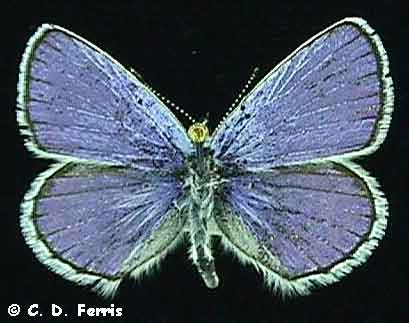
Melissa Blue
Family: Lycaenidae
Family Description:
Alternate Common Names:Orange-Bordered Blue, Karner Blue.
Note: This species is referred to with the genus name Plebejus by some authors.
Description:
Caterpillar: The caterpillar is green to light green, darker above, and is covered with hair. It is marked on the side with whitish dashes, forming a stripe. The average, full-grown length of the caterpillar is 3/4 inch.
Adult: This is a fairly small butterfly, with a wingspan of 7/8 to 1 3/8 inches. The male is silvery to dark blue on the upperside, outlined in black and fringed with white. The female is grayish brown, may be clouded with blue, and is fringed with white. A thick, bright orange band, possibly spotted with brown, lines the outer edges of the wings. Underneath both sexes are gray to white and dotted with black. A thin black line outlines the outer edges of the wings. There is a curved row of orange spots, possibly joined forming a band, on the underside of the hindwing and partially on the underside of the forewing. The orange may be dotted with iridescent green.
Range:
This species ranges from central Canada, south through most of the western half of the U.S., and east through the Great Lakes states to New Hampshire. It occurs throughout Idaho.
Habitat:
In the west it occurs in open areas such as meadows and prairies; in the east, it occurs in sandy habitats.
Diet:
Caterpillar: Caterpillars feed on the new leaves and flowers of a variety of legumes, including lupines (Lupinus spp.), alfalfa (Medicago spp.), and milkvetch (Astragalus spp.).
Adult: Butterflies drink flower nectar.
Ecology:
The caterpillar is equipped with a honey gland, also known as a dorsal nectary organ, which emits a sugary solution agreeable to ants. The ants feed on the solution and in turn protect the caterpillar from predators. Also for protection, the caterpillar bears a pair of everscible tubercles or tentacles on the eighth segment. These tubercles are usually housed within the body, but when the caterpillar feels threatened by the approach of a potential predator, they can be pushed out to release a chemical which mimics an ant alarm pheromone. This scent causes the ants to become frenzied and aggressive, and the potential predator takes leave or is eaten by the ants. There are two generations of caterpillars each summer in the east, and three in the west. Each caterpillar undergoes four stages of growth, called instars. Either the egg overwinters, or the newly hatched caterpillar overwinters in a physiological state called diapause. Adults generally fly from April to November.
Reproduction:
Males actively patrol in search of receptive females. Females lay eggs by walking down the stem of a host plant, ovipositing along the way and at the base of the plant. The eggs are green with white ridges.
Conservation:
| Global Rank: | G5; most populations are widespread, abundant, and secure. One subspecies in New York, the Karner Blue (L. melissa samuelis), is ranked as T2, imperiled and vulnerable to extinction, and is protected. |
References:
Ballmer, G. R. and G. F. Pratt. 1988. A survey of the last instar larvae of the Lycaenidae of California. Journal of Research on the Lepidoptera 27:1-81.
Ferris, C. D. and F. M. Brown. (eds.) 1981. Butterflies of the Rocky Mountain States. Univ. of Oklahoma Press, Norman, Oklahoma, USA, 442 pp.
Opler, P. A., H. Pavulaan, and R. E. Stanford. 1995. Butterflies of North America. Jamestown, North Dakota, USA: Northern Prairie Wildlife Research Center Home Page. http://www.npwrc.usgs.gov/resource/distr/lepid/bflyusa/bflyusa.htm (Version 05Nov98).
Opler, P. A. and A. B.Wright. 1999. A Field Guide to the Western Butterflies. Second Edition. Peterson Field Guide Series. Houghton Mifflin Company, New York, New York, USA, 540 pp.
Pyle, R. M. 1981. National Audubon Society Field Guide to North American Butterflies. Alfred A. Knopf, Inc., New York, New York, USA, 924 pp.
Scott, J. A. 1986. The Butterflies of North America. Stanford University Press, Stanford, California, USA, 583 pp.
Stanford, R. E. and P. A. Opler. 1993. Atlas of Western U.S.A. Butterflies (Including Adjacent Parts of Canada and Mexico). Published by authors, Denver, Colorado, USA, 275 pp.
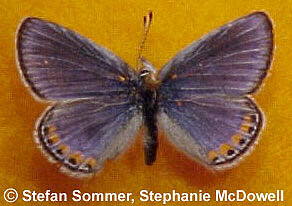
Acmon Blue
Family: Lycaenidae
Family Description:
Alternate Common Names:Emerald-Studded Blue, Silver-Studded Blue.
Note: The distinctions between this species and the Lupine Blue, Plebejus [Icaricia] lupinus, are unclear and debated by scientists.
Description:
Caterpillar: The caterpillar is brownish yellow, striped lengthwise with dark green, and marked on the sides with a band of green or other variable markings. It is covered with fine white hair. The average, full-grown length is ½ inch.
Adult: The butterfly is small, with a wingspan of ¾ to 1 inch. The male is blue on the upperside while the female is more brownish, but may often have blue where the wings attach to the body. Both sexes are outlined in black, fringed with white, and marked on the hindwing with a curved band of orange followed by a row of black dots. Underneath is dingy white, dotted with black. The hindwing has a curved row of orange, followed by a row of black dots with a green metallic sheen.
Range:
A widespread species, it ranges from southern British Columbia east to southwestern Saskatchewan, and south through the western half of the U.S. to Mexico. It occurs throughout Idaho. Isolated populations may occur in Minnesota and New Jersey.
Habitat:
It utilizes a wide variety of habitats, including fields, prairies, open woodlands, and deserts.
Diet:
Caterpillar: Caterpillars feed on the leaves, flowers, and fruits of wild buckwheat (Eriogonum spp.) and legumes such as trefoils (Lotus spp.), milkvetches (Astragalus spp.), and lupines (Lupinus spp.).
Adult: Butterflies drink flower nectar.
Ecology:
Caterpillars often can be found inside host plant pods. Each caterpillar is equipped with a honey gland, also known as a dorsal nectary organ, which emits a sugary solution agreeable to ants. The ants feed on the solution and in turn protect the caterpillar from predators. Also for protection, the caterpillar bears a pair of everscible tubercles or tentacles on the eighth segment. These tubercles are usually housed within the body, but when the caterpillar feels threatened by the approach of a potential predator, they can be pushed out to release a chemical which mimics an ant alarm pheromone. This scent causes the ants to become frenzied and aggressive, and the potential predator takes leave or is eaten by the ants. There can be several generations of caterpillars each summer in most of the range, but only one in the north. Each caterpillar undergoes four stages of growth, or instars. Young caterpillars overwinter in a physiological state called diapause. Adults generally fly from February to october. Butterflies may disperse to some degree, as the isolated populations in Minnesota demonstrate. The New Jersey population was probably introduced. This is one of the most common Blues in the west.
Reproduction:
Males actively patrol in search of receptive females. Females lay light green eggs singly on the leaves and flowers of host plants.
Conservation:
| Global Rank: | G5; populations are widespread, abundant, and secure. |
References:
Ballmer, G. R. and G. F. Pratt. 1988. A survey of the last instar larvae of the Lycaenidae of California. Journal of Research on the Lepidoptera 27:1-81.
Ferris, C. D. and F. M. Brown. (eds.) 1981. Butterflies of the Rocky Mountain States. Univ. of Oklahoma Press, Norman, Oklahoma, USA, 442 pp.
Opler, P. A., H. Pavulaan, and R. E. Stanford. 1995. Butterflies of North America. Jamestown, North Dakota, USA: Northern Prairie Wildlife Research Center Home Page. http://www.npwrc.usgs.gov/resource/distr/lepid/bflyusa/bflyusa.htm (Version 05Nov98).
Opler, P. A. and A. B.Wright. 1999. A Field Guide to the Western Butterflies. Second Edition. Peterson Field Guide Series. Houghton Mifflin Company, New York, New York, USA, 540 pp.
Pyle, R. M. 1981. National Audubon Society Field Guide to North American Butterflies. Alfred A. Knopf, Inc., New York, New York, USA, 924 pp.
Scott, J. A. 1986. The Butterflies of North America. Stanford University Press, Stanford, California, USA, 583 pp.
Stanford, R. E. and P. A. Opler. 1993. Atlas of Western U.S.A. Butterflies (Including Adjacent Parts of Canada and Mexico). Published by authors, Denver, Colorado, USA, 275 pp.
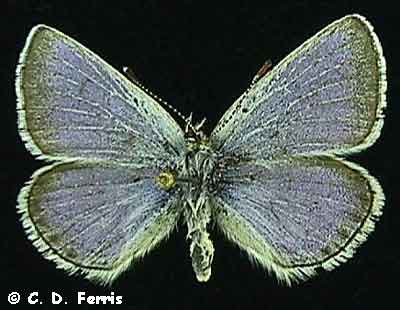
Boisduval’s Blue
Family: Lycaenidae
Family Description:
Alternate Common Names:Common Blue, Lupine Blue.
Description:
Caterpillar: This is a very small caterpillar, with an average, full-grown length of about 1/2 inch. It is typically green, striped lengthwise along the back with a reddish or darker green line, and marked on the sides with diagonal white dashes. It is covered with short white hair. Alternatively, it can be reddish purple in color.
Adult: This butterfly is large for a Blue, with a wingspan of 1 to 1 3/8 inches. Males are purplish blue on the upperside, while females are brown and possibly clouded with blue where the wings attach to the body. Both sexes are outlined in black and fringed with white. Underneath is white to gray to cream and marked with two curved, fairly even rows of black spots; the forewing spots are noticeably larger than those on the hindwing.
Range:
This species ranges from southern British Columbia and Alberta south to southern California and central Arizona and New Mexico, extending to the east as far as the western portions of the Dakotas and central Colorado. It occurs through most of Idaho.
Habitat:
It occurs in a variety of habitats, including sagebrush steppe, meadows, prairies, forest openings, and coastal dunes, but always near to where lupines are growing.
Diet:
Caterpillar: Caterpillars feed on the leaves, flowers and fruits of many lupine species (Lupinus spp.), but seem to prefer new shoots in the spring.
Adult: Butterflies drink flower nectar, and males can often be found "puddling" at muddy seeps where they gather salts and other nutrients by sipping moisture.
Ecology:
The caterpillars sometimes rest during the day in holes dug by ants near host plants. The caterpillar is equipped with a honey gland, also known as a dorsal nectary organ, which emits a sugary solution agreeable to ants. The ants feed on the solution and in turn protect the caterpillar from predators. Also for protection, the caterpillar bears a pair of everscible tubercles or tentacles on the eighth segment. These tubercles are usually housed within the body, but when the caterpillar feels threatened by the approach of a potential predator, they can be pushed out to release a chemical which mimics an ant alarm pheromone. This scent causes the ants to become frenzied and aggressive, and the potential predator takes leave or is eaten by the ants. There is only one new generation of caterpillars each summer. Young caterpillars overwinter in a physiological state called diapause, and emerge in spring to continue feeding, to molt, and eventually to pupate. Each caterpillar undergoes four stages of growth, called instars. Adults generally fly from April to mid-August. The adults are the largest Blues in North America.
Reproduction:
Males actively patrol in search of receptive females. Females lay eggs singly on host plant leaves, often the underside; other plant parts may be chosen for oviposition as well. Typically, only one species of lupine is used in a given area, and it is often the one with the most pubescence (hair).
Conservation:
| Global Rank: | G5; most populations are widespread, abundant, and secure. One subspecies in California, P. icarioides missionensis, the Mission Blue, is listed as T1. This means it is critically imperiled because of extreme rarity and is imminently vulnerable to extinction. |
References:
Ballmer, G. R. and G. F. Pratt. 1988. A survey of the last instar larvae of the Lycaenidae of California. Journal of Research on the Lepidoptera 27:1-81.
Ferris, C. D. and F. M. Brown. (eds.) 1981. Butterflies of the Rocky Mountain States. Univ. of Oklahoma Press, Norman, Oklahoma, USA, 442 pp.
Opler, P. A., H. Pavulaan, and R. E. Stanford. 1995. Butterflies of North America. Jamestown, North Dakota, USA: Northern Prairie Wildlife Research Center Home Page. http://www.npwrc.usgs.gov/resource/distr/lepid/bflyusa/bflyusa.htm (Version 05Nov98).
Opler, P. A. and A. B.Wright. 1999. A Field Guide to the Western Butterflies. Second Edition. Peterson Field Guide Series. Houghton Mifflin Company, New York, New York, USA, 540 pp.
Pyle, R. M. 1981. National Audubon Society Field Guide to North American Butterflies. Alfred A. Knopf, Inc., New York, New York, USA, 924 pp.
Scott, J. A. 1986. The Butterflies of North America. Stanford University Press, Stanford, California, USA, 583 pp.
Stanford, R. E. and P. A. Opler. 1993. Atlas of Western U.S.A. Butterflies (Including Adjacent Parts of Canada and Mexico). Published by authors, Denver, Colorado, USA, 275 pp.
Lupine Blue
Family: Lycaenidae
Family Description:
Alternate Common Name: Large Silver-Studded Blue.
Note: The distinctions between this species and the Acmon Blue, Plebejus [Icaricia] acmon, are unclear and debated by scientists. Some authors refer to this species as Plebejus [Icaricia] lupini.
Description:
Caterpillar: The caterpillar is greenish, sometimes reddish, and marked with a dark stripe along the back and variable markings on the side. It is covered with fine white hair. The average, full-grown length of the caterpillar is 1/2 to 3/4 inch.
Adult: This is a small butterfly, with a wingspan of 3/4 to 1 1/8 inches. The male is purplish blue on the upperside while the female is dark brown. Both sexes are outlined in black, fringed with white, and marked with a curved orange band near the edge of the hindwing. In some males this band may be divided into a series of separate spots. Underneath is grayish white and marked with black spots arranged in curved rows. The underside of the hindwing is marked by a curved orange band which may be tipped with metallic green towards the outside.
Range:
This species occurs in parts of central Washington and Oregon, south into California and Nevada. It also occurs in patches of northern and west central Idaho.
Habitat:
It can be found at moderate elevations in open areas such as meadows, chaparral, rocky outcrops, and forest openings.
Diet:
Caterpillar: Caterpillars feed on the flowers of wild buckwheat (Eriogonum spp.).
Adult: Butterflies drink flower nectar.
Ecology:
The caterpillar is equipped with a honey gland, also known as a dorsal nectary organ, which emits a sugary solution agreeable to ants. The ants feed on the solution and in turn protect the caterpillar from predators. Also for protection, the caterpillar bears a pair of everscible tubercles or tentacles on the eighth segment. These tubercles are usually housed within the body, but when the caterpillar feels threatened by the approach of a potential predator, they can be pushed out to release a chemical which mimics an ant alarm pheromone. This scent causes the ants to become frenzied and aggressive, and the potential predator takes leave or is eaten by the ants. There is only one new generation of caterpillars each summer in the Sierra Nevadas of California but there are several elsewhere in its range. Young caterpillars overwinter in a physiological state called diapause. Adults generally fly from March through September. This species’ name is not accurately descriptive, as its caterpillar does not feed on lupines, while many other species of Blues do.
Reproduction:
Males actively patrol in search of receptive females. Females lay eggs singly on the flowers of host plants.
Conservation:
| Global Rank: | G4; population levels are secure, but may be of concern in the future. |
References:
Ballmer, G. R. and G. F. Pratt. 1988. A survey of the last instar larvae of the Lycaenidae of California. Journal of Research on the Lepidoptera 27:1-81.
Opler, P. A., H. Pavulaan, and R. E. Stanford. 1995. Butterflies of North America. Jamestown, North Dakota, USA: Northern Prairie Wildlife Research Center Home Page. http://www.npwrc.usgs.gov/resource/distr/lepid/bflyusa/bflyusa.htm (Version 05Nov98).
Opler, P. A. and A. B.Wright. 1999. A Field Guide to the Western Butterflies. Second Edition. Peterson Field Guide Series. Houghton Mifflin Company, New York, New York, USA, 540 pp.
Pyle, R. M. 1981. National Audubon Society Field Guide to North American Butterflies. Alfred A. Knopf, Inc., New York, New York, USA, 924 pp.
Scott, J. A. 1986. The Butterflies of North America. Stanford University Press, Stanford, California, USA, 583 pp.
Stanford, R. E. and P. A. Opler. 1993. Atlas of Western U.S.A. Butterflies (Including Adjacent Parts of Canada and Mexico). Published by authors, Denver, Colorado, USA, 275 pp.
Shasta Blue
Family: Lycaenidae
Family Description:
Alternate Common Names:Cushion-Plant Blue, Alpine Blue.
Description:
Caterpillar: The caterpillar varies in color from brown to green to white. It is marked with a black or brownish line or band along the back and on each side, and black diagonal dashes. It reaches an average length of 1/2 inch.
Adult: The butterfly is fairly small, with a wingspan of ¾ to 1 inch. The upperside of the male is purplish blue with a thick, dark brown border along the outer edge of the forewing. A similar border may edge the hindwing, or it may appear as a row of closely spaced large spots. Both the fore- and hindwing are usually marked with a single, crescent-shaped black spot. The upperside of the female is brown to bluish brown and marked similarly to the male. The hindwing is edged with a row of black spots edged with orange towards the inside. Underneath, both sexes are whitish gray to dark gray and often appear mottled. The underside of the forewing is marked with a curved row of blackish spots followed by two curved rows of brownish spots. The underside of the hindwing is marked with black and brownish spots and a curved row of greenish metallic spots along the outer edge, capped with orange or brown.
Range:
This species ranges from southern Alberta and Saskatchewan south through Montana to Colorado and Utah, and from central Oregon south to central California and Nevada. It occurs in Idaho in the southcentral and southeastern portions of the state.
Habitat:
It typically occurs at higher elevations on rocky slopes, in meadows, forest openings, sagebrush steppe, and prairie hills.
Diet:
Caterpillar: Caterpillars feed on the leaves and flowers of various members of the pea family (Fabaceae), including lupine (Lupinus spp.), clover (Trifolium spp.), and milkvetch (Astragalus spp.).
Adult: Butterflies drink flower nectar.
Ecology:
Each caterpillar is equipped with a honey gland, also known as a dorsal nectary organ, which emits a sugary solution agreeable to ants. The ants feed on the solution and in turn protect the caterpillar from predators. Also for protection, the caterpillar bears a pair of everscible tubercles or tentacles on the eighth segment. These tubercles are usually housed within the body, but when the caterpillar feels threatened by the approach of a potential predator, they can be pushed out to release a chemical which mimics an ant alarm pheromone. This scent causes the ants to become frenzied and aggressive, and the potential predator takes leave or is eaten by the ants. There is one generation of caterpillars each year throughout its range. Each caterpillar undergoes four stages of growth, or instars. In much of its range, it is a biennial species requiring two years to complete its life cycle. Eggs laid in the summer overwinter and hatch in the spring. The caterpillars then feed and molt during the following summer and overwinter in a physiological state called diapause, emerging in spring to pupate. Adults generally fly from June through July, sometimes flying into September. The butteflies generally fly only a few inches above the ground.
Reproduction:
Males actively patrol in search of receptive females. Females lay their eggs singly primarily on the leaves of host plants.
Conservation:
| Global Rank: | G5; populations are widespread, abundant, and secure. |
References:
Ballmer, G. R. and G. F. Pratt. 1988. A survey of the last instar larvae of the Lycaenidae of California. Journal of Research on the Lepidoptera 27:1-81.
Ferris, C. D. and F. M. Brown. (eds.) 1981. Butterflies of the Rocky Mountain States. Univ. of Oklahoma Press, Norman, Oklahoma, USA, 442 pp.
Opler, P. A., H. Pavulaan, and R. E. Stanford. 1995. Butterflies of North America. Jamestown, North Dakota, USA: Northern Prairie Wildlife Research Center Home Page. http://www.npwrc.usgs.gov/resource/distr/lepid/bflyusa/bflyusa.htm (Version 05Nov98).
Opler, P. A. and A. B.Wright. 1999. A Field Guide to the Western Butterflies. Second Edition. Peterson Field Guide Series. Houghton Mifflin Company, New York, New York, USA, 540 pp.
Pyle, R. M. 1981. National Audubon Society Field Guide to North American Butterflies. Alfred A. Knopf, Inc., New York, New York, USA, 924 pp.
Scott, J. A. 1986. The Butterflies of North America. Stanford University Press, Stanford, California, USA, 583 pp.
Stanford, R. E. and P. A. Opler. 1993. Atlas of Western U.S.A. Butterflies (Including Adjacent Parts of Canada and Mexico). Published by authors, Denver, Colorado, USA, 275 pp.
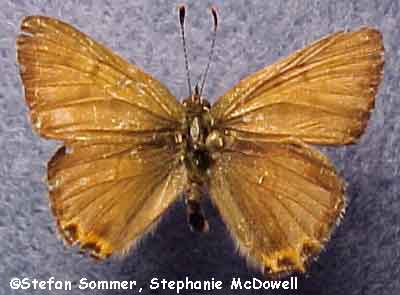
Tailed Copper
Family: Lycaenidae
Family Description:
Alternate Common Name: Arota Copper.
Description:
Caterpillar: The caterpillar is green and covered with tiny white bumps and short yellowish white hairs. It is marked lengthwise with two white lines along the back and a yellow line along each side. It reaches an average, full-grown length of 3/4 inch.
Adult: This is a fairly small butterfly, with a wingspan of 7/8 to 1 3/8 inches. It has a short, thin tail extending from the rear of each hindwing. Males are reddish brown on the upperside and may have a purplish sheen. Females are brown and marked with golden orange in large patches and bands. Both sexes are marked with orange along the edge of the hindwing, with the orange extending onto the tail. Underneath, the forewing of both sexes is grayish brown clouded with orange and spotted with black; the outer edge is marked with wavy, alternating bands of white and grayish brown. The underside of the hindwing is brownish gray, spotted with black, and marked along the outer edge as on the forewing. The rear of the hindwing is marked with a thin orange line, somewhat shaped like the letter "M" with the center extending onto the tail.
Range:
This species occurs in scattered portions of Oregon, California, and Nevada, and from southeastern Idaho south to Arizona and New Mexico, again in scattered patches.
Habitat:
It can be found in open woodlands, mountain meadows, chaparral, and sagebrush steppe.
Diet:
Caterpillar: Caterpillars feed on the leaves of currant and gooseberry (Ribes spp.).
Adult: Butterflies drink flower nectar, and appear to prefer white and yellow flowers. They can also be observed sipping berry juice and obtaining moisture and salts from mud.
Ecology:
Eggs overwinter and hatch in the spring. There is one generation of caterpillars each year. Each caterpillar undergoes four stages of growth, called instars. Adults generally fly from the end of May through September. Butterflies tend to remain in one location. The thin "tail" on each of the hindwings of adults is thought to mimic insect antennae and thus misleads bird predators into biting at the wrong end and only getting a mouthful of wing, while the butterfly escapes in the other direction.
Reproduction:
Males perch to wait for receptive females, and may occasionally patrol. White eggs are laid singly on twigs, dead leaves, or on ground debris near host plants.
Conservation:
| Global Rank: | Varies with subspecies. Subspecies Lycanea arota nubila of California is ranked as T1, which means it is critically imperiled because of extreme rarity and is imminently vulnerable to extinction. |
References:
Ballmer, G. R. and G. F. Pratt. 1988. A survey of the last instar larvae of the Lycaenidae of California. Journal of Research on the Lepidoptera 27:1-81.
Ferris, C. D. and F. M. Brown. (eds.) 1981. Butterflies of the Rocky Mountain States. Univ. of Oklahoma Press, Norman, Oklahoma, USA, 442 pp.
Opler, P. A., H. Pavulaan, and R. E. Stanford. 1995. Butterflies of North America. Jamestown, North Dakota, USA: Northern Prairie Wildlife Research Center Home Page. http://www.npwrc.usgs.gov/resource/distr/lepid/bflyusa/bflyusa.htm (Version 05Nov98).
Opler, P. A. and A. B.Wright. 1999. A Field Guide to the Western Butterflies. Second Edition. Peterson Field Guide Series. Houghton Mifflin Company, New York, New York, USA, 540 pp.
Pyle, R. M. 1981. National Audubon Society Field Guide to North American Butterflies. Alfred A. Knopf, Inc., New York, New York, USA, 924 pp.
Scott, J. A. 1986. The Butterflies of North America. Stanford University Press, Stanford, California, USA, 583 pp.
Stanford, R. E. and P. A. Opler. 1993. Atlas of Western U.S.A. Butterflies (Including Adjacent Parts of Canada and Mexico). Published by authors, Denver, Colorado, USA, 275 pp.
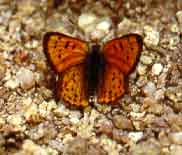
Lustrous Copper
Family: Lycaenidae
Family Description:
Description:
Caterpillar: The caterpillar is light green, or less commonly reddish; it may be marked with a red stripe along the side and reddish marks along the back. The average, full-grown length of the caterpillar is ž inch.
Adult: This is a fairly small to medium-sized butterfly, with a wingspan of 1 to 1 ź inches. The male is shiny, bright orange-red on the upperside, marked with a black border, black dots, and a white fringe. The female is yellowish orange, with a brown border and fairly large brown spots. Underneath, both sexes are very light brown to yellowish white and marked with black or brown spots. The underside of the forewing may be clouded with orange, and it is marked with a curved line of blackish dots along the outside edge; the same line on the underside of the hindwing is orange to red.
Range:
This species occurs at high elevations, from southern British Columbia to New Mexico, and from central Oregon to central California. In Idaho, it occurs in portions of the southern half of the state.
Habitat:
It can be found at high elevations, typically in meadows, along streams, and on rocky slopes.
Diet:
Caterpillar: Caterpillars feed on the leaves of certain members of the buckwheat family (Polygonaceae), including alpine sorrel (Rumex spp.) and mountain sorrel (Oxyria spp.).
Adult: Butterflies drink flower nectar.
Ecology:
There is one generation of caterpillars each summer. Each caterpillar undergoes four stages of growth, called instars. Caterpillars overwinter in a physiological state called diapause. Adults generally fly from May or June until August or September.
Reproduction:
Males perch to wait for receptive females, or may occasionally actively patrol for them. Females lay eggs singly on or near host plants.
Conservation:
| Global Rank: | G5; populations are widespread, abundant, and secure. |
References:
Ballmer, G. R. and G. F. Pratt. 1988. A survey of the last instar larvae of the Lycaenidae of California. Journal of Research on the Lepidoptera 27:1-81.
Ferris, C. D. and F. M. Brown. (eds.) 1981. Butterflies of the Rocky Mountain States. Univ. of Oklahoma Press, Norman, Oklahoma, USA, 442 pp.
Opler, P. A., H. Pavulaan, and R. E. Stanford. 1995. Butterflies of North America. Jamestown, North Dakota, USA: Northern Prairie Wildlife Research Center Home Page. http://www.npwrc.usgs.gov/resource/distr/lepid/bflyusa/bflyusa.htm (Version 05Nov98).
Opler, P. A. and A. B.Wright. 1999. A Field Guide to the Western Butterflies. Second Edition. Peterson Field Guide Series. Houghton Mifflin Company, New York, New York, USA, 540 pp.
Pyle, R. M. 1981. National Audubon Society Field Guide to North American Butterflies. Alfred A. Knopf, Inc., New York, New York, USA, 924 pp.
Scott, J. A. 1986. The Butterflies of North America. Stanford University Press, Stanford, California, USA, 583 pp.
Stanford, R. E. and P. A. Opler. 1993. Atlas of Western U.S.A. Butterflies (Including Adjacent Parts of Canada and Mexico). Published by authors, Denver, Colorado, USA, 275 pp.

Gray Copper
Family: Lycaenidae
Family Description:
Note: This species is listed with the genus name Gaeides by some authors. Some authors consider this species to be a subspecies of Lycaena xanthoides, the Great Copper.
Description:
Caterpillar: The caterpillar is greenish to yellowish green and is marked with a darker green or reddish band, possibly edged in yellow, running lengthwise along the back. It reaches an average, full-grown length of approximately 1 inch.
Adult: This is a medium-sized butterfly, large for a Copper, with a wingspan of 1 1/4 to 1 1/2 inches. There ia a very short "tail" or extension of fringe on the rear of each hindwing. The male is grayish brown on the upperside with few additional markings, except for a small dark bar on the forewing, several pale spots on the fore-and hindwings, and several hazy spots, clouded by orange, along the edge of the hindwing. The female is grayish to dark brown on the upperside, possibly clouded with orange, spotted with black, and with a wavy orange band along the edge of the hindwing. Underneath, both sexes are gray to whitish gray, dotted with black, and marked along the hindwing with orange.
Range:
This species ranges in Canada from southern Alberta east to southern Manitoba, and in the U.S. from northern Idaho east to Minnesota, extending south to northern Texas and central Missouri and Illinois. In Idaho, it has been documented only in Bonner County.
Habitat:
It occurs in open, grassy areas, such as fields, prairies, meadows, and marshes.
Diet:
Caterpillar: Caterpillars feed on the leaves of a variety of docks (Rumex spp.).
Adult: Butterflies drink flower nectar, often from milkweed (Asclepias spp.) and thistle (Cirsium spp.).
Ecology:
Eggs overwinter and hatch in the spring, and the resulting brood is the only generation of caterpillars each year. Each caterpillar undergoes four stages of growth, called instars. Adults generally fly from mid-May through July or August. Butterflies exhibit a fast and erratic flight pattern, can be aggressive towards other butterflies, and are most active in the afternoon. They tend to stay in the same general location during their lifespan.
Reproduction:
Males perch to wait for receptive females. Females lay pale green eggs singly at or near the bases of host plants. The eggs turn white before hatching.
Conservation:
| Global Rank: | G5; populations are widespread, abundant, and secure. |
References:
Ferris, C. D. and F. M. Brown. (eds.) 1981. Butterflies of the Rocky Mountain States. Univ. of Oklahoma Press, Norman, Oklahoma, USA, 442 pp.
Opler, P. A., H. Pavulaan, and R. E. Stanford. 1995. Butterflies of North America. Jamestown, North Dakota, USA: Northern Prairie Wildlife Research Center Home Page. http://www.npwrc.usgs.gov/resource/distr/lepid/bflyusa/bflyusa.htm (Version 05Nov98).
Opler, P. A. and A. B.Wright. 1999. A Field Guide to the Western Butterflies. Second Edition. Peterson Field Guide Series. Houghton Mifflin Company, New York, New York, USA, 540 pp.
Pyle, R. M. 1981. National Audubon Society Field Guide to North American Butterflies. Alfred A. Knopf, Inc., New York, New York, USA, 924 pp.
Scott, J. A. 1986. The Butterflies of North America. Stanford University Press, Stanford, California, USA, 583 pp.
Stanford, R. E. and P. A. Opler. 1993. Atlas of Western U.S.A. Butterflies (Including Adjacent Parts of Canada and Mexico). Published by authors, Denver, Colorado, USA, 275 pp.
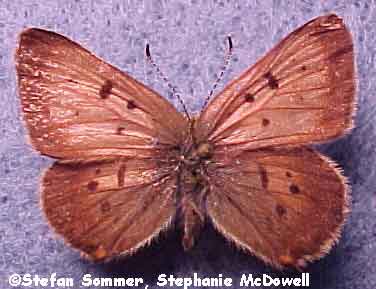
Dorcas Copper
Family: Lycaenidae
Family Description:
Alternate Common Name: Cinquefoil Copper.
Note: Some authors refer to this species with the genus name Epidemia. The distinction between this species and the Purplish Copper, Lycaena helloides, is not clear in some locations, such as in the Rocky Mountains, where the two have been known to hybridize.
Description:
Caterpillar: The caterpillar is pale green with a brownish head and short hair. It is marked with a dark green line along the back and numerous faint, white, vertical lines on the sides the body.
Adult: This is a fairly small butterfly, with a wingspan of 1 to 1 ¼ inches. The male is coppery brown on the upperside with a bluish purple sheen; the female is brown but may be clouded with yellow or beige, often on the outer portion of the wing. Both sexes are marked with black spots and crescents. Underneath is orangish brown and similarly but more faintly marked. There may be an orange to red border along the outer edge of the underside of the wings.
Range:
This species ranges from Alaska east across Canada, south to Washington and through the Rocky Mountains to northern New Mexico; in the Great Lakes states south to Ohio; and in Maine. It occurs in patches throughout Idaho.
Habitat:
It occurs in meadows, bogs, marshes, and forest openings.
Diet:
Caterpillar: Caterpillars feed on the leaves of cinquefoils (Potentilla spp.).
Adult: Butterflies drink flower nectar, often from plants belonging to the sunflower family (Asteraceae).
Ecology:
There is one generation of caterpillars each summer. Eggs overwinter in leaf litter, and the young caterpillars emerging in the spring must locate the host plant to begin feeding. Adults generally fly from mid-June through September.
Reproduction:
Males perch to wait for receptive females or may actively patrol for them. Females lay white eggs singly on the undersides of leaves of host plants. As the leaves of the host plant are shed in autumn, so, too, do the eggs fall to the ground; the eggs overwinter in the leaf litter.
Conservation:
| Global Rank: | G5; population levels are secure, but may be of concern in the future. |
References:
Ferris, C. D. and F. M. Brown. (eds.) 1981. Butterflies of the Rocky Mountain States. Univ. of Oklahoma Press, Norman, Oklahoma, USA, 442 pp.
Opler, P. A., H. Pavulaan, and R. E. Stanford. 1995. Butterflies of North America. Jamestown, North Dakota, USA: Northern Prairie Wildlife Research Center Home Page. http://www.npwrc.usgs.gov/resource/distr/lepid/bflyusa/bflyusa.htm (Version 05Nov98).
Opler, P. A. and A. B.Wright. 1999. A Field Guide to the Western Butterflies. Second Edition. Peterson Field Guide Series. Houghton Mifflin Company, New York, New York, USA, 540 pp.
Pyle, R. M. 1981. National Audubon Society Field Guide to North American Butterflies. Alfred A. Knopf, Inc., New York, New York, USA, 924 pp.
Scott, J. A. 1986. The Butterflies of North America. Stanford University Press, Stanford, California, USA, 583 pp.
Stanford, R. E. and P. A. Opler. 1993. Atlas of Western U.S.A. Butterflies (Including Adjacent Parts of Canada and Mexico). Published by authors, Denver, Colorado, USA, 275 pp.
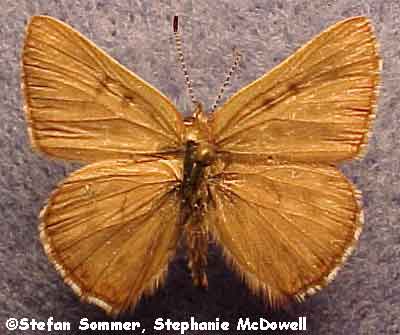
Edith’s Copper
Family: Lycaenidae
Family Description:
Note: Some authors refer to this species with the newer genus name Gaeides. Others consider it a subspecies of Lycaena xanthoides, the Gray Copper.
Description:
Caterpillar: Although records are sparse, the caterpillar is described by some sources as being green to reddish and marked with a red band along the back, and with dark legs. Its average, full-grown length is 3/4 inch.
Adult: The butterfly is small to medium-sized, with a wingspan of 1 1/8 to 1 1/4 inches. There is a very short tail or point extending from the rear of the hindwing. The male is grayish brown on the upperside. The forewing is marked with one or several faint black spots; the hindwing has a thin orange line just in from the edge. The female is grayish brown and marked with patches of yellowish beige spotted with black. The hindwing has a thick yellowish orange band along the edge. Underneath, both sexes are very light brown to grayish white. The underside of the forewing is dotted with black, while the underside of the hindwing has larger, irregularly shaped brown spots.
Range:
This species ranges from southern Alberta south through parts of the Pacific Northwest into California, and through Idaho, Montana, Wyoming, and the northern portions of Nevada, Utah, and Colorado.
Habitat:
It can be found at middle and high elevations in meadows, forest openings, and along streams.
Diet:
Caterpillar: Records are sparse, but caterpillars are reported to feed on the leaves of dock (Rumex spp.), and possibly on horkelia (Horkelia spp.) and cinquefoil (Potentilla spp.).
Adult: Butterflies drink flower nectar, often from dogbane (Apocynum spp.) and yarrow (Achillea spp.).
Ecology:
There is one generation of caterpillars each summer. Each caterpillar undergoes four stages of growth, called instars. Little else about its life cycle is known. Adults fly from June through August and can often be observed in large numbers.
Reproduction:
Males most likely perch to wait for receptive females.
Conservation:
| Global Rank: | G5; populations are widespread, abundant, and secure. |
References:
Ballmer, G. R. and G. F. Pratt. 1988. A survey of the last instar larvae of the Lycaenidae of California. Journal of Research on the Lepidoptera 27:1-81.
Ferris, C. D. and F. M. Brown. (eds.) 1981. Butterflies of the Rocky Mountain States. Univ. of Oklahoma Press, Norman, Oklahoma, USA, 442 pp.
Opler, P. A., H. Pavulaan, and R. E. Stanford. 1995. Butterflies of North America. Jamestown, North Dakota, USA: Northern Prairie Wildlife Research Center Home Page. http://www.npwrc.usgs.gov/resource/distr/lepid/bflyusa/bflyusa.htm (Version 05Nov98).
Opler, P. A. and A. B.Wright. 1999. A Field Guide to the Western Butterflies. Second Edition. Peterson Field Guide Series. Houghton Mifflin Company, New York, New York, USA, 540 pp.
Pyle, R. M. 1981. National Audubon Society Field Guide to North American Butterflies. Alfred A. Knopf, Inc., New York, New York, USA, 924 pp.
Scott, J. A. 1986. The Butterflies of North America. Stanford University Press, Stanford, California, USA, 583 pp.
Stanford, R. E. and P. A. Opler. 1993. Atlas of Western U.S.A. Butterflies (Including Adjacent Parts of Canada and Mexico). Published by authors, Denver, Colorado, USA, 275 pp.
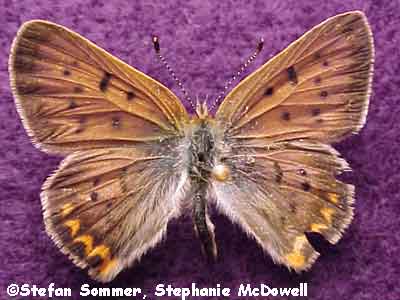
Purplish Copper
Family: Lycaenidae
Family Description:
Note: This species is referred to by the genus name Epidemia by some authors. The distinction between this species and the Dorcas Copper, Lycaena dorcas, is not clear in some locations, such as in the Rocky Mountains, where the two have been known to hybridize.
Description:
Caterpillar: The caterpillar is bright yellow when young, maturing to a bright green marked with yellow, in lengthwise stripes along the back and sides, and in diagonal dashes on the sides as well. It is covered with bumps, each bump bearing spines and hairs. It can reach a maximum length of ū inch.
Adult: This is a small to medium-sized butterfly, with a wingspan of 1 to 1 ― inches. The male is orangish brown on the upperside, with a purplish sheen. It is marked with black spots, a fairly wide dark band on the outside edges of the wings, and an orange zigzag on the rear of the hindwing. The female is brownish orange on the upperside and marked similarly; it may also have orange spots dotted with black on the hindwing. Underneath, both sexes are yellowish on the forewing and tan to gray on the hindwing. The wings are spotted with black, more heavily on the forewing. The rear of the hindwing is marked with a zigzag of orange.
Range:
This species ranges from Alaska south and east through Canada to the Great Lakes, and from the west coast of the U.S. east through northern Arizona and New Mexico north to South Dakota. It occurs throughout Idaho.
Habitat:
It utilizes a wide variety of habitats, such as disturbed areas, fields, meadows, and marshes.
Diet:
Caterpillar: Caterpillars feed on the leaves of members of the buckwheat family (Polygonaceae), including knotweed (Polygonum spp.) and docks (Rumex spp.), and on cinquefoils (Potentilla spp.).
Adult: Butterflies drink flower nectar.
Ecology:Eggs overwinter in some locations, and hatch in the spring. The number of generations of caterpillars each summer depends on the location, from only one at higher elevations and the far north to four at low elevations in California. Each caterpillar undergoes four stages of growth, called instars. Caterpillars pupate in the organic debris at the base of their host plants. Pupae or young caterpillars overwinter in a physiological state called diapause in some locations. Adults generally fly from March to November (June through August at high elevations).
Reproduction:
Males perch to wait for receptive females, or may actively patrol in search of them. Females lay pale green eggs singly at or near the bases of host plants. The eggs fade in color to white after several days. Females in the laboratory lay their eggs on host plant flowers and fruits.
Conservation:
| Global Rank: | G5; populations are widespread, abundant, and secure. |
References:
Ballmer, G. R. and G. F. Pratt. 1988. A survey of the last instar larvae of the Lycaenidae of California. Journal of Research on the Lepidoptera 27:1-81.
Coolidge, K. R. 1924. Life history of Heodes helloides. Entomological News 35:306-312.
Ferris, C. D. and F. M. Brown. (eds.) 1981. Butterflies of the Rocky Mountain States. Univ. of Oklahoma Press, Norman, Oklahoma, USA, 442 pp.
Opler, P. A., H. Pavulaan, and R. E. Stanford. 1995. Butterflies of North America. Jamestown, North Dakota, USA: Northern Prairie Wildlife Research Center Home Page. http://www.npwrc.usgs.gov/resource/distr/lepid/bflyusa/bflyusa.htm (Version 05Nov98).
Opler, P. A. and A. B.Wright. 1999. A Field Guide to the Western Butterflies. Second Edition. Peterson Field Guide Series. Houghton Mifflin Company, New York, New York, USA, 540 pp.
Pyle, R. M. 1981. National Audubon Society Field Guide to North American Butterflies. Alfred A. Knopf, Inc., New York, New York, USA, 924 pp.
Scott, J. A. 1986. The Butterflies of North America. Stanford University Press, Stanford, California, USA, 583 pp.
Stanford, R. E. and P. A. Opler. 1993. Atlas of Western U.S.A. Butterflies (Including Adjacent Parts of Canada and Mexico). Published by authors, Denver, Colorado, USA, 275 pp.
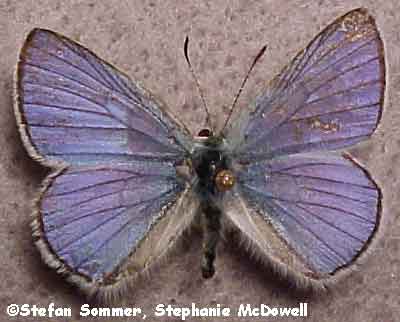
Lycaena heteronea
Blue Copper
Note: This species is referred to with the genus name Chalceria by some authors.
Family: Lycaenidae.
Idaho Status: Unprotected nongame species.
Global Rank: G5; most populations are widespread, abundant, and secure. However, subspecies clara of southern California is ranked T2, imperiled and vulnerable to extinction.
Description:
- Caterpillar: The caterpillar is light gray green and marked with very tiny white dots, giving it a frosty appearance. It is covered with silvery white, short hair. It has an average, full-grown length of 3/4 inch.
- Adult: This is a medium-sized butterfly, with a wingspan of 1 1/8 to 1 3/8 inches. The male is bright blue on the upperside, outlined in black, fringed with white, and marked with dark wing veins. Females are grayish blue to golden brown on the upperside, fringed with white and marked with dark brown spots. Underneath, both sexes are white to yellowish white and marked with black spots on the forewing and possibly on the hindwing.
Range: This species ranges from southern British Columbia south to central California and southeast to northern Arizona and New Mexico. It occurs through most of Idaho.
Habitat:
It occurs in open areas such as prairies, sagebrush steppe, and open woodlands.
Diet:
- Caterpillar: Caterpillars feed on the new leaves of a variety of buckwheats (Eriogonum spp.).
- Adult: Butterflies drink flower nectar, particularly from buckwheat flowers (Eriogonum spp.).
Ecology:
Eggs overwinter and hatch in the spring. There is one generation of caterpillars each summer. Young caterpillars feed on the undersides of leaves. Each caterpillar undergoes four stages of growth, called instars. Adults generally fly from June through August in most of its range. This species, a Copper, looks very much like the Euphilotes Blues. Both utilize buckwheats (Eriogonum spp.).
Reproduction:
Males may either perch or actively patrol in search of receptive females. Females lay white eggs singly on bracts or under leaves of host plants.
References:
Ballmer, G. R. and G. F. Pratt. 1988. A survey of the last instar larvae of the Lycaenidae of California. Journal of Research on the Lepidoptera 27:1-81.
Ferris, C. D. and F. M. Brown. (eds.) 1981. Butterflies of the Rocky Mountain States. Univ. of Oklahoma Press, Norman, Oklahoma, USA, 442 pp.
Opler, P. A., H. Pavulaan, and R. E. Stanford. 1995. Butterflies of North America. Jamestown, North Dakota, USA: Northern Prairie Wildlife Research Center Home Page. http://www.npwrc.usgs.gov/resource/distr/lepid/bflyusa/bflyusa.htm (Version 05Nov98).
Opler, P. A. and A. B.Wright. 1999. A Field Guide to the Western Butterflies. Second Edition. Peterson Field Guide Series. Houghton Mifflin Company, New York, New York, USA, 540 pp.
Pyle, R. M. 1981. National Audubon Society Field Guide to North American Butterflies. Alfred A. Knopf, Inc., New York, New York, USA, 924 pp.
Scott, J. A. 1986. The Butterflies of North America. Stanford University Press, Stanford, California, USA, 583 pp.
Stanford, R. E. and P. A. Opler. 1993. Atlas of Western U.S.A. Butterflies (Including Adjacent Parts of Canada and Mexico). Published by authors, Denver, Colorado, USA, 275 pp.
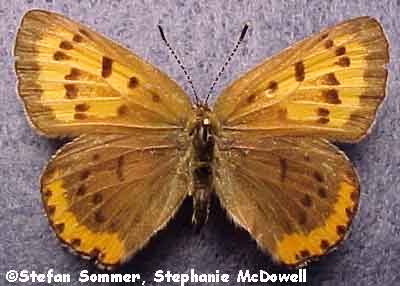
Bronze Copper
Family: Lycaenidae
Family Description:
Note: This species is referred to with the genus name Hyllolycaena by some authors.
Description:
Caterpillar: The caterpillar is yellowish green and is marked lengthwise along the back with a dark green stripe, edged in yellow.
Adult: This is a medium-sized butterfly, large for a Lycaena species, with a wingspan of 1 1/4 to 1 7/8 inches. The male is dark coppery brown on the upperside, with a purple sheen on the forewing. The hindwing is grayish brown and marked with a wide, wavy orange band along the outer edge. The female is yellowish orange on the upperside of the forewing, and marked with a brown band along the edge and dark spots; the hindwing is brown, with a yellow-orange band along the edge, and is also marked with dark spots. Both sexes are yellowish orange on the underside of the forewing, dotted with black and edged with a wide white band. The hindwing is grayish white, dotted with black, and edged with a wide orange band.
Range:
Primarily an eastern species, it ranges from Maine west across the northeastern U.S. to eastern Colorado, eastern Wyoming, most of Montana, and the central edge of Idaho. In Canada it ranges from northwestern Alberta south and east to southern Ontario.
Habitat:
It occurs in wet areas including marshes, swamps, wet meadows, and near reservoirs.
Diet:
Caterpillar: Caterpillars feed on the leaves of docks (Rumex spp.) and knotweeds (Polygonum spp.).
Adult: Butterflies drink flower nectar.
Ecology:
There are one to two generations of caterpillars each summer in the northern portion of its range, and possibly three in the south. Eggs overwinter and hatch in the spring. Adults generally fly from mid-June to October.
Reproduction:
Males perch to wait for receptive females. Females lay pale green eggs singly on the leaves, petioles, or seeds of host plants; eggs may also be laid on the dead leaves of host plants growing in water.
Conservation:
| Global Rank: | G5; populations are widespread, abundant, and secure. |
References:
Ferris, C. D. and F. M. Brown. (eds.) 1981. Butterflies of the Rocky Mountain States. Univ. of Oklahoma Press, Norman, Oklahoma, USA, 442 pp.
Opler, P. A., H. Pavulaan, and R. E. Stanford. 1995. Butterflies of North America. Jamestown, North Dakota, USA: Northern Prairie Wildlife Research Center Home Page. http://www.npwrc.usgs.gov/resource/distr/lepid/bflyusa/bflyusa.htm (Version 05Nov98).
Opler, P. A. and A. B.Wright. 1999. A Field Guide to the Western Butterflies. Second Edition. Peterson Field Guide Series. Houghton Mifflin Company, New York, New York, USA, 540 pp.
Pyle, R. M. 1981. National Audubon Society Field Guide to North American Butterflies. Alfred A. Knopf, Inc., New York, New York, USA, 924 pp.
Scott, J. A. 1986. The Butterflies of North America. Stanford University Press, Stanford, California, USA, 583 pp.
Stanford, R. E. and P. A. Opler. 1993. Atlas of Western U.S.A. Butterflies (Including Adjacent Parts of Canada and Mexico). Published by authors, Denver, Colorado, USA, 275 pp.
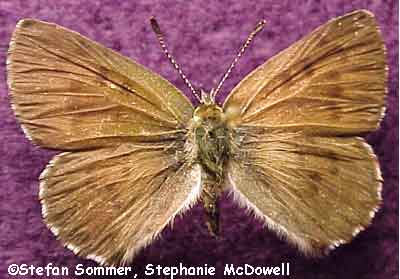
Mariposa Copper
Family: Lycaenidae
Family Description:
Alternate Common Name: Forest Copper.
Note: This species is referred to with the genus name Epidemia by some authors.
Description:
Caterpillar: The caterpillar is green and may be marked with yellow along the side. Its average, full-grown length is 5/8 inch.
Adult: The butterfly is fairly small to medium-sized, with a wingspan of 1 to 1 1/4 inches. The male is coppery brown on the upperside with a purplish sheen, and it is marked with pale brownish spots and crescents. The female is yellowish orange on the upperside of the forewings, marked with dark brown spots and light brown along the outside edge and near the body. The hindwing is mostly brown and marked with zigzag lines of yellowish orange. Underneath, both sexes are peach to grayish orange on the forewing, edged with brown and spotted with black. The underside of the hindwing is mottled grayish white to dark gray and marked with thin black crescents, curving towards the body. A very dark form is reported to occur in northern Idaho at low elevation.
Range:
This species ranges from southern Alaska south through British Columbia and Alberta, through the Pacific Northwest east to central Montana and Wyoming, and south into northcentral California. In Idaho, it occurs primarily in the northern and central sections of the state.
Habitat:
Preferred habitat includes forest bogs and openings.
Diet:
Caterpillar: While records are sparse, it is thought that caterpillars feed on certain members of the heath family (Ericaceae), such as huckleberry (Vaccinium spp.) or on plants belonging to the buckwheat family (Polygonaceae).
Adult: Butterflies drink flower nectar.
Ecology:
Eggs overwinter and hatch in the spring, and the resulting brood of caterpillars is the only one each year. Each caterpillar undergoes four stages of growth, called instars. Adults generally fly from July through September. It is not uncommon to observe large numbers of adults in a given area. The word "mariposa" is Spanish for "butterfly."
Reproduction:
Males perch to wait for receptive females. The typical locations of oviposition are unreported.
Conservation:
| Global Rank: | G5; populations are widespread, abundant, and secure. |
References:
Ballmer, G. R. and G. F. Pratt. 1988. A survey of the last instar larvae of the Lycaenidae of California. Journal of Research on the Lepidoptera 27:1-81.
Ferris, C. D. and F. M. Brown. (eds.) 1981. Butterflies of the Rocky Mountain States. Univ. of Oklahoma Press, Norman, Oklahoma, USA, 442 pp.
Opler, P. A., H. Pavulaan, and R. E. Stanford. 1995. Butterflies of North America. Jamestown, North Dakota, USA: Northern Prairie Wildlife Research Center Home Page. http://www.npwrc.usgs.gov/resource/distr/lepid/bflyusa/bflyusa.htm (Version 05Nov98).
Opler, P. A. and A. B.Wright. 1999. A Field Guide to the Western Butterflies. Second Edition. Peterson Field Guide Series. Houghton Mifflin Company, New York, New York, USA, 540 pp.
Pyle, R. M. 1981. National Audubon Society Field Guide to North American Butterflies. Alfred A. Knopf, Inc., New York, New York, USA, 924 pp.
Scott, J. A. 1986. The Butterflies of North America. Stanford University Press, Stanford, California, USA, 583 pp.
Stanford, R. E. and P. A. Opler. 1993. Atlas of Western U.S.A. Butterflies (Including Adjacent Parts of Canada and Mexico). Published by authors, Denver, Colorado, USA, 275 pp.
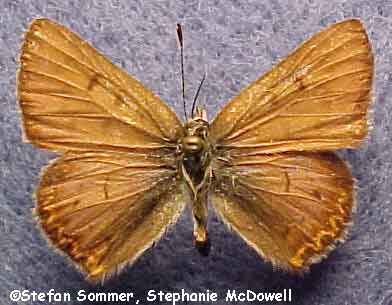
Lilac-Bordered Copper
Family: Lycaenidae
Family Description:
Alternate Common Names:Nivalis Copper, Snowy Copper.
Note: This species is referred to with the genus name Epidemia by some authors.
Description:
Caterpillar: The caterpillar is pale green and marked lengthwise with a red stripe along the back, edged on both sides with white. The back has many tiny white bumps, and the body is covered with brownish hair. The caterpillar has an average, full-grown length of 3/4 inch.
Adult: This is a fairly small to medium-sized butterfly, with a wingspan of 1 to 1 3/8 inches. The male is coppery orange on the upperside with a purplish sheen. The wings are spotted with brown, and the hindwing has a bright orange band along the outer edge. The female is brown to orange on the upperside and marked with dark brown spots. The forewing is edged with a wide brown band; the hindwing is edged with orange. Underneath, both sexes are yellowish to cream on the forewing and marked with dark spots. The underside of the hindwing is yellowish on the inner portion and lilac to mauve on the outer portion. It may be spotted with black and marked with a curved line of small orange dots or chevrons along the outer edge. It should be noted that the butterfly dulls in its appearance quickly after emergence as it loses its scales. Individuals that are over one week old may appear brown to gray and quite drab.
Range:
This species ranges from southern British Columbia south through the Pacific Northwest to central California and northern Nevada, and east to western Montana, and parts of Wyoming, Utah, and Colorado. It occurs through much of Idaho.
Habitat:
It can be found in open areas such as sagebrush steppe, meadows, forest openings, and rocky outcrops.
Diet:
Caterpillar: Caterpillars feed on the leaves of Douglas’ knotweed (Polygonum douglasii).
Adult: Butterflies drink flower nectar.
Ecology:
Eggs overwinter and hatch in the spring, and the resulting brood of caterpillars is the only generation for the given year. Each caterpillar undergoes four stages of growth, called instars. Adults generally fly from June through September or October. These butterflies are swift fliers.
Reproduction:
Males perch to wait for receptive females. Females lay eggs singly at or near the base of host plants.
Conservation:
| Global Rank: | G5; populations are widespread, abundant, and secure. |
References:
Ballmer, G. R. and G. F. Pratt. 1988. A survey of the last instar larvae of the Lycaenidae of California. Journal of Research on the Lepidoptera 27:1-81.
Ferris, C. D. and F. M. Brown. (eds.) 1981. Butterflies of the Rocky Mountain States. Univ. of Oklahoma Press, Norman, Oklahoma, USA, 442 pp.
Opler, P. A., H. Pavulaan, and R. E. Stanford. 1995. Butterflies of North America. Jamestown, North Dakota, USA: Northern Prairie Wildlife Research Center Home Page. http://www.npwrc.usgs.gov/resource/distr/lepid/bflyusa/bflyusa.htm (Version 05Nov98).
Opler, P. A. and A. B.Wright. 1999. A Field Guide to the Western Butterflies. Second Edition. Peterson Field Guide Series. Houghton Mifflin Company, New York, New York, USA, 540 pp.
Pyle, R. M. 1981. National Audubon Society Field Guide to North American Butterflies. Alfred A. Knopf, Inc., New York, New York, USA, 924 pp.
Scott, J. A. 1986. The Butterflies of North America. Stanford University Press, Stanford, California, USA, 583 pp.
Stanford, R. E. and P. A. Opler. 1993. Atlas of Western U.S.A. Butterflies (Including Adjacent Parts of Canada and Mexico). Published by authors, Denver, Colorado, USA, 275 pp.
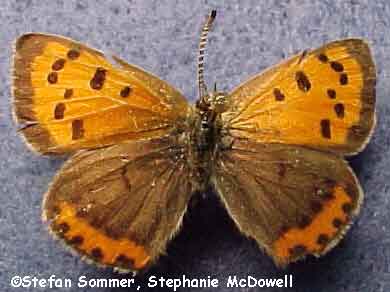
American Copper
Family: Lycaenidae
Family Description:
Alternate Common Names:Flame Copper, Small Copper.
Description:
Caterpillar: The caterpillar varies in color. It can be either reddish with yellow shading on the sides, or light to yellowish green and possibly marked with red on the back or sides. The body is covered with downy hair. It reaches an average, full-grown length of 3/4 inch.
Adult: This is a fairly small to medium-sized butterfly, with a wingspan of 7/8 to 1 3/8 inches. Its upperside is two-toned: the forewing is orangish red, spotted with dark brown, and edged with a wide brown band. The hindwing is brown to gray with a orangish red band just in from the outer bottom edge. Underneath, the forewing is orange, spotted with black, and edged with gray. The underside of the hindwing is grayish white, dotted with black, and marked with a thin, curved, jagged orange line just in from the edge.
Range:
Primarily an introduced eastern species, it ranges from Nova Scotia south to Georgia, and east to Minnesota and the Dakotas south to Arkansas. It also occurs as a native in patches of arctic Canada, in northern Alaska south and west to British Columbia and Alberta, and in patches of the Rockies. It has been documented in Idaho in Lemhi County.
Habitat:
In the east it can be found in open or disturbed areas, including pastures, fields, and landfills; in the west it occurs in rocky alpine places or arctic tundra.
Diet:
Caterpillar: In the east, caterpillars feed on the leaves of sheep sorrel (Rumex acetosella) and curly dock (R. crispus); in the west, caterpillars feed primarily on mountain sorrel (Oxyria digyna).
Adult: Butterflies drink flower nectar.
Ecology:
The number of generations of caterpillars each summer depends on the location, with three or four in the south, two in the north, and one in alpine and arctic areas. Each caterpillar undergoes four to five stages of growth, called instars. Either caterpillars or pupae overwinter in a physiological state called diapause. Adults generally fly from May through September in most of its range, and from July through August in the western and arctic parts of its range. These butterflies have been known to be aggressive, chasing almost anything passing by.
Reproduction:
Males perch to wait for receptive females. Females lay ribbed, pale green eggs singly on the leaves or stems of host plants.
Conservation:
| Global Rank: | G5; populations are widespread, abundant, and secure. |
References:
Ballmer, G. R. and G. F. Pratt. 1988. A survey of the last instar larvae of the Lycaenidae of California. Journal of Research on the Lepidoptera 27:1-81.
Ferris, C. D. and F. M. Brown. (eds.) 1981. Butterflies of the Rocky Mountain States. Univ. of Oklahoma Press, Norman, Oklahoma, USA, 442 pp.
Opler, P. A., H. Pavulaan, and R. E. Stanford. 1995. Butterflies of North America. Jamestown, North Dakota, USA: Northern Prairie Wildlife Research Center Home Page. http://www.npwrc.usgs.gov/resource/distr/lepid/bflyusa/bflyusa.htm (Version 05Nov98).
Opler, P. A. and A. B.Wright. 1999. A Field Guide to the Western Butterflies. Second Edition. Peterson Field Guide Series. Houghton Mifflin Company, New York, New York, USA, 540 pp.
Pyle, R. M. 1981. National Audubon Society Field Guide to North American Butterflies. Alfred A. Knopf, Inc., New York, New York, USA, 924 pp.
Scott, J. A. 1986. The Butterflies of North America. Stanford University Press, Stanford, California, USA, 583 pp.
Stanford, R. E. and P. A. Opler. 1993. Atlas of Western U.S.A. Butterflies (Including Adjacent Parts of Canada and Mexico). Published by authors, Denver, Colorado, USA, 275 pp.
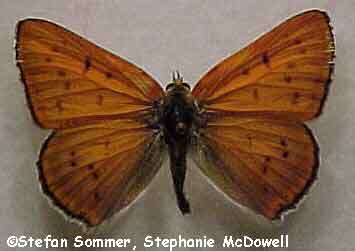
Ruddy Copper
Family: Lycaenidae
Family Description:
Note: This species is listed with the genus name Chalceria by some authors. Ferris’ Copper (Lycaena ferrisi), previously included as a subspecies of L. rubidus, is a newly described species nearly identical in appearance and ecology to the Ruddy Copper, and occurs only in the White Mountains of Arizona and New Mexico.
Description:
Caterpillar: The caterpillar is brown and marked lengthwise with dark red and yellow along the back. It can reach an average, full-grown length of 3/4 inch.
Adult: This is a medium-sized butterfly, with a wingspan of 1 1/8 to 1 5/8 inches. The male is bright coppery orange on the upperside, lightly marked with dark spots and edged thinly in black. The female varies in color from golden yellow to dark brown clouded with yellow; the wings are marked with dark spots, and the hindwing has a golden yellow wavy band just in from the edge. Underneath, both sexes are yellowish gray to grayish white. The underside of the forewing is spotted with black while the underside of the hindwing may be unmarked or lightly dotted with black.
Range:
This species ranges from southern British Columbia and Alberta south through the northwestern U.S. to central California, eastern Arizona, and northern New Mexico, and east as far as western North and South Dakota and Nebraska. It occurs through much of Idaho.
Habitat:
It occurs in open areas such as sagebrush steppe, prairies, fields, and along streams.
Diet:
Caterpillar: Caterpillars feed on various species of dock (Rumex spp.).
Adult: Butterflies drink flower nectar, most frequently from shrubby cinquefoil (Potentilla fruticosa).
Ecology:
Eggs overwinter and hatch in the spring, and the resulting brood is the only generation of caterpillars each summer. Each caterpillar undergoes four stages of growth, called instars. Adults generally fly from the end of May to the beginning of September. Butterflies are swift fliers, and may pursue each other.
Reproduction:
Males perch to wait for receptive females. Females lay eggs singly at or near the bases of host plants.
Conservation:
| Global Rank: | G5; most populations are widespread, abundant, and secure. Ferris’ Copper, however, is ranked T1, which means it is critically imperiled because of extreme rarity and is imminently vulnerable to extinction. |
References:
Ballmer, G. R. and G. F. Pratt. 1988. A survey of the last instar larvae of the Lycaenidae of California. Journal of Research on the Lepidoptera 27:1-81.
Ferris, C. D. and F. M. Brown. (eds.) 1981. Butterflies of the Rocky Mountain States. Univ. of Oklahoma Press, Norman, Oklahoma, USA, 442 pp.
Opler, P. A., H. Pavulaan, and R. E. Stanford. 1995. Butterflies of North America. Jamestown, North Dakota, USA: Northern Prairie Wildlife Research Center Home Page. http://www.npwrc.usgs.gov/resource/distr/lepid/bflyusa/bflyusa.htm (Version 05Nov98).
Opler, P. A. and A. B.Wright. 1999. A Field Guide to the Western Butterflies. Second Edition. Peterson Field Guide Series. Houghton Mifflin Company, New York, New York, USA, 540 pp.
Pyle, R. M. 1981. National Audubon Society Field Guide to North American Butterflies. Alfred A. Knopf, Inc., New York, New York, USA, 924 pp.
Scott, J. A. 1986. The Butterflies of North America. Stanford University Press, Stanford, California, USA, 583 pp.
Stanford, R. E. and P. A. Opler. 1993. Atlas of Western U.S.A. Butterflies (Including Adjacent Parts of Canada and Mexico). Published by authors, Denver, Colorado, USA, 275 pp.

Brown Elfin
Family: Lycaenidae
Family Description:
Note: Some authors refer to this species as Callophrys augustus.
Description:
Caterpillar: Caterpillars vary in color geographically and with age. Generally, young caterpillars are yellowish and darken to green with each successive molt. Those in the west are light to brownish green and marked with whitish yellow and red on the sides; the marks may appear as bands encircling the body. Eastern caterpillars may be more yellow or yellowish green and may be marked with yellow and white. The average, full-grown length is 1/2 inch.
Adult: This is a small butterfly, with a wingspan of 3/4 to 1 1/8 inches. It is brown to grayish on the upperside, sometimes with orangish shading, especially in females. Underneath is brown, possibly reddish, with the base of the hindwing noticeably darker. There is a faint, wavy solid line and possibly a line of faint dots spanning the underside of both the fore- and hindwing.
Range:
This is the most common species of Elfin. It ranges from central Alaska across most of south central and eastern Canada; from Minnesota east to the Atlantic coast, extending south to northern Georgia; in the Pacific Northwest south through California; and in patches of the Rocky Mountain states and the southwest. In Idaho, it occurs through much of the state.
Habitat:
It occurs in an array of habitats, including forests, bogs, chaparral, and deserts.
Diet:
Caterpillar: Caterpillars eat flowers, fruits, and occasionally leaves from a variety of plants, such as blueberry (Vaccinium spp.), bearberry (Arctostaphylos spp.), buck brush (Ceanothus spp.), and madrone (Arbutus spp.).
Adult: Butterflies drink flower nectar, often from plants of the heath family (Ericaceae).
Ecology:
There is only one generation of caterpillars each summer. Each caterpillar experiences four stages of growth, called instars. The caterpillar is equipped with a honey gland, also known as a dorsal nectary organ, which emits a sugary solution agreeable to ants. The ants feed on the solution and in turn protect the caterpillar from predators. Pupae overwinter in a physiological state called diapause; chrysalises are often in the leaf litter at the base of host plants. Adults generally fly from April through July in the northern part of its range, and from mid-March to early June in the southern part of its range. This is the most common elfin species in North America.
Reproduction:
Males perch to wait for receptive females. Females lay green eggs singly on the flowers and flower buds of host plants.
Conservation:
| Global Rank: | G5 populations are widespread, abundant, and secure. |
References:
Ballmer, G. R. and G. F. Pratt. 1988. A survey of the last instar larvae of the Lycaenidae of California. Journal of Research on the Lepidoptera 27:1-81.
Ferris, C. D. and F. M. Brown. (eds.) 1981. Butterflies of the Rocky Mountain States. Univ. of Oklahoma Press, Norman, Oklahoma, USA, 442 pp.
Opler, P. A., H. Pavulaan, and R. E. Stanford. 1995. Butterflies of North America. Jamestown, North Dakota, USA: Northern Prairie Wildlife Research Center Home Page. http://www.npwrc.usgs.gov/resource/distr/lepid/bflyusa/bflyusa.htm (Version 05Nov98).
Opler, P. A. and A. B.Wright. 1999. A Field Guide to the Western Butterflies. Second Edition. Peterson Field Guide Series. Houghton Mifflin Company, New York, New York, USA, 540 pp.
Pyle, R. M. 1981. National Audubon Society Field Guide to North American Butterflies. Alfred A. Knopf, Inc., New York, New York, USA, 924 pp.
Scott, J. A. 1986. The Butterflies of North America. Stanford University Press, Stanford, California, USA, 583 pp.
Stanford, R. E. and P. A. Opler. 1993. Atlas of Western U.S.A. Butterflies (Including Adjacent Parts of Canada and Mexico). Published by authors, Denver, Colorado, USA, 275 pp.
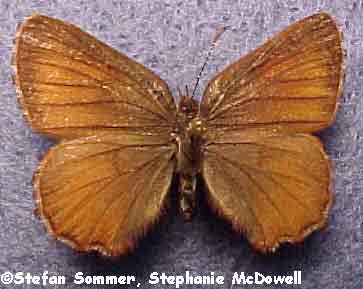
Western Pine Elfin
Family: Lycaenidae
Family Description:
Description:
Caterpillar: The caterpillar is dark green and striped lengthwise with yellowish white lines. It has an average, full-grown length of approximately 3/4 inch.
Adult: The butterfly is small, with a wingspan of 3/4 to 1 3/8 inches. It is brown to reddish brown on the upperside. Underneath, the forewing is tan and marked with two dark bars on the interior of the wing, an uneven, brown and white line down the center, and a line of black ">"-shaped marks just in from the edge. The hindwing is grayish brown and heavily marked with jagged black and dark brown lines. There is a curved row of black ">"-shaped marks just in from the edge. The fringes of the wings have a checkered appearance.
Range:
This species ranges from British Columbia and Alberta south through the western third of the U.S., and from northern Saskatchewan east and south to Maine. It occurs through most of Idaho.
Habitat:
It occurs, as its name implies, in and near evergreen forests.
Diet:
Caterpillar: Caterpillars feed on the new needles and male cones of pines (Pinus spp.), western hemlock (Tsuga heterophylla), and western red cedar (Thuja plicata).
Adult: Butterflies drink flower nectar.
Ecology:
Caterpillars bore into the bases of needles and male cones. There is one generation of caterpillars each summer. Each undergoes four stages of growth, called instars. The caterpillar is equipped with a honey gland, also known as a dorsal nectary organ, which emits a sugary solution agreeable to ants. The ants feed on the solution and in turn protect the caterpillar from predators. Pupae overwinter in a physiological state called diapause; adult butterflies emerge in the spring. They generally fly from April to mid-July, and occasionally can be seen until September.
Reproduction:
Males perch to wait for receptive females. Females lay white eggs singly at the base of needles.
Conservation:
| Global Rank: | G5 populations are widespread, abundant, and secure. |
References:
Ballmer, G. R. and G. F. Pratt. 1988. A survey of the last instar larvae of the Lycaenidae of California. Journal of Research on the Lepidoptera 27:1-81.
Ferris, C. D. and F. M. Brown. (eds.) 1981. Butterflies of the Rocky Mountain States. Univ. of Oklahoma Press, Norman, Oklahoma, USA, 442 pp.
Opler, P. A., H. Pavulaan, and R. E. Stanford. 1995. Butterflies of North America. Jamestown, North Dakota, USA: Northern Prairie Wildlife Research Center Home Page. http://www.npwrc.usgs.gov/resource/distr/lepid/bflyusa/bflyusa.htm (Version 05Nov98).
Opler, P. A. and A. B.Wright. 1999. A Field Guide to the Western Butterflies. Second Edition. Peterson Field Guide Series. Houghton Mifflin Company, New York, New York, USA, 540 pp.
Pyle, R. M. 1981. National Audubon Society Field Guide to North American Butterflies. Alfred A. Knopf, Inc., New York, New York, USA, 924 pp.
Scott, J. A. 1986. The Butterflies of North America. Stanford University Press, Stanford, California, USA, 583 pp.
Stanford, R. E. and P. A. Opler. 1993. Atlas of Western U.S.A. Butterflies (Including Adjacent Parts of Canada and Mexico). Published by authors, Denver, Colorado, USA, 275 pp.
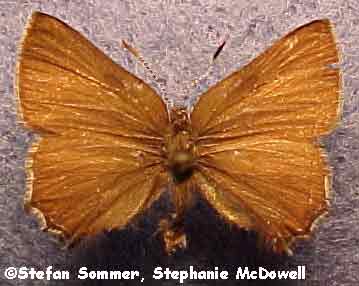
Moss' Elfin
Family: Lycaenidae
Family Description:
Alternate Common Name: Stonecrop Elfin.
Description:
Caterpillar: The caterpillars are generally reddish or pinkish in color, but may be yellow or green; they are covered with short brownish hair. Markings may include two reddish bands along the back and whitish diagonal dashes on the sides. The average, full-grown length is 3/4 inches.
Adult: This is a small butterfly, with a wingspan of 7/8 to 1 1/8 inches. The male is gray to brown on the upperside, and may be marked with a rust patch on the hindwing. The female is light to reddish brown, and may be outlined in dark brown along the edges. Underneath varies in color from red brown to purple brown to light brown. The underside of the hindwing is typically darker where it attaches to the body. Underside markings include a vertical wavy line running across both the fore-and hindwings, followed by a gray to white band and a row of black dots.
Range:
This species occurs in patches of British Columbia south to southern California and Arizona, and east through the Intermountain West. In Idaho, it has been documented to occur in patches of the western third of the state.
Habitat:
It occurs in canyons, rocky slopes, and sagebrush steppe.
Diet:
Caterpillar: Caterpillars eat the leaves, flowers, and fruits of members of the stonecrop family (Crassulaceae), including various species of Sedum, Dudleya, and Parvisedum.
Adult: Butterflies presumably drink flower nectar, but the adult food has not been reported in the literature.
Ecology:
Young caterpillars feed preferentially on leaves while older caterpillars feed on flowers and fruits. There is one generation of caterpillars each summer. Each undergoes four stages of growth, called instars. The caterpillar is equipped with a honey gland, also known as a dorsal nectary organ, which emits a sugary solution agreeable to ants. The ants feed on the solution and in turn protect the caterpillar from predators. Pupae overwinter in a physiological state called diapause. Adults generally fly from the end of February through May.
Reproduction:
Males perch to wait for receptive females. Females lay pale bluish green eggs on the underside of the leaves of host plants. The eggs turn white before hatching.
Conservation:
| Global Rank: | G5; most populations are widespread, abundant, and secure. One subspecies in California, C. mossii bayensis, is listed as T1, which means it is critically imperiled because of extreme rarity and is imminently vulnerable to extinction. |
References:
Ballmer, G. R. and G. F. Pratt. 1988. A survey of the last instar larvae of the Lycaenidae of California. Journal of Research on the Lepidoptera 27:1-81.
Ferris, C. D. and F. M. Brown. (eds.) 1981. Butterflies of the Rocky Mountain States. Univ. of Oklahoma Press, Norman, Oklahoma, USA, 442 pp.
Opler, P. A., H. Pavulaan, and R. E. Stanford. 1995. Butterflies of North America. Jamestown, North Dakota, USA: Northern Prairie Wildlife Research Center Home Page. http://www.npwrc.usgs.gov/resource/distr/lepid/bflyusa/bflyusa.htm (Version 05Nov98).
Opler, P. A. and A. B.Wright. 1999. A Field Guide to the Western Butterflies. Second Edition. Peterson Field Guide Series. Houghton Mifflin Company, New York, New York, USA, 540 pp.
Pyle, R. M. 1981. National Audubon Society Field Guide to North American Butterflies. Alfred A. Knopf, Inc., New York, New York, USA, 924 pp.
Scott, J. A. 1986. The Butterflies of North America. Stanford University Press, Stanford, California, USA, 583 pp.
Stanford, R. E. and P. A. Opler. 1993. Atlas of Western U.S.A. Butterflies (Including Adjacent Parts of Canada and Mexico). Published by authors, Denver, Colorado, USA, 275 pp.
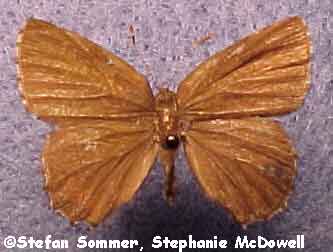
Hoary Elfin
Family: Lycaenidae
Family Description:
Description:
Caterpillar: The caterpillar is pinkish to yellow when young and bright green when older. It is marked with a greenish line along the length of the back, faint diagonal dashes on the sides, and a white star on the back behind the head. It can reach a maximum length of 1/2 inch.
Adult: The butterfly is small, with a wingspan of 3/4 to 1 1/8 inches. It is grayish orange-brown on the upperside and unmarked. Underneath is brownish, with the interior portion of the hindwing noticeably darker. The underside of the forewing appears to be dusted with white along the outside edge, and is marked with a wavy line and a faint row of blackish dots. The outer half of the underside of the hindwing also appears dusted with white.
Range:
This species ranges from central Alaska south and east across Canada to Nova Scotia, south through the northeastern U.S. to Virginia; through the Great Lakes states; and in the western U.S. along the northern Pacific coast, in parts of Idaho, Montana, and south to New Mexico in patches.
Habitat:
It typically occurs in open dry areas such as rocky slopes and dunes; however, it is also occasionally found near forest bogs. Generally it is at sea level except in the Rocky Mountains where it is typically found above 8000 feet elevation.
Diet:
Caterpillar: Caterpillars feed on bearberry (Arctostaphylos uva-ursi) and trailing arbutus (Epigaea repens).
Adult: Butterflies drink flower nectar.
Ecology:
There is one generation of caterpillars each summer; their coloring provides good camouflage when they are on the flowers of host plants. Pupae overwinter in a physiological state called diapause. Adults generally fly from April through May, occasionally into July.
Reproduction:
Males perch on host plants to wait for receptive females. Females lay eggs singly at the bases of leaf buds or flowers of host plants.
Conservation:
| Global Rank: | G5; populations are widespread, abundant, and secure. |
References:
Ferris, C. D. and F. M. Brown. (eds.) 1981. Butterflies of the Rocky Mountain States. Univ. of Oklahoma Press, Norman, Oklahoma, USA, 442 pp.
Opler, P. A., H. Pavulaan, and R. E. Stanford. 1995. Butterflies of North America. Jamestown, North Dakota, USA: Northern Prairie Wildlife Research Center Home Page. http://www.npwrc.usgs.gov/resource/distr/lepid/bflyusa/bflyusa.htm (Version 05Nov98).
Opler, P. A. and A. B.Wright. 1999. A Field Guide to the Western Butterflies. Second Edition. Peterson Field Guide Series. Houghton Mifflin Company, New York, New York, USA, 540 pp.
Pyle, R. M. 1981. National Audubon Society Field Guide to North American Butterflies. Alfred A. Knopf, Inc., New York, New York, USA, 924 pp.
Scott, J. A. 1986. The Butterflies of North America. Stanford University Press, Stanford, California, USA, 583 pp.
Stanford, R. E. and P. A. Opler. 1993. Atlas of Western U.S.A. Butterflies (Including Adjacent Parts of Canada and Mexico). Published by authors, Denver, Colorado, USA, 275 pp.
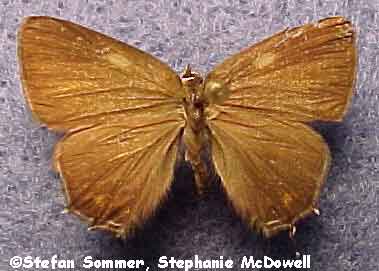
Juniper Hairstreak
Family: Lycaenidae
Family Description:
Alternate Common Names:Cedar Hairstreak, Olive Hairstreak.
Note: This species includes several subspecies such as barryi and loki. The delineation between this species and Callophrys [Mitoura] siva are debated by scientists.
Description:
Caterpillar: The caterpillar is green and marked along each side with white or yellow diagonal dashes.
Adult: The butterfly is small, with a wingspan of 7/8 to 1 1/16 inches, and has a thin "tail" extending from the hindwing. Typically, the male is dark brown on the upperside and possibly tinged with orangish to golden brown. The female is brown to golden brown on the upperside. Underneath, both sexes are most commonly bright to yellowish green, though in some populations the underside may be brownish. The underside of the forewing is marked with a vertical line of connected white dashes, edged towards the inside with brown. The underside of the hindwing is marked two white dashes or spots near the base of the wing, and a wavy, vertical white line down the center. The spots and the wavy line may be edged with reddish brown on one side. The outer edge of the underside of the hindwing may have several black spots, a white edging, and a faint orangish spot on a clouded region of blue near the tail.
Range:
This species ranges from southern British Columbia south to southern California, throughout the western and southwestern U.S., extending east to the east coast but absent from both the extreme northern and southern edges of the U.S. It occurs throughout Idaho.
Habitat:
It occurs in forests and open woodlands.
Diet:
Caterpillar: Caterpillars feed on the tips of foliage of eastern red cedar and juniper belonging to the genus Juniperus.
Adult: Butterflies drink flower nectar.
Ecology:
There is one to two generations of caterpillars each summer. Each undergoes five to seven stages of growth, called instars. The caterpillar is equipped with a honey gland, also known as a dorsal nectary organ, which emits a sugary solution agreeable to ants. The ants feed on the solution and in turn protect the caterpillar from predators. The caterpillars are colored in such a way that they mimic the foliage tips of their host plant. Pupae overwinter in a physiological state called diapause. Adults generally fly from May to August. The thin "tail" on each of the hindwings of adults is thought to mimic insect antennae and thus misleads bird predators into biting at the wrong end and only getting a mouthful of wing, while the butterfly escapes in the other direction.
Reproduction:
Males perch in host trees to wait for receptive females. Eggs are laid singly on the tips of host plant foliage.
Conservation:
| Global Rank: | G5 populations levels are secure, but may be of concern in the future. |
References:
Ballmer, G. R. and G. F. Pratt. 1988. A survey of the last instar larvae of the Lycaenidae of California. Journal of Research on the Lepidoptera 27:1-81.
Ferris, C. D. and F. M. Brown. (eds.) 1981. Butterflies of the Rocky Mountain States. Univ. of Oklahoma Press, Norman, Oklahoma, USA, 442 pp.
Opler, P. A., H. Pavulaan, and R. E. Stanford. 1995. Butterflies of North America. Jamestown, North Dakota, USA: Northern Prairie Wildlife Research Center Home Page. http://www.npwrc.usgs.gov/resource/distr/lepid/bflyusa/bflyusa.htm (Version 05Nov98).
Opler, P. A. and A. B.Wright. 1999. A Field Guide to the Western Butterflies. Second Edition. Peterson Field Guide Series. Houghton Mifflin Company, New York, New York, USA, 540 pp.
Pyle, R. M. 1981. National Audubon Society Field Guide to North American Butterflies. Alfred A. Knopf, Inc., New York, New York, USA, 924 pp.
Scott, J. A. 1986. The Butterflies of North America. Stanford University Press, Stanford, California, USA, 583 pp.
Stanford, R. E. and P. A. Opler. 1993. Atlas of Western U.S.A. Butterflies (Including Adjacent Parts of Canada and Mexico). Published by authors, Denver, Colorado, USA, 275 pp.
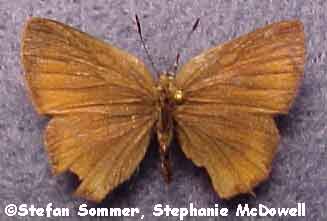
Nelson’s Hairstreak
Family: Lycaenidae
Family Description:
Alternate Common Names:Cedar Hairstreak, Olive Hairstreak.
Note: Some authors consider this species to be a complex of several species or subspecies.
Description:
Caterpillar: The caterpillars generally are green, marked with yellow or white, and appear bumpy. The average, full-grown length is 5/8 inch.
Adult: The butterfly is small, with a wingspan of 7/8 to 1 1/16 inches, and has a thin "tail" extending from the hindwing. Typically, the male is dark grayish to orangish brown on the upperside and marked with rust brown spots. The female is rust to brown on the upperside, with darker brown near the body and along the wings’ edges. Underneath, both sexes are typically light brown to orangish brown, possibly tinged with pink or purple. Many individuals are marked on the underside of one or both wings with an irregular, thin white line. Additionally, the underside of the hindwing may be spotted with orange, blue, or black near the tail.
Range:
This species ranges from southern British Columbia south through most of Washington and part of northern Idaho, through the Cascades of Oregon and into California.
Habitat:
It occurs in coniferous forests.
Diet:
Caterpillar: Caterpillars feed on incense cedar (Calocedrus decurrens) and western red cedar (Thuja plicata).
Adult: Butterflies drink flower nectar.
Ecology:
There is only one generation of caterpillars each summer. Each undergoes five to seven stages of growth, called instars. The caterpillar is equipped with a honey gland, also known as a dorsal nectary organ, which emits a sugary solution agreeable to ants. The ants feed on the solution and in turn protect the caterpillar from predators. The caterpillars are colored in such a way that they mimic the foliage tips of their host plant. Pupae overwinter in a physiological state called diapause. Adults generally fly from May through July. The thin "tail" on each of the hindwings of adults is thought to mimic insect antennae and thus misleads bird predators into biting at the wrong end and only getting a mouthful of wing, while the butterfly escapes in the other direction.
Reproduction:
Although not officially reported, males are thought to perch to wait for receptive females. Eggs are laid singly on the tips of host plant foliage.
Conservation:
| Global Rank: | G5; Population levels are secure, but may be of concern in the future. |
References:
Ballmer, G. R. and G. F. Pratt. 1988. A survey of the last instar larvae of the Lycaenidae of California. Journal of Research on the Lepidoptera 27:1-81.
Ferris, C. D. and F. M. Brown. (eds.) 1981. Butterflies of the Rocky Mountain States. Univ. of Oklahoma Press, Norman, Oklahoma, USA, 442 pp.
Opler, P. A., H. Pavulaan, and R. E. Stanford. 1995. Butterflies of North America. Jamestown, North Dakota, USA: Northern Prairie Wildlife Research Center Home Page. http://www.npwrc.usgs.gov/resource/distr/lepid/bflyusa/bflyusa.htm (Version 05Nov98).
Opler, P. A. and A. B.Wright. 1999. A Field Guide to the Western Butterflies. Second Edition. Peterson Field Guide Series. Houghton Mifflin Company, New York, New York, USA, 540 pp.
Pyle, R. M. 1981. National Audubon Society Field Guide to North American Butterflies. Alfred A. Knopf, Inc., New York, New York, USA, 924 pp.
Scott, J. A. 1986. The Butterflies of North America. Stanford University Press, Stanford, California, USA, 583 pp.
Stanford, R. E. and P. A. Opler. 1993. Atlas of Western U.S.A. Butterflies (Including Adjacent Parts of Canada and Mexico). Published by authors, Denver, Colorado, USA, 275 pp.
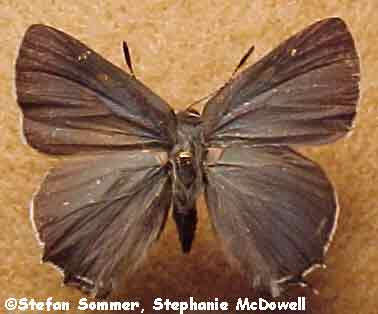
Thicket Hairstreak
Family: Lycaenidae
Family Description:
Alternate Common Name: Blue Mistletoe Hairstreak.
Note: This species includes a subspecies, millerorum, which occurs in Mexico.
Description:
Caterpillar: The caterpillar varies in appearance, but generally is green with a lighter band of brownish green along the back. The body is "bumpy," and the bumps are colored reddish orange to brown and edged with white. The sides are striped lengthwise with white. Caterpillars may also be mostly green or red; they tend to match the color of their host plant. The average, full-grown length is 7/8 inch.
Adult: This is a fairly small butterfly, with a wingspan of 1 to 1 ¼ inches. The upperside is grayish blue with no noticeable markings. The underside is reddish to grayish brown and is marked by a thin, white line, edged towards the inside with black, which spans both the fore- and hindwing. On the hindwing, the line becomes wavy, forming a "W", near the bottommost edge. Additionally marking the underside, there is a curved row of black dots near the edge of the hindwing. As with most hairstreaks, a thin "tail" extends from the hindwing.
Range:
This species ranges from southern British Columbia and Alberta south to southern California and into Mexico. In the U.S., it extends as far east as Colorado and New Mexico. It occurs through much of Idaho, but predominantly in the central portion of the state.
Habitat:
Typical habitat includes coniferous and mixed forests and desert canyons.
Diet:
Caterpillar: Caterpillars feed on the external parts of dwarf mistletoes (Arceuthobium spp.), a parasitic plant that lives on a variety of conifers.
Adult: Butterflies drink flower nectar, often from flowers belonging to the sunflower family (Asteraceae).
Ecology:
There is one generation of caterpillars through most of its range while there may be several in the south. Each undergoes five stages of growth, called instars. The caterpillar is equipped with a honey gland, also known as a dorsal nectary organ, which emits a sugary solution agreeable to ants. The ants feed on the solution and in turn protect the caterpillar from predators. Pupae overwinter in a physiological state called diapause in the mass of plant growth of the host tree, caused by the mistletoe’s presence. Adults generaly fly from March through October, with most adults in the northern part of its range appearing in June. The thin "tail" on each of the hindwings of adults is thought to mimic insect antennae and thus misleads bird predators into biting at the wrong end and only getting a mouthful of wing, while the butterfly escapes in the other direction.
Reproduction:
Males perch to wait for receptive females. Females lay eggs singly on mistletoes.
Conservation:
| Global Rank: | G5; populations are widespread, abundant, and secure. |
References:
Ballmer, G. R. and G. F. Pratt. 1988. A survey of the last instar larvae of the Lycaenidae of California. Journal of Research on the Lepidoptera 27:1-81.
Ferris, C. D. and F. M. Brown. (eds.) 1981. Butterflies of the Rocky Mountain States. Univ. of Oklahoma Press, Norman, Oklahoma, USA, 442 pp.
Opler, P. A., H. Pavulaan, and R. E. Stanford. 1995. Butterflies of North America. Jamestown, North Dakota, USA: Northern Prairie Wildlife Research Center Home Page. http://www.npwrc.usgs.gov/resource/distr/lepid/bflyusa/bflyusa.htm (Version 05Nov98).
Opler, P. A. and A. B.Wright. 1999. A Field Guide to the Western Butterflies. Second Edition. Peterson Field Guide Series. Houghton Mifflin Company, New York, New York, USA, 540 pp.
Pyle, R. M. 1981. National Audubon Society Field Guide to North American Butterflies. Alfred A. Knopf, Inc., New York, New York, USA, 924 pp.
Scott, J. A. 1986. The Butterflies of North America. Stanford University Press, Stanford, California, USA, 583 pp.
Stanford, R. E. and P. A. Opler. 1993. Atlas of Western U.S.A. Butterflies (Including Adjacent Parts of Canada and Mexico). Published by authors, Denver, Colorado, USA, 275 pp.
Johnson’s Hairstreak
Family: Lycaenidae
Family Description:
Alternate Common Names:Mistletoe Hairstreak, Brown Mistletoe Hairstreak.
Description:
Caterpillar: The caterpillar is yellowish green to dark green, and is marked with a row of red, yellow, and white diagonal dashes along each side. Its average, full-grown length is ¾ inch.
Adult: This is a fairly small butterfly, with a wingspan of 1 to 1 1/8 inches. There is a small, thin tail extending from the rear of each hindwing. The male is dark brown on the upperside, clouded with orange at the rear of the hindwing, while the female is reddish brown on the upperside. Underneath, both sexes are golden brown to grayish brown. There is a curved line of white spanning across both the fore- and hindwing. The line may be edged towards the inside with black on the hindwing. The underside of the hindwing is additionally marked with several black dots and possibly a small patch of bluish gray at the rear, near from where the tail originates.
Range:
This species ranges from southern British Columbia south to central California, and an isolated population occurs from northeastern Oregon into central Idaho.
Habitat:
It occurs most commonly in thick coniferous forests and occasionally in other woodlands.
Diet:
Caterpillar: Caterpillars feed on the external parts of dwarf mistletoes (Arceuthobium spp.), a parasitic plant that lives on a variety of conifers.
Adult: Butterflies drink flower nectar and may obtain additional moisture and salts from mud.
Ecology:
There is one generation of caterpillars each summer in most of its range, but there may be two in parts of California. Each caterpillar undergoes five stages of growth, called instars. The caterpillar is equipped with a honey gland, also known as a dorsal nectary organ, which emits a sugary solution agreeable to ants. The ants feed on the solution and in turn protect the caterpillar from predators. Pupae overwinter in a physiological state called diapause. Adults generally fly from February through August. Butterflies tend to fly high up in the forest canopy. The thin "tail" on each of the hindwings of adults is thought to mimic insect antennae and thus misleads bird predators into biting at the wrong end and only getting a mouthful of wing, while the butterfly escapes in the other direction. This species has undergone large fluctuations in its numbers since the mid-1900s, from being very rare to very common to currently being quite rare again.
Reproduction:
Males perch to wait for receptive females. Eggs are laid on mistletoes.
Conservation:
| Global Rank: | G3; vulnerable to population decline and extinction. |
References:
Ballmer, G. R. and G. F. Pratt. 1988. A survey of the last instar larvae of the Lycaenidae of California. Journal of Research on the Lepidoptera 27:1-81.
Opler, P. A., H. Pavulaan, and R. E. Stanford. 1995. Butterflies of North America. Jamestown, North Dakota, USA: Northern Prairie Wildlife Research Center Home Page. http://www.npwrc.usgs.gov/resource/distr/lepid/bflyusa/bflyusa.htm (Version 05Nov98).
Opler, P. A. and A. B.Wright. 1999. A Field Guide to the Western Butterflies. Second Edition. Peterson Field Guide Series. Houghton Mifflin Company, New York, New York, USA, 540 pp.
Pyle, R. M. 1981. National Audubon Society Field Guide to North American Butterflies. Alfred A. Knopf, Inc., New York, New York, USA, 924 pp.
Scott, J. A. 1986. The Butterflies of North America. Stanford University Press, Stanford, California, USA, 583 pp.
Stanford, R. E. and P. A. Opler. 1993. Atlas of Western U.S.A. Butterflies (Including Adjacent Parts of Canada and Mexico). Published by authors, Denver, Colorado, USA, 275 pp.
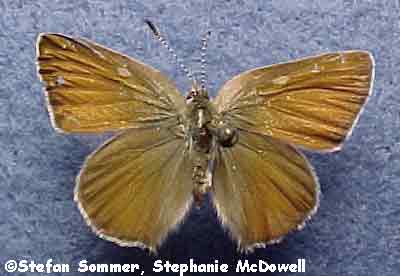
Western Green Hairstreak
Family: Lycaenidae
Family Description:
Alternate Common Names:Bramble Green Hairstreak, Green Hairstreak, Immaculate Green Hairstreak, Affinis Green Hairstreak.
Note: The green hairstreaks of the genus Callophrys can be difficult to identify. There is still some debate among scientists about the exact boundaries between some species.
Description:
Caterpillar: The caterpillars vary considerably in color. They may be yellowish green, bluish green, bright green, pink or red in color, and they may be with or without white or yellow stripes. Generally, they appear "bumpy" like a washboard due to their segmentation.
Adult: The butterfly is fairly small, with a wingspan of 7/8 to 1 1/8 inches, and its appearance is variable. The upperside ranges in color from gray to orange to brown and is unmarked. The underside is yellowish green; the forewing may have an uneven orange or gray patch, while the hindwing is generally solid green and marked with a line of faint white spots spaced well apart. Although many hairstreaks have a thin tail extending off the hindwing, this species does not.
Range:
This is a western species, ranging from southern British Columbia and Alberta south through the Pacific Northwest and California, and east to central Montana and south to New Mexico. It has been found scattered throughout the state of Idaho.
Habitat:
Generally this species is found on open sunny slopes with low vegetation. This includes sand dunes, chaparral, brush, and forest openings.
Diet:
Caterpillar: Caterpillars eat the flowers, fruits, and occasionally leaves of several species of plants, including buckwheat (Eriogonum spp.), trefoils (Lotus spp.), and buck brush (Ceanothus spp.).
Adult: Butterflies drink flower nectar.
Ecology:
There is one generation of caterpillars each summer. The caterpillars pupate, then overwinter within their chrysalises in a physiological state called diapause until spring. Adults generally fly from May through June.
Reproduction:
Males perch and wait for receptive females to pass by. Females lay eggs singly on the flower buds of host plants.
Conservation:
| Global Rank: | G5 populations are widespread, abundant, and secure. |
References:
Ferris, C. D. and F. M. Brown. (eds.) 1981. Butterflies of the Rocky Mountain States. Univ. of Oklahoma Press, Norman, Oklahoma, USA, 442 pp.
Opler, P. A., H. Pavulaan, and R. E. Stanford. 1995. Butterflies of North America. Jamestown, North Dakota, USA: Northern Prairie Wildlife Research Center Home Page. http://www.npwrc.usgs.gov/resource/distr/lepid/bflyusa/bflyusa.htm (Version 05Nov98).
Opler, P. A. and A. B.Wright. 1999. A Field Guide to the Western Butterflies. Second Edition. Peterson Field Guide Series. Houghton Mifflin Company, New York, New York, USA, 540 pp.
Pyle, R. M. 1981. National Audubon Society Field Guide to North American Butterflies. Alfred A. Knopf, Inc., New York, New York, USA, 924 pp.
Scott, J. A. 1986. The Butterflies of North America. Stanford University Press, Stanford, California, USA, 583 pp.
Stanford, R. E. and P. A. Opler. 1993. Atlas of Western U.S.A. Butterflies (Including Adjacent Parts of Canada and Mexico). Published by authors, Denver, Colorado, USA, 275 pp.
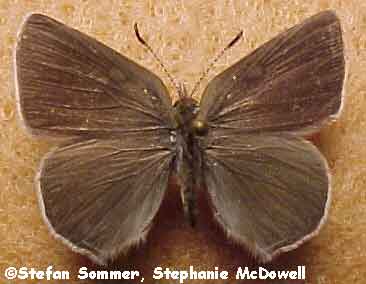
Sheridan’s Hairstreak
Family: Lycaenidae
Family Description:
Alternate Common Names:White-lined Green Hairstreak, Little Green Hairstreak.
Note: The green hairstreaks of the genus Callophrys can be difficult to identify. There is still some debate among scientists about the exact boundaries between some species.
Description:
Caterpillar: Caterpillars are variable in color, but generally are green to pink, and marked lengthwise with white to light yellow stripes. Often they appear "bumpy" like a washboard due to their segmentation.
Adult: The butterfly is fairly small, with a wingspan of 7/8 to 1 1/8 inches. It is grayish brown on the upperside, and bright green to grayish green underneath. The underside of the forewing may have a grayish patch along the trailing edge. There may be a white stripe or line of white dots running across the fore- and hindwings on the underside. The wings are fringed with white. Although many hairstreaks have a thin tail extending off the hindwing, this species does not.
Range:
The species ranges from southern British Columbia and Alberta south through most of the Pacific Northwest and eastern California, and east to western Montana south to northern New Mexico. Isolated populations may be found in North Dakota, Nebraska and southeastern New Mexico. It occurs in patches throughout the state of Idaho.
Habitat:
It occurs in chaparral, woodlands, sagebrush steppe, and scrublands.
Diet:
Caterpillar: Caterpillars eat the leaves of a variety of wild buckwheat (Eriogonum) species.
Adult: Butterflies drink flower nectar.
Ecology:
Usually there is one generation of caterpillars each summer. The caterpillars pupate, then overwinter within their chrysalises in a physiological state called diapause until spring. Adults generally fly from March to July.
Reproduction:
Males perch to wait for receptive females to pass by. Females lay eggs singly on the leaves of host plants.
Conservation:
| Global Rank: | G5; populations are widespread, abundant, and secure. |
References:
Ferris, C. D. and F. M. Brown. (eds.) 1981. Butterflies of the Rocky Mountain States. Univ. of Oklahoma Press, Norman, Oklahoma, USA, 442 pp.
Opler, P. A., H. Pavulaan, and R. E. Stanford. 1995. Butterflies of North America. Jamestown, North Dakota, USA: Northern Prairie Wildlife Research Center Home Page. http://www.npwrc.usgs.gov/resource/distr/lepid/bflyusa/bflyusa.htm (Version 05Nov98).
Opler, P. A. and A. B.Wright. 1999. A Field Guide to the Western Butterflies. Second Edition. Peterson Field Guide Series. Houghton Mifflin Company, New York, New York, USA, 540 pp.
Pyle, R. M. 1981. National Audubon Society Field Guide to North American Butterflies. Alfred A. Knopf, Inc., New York, New York, USA, 924 pp.
Scott, J. A. 1986. The Butterflies of North America. Stanford University Press, Stanford, California, USA, 583 pp.
Stanford, R. E. and P. A. Opler. 1993. Atlas of Western U.S.A. Butterflies (Including Adjacent Parts of Canada and Mexico). Published by authors, Denver, Colorado, USA, 275 pp.
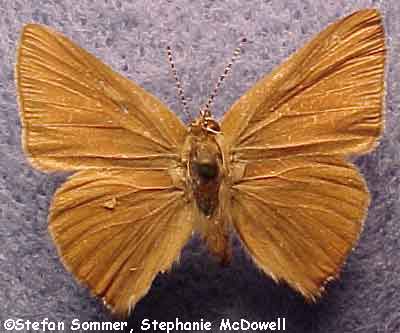
Coral Hairstreak
Family: Lycaenidae
Family Description:
Note: The previous genus name Harkenclenus was derived from the name of a butterfly expert, Harry Kendon Clench, who specialized in Hairstreaks.
Description:
Caterpillar: The caterpillar is yellowish green to green, and is marked with a dark green line running lengthwise along the back, and pinkish red patches, dotted with white on the edges, at the front and rear. It is covered with downy hair. The average, full-grown length is 1 inch.
Adult: The butterfly is small to medium-sized, with a wingspan of 1 to 1 ½ inches, and its appearance varies regionally. The upperside is typically brown and may be clouded with orange. There may be reddish spots along the outer edges of the wings, particularly on the hindwing. Underneath is gray to brown and may be dotted with black. On the underside of the hindwing, there is a curved row of bright orange spots (the color of coral) along the outer edge. Although it is a Hairstreak, it lacks the characteristic tail extending from each hindwing.
Range:
This species ranges from southern British Columbia east to the east coast, and south to Nevada, New Mexico, and northern Texas east to Georgia. It occurs through much of Idaho.
Habitat:
It utilizes a variety of habitats including meadows, fields, brushy areas, woodlands, and mountain canyons.
Diet:
Caterpillar: Caterpillars feed on the leaves and fruit of trees of the genus Prunus, such as wild cherry, wild plum, and chokecherry.
Adult: Butterflies drink flower nectar, often from butterfly weed (Asclepias spp.) in the east or dogbane (Apocynum androsaemifolium) in the west.
Ecology:
There is one generation of caterpillars each growing season, which hatch from eggs laid the previous year. Caterpillars feed at night and retreat to the base of the plant or into the leaf litter during the day. Each caterpillar undergoes four stages of growth, called instars. The caterpillar is equipped with a honey gland, also known as a dorsal nectary organ, which emits a sugary solution agreeable to ants. The ants feed on the solution and in turn protect the caterpillar from predators. Adults generally fly from mid-May through August.
Reproduction:
Males perch to wait for receptive females. Females lay eggs singly on host plants, usually on twigs but occasionally at the base of the plant.
Conservation:
| Global Rank: | G5; populations are widespread, abundant, and secure.. |
References:
Ballmer, G. R. and G. F. Pratt. 1988. A survey of the last instar larvae of the Lycaenidae of California. Journal of Research on the Lepidoptera 27:1-81.
Ferris, C. D. and F. M. Brown. (eds.) 1981. Butterflies of the Rocky Mountain States. Univ. of Oklahoma Press, Norman, Oklahoma, USA, 442 pp.
Opler, P. A., H. Pavulaan, and R. E. Stanford. 1995. Butterflies of North America. Jamestown, North Dakota, USA: Northern Prairie Wildlife Research Center Home Page. http://www.npwrc.usgs.gov/resource/distr/lepid/bflyusa/bflyusa.htm (Version 05Nov98).
Opler, P. A. and A. B.Wright. 1999. A Field Guide to the Western Butterflies. Second Edition. Peterson Field Guide Series. Houghton Mifflin Company, New York, New York, USA, 540 pp.
Pyle, R. M. 1981. National Audubon Society Field Guide to North American Butterflies. Alfred A. Knopf, Inc., New York, New York, USA, 924 pp.
Scott, J. A. 1986. The Butterflies of North America. Stanford University Press, Stanford, California, USA, 583 pp.
Stanford, R. E. and P. A. Opler. 1993. Atlas of Western U.S.A. Butterflies (Including Adjacent Parts of Canada and Mexico). Published by authors, Denver, Colorado, USA, 275 pp.
Satyrium acadica
Acadian Hairstreak
Family: Lycaenidae
Family Description:
Alternate Common Name: Northern Willow Hairstreak.
Description:
Caterpillar: The caterpillar is bright green and marked along the side with a white stripe and yellowish white diagonal dashes and along the back with a wide, darker green band.
Adult: The butterfly is fairly small to medium-sized, with a wingspan of 1 1/8 to 1 1/2 inches. The upperside is grayish brown and may be marked with a single orange spot on the hindwing, usually in females. The underside is silvery gray and marked with a curved row of small black dots followed towards the outside by a curved row of orange ">"-shaped spots. The orange spots are larger towards the trailing edge of the hindwing. A thin tail extends from the hindwing; a large, bluish gray spot tipped with orange marks the hindwing near where the tail originates.
Range:
This species is found in Canada from southeastern British Columbia east to Nova Scotia, and in the U.S. from Idaho to the east coast, extending south as far as Colorado, east to northern Virginia. In Idaho, it occurs in the northern and south central parts of the state.
Habitat:
This species can be found in moist habitats such as along streams and in wet fields and meadows.
Diet:
Caterpillar: Caterpillars feed on the leaves of willows (Salix spp.).
Adult: Butterflies drink flower nectar, commonly from milkweeds (Asclepias spp.) and dogbane (Apocynum spp.).
Ecology:
Eggs are laid in the fall, overwinter, and hatch in the spring. There is only one generation of caterpillars each year. The caterpillar is equipped with a honey gland, also known as a dorsal nectary organ, which emits a sugary solution agreeable to ants. The ants feed on the solution and in turn protect the caterpillar from predators. Adults generally fly from June through August. The tails of the hindwings of the butterfly resemble antennae and can act to fool predators into biting the wrong end of the butterfly, allowing it to escape. This species closely resembles the California Hairstreak and it can be difficult to distinguish between the two where their ranges overlap. However, the California Hairstreak occurs near oaks (Quercus spp.) while the Acadian Hairstreak occurs near willows (Salix spp.).
Reproduction:
Males perch in the afternoon on short vegetation near willows to wait for receptive females, and may occasionally actively patrol![]() for them. Females lay white eggs, tinted with green or pink, on the twigs of willows.
for them. Females lay white eggs, tinted with green or pink, on the twigs of willows.
Conservation:
| Global Rank: | G5; populations are widespread, abundant, and secure. |
References:
Ferris, C. D. and F. M. Brown. (eds.) 1981. Butterflies of the Rocky Mountain States. Univ. of Oklahoma Press, Norman, Oklahoma, USA, 442 pp.
Opler, P. A., H. Pavulaan, and R. E. Stanford. 1995. Butterflies of North America. Jamestown, North Dakota, USA: Northern Prairie Wildlife Research Center Home Page. http://www.npwrc.usgs.gov/resource/distr/lepid/bflyusa/bflyusa.htm (Version 05Nov98).
Opler, P. A. and A. B.Wright. 1999. A Field Guide to the Western Butterflies. Second Edition. Peterson Field Guide Series. Houghton Mifflin Company, New York, New York, USA, 540 pp.
Pyle, R. M. 1981. National Audubon Society Field Guide to North American Butterflies. Alfred A. Knopf, Inc., New York, New York, USA, 924 pp.
Scott, J. A. 1986. The Butterflies of North America. Stanford University Press, Stanford, California, USA, 583 pp.
Stanford, R. E. and P. A. Opler. 1993. Atlas of Western U.S.A. Butterflies (Including Adjacent Parts of Canada and Mexico). Published by authors, Denver, Colorado, USA, 275 pp.
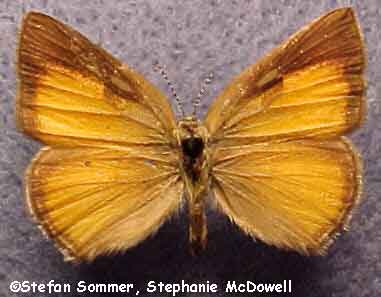
Behr’s Hairstreak
Family: Lycaenidae
Family Description:
Alternate Common Name: Orange Hairstreak.
Note: Some authors refer to this species using the genus name Callipsyche.
Description:
Caterpillar: The caterpillar is green, marked lengthwise with white, yellow, and/or dark green stripes along the back and sides, and covered with short yellow hair. It reaches an average, full-grown length of 1/2 inch.
Adult: The butterfly is small, with a wingspan of 7/8 to 1 1/4 inches. The upperside is bright golden orange edged thickly with dark brown. Males have a stigma, a patch of scent scales used in attracting females, on the forewing. Underneath, males are brown while females are brownish gray. There is an irregular line of black bars, edged with white, on the underside of the forewing; the underside of the hindwing is similarly but more randomly marked. The underside is additionally marked with a row of black spots, possibly dotted with white, along the outside edge. While most species of Hairstreaks have a thin tail extending from the rear of the hindwing, this species does not.
Range:
It occurs from southern British Columbia south along the various mountain ranges to southern California, and east to southern Idaho, western Wyoming and Colorado, and central New Mexico.
Habitat:
This species is found in dry habitats including sagebrush steppe, chaparral, and pinyon-juniper woodlands.
Diet:
Caterpillar: Caterpillars eat the leaves of bitterbrush (Purshia spp.).
Adult: Butterflies drink flower nectar, often from wild buckwheat (Eriogonum spp.).
Ecology:
Eggs are laid in the fall, overwinter, and hatch in the spring. There is only one generation of caterpillars each year. The caterpillar is equipped with a honey gland, also known as a dorsal nectary organ, which emits a sugary solution agreeable to ants. The ants feed on the solution and in turn protect the caterpillar from predators. Each caterpillar undergoes four stages of growth, called instars. Adults generally fly from May through August. Butterflies tend to stay near host plants and are fairly local within the described range of the species.
Reproduction:
Males perch on shrubs located on hilltops to wait for receptive females. Greenish white eggs are laid singly on the leaves and branches of bitterbrush (Purshia spp.). The eggs turn white before hatching.
Conservation:
| Global Rank: | G5; populations are widespread, abundant, and secure. |
References:
Ballmer, G. R. and G. F. Pratt. 1988. A survey of the last instar larvae of the Lycaenidae of California. Journal of Research on the Lepidoptera 27:1-81.
Ferris, C. D. and F. M. Brown. (eds.) 1981. Butterflies of the Rocky Mountain States. Univ. of Oklahoma Press, Norman, Oklahoma, USA, 442 pp.
Opler, P. A., H. Pavulaan, and R. E. Stanford. 1995. Butterflies of North America. Jamestown, North Dakota, USA: Northern Prairie Wildlife Research Center Home Page. http://www.npwrc.usgs.gov/resource/distr/lepid/bflyusa/bflyusa.htm (Version 05Nov98).
Opler, P. A. and A. B.Wright. 1999. A Field Guide to the Western Butterflies. Second Edition. Peterson Field Guide Series. Houghton Mifflin Company, New York, New York, USA, 540 pp.
Pyle, R. M. 1981. National Audubon Society Field Guide to North American Butterflies. Alfred A. Knopf, Inc., New York, New York, USA, 924 pp.
Scott, J. A. 1986. The Butterflies of North America. Stanford University Press, Stanford, California, USA, 583 pp.
Stanford, R. E. and P. A. Opler. 1993. Atlas of Western U.S.A. Butterflies (Including Adjacent Parts of Canada and Mexico). Published by authors, Denver, Colorado, USA, 275 pp.
California Hairstreak
Family: Lycaenidae
Family Description:
Alternate Common Name: Western Hairstreak.
Description:
Caterpillar: The caterpillar is beige on top, greenish white on the underside, and black on the back of the head. It is marked with white triangle-shaped spots along the side and large gray spots along the back. It reaches an average, full-grown length of ž inch.
Adult: The butterfly is fairly small, with a wingspan of 1 to 1 ź inches. The upperside is brown and marked along the edge of the forewing and rear of the hindwing with yellowish orange patches or spots. Underneath is brownish gray and marked with a row of small black spots followed towards the outside with a row of orange "<"-shaped spots. The spots are larger on the hindwing than the forewing. There is a single silvery blue spot at the rear of the hindwing, from where a long, thin tail extends.
Range:
This species ranges from southern British Columbia south to southern California, and east to Idaho and central Wyoming and Colorado.
Habitat:
It occurs in dry habitats such as chaparral, open woodlands, shrubby areas, and canyons of lower elevations.
Diet:
Caterpillar: Caterpillars eat the leaves of a variety of species, including buck brush (Ceanothus spp.), oaks (Quercus spp.), mountain mahogany (Cercocarpus spp.), chokecherry (Prunus virginiana), and serviceberry (Amelanchier alnifolia).
Adult: Butterflies drink flower nectar, often from milkweed (Asclepias spp.),wild buckwheat (Eriogonum spp.), and buck brush (Ceanothus spp.).
Ecology:
Eggs are laid in the fall, overwinter, and hatch in the spring. There is only one generation of caterpillars each year. The caterpillar is equipped with a honey gland, also known as a dorsal nectary organ, which emits a sugary solution agreeable to ants. The ants feed on the solution and in turn protect the caterpillar from predators. Each caterpillar undergoes four stages of growth, called instars. Adults generally fly from June to early August. The tails of the hindwings of the butterfly resemble antennae and can act to fool predators into biting the wrong end of the butterfly, allowing it to escape.
Reproduction:
Males perch in the tops of trees most commonly at the tops of hills to wait for receptive females, and sometimes actively patrol for them. This behavior is called "hill topping". Eggs are laid in the hollow portions of the bark of host plants, typically in clusters of two to four which are then cemented together by the female.
Conservation:
| Global Rank: | G4; population levels are secure, but may be of concern in the future. |
References:
Ballmer, G. R. and G. F. Pratt. 1988. A survey of the last instar larvae of the Lycaenidae of California. Journal of Research on the Lepidoptera 27:1-81.
Ferris, C. D. and F. M. Brown. (eds.) 1981. Butterflies of the Rocky Mountain States. Univ. of Oklahoma Press, Norman, Oklahoma, USA, 442 pp.
Opler, P. A., H. Pavulaan, and R. E. Stanford. 1995. Butterflies of North America. Jamestown, North Dakota, USA: Northern Prairie Wildlife Research Center Home Page. http://www.npwrc.usgs.gov/resource/distr/lepid/bflyusa/bflyusa.htm (Version 05Nov98).
Opler, P. A. and A. B.Wright. 1999. A Field Guide to the Western Butterflies. Second Edition. Peterson Field Guide Series. Houghton Mifflin Company, New York, New York, USA, 540 pp.
Pyle, R. M. 1981. National Audubon Society Field Guide to North American Butterflies. Alfred A. Knopf, Inc., New York, New York, USA, 924 pp.
Scott, J. A. 1986. The Butterflies of North America. Stanford University Press, Stanford, California, USA, 583 pp.
Stanford, R. E. and P. A. Opler. 1993. Atlas of Western U.S.A. Butterflies (Including Adjacent Parts of Canada and Mexico). Published by authors, Denver, Colorado, USA, 275 pp.
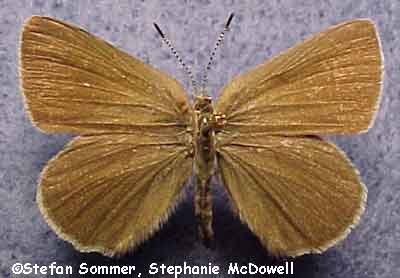
Sooty Hairstreak
Family: Lycaenidae
Family Description:
Description:
Caterpillar: The caterpillar is light green, marked with white ">"-shaped spots on the side, and has a dark brown head. It reaches an average, full-grown length of ž to 1 inch.
Adult: The butterfly is small, with a wingspan of 1 to 1 ź inches. The upperside varies in color from dark gray to grayish brown to dark brown, and is unmarked. The underside is lighter in color, ranging from gray to grayish brown, and may be marked with one or two rows of black spots, each ringed with white. The black spots are smaller and their accompanying white rings larger on the hindwing compared to the forewing. The wings have a rounded appearance, and are fringed with grayish brown. While most Hairstreaks have a thin tail extending from the rear of the hindwing, this species does not.
Range:
This species has a patchy range which covers southern British Columbia and Alberta south to central California, and extends east to Montana, Wyoming, and Colorado. It occurs through most of the southern half of Idaho.
Habitat:
It occurs in dry, often hilly areas, including sagebrush steppe, mountainsides, forest openings, fields, and along roads. It is always found in conjunction with lupines (Lupinus spp.).
Diet:
Caterpillar: Caterpillars feed at night on lupines (Lupinus spp.).
Adult: Butterflies drink flower nectar, often from wild buckwheat (Eriogonum spp.) and yellow flowers belonging to the sunflower family (Asteraceae).
Ecology:
Eggs are laid in the fall, overwinter, and hatch in the spring. There is only one generation of caterpillars each year. The caterpillar is equipped with a honey gland, also known as a dorsal nectary organ, which emits a sugary solution agreeable to ants. The ants feed on the solution and in turn protect the caterpillar from predators. Each caterpillar undergoes four stages of growth, called instars. Adults generally fly from mid-June to August. This species resembles females of the species Plebejus icariodes, the Common Blue, in both appearance and ecology.
Reproduction:
Males patrol in search of receptive females and sometimes perch to wait for them. Greenish white eggs are laid singly on lupines or on nearby leaf litter.
Conservation:
| Global Rank: | G4; population levels are secure, but may be of concern in the future. |
References:
Ballmer, G. R. and G. F. Pratt. 1988. A survey of the last instar larvae of the Lycaenidae of California. Journal of Research on the Lepidoptera 27:1-81.
Ferris, C. D. and F. M. Brown. (eds.) 1981. Butterflies of the Rocky Mountain States. Univ. of Oklahoma Press, Norman, Oklahoma, USA, 442 pp.
Opler, P. A., H. Pavulaan, and R. E. Stanford. 1995. Butterflies of North America. Jamestown, North Dakota, USA: Northern Prairie Wildlife Research Center Home Page. http://www.npwrc.usgs.gov/resource/distr/lepid/bflyusa/bflyusa.htm (Version 05Nov98).
Opler, P. A. and A. B.Wright. 1999. A Field Guide to the Western Butterflies. Second Edition. Peterson Field Guide Series. Houghton Mifflin Company, New York, New York, USA, 540 pp.
Pyle, R. M. 1981. National Audubon Society Field Guide to North American Butterflies. Alfred A. Knopf, Inc., New York, New York, USA, 924 pp.
Scott, J. A. 1986. The Butterflies of North America. Stanford University Press, Stanford, California, USA, 583 pp.
Stanford, R. E. and P. A. Opler. 1993. Atlas of Western U.S.A. Butterflies (Including Adjacent Parts of Canada and Mexico). Published by authors, Denver, Colorado, USA, 275 pp.
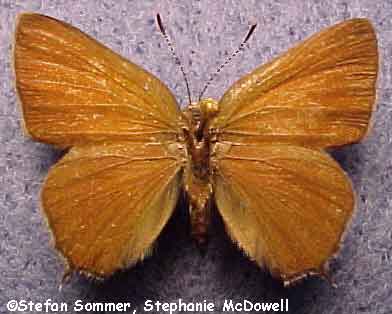
Hedgerow Hairstreak
Family: Lycaenidae
Family Description:
Alternate Common Name: Buckthorn Hairstreak.
Description:
Caterpillar: The caterpillar is light green and covered with short silvery hairs. Each side is marked lengthwise with a yellow stripe and faint greenish yellow ">"-shaped spots. It reaches a full-grown length of 1/2 to 3/4 inch.
Adult: The butterfly is fairly small, with a wingspan of 1 to 1 3/8 inches. The upperside is metallic golden to reddish brown and outlined in black. Males may have a black or gray spot near the leading edge of the forewing. The underside is brown and not as metallic. It is lightly marked with an irregular brownish black line, edged with white, which runs vertically across the center of both wings; the outer half of the wing may be lighter than the inner half. There is a row of brownish black dots near the wings’ edge. The underside of the hindwing is marked with a grayish blue spot or patch, and a thin tail originating near the spot extends from the rear. This tail tends to be longer in females than males, but in comparison with other Hairstreaks is quite short.
Range:
This species ranges from southern British Columbia south to Baja California, and east to central Montana, northwestern Wyoming, and in patches of Utah, Colorado, and the southwest. It occurs in patches throughout Idaho.
Habitat:
It occurs in dry, shrubby areas, including chaparral, sagebrush steppe, oak woodlands, and ponderosa pine forests.
Diet:
Caterpillar: Caterpillars feed on the leaves and flower buds of buck brush (Ceanothus spp.) and possibly mountain mahogany (Cercocarpus spp.).
Adult: Butterflies drink flower nectar, often from yerba santa (Eriodictyon spp.), buck brush (Ceanothus spp.), and wild buckwheats (Eriogonum spp.).
Ecology:
Eggs are laid in the fall, overwinter, and hatch in the spring. There is one generation of caterpillars each year. Each caterpillar undergoes four stages of growth, called instars. The caterpillar is equipped with a honey gland, also known as a dorsal nectary organ, which emits a sugary solution agreeable to ants. The ants feed on the solution and in turn protect the caterpillar from predators. To feed, caterpillars cut holes in the upper side of leaves. Adults generally fly from mid-May through August. Butterflies may be found in large groups. The tails of the two hindwings resemble antennae and may act to fool predators into biting the wrong end of the butterfly allowing it to escape.
Reproduction:
Males perch on short shrubs to wait for receptive females. Pale green eggs are laid singly on the branches, leaves, and flower buds of buck brush (Ceanothus spp.).
Conservation:
| Global Rank: | G5; populations are widespread, abundant, and secure. |
References:
Ballmer, G. R. and G. F. Pratt. 1988. A survey of the last instar larvae of the Lycaenidae of California. Journal of Research on the Lepidoptera 27:1-81.
Ferris, C. D. and F. M. Brown. (eds.) 1981. Butterflies of the Rocky Mountain States. Univ. of Oklahoma Press, Norman, Oklahoma, USA, 442 pp.
Opler, P. A., H. Pavulaan, and R. E. Stanford. 1995. Butterflies of North America. Jamestown, North Dakota, USA: Northern Prairie Wildlife Research Center Home Page. http://www.npwrc.usgs.gov/resource/distr/lepid/bflyusa/bflyusa.htm (Version 05Nov98).
Opler, P. A. and A. B.Wright. 1999. A Field Guide to the Western Butterflies. Second Edition. Peterson Field Guide Series. Houghton Mifflin Company, New York, New York, USA, 540 pp.
Pyle, R. M. 1981. National Audubon Society Field Guide to North American Butterflies. Alfred A. Knopf, Inc., New York, New York, USA, 924 pp.
Scott, J. A. 1986. The Butterflies of North America. Stanford University Press, Stanford, California, USA, 583 pp.
Stanford, R. E. and P. A. Opler. 1993. Atlas of Western U.S.A. Butterflies (Including Adjacent Parts of Canada and Mexico). Published by authors, Denver, Colorado, USA, 275 pp.
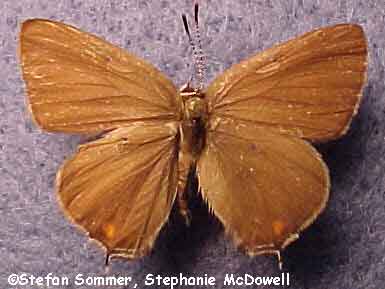
Sylvan Hairstreak
Family: Lycaenidae
Family Description:
Alternate Common Name: Western Willow Hairstreak.
Note: This species is really a complex made up of several species or subspecies, including sylvinus, dryope, and an unnamed form.
Description:
Caterpillar: The caterpillar is yellowish green and marked lengthwise with two yellowish white lines along the back and a row of white diagonal dashes along the side. It reaches an average, full-grown length of 3/4 inches.
Adult: This is a fairly small butterfly, with a wingspan of 7/8 to 1 3/8 inches. The upperside is grayish to reddish brown with a bluish sheen on the darker sections of the wing and a yellowish sheen where it is lighter. The hindwing is marked with a patch of orange near the trailing edge. Underneath is grayish white and marked with a vertical row of black spots, possibly with a second, fainter row near the edge. The underside of the hindwing is marked with a large orange spot and a grayish blue spot at the rear. A thin tail originating near the spots may extend off the hindwing, although some individuals may be tailless.
Range:
This species ranges from southern British Columbia south to Baja California, and east to Montana south to northern Arizona and New Mexico. It occurs throughout most of Idaho.
Habitat:
It occurs in wet areas with willows (Salix spp.) such as streamsides, ditches and moist meadows.
Diet:
Caterpillar: Caterpillars eat the leaves of various species of willow (Salix spp.).
Adult: Butterflies drink flower nectar, often from milkweeds (Asclepias spp.).
Ecology:
Eggs are laid in the fall, overwinter, and hatch in the spring. There is one generation of caterpillars each year. Each caterpillar undergoes four stages of growth, called instars. Adults generally fly from mid-May through mid-August. Butterflies tend to remain with a specific colony. The tails of the two hindwings resemble antennae and may act to fool predators into biting the wrong end of the butterfly allowing it to escape.
Reproduction:
Males perch on short plants near willows to wait for receptive females from morning to early afternoon. Pale green eggs are laid singly on willow stems.
Conservation:
| Global Rank: | G4; population levels are secure, but may be of concern in the future. |
References:
Ballmer, G. R. and G. F. Pratt. 1988. A survey of the last instar larvae of the Lycaenidae of California. Journal of Research on the Lepidoptera 27:1-81.
Ferris, C. D. and F. M. Brown. (eds.) 1981. Butterflies of the Rocky Mountain States. Univ. of Oklahoma Press, Norman, Oklahoma, USA, 442 pp.
Opler, P. A., H. Pavulaan, and R. E. Stanford. 1995. Butterflies of North America. Jamestown, North Dakota, USA: Northern Prairie Wildlife Research Center Home Page. http://www.npwrc.usgs.gov/resource/distr/lepid/bflyusa/bflyusa.htm (Version 05Nov98).
Opler, P. A. and A. B.Wright. 1999. A Field Guide to the Western Butterflies. Second Edition. Peterson Field Guide Series. Houghton Mifflin Company, New York, New York, USA, 540 pp.
Pyle, R. M. 1981. National Audubon Society Field Guide to North American Butterflies. Alfred A. Knopf, Inc., New York, New York, USA, 924 pp.
Scott, J. A. 1986. The Butterflies of North America. Stanford University Press, Stanford, California, USA, 583 pp.
Stanford, R. E. and P. A. Opler. 1993. Atlas of Western U.S.A. Butterflies (Including Adjacent Parts of Canada and Mexico). Published by authors, Denver, Colorado, USA, 275 pp.
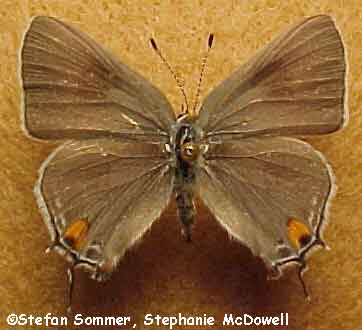
Gray Hairstreak
Family: Lycaenidae
Family Description:
Alternate Common Name: Common Hairstreak.
Description:
Caterpillar: The caterpillar varies a great deal in color, and can be either yellowish brown, pink, green, or reddish brown. It is marked with light diagonal stripes on the sides. It reaches an average, full-grown length of 5/8 inch.
Adult: This is a fairly small butterfly, with a wingspan of 7/8 to 1 3/8 inches. There is a thin tail extending from the rear of the hindwing. The upperside is dark gray to brownish gray and marked with a single large orange spot on the rear of the hindwing near where the tail originates. The underside varies in color from dark to light gray, and is marked with a thin, vertical line of black dashes, edged with white, running across both wings. The outer edge of both wings is marked similarly but more faintly. The underside of the hindwing is marked with one or two orange patches and two black spots at the rear. Males are marked along the sides of the abdomen with orange.
Range:
This butterfly exhibits a large range, extending from southern Canada, throughout the entire U.S., south through Mexico into South America. It occurs in sections of Idaho, primarily in the panhandle and the southwest.
Habitat:
It occurs in many kinds of open, often weedy, areas, including open woodlands, chaparral, along coasts, and in fields and vacant lots.
Diet:
Caterpillar: Caterpillars eat the flowers, fruits and occasionally young leaves of a large array of both cultivated and wild plants representing over 15 different families. Cultivated species include corn (Zea mays), cotton (Gossypium spp.), bean (Phaseolus spp.), alfalfa (Medicago sativa), and hops (Humulus spp.).
Adult: Butterflies drink nectar from a wide variety of flowers.
Ecology:
The number of generations of caterpillars each year varies with location, with there being two in the north and up to four in the south. Each caterpillar undergoes four stages of growth, called instars. The caterpillar is equipped with a honey gland, also known as a dorsal nectary organ, which emits a sugary solution agreeable to ants. The ants feed on the solution and in turn protect the caterpillar from predators. The caterpillar is referred to in parts of its range as the "cotton square borer," and it can cause significant damage to crops when feeding in large numbers. Pupae overwinter in a physiological state called diapause. Adults generally fly from March to November. The tails of the two hindwings of the butterfly resemble antennae and may act to fool predators into biting the wrong end of the butterfly allowing it to escape.
Reproduction:
Males perch on trees and shrubs in the afternoon and evenings to wait for receptive females. Eggs are laid singly on the flowers of host plants.
Conservation:
| Global Rank: | G5; populations are widespread, abundant, and secure.. |
References:
Ballmer, G. R. and G. F. Pratt. 1988. A survey of the last instar larvae of the Lycaenidae of California. Journal of Research on the Lepidoptera 27:1-81.
Ferris, C. D. and F. M. Brown. (eds.) 1981. Butterflies of the Rocky Mountain States. Univ. of Oklahoma Press, Norman, Oklahoma, USA, 442 pp.
Opler, P. A., H. Pavulaan, and R. E. Stanford. 1995. Butterflies of North America. Jamestown, North Dakota, USA: Northern Prairie Wildlife Research Center Home Page. http://www.npwrc.usgs.gov/resource/distr/lepid/bflyusa/bflyusa.htm (Version 05Nov98).
Opler, P. A. and A. B.Wright. 1999. A Field Guide to the Western Butterflies. Second Edition. Peterson Field Guide Series. Houghton Mifflin Company, New York, New York, USA, 540 pp.
Pyle, R. M. 1981. National Audubon Society Field Guide to North American Butterflies. Alfred A. Knopf, Inc., New York, New York, USA, 924 pp.
Scott, J. A. 1986. The Butterflies of North America. Stanford University Press, Stanford, California, USA, 583 pp.
Stanford, R. E. and P. A. Opler. 1993. Atlas of Western U.S.A. Butterflies (Including Adjacent Parts of Canada and Mexico). Published by authors, Denver, Colorado, USA, 275 pp.
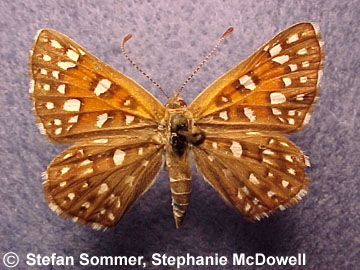
Mormon Metalmark
Family: Riodinidae
Family Description:
Note: Some authors consider this species to be comprised of many subspecies, while other authors treat some of the subspecies as independent species based on the physical appearance of the adults and the timing of their flights.
Description:
Caterpillar: The caterpillar is dark purple on top and lighter underneath, with groups of spines that are dark at the base and light at the tips. Its average, full-grown length is approximately ½ inch.
Adult: The butterfly has a wingspan of ¾ to 1 ¼ inches. The upperside is largely dark brown to black with patches of orange on the forewing and possibly the hindwing. Large white checks are scattered over the entire upper surface. Near the outside edge of both the fore- and hindwing is a row of small white dots. The border has a checkerboard appearance, of brownish black and white. Underneath, the forewing is orangish bordered by grayish brown, and spotted with white. The hindwing is grayish brown and marked with large patches and spots of white.
Range:
This species occurs in patches of the Pacific Northwest, Idaho, and Montana, and throughout much of the southwestern U.S.
Habitat:
It largely occurs in dry, open areas, including dunes, chaparral, sagebrush steppe, grasslands, and rocky slopes.
Diet:
Caterpillar: Caterpillars feed on various species of buckwheat (Eriogonum spp.). Young caterpillars eat the leaves only while older ones eat the stems as well.
Adult: Butterflies obtain nectar from a variety of flowers including buckwheat and rabbit-brush (Chrysothamnus spp.).
Ecology:
Caterpillars construct nests of leaves and silk in which they rest during the day, coming out at night to feed. Each caterpillar undergoes five stages of growth, or instars. In most of its range, there is one generation each year, with the caterpillars overwintering in the physiological state called diapause inside host plant stems or flowers heads. The southern portions of the range may have two generations of caterpillars each summer, in which case only the second generation overwinters. In some locations, eggs have been known to overwinter. Adults generally fly from April through October.
Reproduction:
Males perch to wait for receptive females. Females lay pinkish to purple colored eggs in small groups on the lower leaves or singly on other parts of the host plant.
Conservation:
| Global Rank: |
Varies with subspecies. Subspecies langei of California is ranked as T1, which means it is critically imperiled because of extreme rarity and is imminently vulnerable to extinction. Geographically isolated populations of butterflies such as this subspecies are often genetically isolated, which results in increased sensitivity to habitat loss. |
References:
Ballmer, G. R. and G. F. Pratt. 1988. A survey of the last instar larvae of the Lycaenidae of California. Journal of Research on the Lepidoptera 27:1-81.
Ferris, C. D. and F. M. Brown. (eds.) 1981. Butterflies of the Rocky Mountain States. Univ. of Oklahoma Press, Norman, Oklahoma, USA, 442 pp.
Opler, P. A., H. Pavulaan, and R. E. Stanford. 1995. Butterflies of North America. Jamestown, North Dakota, USA: Northern Prairie Wildlife Research Center Home Page. http://www.npwrc.usgs.gov/resource/distr/lepid/bflyusa/bflyusa.htm (Version 05Nov98).
Opler, P. A. and A. B.Wright. 1999. A Field Guide to the Western Butterflies. Second Edition. Peterson Field Guide Series. Houghton Mifflin Company, New York, New York, USA, 540 pp.
Pyle, R. M. 1981. National Audubon Society Field Guide to North American Butterflies. Alfred A. Knopf, Inc., New York, New York, USA, 924 pp.
Scott, J. A. 1986. The Butterflies of North America. Stanford University Press, Stanford, California, USA, 583 pp.
Stanford, R. E. and P. A. Opler. 1993. Atlas of Western U.S.A. Butterflies (Including Adjacent Parts of Canada and Mexico). Published by authors, Denver, Colorado, USA, 275 pp.
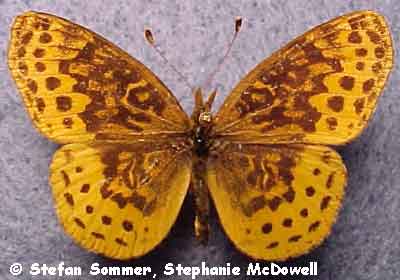
Meadow Fritillary
Family: Nymphalidae
Family Description:
Note: This species is referred to with the genus name Clossiana by some authors.
Description:
Caterpillar: The caterpillar is purple to black and may be mottled with yellow. The body has many brown bumps (tubercles) with brown, branching spines arising from each.
Adult: The butterfly is medium-sized, with a wingspan of 1 ¼ to 2 inches. It is orange to red on the upperside with black zigzags on the interior of the wings and two rows of black spots along the outside edges. The outermost tips of the forewings are squared off. Underneath, the forewing is marked similarly to the upperside but the tips may be purplish, while the hindwing is orange clouded with purplish brown and marked with brown and tan.
Range:
This species ranges from eastern British Columbia to Newfoundland, south to the northern parts of Oregon, Idaho, and Montana, and throughout the northeastern quarter of the U.S. as far south as Tennessee.
Habitat:
It is primarily found in wet to moist habitats, including bogs, marshes, wet fields and meadows.
Diet:
Caterpillar: Caterpillars eat the leaves of various species of violets (Viola spp.).
Adult: Butterflies obtain nectar usually from flowers in the sunflower family (Asteraceae), such as dandelions (Taraxacum spp.) and ox-eyed daises (Chrysanthemum leucanthemum).
Ecology:
Caterpillars overwinter in a physiological state called diapause. The number of generations each year depends on the location: one in the west, two in the north and three in the south. In the case of multiple generations in a given summer, only the last generation of caterpillars overwinters. Adults generally fly from early May to early September.
Reproduction:
Males actively patrol for receptive females. During courtship the male will hover above the female. Females lay eggs on randomly selected plants and plant parts, and very seldom on violets.
Conservation:
| Global Rank: | G5; populations are widespread, abundant, and secure. |
References:
Ferris, C. D. and F. M. Brown. (eds.) 1981. Butterflies of the Rocky Mountain States. Univ. of Oklahoma Press, Norman, Oklahoma, USA, 442 pp.
Opler, P. A., H. Pavulaan, and R. E. Stanford. 1995. Butterflies of North America. Jamestown, North Dakota, USA: Northern Prairie Wildlife Research Center Home Page. http://www.npwrc.usgs.gov/resource/distr/lepid/bflyusa/bflyusa.htm (Version 05Nov98).
Opler, P. A. and A. B.Wright. 1999. A Field Guide to the Western Butterflies. Second Edition. Peterson Field Guide Series. Houghton Mifflin Company, New York, New York, USA, 540 pp.
Pyle, R. M. 1981. National Audubon Society Field Guide to North American Butterflies. Alfred A. Knopf, Inc., New York, New York, USA, 924 pp.
Scott, J. A. 1986. The Butterflies of North America. Stanford University Press, Stanford, California, USA, 583 pp.
Stanford, R. E. and P. A. Opler. 1993. Atlas of Western U.S.A. Butterflies (Including Adjacent Parts of Canada and Mexico). Published by authors, Denver, Colorado, USA, 275 pp.
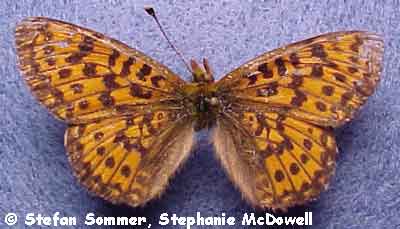
Arctic Fritillary
Family:Nymphalidae
Family Description:
Note: This species is referred to with the genus name Clossiana by some authors. Some authors consider this species to be a subspecies of Boloria titania, the Purple Fritillary.
Description:
Caterpillar: The caterpillar is gray, with a black head and black stripes along the back and sides, and has orange spines.
Adult: This is a medium-sized butterfly, with a wingspan of 1 1/4 to 1 1/2 inches. Its appearance is variable, but generally the upperside is orange, marked with black zigzags on the inner halves of the wings, with a row of black spots followed by a row of black triangles along the wings’ edges. Underneath, the forewing is similarly marked. The underside of the hindwing is brownish and marked with a whitish, yellowish, or rust colored wavy band, lined with black towards the outside, running across the center. Along the outer edge is a dashed white line, bordered towards the inside by a line of brown ">’s" which point inwards, followed by a curved row of brownish spots.
Range:
Its range includes Alaska, all of Canada, the Cascades and the Rocky Mountains, parts of Utah, Colorado, New Mexico, northern Minnesota, New Hampshire, and Maine. In Idaho, it has been documented to occur in the eastern part of the state in Fremont and Bear Lake Counties.
Habitat:
It tends to be in wetter and more harsh climates, including tundra, alpine meadows, bogs, and coniferous forests.
Diet:
Caterpillar: Caterpillars eat the leaves of violets (Viola spp.), willows (Salix spp.), and possibly blueberries (Vaccinium spp.).
Adult: Butterflies drink flower nectar.
Ecology:
This species is biennial in much of its range. Very young caterpillars overwinter, in a physiological state called diapause, the first winter. In spring, they emerge, feed, and undergo several molts through summer and fall. The following winter, the mature caterpillars enter diapause again, and emerge in the spring to finish their development into butterflies. In the other parts of its range, very young caterpillars overwinter and finish their development the following summer. This species of Fritillary flies late into the fall and is often one of the last observed of the season.
Reproduction:
Males actively patrol for receptive females. Females lay eggs on a variety of plant species, typically positioning them on the undersides of leaves.
Conservation:
| Global Rank: | G5; populations are widespread, abundant, and secure. |
References:
Ferris, C. D. and F. M. Brown. (eds.) 1981. Butterflies of the Rocky Mountain States. Univ. of Oklahoma Press, Norman, Oklahoma, USA, 442 pp.
Opler, P. A., H. Pavulaan, and R. E. Stanford. 1995. Butterflies of North America. Jamestown, North Dakota, USA: Northern Prairie Wildlife Research Center Home Page. http://www.npwrc.usgs.gov/resource/distr/lepid/bflyusa/bflyusa.htm (Version 05Nov98).
Opler, P. A. and A. B.Wright. 1999. A Field Guide to the Western Butterflies. Second Edition. Peterson Field Guide Series. Houghton Mifflin Company, New York, New York, USA, 540 pp.
Pyle, R. M. 1981. National Audubon Society Field Guide to North American Butterflies. Alfred A. Knopf, Inc., New York, New York, USA, 924 pp.
Scott, J. A. 1986. The Butterflies of North America. Stanford University Press, Stanford, California, USA, 583 pp.
Stanford, R. E. and P. A. Opler. 1993. Atlas of Western U.S.A. Butterflies (Including Adjacent Parts of Canada and Mexico). Published by authors, Denver, Colorado, USA, 275 pp.
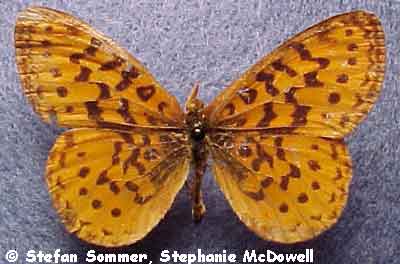
Pacific Fritillary
Family:Nymphalidae
Family Description:
Alternate Common Name: Western Meadow Fritillary.
Note: This species is referred to with the genus name Clossiana by some authors.
Description:
Caterpillar: Caterpillars are gray with darker sides streaked with black in the middle and marked with a reddish stripe near the bottom. The head is black, and the spines on both ends are black while those in the middle tend to be reddish.
Adult: The butterfly is medium-sized, with a wingspan of 1 3/8 to 1 3/4 inches. The upperside is bright orange, with black zigzagging lines on the interior half of the wings, followed by a row of blackish spots and a row of blackish dashes near the wings’ edge. Underneath, the forewing is pale brownish orange and marked similarly to the upperside. The underside of the hindwing is marked with wavy bands of brown, tan and yellowish beige near the base of the wing, while the outer half is grayish purplish brown and marked with a curved row of faint spots.
Range:
This is a butterfly of the Pacific Northwest primarily. It ranges from central British Columbia and southern Alberta south through Washington, Oregon, northern Idaho, and western Montana, and further south in California.
Habitat:
It tends to be in moist and open areas, such as meadows, marshes, mixed forests, and along streams.
Diet:
Caterpillar: Caterpillars eat the leaves of various species of violets (Viola spp.).
Adult: Butterflies feed on flower nectar and are known to visit flowers of buck brush (Ceanothus velutinus) and members of the sunflower family (Asteraceae).
Ecology:
There is one generation of caterpillars each summer. Caterpillars overwinter in a physiological state called diapause during the winter, and emerge in spring to feed until they are ready to pupate. Adults generally fly from April to early August.
Reproduction:
Males actively patrol for receptive females. The locations chosen by females to lay eggs have not been reported.
Conservation:
| Global Rank: |
G5; most populations are widespread, abundant, and secure. However, certain populations in the Santa Cruz mountains of California are dwindling. |
References:
Ferris, C. D. and F. M. Brown. (eds.) 1981. Butterflies of the Rocky Mountain States. Univ. of Oklahoma Press, Norman, Oklahoma, USA, 442 pp.
Opler, P. A., H. Pavulaan, and R. E. Stanford. 1995. Butterflies of North America. Jamestown, North Dakota, USA: Northern Prairie Wildlife Research Center Home Page. http://www.npwrc.usgs.gov/resource/distr/lepid/bflyusa/bflyusa.htm (Version 05Nov98).
Opler, P. A. and A. B.Wright. 1999. A Field Guide to the Western Butterflies. Second Edition. Peterson Field Guide Series. Houghton Mifflin Company, New York, New York, USA, 540 pp.
Pyle, R. M. 1981. National Audubon Society Field Guide to North American Butterflies. Alfred A. Knopf, Inc., New York, New York, USA, 924 pp.
Scott, J. A. 1986. The Butterflies of North America. Stanford University Press, Stanford, California, USA, 583 pp.
Stanford, R. E. and P. A. Opler. 1993. Atlas of Western U.S.A. Butterflies (Including Adjacent Parts of Canada and Mexico). Published by authors, Denver, Colorado, USA, 275 pp.
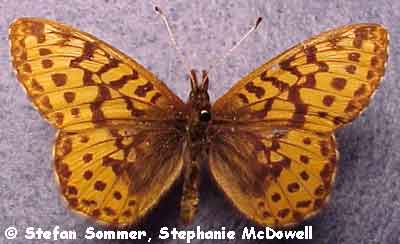
Frigga Fritillary
Family: Nymphalidae
Family Description:
Alternate Common Name: Willow-Bog Fritillary.
Note: This species is referred to with the genus name Clossiana by some authors.
Description:
Caterpillar: The caterpillar is black and is marked lengthwise with a light purple line along each side. The body is covered with black spines.
Adult: The butterfly is medium-sized, with a wingspan of 1 ¼ to 2 inches. The upperside is orange to light brown with a black cloudy region on the wings where they meet the body. The majority of both the fore- and hindwing is marked with black zigzags, with a row of black spots followed by a row of black dashes or "V’s" along the outside edge. The forewing tips are pointed. Underneath, the forewing is marked similarly but is paler. The underside of the hindwing is clouded with brown and has a white patch on the inside edge, perpendicular to the body; the outer half of the wing is light brown and has a curved row of brownish spots.
Range:
The species is holarctic, which means it can be found in the northern temperate regions of the entire Northern Hemisphere. In North America, it ranges from Alaska and northern Canada south to the Canadian border and into the northern sections of Minnesota, Wisconsin, and Michigan. There are also isolated populations in the Rockies, in central Colorado and in northeastern Wyoming. In Idaho, it has currently been documented only in Fremont County.
Habitat:
This is a species of bogs and arctic tundra.
Diet:
Caterpillar: Caterpillars feed on the leaves of willows (Salix spp.), birch (Betula spp.), cranberry (Vaccinium spp.), and bog rosemary (Rosmarinus spp.).
Adult: Butterflies are known to visit flowers of Labrador tea (Ledum glandulasum), but only rarely.
Ecology:
There is one generation of caterpillars each summer. These caterpillars overwinter in a physiological state called diapause and then pupate in the spring. Adults generally fly from June to mid-July.
Reproduction:
Males patrol the low portions of willow bogs for receptive females. Females lay their eggs on willows and are partly dependent on old beaver dams for the abundance of healthy willows at such sites.
Conservation:
| Global Rank: |
G5; populations are widespread, abundant, and secure. |
References:
Ferris, C. D. and F. M. Brown. (eds.) 1981. Butterflies of the Rocky Mountain States. Univ. of Oklahoma Press, Norman, Oklahoma, USA, 442 pp.
Opler, P. A., H. Pavulaan, and R. E. Stanford. 1995. Butterflies of North America. Jamestown, North Dakota, USA: Northern Prairie Wildlife Research Center Home Page. http://www.npwrc.usgs.gov/resource/distr/lepid/bflyusa/bflyusa.htm (Version 05Nov98).
Opler, P. A. and A. B.Wright. 1999. A Field Guide to the Western Butterflies. Second Edition. Peterson Field Guide Series. Houghton Mifflin Company, New York, New York, USA, 540 pp.
Pyle, R. M. 1981. National Audubon Society Field Guide to North American Butterflies. Alfred A. Knopf, Inc., New York, New York, USA, 924 pp.
Scott, J. A. 1986. The Butterflies of North America. Stanford University Press, Stanford, California, USA, 583 pp.
Stanford, R. E. and P. A. Opler. 1993. Atlas of Western U.S.A. Butterflies (Including Adjacent Parts of Canada and Mexico). Published by authors, Denver, Colorado, USA, 275 pp.
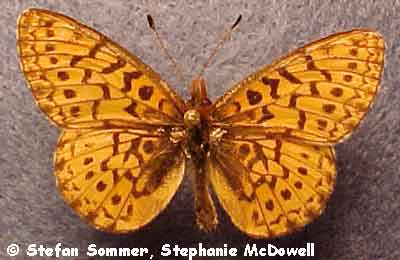
Relict Fritillary
Family: Nymphalidae
Family Description:
Alternate Common Names:Relict Meadow Fritillary, Kriemhild Fritillary.
Note: This species is referred to with genus name Clossiana by some authors.
Description:
Caterpillar: The caterpillar currently has not been described in detail by scientists.
Adult: The butterfly is medium-sized, with a wingspan of 1 3/8 to 1 3/4 inches. The upperside is orange to brown and marked with black zigzags on the inner half of the wings. The outer edge of the wing is lined with a row of spots and a row of dashed lines. Underneath, the wings are light orange to yellow. The forewing has a vertical row of outward pointing ">’s" up the middle, while the hindwing appears patched with irregularly shaped yellow and orange spots.
Range:
This species has a small range which runs from the Wasatch Mountains of Utah straight north through the Rocky Mountians on the border of Idaho and Wyoming and into southern Montana.
Habitat:
It is most often found in moist habitats, including meadows, forest edges, and clearings.
Diet:
Caterpillar: Caterpillars feed on various species of violets (Viola spp.).
Adult: Butterflies are known to obtain flower nectar from asters (Aster spp.) and yellow colored flowers of the sunflower family (Asteraceae).
Ecology:
There is one generation of caterpillars each summer. Caterpillars overwinter in a physiological state called diapause. Adults generally fly from mid-June to early August.
Reproduction:
Males find receptive females by actively patrolling meadows. The locations chosen by females for laying their eggs have not been reported.
Conservation:
| Global Rank: |
G4; population levels are secure, but may be of concern in the future.. |
References:
Ferris, C. D. and F. M. Brown. (eds.) 1981. Butterflies of the Rocky Mountain States. Univ. of Oklahoma Press, Norman, Oklahoma, USA, 442 pp.
Opler, P. A., H. Pavulaan, and R. E. Stanford. 1995. Butterflies of North America. Jamestown, North Dakota, USA: Northern Prairie Wildlife Research Center Home Page. http://www.npwrc.usgs.gov/resource/distr/lepid/bflyusa/bflyusa.htm (Version 05Nov98).
Opler, P. A. and A. B.Wright. 1999. A Field Guide to the Western Butterflies. Second Edition. Peterson Field Guide Series. Houghton Mifflin Company, New York, New York, USA, 540 pp.
Pyle, R. M. 1981. National Audubon Society Field Guide to North American Butterflies. Alfred A. Knopf, Inc., New York, New York, USA, 924 pp.
Scott, J. A. 1986. The Butterflies of North America. Stanford University Press, Stanford, California, USA, 583 pp.
Stanford, R. E. and P. A. Opler. 1993. Atlas of Western U.S.A. Butterflies (Including Adjacent Parts of Canada and Mexico). Published by authors, Denver, Colorado, USA, 275 pp.
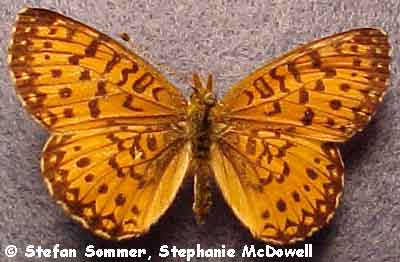
Boloria selene
Silver-bordered Fritillary
Family Description:
Alternate Common Name: Silver Meadow Fritillary.
Note: This species is referred to with the genus name Clossiana by some authors.
Description:
Caterpillar: The caterpillar can be brownish or bluish-black, with black dots and patches, and may possibly appear mottled. It has a black head, an orangish line along the side, and yellowish spines tipped with black hairs. The spines towards the front are much longer than the rest. It can reach a maximum length of approximately one-half inch.
Adult: The butterfly is medium sized, with a wingspan of 1 3/8 to 2 inches. The upperside is bright orange and marked with black zigzags on the inner half of the wings. The outer portion of the wings is lined with a row of black dots, followed by a row of black triangles; the outermost edge is lined in black as well. Underneath, the forewing is yellowish orange and marked with black and brown. The hindwing has two rows of silver spots with a row of small black dots in between, and a scattering of silver patches near the base.
Range:
The species is holarctic, which means it can be found in the northern temperate regions of the entire Northern Hemisphere. In North America, it ranges from central Alaska southeast across Canada to Newfoundland, and from the eastern half of Washington, south along the Rockies and east across the northern half of the U.S. In Idaho, it occurs primarily in the center of the state, but may also be found in much of the north and in patches of the southeast.
Habitat:
This species prefers wet to moist areas, including bogs, marshes, and wet meadows.
Diet:
Caterpillar: The caterpillars eat the leaves of various species of violets (Viola spp.).
Adult: The butterflies use flower nectar for food, often frequenting flowers in the sunflower family (Asteraceae) such as goldenrod (Solidago spp.), and verbena (Verbena spp.) in the verbena family (Verbenaceae).
Ecology:
There can be one to three generations of caterpillars each summer, depending on the climate. The harsh environments of high elevations and the arctic allow for only one generation in a given year. Young caterpillars overwinter in a physiological state called diapause, and emerge in the spring to feed, molt, and eventually pupate. Adults generally fly from late May through mid-September.
Reproduction:
Males actively patrol in search of receptive females. Females lay eggs singly on randomly selected plants, often near but rarely on violets.
Conservation:
| Global Rank: |
G5; populations are widespread, abundant, and secure. |
References:
Ferris, C. D. and F. M. Brown. (eds.) 1981. Butterflies of the Rocky Mountain States. Univ. of Oklahoma Press, Norman, Oklahoma, USA, 442 pp.
Opler, P. A., H. Pavulaan, and R. E. Stanford. 1995. Butterflies of North America. Jamestown, North Dakota, USA: Northern Prairie Wildlife Research Center Home Page. http://www.npwrc.usgs.gov/resource/distr/lepid/bflyusa/bflyusa.htm (Version 05Nov98).
Opler, P. A. and A. B.Wright. 1999. A Field Guide to the Western Butterflies. Second Edition. Peterson Field Guide Series. Houghton Mifflin Company, New York, New York, USA, 540 pp.
Pyle, R. M. 1981. National Audubon Society Field Guide to North American Butterflies. Alfred A. Knopf, Inc., New York, New York, USA, 924 pp.
Scott, J. A. 1986. The Butterflies of North America. Stanford University Press, Stanford, California, USA, 583 pp.
Stanford, R. E. and P. A. Opler. 1993. Atlas of Western U.S.A. Butterflies (Including Adjacent Parts of Canada and Mexico). Published by authors, Denver, Colorado, USA, 275 pp.
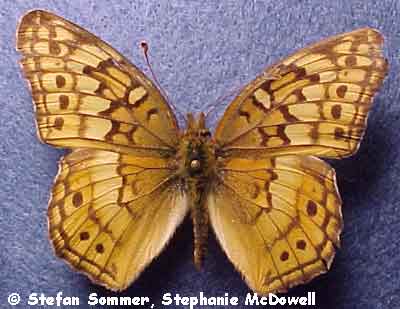
Variegated Fritillary
Family: Nymphalidae
Family Description:
Description:
Caterpillar: The caterpillar is entirely striped lengthwise with red bands and broken white lines. The red band along the top of the back is marked with white dashes. The body has black spines of uniform length, while the head has two longer black spines. It can reach a maximum length of 1 ź inches.
Adult: The butterfly is large, with a wingspan of 1 ž to 3 inches. The forewing may appear elongated. It is brownish orange on the upperside, marked with black wavy lines near the wing bases. The forewing has a row of black spots along the outer portion, followed by two black lines along the edge. The hindwing is marked similarly. Underneath, the forewing is orange near the base and mottled brown and white towards the outer edge; the hindwing is mottled brown and white, with white veins.
Range:
This species is a resident of parts of South and Central America, Mexico, and the southern U.S., from southern Arizona east to the Carolinas. It migrates throughout all of the U.S., except the Pacific Northwest, into the southern portion of Canada. In Idaho, it has been documented in three widely separated counties: Boundary, Oneida, and Caribou.
Habitat:
It frequents open areas, such as fields, meadows, and grasslands.
Diet:
Caterpillar: The caterpillar feeds on the leaves and flowers of a variety of plants from different families. Common host species include violets and pansies (Viola spp.), flax (Linum spp.), and passion flower (Passiflora spp.).
Adult: Butterflies drink flower nectar.
Ecology:
There are three generations of caterpillars each growing season in the northern part of its range, and four or more in the south. Adults overwinter in the south and fly north in the spring and summer months.
Reproduction:
Males actively patrol in search of receptive females. Females lay eggs singly on the leaves and stems of host plants.
Conservation:
| Global Rank: |
G5; populations are widespread, abundant, and secure. |
References:
Ferris, C. D. and F. M. Brown. (eds.) 1981. Butterflies of the Rocky Mountain States. Univ. of Oklahoma Press, Norman, Oklahoma, USA, 442 pp.
Opler, P. A., H. Pavulaan, and R. E. Stanford. 1995. Butterflies of North America. Jamestown, North Dakota, USA: Northern Prairie Wildlife Research Center Home Page. http://www.npwrc.usgs.gov/resource/distr/lepid/bflyusa/bflyusa.htm (Version 05Nov98).
Opler, P. A. and A. B.Wright. 1999. A Field Guide to the Western Butterflies. Second Edition. Peterson Field Guide Series. Houghton Mifflin Company, New York, New York, USA, 540 pp
Pyle, R. M. 1981. National Audubon Society Field Guide to North American Butterflies. Alfred A. Knopf, Inc., New York, New York, USA, 924 pp.
Scott, J. A. 1986. The Butterflies of North America. Stanford University Press, Stanford, California, USA, 583 pp.
Stanford, R. E. and P. A. Opler. 1993. Atlas of Western U.S.A. Butterflies (Including Adjacent Parts of Canada and Mexico). Published by authors, Denver, Colorado, USA, 275 pp.
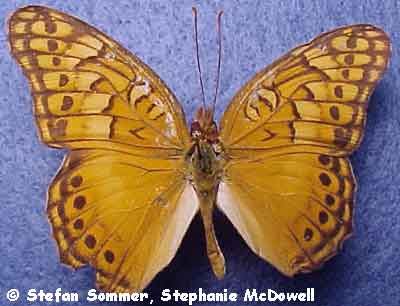
Mexican Fritillary
Family: Nymphalidae
Family Description:
Description:
Caterpillar: The caterpillar is red to maroon, marked along the back with two lines of black-rimmed, white spots, and a line of silver spots down the middle. The side is marked with a black and silver line. There are six rows of black spines on the body, and the head has two long black "horns."
Adult: The butterfly is medium-sized to large, with a wingspan of 2 to 3 inches. The upperside of the forewing is bright orange, marked with wavy black lines near the base, while the hindwing is solid orange and without markings near the base. The outer edge of the fore- and hindwing is lined with two black lines and a row of black spots. Underneath is orangish brown, with more orange at the base of the forewing, and marked similarly to the upperside but fainter.
Range:
This species is a resident of parts of Central and South America, Mexico, and some Pacific islands. It migrates into the U.S., primarily into the southern portions of California, Arizona, and Texas. It has been documented in Idaho, in Blaine County; this was probably a rare occurrence.
Habitat:
It can typically be found in open areas, such as fields and open woodlands.
Diet:
Caterpillar: The caterpillar feeds on passion flower (Passiflora foetida), turnera (Turnera ulmifolia), and morning glories (Ipomoea maritima).
Adult: Butterflies drink flower nectar.
Ecology:
There are many generations of caterpillars each year. Adults in the U.S. generally fly from April through Novemeber. Butterflies exhibit a fast and jerky flight near the ground.
Reproduction:
Males actively patrol in search of receptive females. Females lay eggs singly on host plants.
Conservation:
| Global Rank: |
G5; populations are widespread, abundant, and secure. |
References:
Opler, P. A., H. Pavulaan, and R. E. Stanford. 1995. Butterflies of North America. Jamestown, North Dakota, USA: Northern Prairie Wildlife Research Center Home Page. http://www.npwrc.usgs.gov/resource/distr/lepid/bflyusa/bflyusa.htm (Version 05Nov98).
Opler, P. A. and A. B.Wright. 1999. A Field Guide to the Western Butterflies. Second Edition. Peterson Field Guide Series. Houghton Mifflin Company, New York, New York, USA, 540 pp.
Pyle, R. M. 1981. National Audubon Society Field Guide to North American Butterflies. Alfred A. Knopf, Inc., New York, New York, USA, 924 pp.
Scott, J. A. 1986. The Butterflies of North America. Stanford University Press, Stanford, California, USA, 583 pp.
Stanford, R. E. and P. A. Opler. 1993. Atlas of Western U.S.A. Butterflies (Including Adjacent Parts of Canada and Mexico). Published by authors, Denver, Colorado, USA, 275 pp.
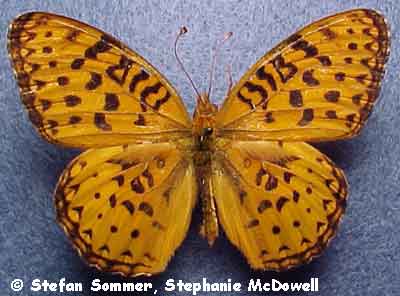
Aphrodite Fritillary
Family: Nymphalidae
Family Description:
Description:
Caterpillar: The caterpillar is dark brown and covered with spines. Most of the spines are yellowish brown except for those on the rear portion along the back, which are dark brown. All are black at the tips.
Adult: The Fritillaries as a group are very similar in appearance, and the differences between individual species are often minor and difficult to see. Positive identification to the species level is difficult and requires detailed examination. This is a large butterfly, with a wingspan of 2 to 3 1/4 inches. Its appearance varies between regions. The upperside is bright orange to orangish brown, and is outlined with either a thick black line or two thin black lines. The bases of the wings may appear clouded with brown or blackish brown. The forewing is marked with short, wavy black lines, three or four of which are nearly parallel on the leading edge. There is also a row of black spots, followed by a row of black, inverted "v"-shaped marks along the outside edge. The hindwing is similarly marked. The Aphrodite Fritillary has an extra spot at the base of the forewing near the trailing edge, and the wing veins are not thickly outlined with black as in most other Fritillaries. Underneath, the forewing is orange and marked with black as above. Additionally, it is marked with two silverish spots near the tip and a row of silverish triangles, tipped with brown or black, near the edge. The underside of the hindwing is reddish to light brown and has a narrow or faint yellow band near the outer edge; it is spotted with silver or whitish spots on either side of the yellow.
Range:
It ranges in Canada from southern British Columbia and central Alberta east to Nova Scotia. In the U.S., it ranges from northern Idaho and eastern Utah east to the Atlantic, extending south in the Appalachians to northern Georgia. It also occurs in patches of the southwest.
Habitat:
This species is found in a variety of habitats, including brushlands, open woodlands, mountain meadows, and prairies.
Diet:
Caterpillar: Caterpillars feed on the leaves of various violet species (Viola spp.).
Adult: Butterflies drink flower nectar, often from milkweeds (Asclepias spp.), thistles (Cirsium spp.), and dogbane (Apocynum spp.).
Ecology:
There is one new generation of caterpillars each year. Eggs hatch in the fall; the newly emerged caterpillars, having not yet fed, enter a physiological state called diapause to overwinter. In the spring the young caterpillars feed on the new leaves of host plants. Adults generally fly from the end of May through October. Fritillaries are long-lived for a butterfly, surviving several weeks to months.
Reproduction:
Males actively patrol in search of receptive females. pheromones, chemicals used to locate and attract the opposite sex, are produced by both male and female Fritillaries. These chemicals are believed to play an important role in assisting these butterflies to find and recognize other members of their own species. Eggs are laid singly under violet plants in the late summer to early fall. In cases where the violet plant has already withered and blown away, females are still able to lay their eggs near to where the host plant will reappear the next spring. This is possible, it is believed, because females are able to locate violet roots by smell!
Conservation:
| Global Rank: |
G5; populations are widespread, abundant, and secure. |
References:
Ferris, C.D. and F.M. Brown (eds.) 1981. Butterflies of the Rocky Mountain States. Univ. of Oklahoma Press, Norman, Oklahoma, USA, 442 pp.
Opler, P. A., H. Pavulaan, and R. E. Stanford. 1995. Butterflies of North America. Jamestown, North Dakota, USA: Northern Prairie Wildlife Research Center Home Page. http://www.npwrc.usgs.gov/resource/distr/lepid/bflyusa/bflyusa.htm (Version 05Nov98).
Opler, P. A. and A. B.Wright. 1999. A Field Guide to the Western Butterflies. Second Edition. Peterson Field Guide Series. Houghton Mifflin Company, New York, New York, USA, 540 pp.
Pyle, R. M. 1981. National Audubon Society Field Guide to North American Butterflies. Alfred A. Knopf, Inc., New York, New York, USA, 924 pp.
Scott, J. A. 1986. The Butterflies of North America. Stanford University Press, Stanford, California, USA, 583 pp.
Stanford, R. E. and P. A. Opler. 1993. Atlas of Western U.S.A. Butterflies (Including Adjacent Parts of Canada and Mexico). Published by authors, Denver, Colorado, USA, 275 pp.
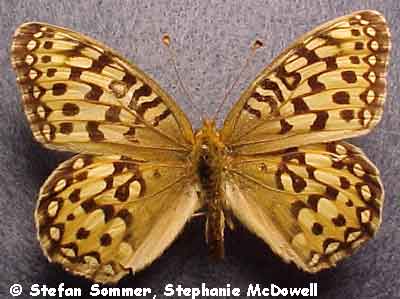
Callippe Fritillary
Family: Nymphalidae
Family Description:
Note: This species is comprised of a number of subspecies, including callippe, nevadensis, meadii, semivirda, and others.
Description:
Caterpillar: The caterpillar is gray marked with black, with a black head. The body is covered with bristly spines, either orange or black in color.
Adult: The Fritillaries as a group are very similar in appearance, and the differences between individual species are often minor and difficult to see. Positive identification to the species level is difficult and requires detailed examination. This is a medium-sized Fritillary, with a wingspan of 1 7/8 to 2 1/2 inches. Its appearance varies between regions. The upperside ranges from yellowish brown to orangish brown to reddish brown, and is edged with one or two black lines. The bases of the wings may appear clouded with brown or blackish brown. The forewing is marked with short, wavy black lines, three of which on the leading edge are nearly parallel; in between one or two pairs of the lines may be darker orange. There is also a row of black spots, followed by a row of black, inverted "v"-shaped marks along the outside edge. The wing veins are outlined thinly in black. The hindwing is similarly marked; the silver spots from the hindwing's underside may show through as pale patches or spots. Underneath, the forewing is yellow to yellowish orange, darker at the base, marked with black as above and with a row of silver spots or diamonds, tipped with brown or black, near the outer edge. One or two pairs of the short, wavy black lines along the leading edge have an orange patch in between the lines. The underside of the hindwing is golden brown to brown, possibly tinged with green. It is marked with large, oval-shaped silver spots, a curved band of yellow, followed by a curved row of silver triangles capped with brown or green, along the outside edge.
Range:
This is a western species, ranging from southern British Columbia, Alberta, and Manitoba, south to southern California, Nevada, Utah, and Colorado. In Idaho, it occurs throughout the southern half of the state and in a portion of the panhandle.
Habitat:
It is found in open, dry areas such as sagebrush steppe, chaparral, open woodlands, and prairies.
Diet:
Caterpillar: Caterpillars feed on the leaves of several species of violets (Viola spp.).
Adult: Butterflies drink flower nectar, often from thistle (Cirsium spp.).
Ecology:
There is one new generation of caterpillars each year. Eggs hatch in the fall; the newly emerged caterpillars, having not yet fed, enter a physiological state called diapause to overwinter. In the spring the young caterpillars feed on the new leaves of host plants. Adults generally fly from April through September. Fritillaries are long-lived for a butterfly, surviving several weeks to months.
Reproduction:
Seeking receptive females, males perch and actively patrol on hilltops in mornings and hillsides in afternoons. pheromones, chemicals used to locate and attract the opposite sex, are produced by both male and female Fritillaries. These chemicals are believed to play an important role in assisting these butterflies to find and recognize other members of their own species. Eggs are laid singly near host plants or under nearby shrubs. In cases where the violet plant has already withered and blown away, females are still able to lay their eggs near to where the host plant will reappear the next spring. This is possible, it is believed, because females are able to locate violet roots by smell!
Conservation:
| Global Rank: |
Varies with subspecies. S. callippe callippe of the San Francisco Bay area of California is ranked as T1, which means it is critically imperiled because of extreme rarity and is imminently vulnerable to extinction. |
References:
Ferris, C.D. and F.M. Brown (eds.) 1981. Butterflies of the Rocky Mountain States. Univ. of Oklahoma Press, Norman, Oklahoma, USA, 442 pp.
Opler, P. A., H. Pavulaan, and R. E. Stanford. 1995. Butterflies of North America. Jamestown, North Dakota, USA: Northern Prairie Wildlife Research Center Home Page. http://www.npwrc.usgs.gov/resource/distr/lepid/bflyusa/bflyusa.htm (Version 05Nov98).
Opler, P. A. and A. B.Wright. 1999. A Field Guide to the Western Butterflies. Second Edition. Peterson Field Guide Series. Houghton Mifflin Company, New York, New York, USA, 540 pp.
Pyle, R. M. 1981. National Audubon Society Field Guide to North American Butterflies. Alfred A. Knopf, Inc., New York, New York, USA, 924 pp.
Scott, J. A. 1986. The Butterflies of North America. Stanford University Press, Stanford, California, USA, 583 pp.
Stanford, R. E. and P. A. Opler. 1993. Atlas of Western U.S.A. Butterflies (Including Adjacent Parts of Canada and Mexico). Published by authors, Denver, Colorado, USA, 275 pp.
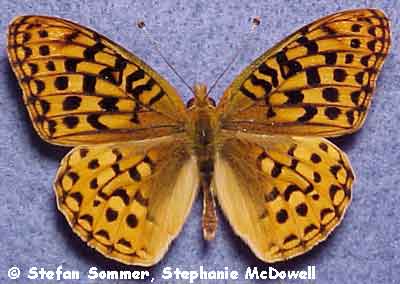
Coronis Fritillary
Family: Nymphalidae
Family Description:
Description:
Caterpillar: The caterpillar is mottled brown, black and gray, and is covered with branching spines. The spines on the sides are orange while those along the back are black tipped with orange.
Adult: The Fritillaries as a group are very similar in appearance, and the differences between individual species are often minor and difficult to see. Positive identification to the species level is difficult and requires detailed examination. This is a large Fritillary, with a wingspan of 2 to 3 3/8 inches. Its appearance varies between regions. The upperside ranges from brownish orange to reddish orange and is edged with one or two broken black lines. The forewing is marked with short, wavy black lines, three of which on the leading edge are nearly parallel. There is also a row of black spots, followed by a row of black, inverted "v"-shaped marks along the outside edge. The wing veins are outlined thinly in black. The hindwing is similarly marked. Underneath, the forewing is yellowish orange, possibly lighter yellow towards the tip. It is marked with black as above and with a row of silver spots or diamonds, some tipped with brown or black, near the outer edge; in some individuals, the spots are silver towards the leading edge and entirely brown towards the trailing edge. The underside of the hindwing is golden brown to yellowish orange, possibly tinged with green. It is marked with three curved rows of silver spots, the outermost row appearing either flattened or, less commonly, pointed; some or all of the silver spots may have halos of brown. Several small silver spots mark the wing base. Finally, the region between the middle and outermost rows of spots may be light yellow.
Range:
This species ranges from the Pacific Northwest south to southern California and Nevada, east to central Montana, western South Dakota and Nebraska, extending south to Utah and Colorado. In Idaho, it occurs in patches over most of the state except the extreme north.
Habitat:
It can be found in a variety of habitats, including chaparral, sagebrush steppe, open woodlands, and mountain foothills.
Diet:
Caterpillar: Caterpillars feed on the leaves of several species of violets (Viola spp.).
Adult: Butterflies drink flower nectar, often from thistle (Cirsium spp.). They have been observed drinking nectar for up to ten minutes at a single flower head.
Ecology:
There is one new generation of caterpillars each year. Eggs hatch in the fall; the newly emerged caterpillars, having not yet fed, enter a physiological state called diapause to overwinter. In the spring the young caterpillars feed on the new leaves of host plants. Adults generally fly from late May through October. In California, adult females have been observed entering diapause during the summer, then emerging in late August to September to lay eggs. Fritillaries are long-lived for a butterfly, surviving several weeks to months.
Reproduction:
Males patrol open areas in search of receptive females. pheromones, chemicals used to locate and attract the opposite sex, are produced by both male and female Fritillaries. These chemicals are believed to play an important role in assisting these butterflies to find and recognize other members of their own species. Eggs are laid singly near host plants. In cases where the violet plant has already withered and blown away, females are still able to lay their eggs near to where the host plant will reappear the next spring. This is possible, it is believed, because females are able to locate violet roots by smell!
Conservation:
| Global Rank: |
G5; populations are widespread, abundant, and secure. extinction. |
References:
Ferris, C.D. and F.M. Brown (eds.) 1981. Butterflies of the Rocky Mountain States. Univ. of Oklahoma Press, Norman, Oklahoma, USA, 442 pp.
Opler, P. A., H. Pavulaan, and R. E. Stanford. 1995. Butterflies of North America. Jamestown, North Dakota, USA: Northern Prairie Wildlife Research Center Home Page. http://www.npwrc.usgs.gov/resource/distr/lepid/bflyusa/bflyusa.htm (Version 05Nov98).
Opler, P. A. and A. B.Wright. 1999. A Field Guide to the Western Butterflies. Second Edition. Peterson Field Guide Series. Houghton Mifflin Company, New York, New York, USA, 540 pp.
Pyle, R. M. 1981. National Audubon Society Field Guide to North American Butterflies. Alfred A. Knopf, Inc., New York, New York, USA, 924 pp.
Scott, J. A. 1986. The Butterflies of North America. Stanford University Press, Stanford, California, USA, 583 pp.
Stanford, R. E. and P. A. Opler. 1993. Atlas of Western U.S.A. Butterflies (Including Adjacent Parts of Canada and Mexico). Published by authors, Denver, Colorado, USA, 275 pp.
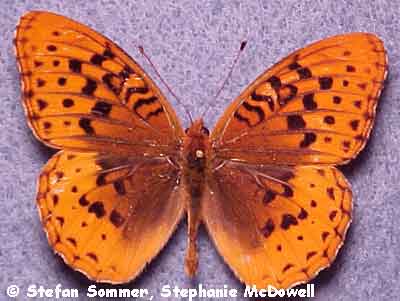
Great Spangled Fritillary
Family: Nymphalidae
Family Description:
Note: This species is comprised of a number of subspecies, including cybele, charlotti, leto, and others.
Description:
Caterpillar: The caterpillar is black and marked lengthwise along the back with two lines of gray dots. The head is dark brown, and the "neck" is reddish yellow. The body is covered with bristly spines colored orange at the base and black at the tips.
Adult: The Fritillaries as a group are very similar in appearance, and the differences between individual species are often minor and difficult to see. Positive identification to the species level is difficult and requires detailed examination. This is a large Fritillary, with a wingspan of 2 1/8 to 4 inches. The upperside of the male and some females is brownish orange to orange and is edged with one or two black lines. The bases of the wings may appear clouded with brown or blackish brown. The forewing is marked with short, wavy black lines, three or four of which on the leading edge are nearly parallel. There is no spot at the base of the forewing, below the short wavy lines, as in some Fritillaries. A thick, wavy black line runs vertically across the center of the wing. Additionally, there is a row of black spots, followed by a row of black, inverted "v"-shaped marks along the outside edge. The wing veins are outlined thinly in black. The hindwing is similarly marked. (Some females, especially in our area, are marked similarly to males except that the background color is golden yellow to pale yellow, and the wing bases are clouded heavily with black.) Underneath, the forewing is golden yellow to orange, often darker at the base, and marked as above. There may be several small silver spots at the tip. The hindwing is reddish brown at the base and spotted with different sized silver spots. At the edge of the brown is a curved row of silver spots, followed by a wide band of light yellow. The edge is marked with a second, curved row of silver spots, some possibly pointed, and a band of brown.
Range:
This species has a fairly extensive from southern British Columbia and central Alberta across the southern half of Canada to Nova Scotia; from the Pacific Northwest across the northern half of the U.S. to the Atlantic, extending south into central California, northern New Mexico, and northern Georgia. It occurs through much of Idaho.
Habitat:
Its preferred habitat includes woodlands, forests and forest openings, and moist meadows.
Diet:
Caterpillar: Caterpillars feed on the leaves of several species of violets (Viola spp.).
Adult: Butterflies drink nectar from a wide variety of flowers, and may obtain additional moisture and nutrients from dung.
Ecology:
There is one new generation of caterpillars each year. Eggs hatch in the fall; the newly emerged caterpillars, having not yet fed, enter a physiological state called diapause to overwinter. In the spring the young caterpillars feed on the new leaves of host plants. Adults generally fly from mid-June through September. Some adult females may enter a kind of diapause during the summer after mating. They re-emerge in late August or September to lay their eggs. Fritillaries are long-lived for a butterfly, surviving several weeks to months.
Reproduction:
Males patrol to find receptive females. pheromones, chemicals used to locate and attract the opposite sex, are produced by both male and female Fritillaries. These chemicals are believed to play an important role in assisting these butterflies to find and recognize other members of their own species. Eggs are laid singly near host plants. In cases where the violet plant has already withered and blown away, females are still able to lay their eggs near to where the host plant will reappear the next spring. This is possible, it is believed, because females are able to locate violet roots by smell!
Conservation:
| Global Rank: |
G5; most populations are widespread, abundant, and secure. Western populations, however, may be declining due to destruction of habitat. |
References:
Ferris, C.D. and F.M. Brown (eds.) 1981. Butterflies of the Rocky Mountain States. Univ. of Oklahoma Press, Norman, Oklahoma, USA, 442 pp.
Opler, P. A., H. Pavulaan, and R. E. Stanford. 1995. Butterflies of North America. Jamestown, North Dakota, USA: Northern Prairie Wildlife Research Center Home Page. http://www.npwrc.usgs.gov/resource/distr/lepid/bflyusa/bflyusa.htm (Version 05Nov98).
Opler, P. A. and A. B.Wright. 1999. A Field Guide to the Western Butterflies. Second Edition. Peterson Field Guide Series. Houghton Mifflin Company, New York, New York, USA, 540 pp.
Pyle, R. M. 1981. National Audubon Society Field Guide to North American Butterflies. Alfred A. Knopf, Inc., New York, New York, USA, 924 pp.
Scott, J. A. 1986. The Butterflies of North America. Stanford University Press, Stanford, California, USA, 583 pp.
Stanford, R. E. and P. A. Opler. 1993. Atlas of Western U.S.A. Butterflies (Including Adjacent Parts of Canada and Mexico). Published by authors, Denver, Colorado, USA, 275 pp.
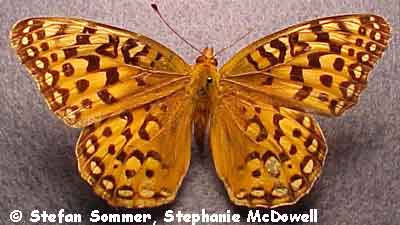
Edwards’ Fritillary
Family: Nymphalidae
Family Description:
Alternate Common Name: Green Fritillary.
Description:
Caterpillar: The caterpillar is yellow on top and gray mottled with orange on the sides. It is covered with both greenish and yellow spines, with a white-ringed black patch at the base of each. The head is dark brown and the region behind the head is yellow.
Adult: The Fritillaries as a group are very similar in appearance, and the differences between individual species are often minor and difficult to see. Positive identification to the species level is difficult and requires detailed examination. This is a large Fritillary, with a wingspan of 2 3/8 to 3 3/8 inches. The upperside ranges from golden orange to orange, and is edged with a thick black line spotted with yellow. The bases of the wings may appear clouded with brown. The forewing is marked with four to five short, wavy black lines on the leading edge, most of which are nearly parallel. A thick, wavy black line runs vertically across the center of the wing, followed by a row of black spots. The wing veins are outlined thinly in black. The hindwing is marked similarly. Underneath, the forewing is rosy orange near the base, light yellow towards the tip, and bordered with olive green. It is marked with brown as above, and additionally with silver spots or triangles in the border and at the tip. The underside of the hindwing is yellowish olive green and is marked with brown wing veins and many large silver spots. A curved row of flattened silver spots lines the edge.
Range:
This species of Fritillary has a fairly small range, from southern Alberta and Manitoba south to northern New Mexico. It has been documented to occur in Idaho only in Franklin County.
Habitat:
It occurs in prairies and grasslands, forest openings, and chaparral.
Diet:
Caterpillar: Caterpillars feed on the leaves of violets (Viola spp.), especially V. adunca and V. nuttallii.
Adult: Butterflies drink flower nectar, often from thistles (Cirsium spp.) and dogbane (Apocynum spp.), and may obtain additional moisture and nutrients from dung.
Ecology:
There is one new generation of caterpillars each year. Eggs hatch in the fall; the newly emerged caterpillars, having not yet fed, enter a physiological state called diapause to overwinter. In the spring the young caterpillars feed on the new leaves of host plants. Adults generally fly from mid-May through late October. Fritillaries are long-lived for a butterfly, surviving several weeks to months.
Reproduction:
Males patrol in search of receptive females in open areas. pheromones, chemicals used to locate and attract the opposite sex, are produced by both male and female Fritillaries. These chemicals are believed to play an important role in assisting these butterflies to find and recognize other members of their own species. Eggs are laid singly near host plants. In cases where the violet plant has already withered and blown away, females are still able to lay their eggs near to where the host plant will reappear the next spring. This is possible, it is believed, because females are able to locate violet roots by smell!
Conservation:
| Global Rank: |
G5; populations are widespread, abundant, and secure. |
References:
Ferris, C.D. and F.M. Brown (eds.) 1981. Butterflies of the Rocky Mountain States. Univ. of Oklahoma Press, Norman, Oklahoma, USA, 442 pp.
Opler, P. A., H. Pavulaan, and R. E. Stanford. 1995. Butterflies of North America. Jamestown, North Dakota, USA: Northern Prairie Wildlife Research Center Home Page. http://www.npwrc.usgs.gov/resource/distr/lepid/bflyusa/bflyusa.htm (Version 05Nov98).
Opler, P. A. and A. B.Wright. 1999. A Field Guide to the Western Butterflies. Second Edition. Peterson Field Guide Series. Houghton Mifflin Company, New York, New York, USA, 540 pp.
Pyle, R. M. 1981. National Audubon Society Field Guide to North American Butterflies. Alfred A. Knopf, Inc., New York, New York, USA, 924 pp.
Scott, J. A. 1986. The Butterflies of North America. Stanford University Press, Stanford, California, USA, 583 pp.
Stanford, R. E. and P. A. Opler. 1993. Atlas of Western U.S.A. Butterflies (Including Adjacent Parts of Canada and Mexico). Published by authors, Denver, Colorado, USA, 275 pp.
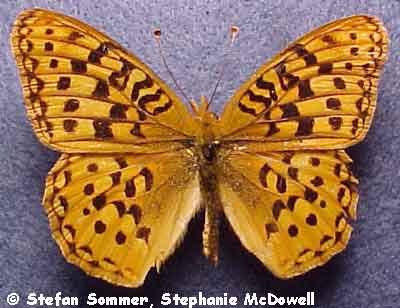
Great Basin Fritillary
Family: Nymphalidae
Family Description:
Alternate Common Name: Egleis Fritillary.
Description:
Caterpillar: The caterpillar is grayish brown, marked with yellow and black along the back, and has a black head. The body is covered with bristly spines, colored yellow or white at the base and black at the tip.
Adult: The Fritillaries as a group are very similar in appearance, and the differences between individual species are often minor and difficult to see. Positive identification to the species level is difficult and requires detailed examination. This is a small to medium-sized Fritillary, with a wingspan of 1 1/2 to 2 3/8 inches. Its appearance varies between regions. Generally, the upperside is orangish brown, or brown with a wide band of yellow along the outer half of the wings. It is marked with black: along the leading edge with four or five short, wavy, nearly parallel lines; a vertical, wavy and winding band across the center; a row of spots, followed by a row of inverted "v"-shaped marks along the outside edge; and two thin lines on the border. The hindwing is similarly marked. Underneath has a distinctive smoky or hazy appearance. The underside of the forewing is pale yellow to brownish yellow, possibly tinged with orange at the base. It is marked as above and also with several small silver or white spots at the tip and along the upper half of the edge. The underside of the hindwing is golden brown but may be tinged with reddish brown or grayish green. It is marked with several silver or white spots near the base, followed by a vertical, curved row of white spots across the center, followed by a band of yellow, and finally with a curved row of white flattened or triangular spots, capped with greenish brown, along the outside edge.
Range:
This species ranges from Washington south to California, and from Idaho and western Montana south to northeastern Nevada, central Utah, and northern Colorado.
Habitat:
It occurs in forest openings and on open, rocky ridges.
Diet:
Caterpillar: Caterpillars feed on the leaves of several species of violets (Viola spp.).
Adult: Butterflies drink flower nectar.
Ecology:
There is one new generation of caterpillars each year. Eggs hatch in the fall; the newly emerged caterpillars, having not yet fed, enter a physiological state called diapause to overwinter. In the spring the young caterpillars feed on the new leaves of host plants. Adults generally fly from the first of June to October. Butterflies often congregate on hilltops and at mud puddles. Fritillaries are long-lived for a butterfly, surviving several weeks to months.
Reproduction:
Males actively patrol low to the ground in search of receptive females. pheromones, chemicals used to locate and attract the opposite sex, are produced by both male and female Fritillaries. These chemicals are believed to play an important role in assisting these butterflies to find and recognize other members of their own species. Eggs are laid singly near host plants. In cases where the violet plant has already withered and blown away, females are still able to lay their eggs near to where the host plant will reappear the next spring. This is possible, it is believed, because females are able to locate violet roots by smell!
Conservation:
| Global Rank: |
G5; populations are widespread, abundant, and secure. |
References:
Ferris, C.D. and F.M. Brown (eds.) 1981. Butterflies of the Rocky Mountain States. Univ. of Oklahoma Press, Norman, Oklahoma, USA, 442 pp.
Opler, P. A., H. Pavulaan, and R. E. Stanford. 1995. Butterflies of North America. Jamestown, North Dakota, USA: Northern Prairie Wildlife Research Center Home Page. http://www.npwrc.usgs.gov/resource/distr/lepid/bflyusa/bflyusa.htm (Version 05Nov98).
Opler, P. A. and A. B.Wright. 1999. A Field Guide to the Western Butterflies. Second Edition. Peterson Field Guide Series. Houghton Mifflin Company, New York, New York, USA, 540 pp.
Pyle, R. M. 1981. National Audubon Society Field Guide to North American Butterflies. Alfred A. Knopf, Inc., New York, New York, USA, 924 pp.
Scott, J. A. 1986. The Butterflies of North America. Stanford University Press, Stanford, California, USA, 583 pp.
Stanford, R. E. and P. A. Opler. 1993. Atlas of Western U.S.A. Butterflies (Including Adjacent Parts of Canada and Mexico). Published by authors, Denver, Colorado, USA, 275 pp.
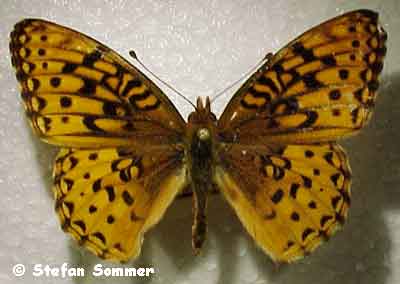
Speyeria hesperis
Family: Nymphalidae
Family Description:
Note: Some authors consider this species to be a subspecies of Speyeria atlantis; the two are difficult to distinguish where their ranges overlap.
Description:
Caterpillar: The caterpillar is generally black and marked lengthwise with two brownish stripes along the back. It is covered with yellowish to orange spines tipped with black.
Adult: The Fritillaries as a group are very similar in appearance, and the differences between individual species are often minor and difficult to see. Positive identification to the species level is difficult and requires detailed examination. This is a medium-sized Fritillary, with a wingspan of 2 to 2 ¾ inches. Its appearance may vary between regions. Generally, the upperside is orangish brown and outlined, possibly faintly, with either a thick black line or two thin black lines. The bases of the wings may appear clouded with brown or blackish brown. The forewing is marked with short, wavy black lines, three of which on the leading edge are nearly parallel. There is also a row of black spots, followed by a row of black, inverted "v"-shaped marks along the outside edge. The wing veins may be outlined in black. The hindwing is similarly marked. Underneath, the forewing is orange at the base and pale orange to yellow at the tip, marked with black as above and with a row of silver or white triangles, tipped with brown or black, near the outer edge. The hindwing is reddish to orangish brown and marked with a yellow band near the outer edge; it is spotted with silver or white spots.
Range:
This species ranges from Alaska south and east through Canada to southern Manitoba, extending into the U.S. in patches of the Pacific Northwest to central California, and from northern Idaho and western Montana south to Arizona and New Mexico.
Habitat:
It occurs in cool environments such as moist meadows north-facing slopes.
Diet:
Caterpillar: Caterpillars feed on the leaves of several species of violets (Viola spp.).
Adult: Butterflies drink flower nectar, often from mints (Mentha spp.) and yellow flowers belonging to the sunflower family (Asteraceae). Additional moisture and nutrients may also be obtained from mud and dung.
Ecology:
There is one new generation of caterpillars each year. Eggs hatch in the fall; the newly emerged caterpillars, having not yet fed, enter a physiological state called diapause to overwinter. In the spring the young caterpillars feed on the new leaves of host plants. Adults generally fly from June through October. Fritillaries are long-lived for a butterfly, surviving several weeks to months.
Reproduction:
Males actively patrol in search of receptive females in open areas. pheromones, chemicals used to locate and attract the opposite sex, are produced by both male and female Fritillaries. These chemicals are believed to play an important role in assisting these butterflies to find and recognize other members of their own species. Eggs are laid singly near host plants. In cases where the violet plant has already withered and blown away, females are still able to lay their eggs near to where the host plant will reappear the next spring. This is possible, it is believed, because females are able to locate violet roots by smell!
Conservation:
| Global Rank: |
G5; populations are widespread, abundant, and secure. |
References:
Ferris, C.D. and F.M. Brown (eds.) 1981. Butterflies of the Rocky Mountain States. Univ. of Oklahoma Press, Norman, Oklahoma, USA, 442 pp.
Opler, P. A., H. Pavulaan, and R. E. Stanford. 1995. Butterflies of North America. Jamestown, North Dakota, USA: Northern Prairie Wildlife Research Center Home Page. http://www.npwrc.usgs.gov/resource/distr/lepid/bflyusa/bflyusa.htm (Version 05Nov98).
Opler, P. A. and A. B.Wright. 1999. A Field Guide to the Western Butterflies. Second Edition. Peterson Field Guide Series. Houghton Mifflin Company, New York, New York, USA, 540 pp.
Pyle, R. M. 1981. National Audubon Society Field Guide to North American Butterflies. Alfred A. Knopf, Inc., New York, New York, USA, 924 pp.
Scott, J. A. 1986. The Butterflies of North America. Stanford University Press, Stanford, California, USA, 583 pp.
Stanford, R. E. and P. A. Opler. 1993. Atlas of Western U.S.A. Butterflies (Including Adjacent Parts of Canada and Mexico). Published by authors, Denver, Colorado, USA, 275 pp.
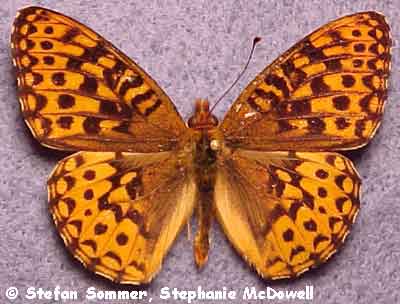
Hydaspe Fritillary
Family: Nymphalidae
Family Description:
Alternate Common Name: Lavender Fritillary.
Description:
Caterpillar: The caterpillar is black with black and covered with spines, black ones along the back and orangish brown ones, tipped with black, on the sides.
Adult: The Fritillaries as a group are very similar in appearance, and the differences between individual species are often minor and difficult to see. Positive identification to the species level is difficult and requires detailed examination. This is a medium-sized Fritillary, with a wingspan of 1 ¾ to 2 ½ inches. Its appearance somewhat varies between regions. Generally, the upperside is orangish brown, with darker brown at the bases of the wings. The forewing is marked extensively with black: along the leading edge with four or five short, wavy, nearly parallel lines; a thick, vertical, wavy and winding band across the center; a row of spots, followed by a row of inverted "v"-shaped marks along the outside edge; and two thin lines on the border. The hindwing is similarly marked. Underneath, the forewing is golden yellow to light brown, possibly tinged with orange at the base and with lavender at the tip. It is marked as above but the spots along the upper half of the edge are beige. The underside of the hindwing is yellowish to golden brown to brown, possibly tinged with reddish brown or maroon at the base, and marked with many large beige (possibly silver) spots, some capped with brown; the spots on the outer half of the wing are arranged in two curved rows, with a band of yellow in between.
Range:
This species ranges from central British Columbia and southwestern Alberta south to California and east to western Montana and Colorado excluding most of Nevada and Utah. In Idaho, it can be found in much of the southern half of the state.
Habitat:
It typically occurs in moist woodlands, often with aspens, and mountain meadows.
Diet:
Caterpillar: Caterpillars feed on the leaves of several species of violets (Viola spp.).
Adult: Butterflies drink flower nectar, often from yellow flowers.
Ecology:
There is one new generation of caterpillars each year. Eggs hatch in the fall; the newly emerged caterpillars, having not yet fed, enter a physiological state called diapause to overwinter. In the spring the young caterpillars feed on the new leaves of host plants. Adults generally fly from June to September. Fritillaries are long-lived for a butterfly, surviving several weeks to months.
Reproduction:
It has not been reported whether males actively patrol or perch to wait for receptive females; however, most males of other Fritillary species patrol. pheromones, chemicals used to locate and attract the opposite sex, are produced by both male and female Fritillaries. These chemicals are believed to play an important role in assisting these butterflies to find and recognize other members of their own species. Eggs are laid singly and randomly near host plants. In cases where the violet plant has already withered and blown away, females are still able to lay their eggs near to where the host plant will reappear the next spring. This is possible, it is believed, because females are able to locate violet roots by smell!
Conservation:
| Global Rank: |
G5; populations are widespread, abundant, and secure. |
References:
Ferris, C.D. and F.M. Brown (eds.) 1981. Butterflies of the Rocky Mountain States. Univ. of Oklahoma Press, Norman, Oklahoma, USA, 442 pp.
Opler, P. A., H. Pavulaan, and R. E. Stanford. 1995. Butterflies of North America. Jamestown, North Dakota, USA: Northern Prairie Wildlife Research Center Home Page. http://www.npwrc.usgs.gov/resource/distr/lepid/bflyusa/bflyusa.htm (Version 05Nov98).
Opler, P. A. and A. B.Wright. 1999. A Field Guide to the Western Butterflies. Second Edition. Peterson Field Guide Series. Houghton Mifflin Company, New York, New York, USA, 540 pp.
Pyle, R. M. 1981. National Audubon Society Field Guide to North American Butterflies. Alfred A. Knopf, Inc., New York, New York, USA, 924 pp.
Scott, J. A. 1986. The Butterflies of North America. Stanford University Press, Stanford, California, USA, 583 pp.
Stanford, R. E. and P. A. Opler. 1993. Atlas of Western U.S.A. Butterflies (Including Adjacent Parts of Canada and Mexico). Published by authors, Denver, Colorado, USA, 275 pp.
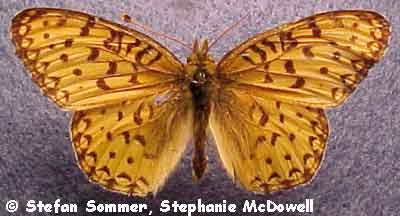
Mormon Fritillary
Family: Nymphalidae
Family Description:
Description:
Caterpillar: The caterpillar is grayish brown to light brown, striped lengthwise along the back with black, and covered with short, light colored spines.
Adult: The Fritillaries as a group are very similar in appearance, and the differences between individual species are often minor and difficult to see. Positive identification to the species level is difficult and requires detailed examination. This is a medium-sized butterfly, small for a Fritillary, with a wingspan of 1 1/2 to 2 3/8 inches. The tips of the forewings appear rounded. Its appearance varies somewhat between regions. The upperside ranges from golden orange to orangish brown, and is edged with one thick or two thin black lines. The forewing is marked with short, wavy, nearly parallel black lines. There is a vertical, wide, wavy and wandering black line across the wing’s center, followed by a row of black spots, followed by a row of black, inverted "v"-shaped marks, each possibly capping a yellow spot (sometimes absent), along the outside edge. The wing veins are outlined thinly in black, or not at all. The hindwing is similarly marked. Underneath, the forewing is golden yellow, tinged with orange at the base. It is marked as above, and additionally with light yellow, white, or silver spots at the tip and along the upper half of the outer edge. The underside of the hindwing ranges from reddish brown to light brown to greenish brown, and is marked with pale spots, either yellow, white, or silver; the spots on the outer half of the wing are arranged in two curved rows, with a band of yellow in between.
Range:
This species ranges from southern Alaska south to California, Utah, most of Idaho, and northern New Mexico, and east to southwestern Manitoba.
Habitat:
It can be found in middle and high elevation meadows, sagebrush steppe, and prairies.
Diet:
Caterpillar: Caterpillars feed on the leaves of several species of violets (Viola spp.).
Adult: Butterflies drink flower nectar, and obtain additional moisture and salts from mud.
Ecology:
There is one new generation of caterpillars each year. Eggs hatch in the fall; the newly emerged caterpillars, having not yet fed, enter a physiological state called diapause to overwinter. In the spring the young caterpillars feed on the new leaves of host plants. Adults generally fly from the first of June through October. The butterflies are capable of flying significant distances. Fritillaries are long-lived for a butterfly, surviving several weeks to months.
Reproduction:
Males actively patrol low to the ground in search of receptive females. pheromones, chemicals used to locate and attract the opposite sex, are produced by both male and female Fritillaries. These chemicals are believed to play an important role in assisting these butterflies to find and recognize other members of their own species. Eggs are laid singly and randomly near host plants. In cases where the violet plant has already withered and blown away, females are still able to lay their eggs near to where the host plant will reappear the next spring. This is possible, it is believed, because females are able to locate violet roots by smell!
Conservation:
| Global Rank: |
G5; populations are widespread, abundant, and secure. |
References:
Ferris, C.D. and F.M. Brown (eds.) 1981. Butterflies of the Rocky Mountain States. Univ. of Oklahoma Press, Norman, Oklahoma, USA, 442 pp.
Opler, P. A., H. Pavulaan, and R. E. Stanford. 1995. Butterflies of North America. Jamestown, North Dakota, USA: Northern Prairie Wildlife Research Center Home Page. http://www.npwrc.usgs.gov/resource/distr/lepid/bflyusa/bflyusa.htm (Version 05Nov98).
Opler, P. A. and A. B.Wright. 1999. A Field Guide to the Western Butterflies. Second Edition. Peterson Field Guide Series. Houghton Mifflin Company, New York, New York, USA, 540 pp.
Pyle, R. M. 1981. National Audubon Society Field Guide to North American Butterflies. Alfred A. Knopf, Inc., New York, New York, USA, 924 pp.
Scott, J. A. 1986. The Butterflies of North America. Stanford University Press, Stanford, California, USA, 583 pp.
Stanford, R. E. and P. A. Opler. 1993. Atlas of Western U.S.A. Butterflies (Including Adjacent Parts of Canada and Mexico). Published by authors, Denver, Colorado, USA, 275 pp.
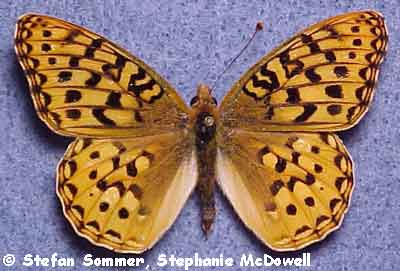
Zerene Fritillary
Family: Nymphalidae
Family Description:
Note: This species is comprised of many subspecies.
Description:
Caterpillar: The caterpillar varies in color from yellowish gray to orange, and has a black head. It is heavily marked with brown or black patches and with a dark (possibly light) line down the midline. The body is covered with grayish spines.
Adult: The Fritillaries as a group are very similar in appearance, and the differences between individual species are often minor and difficult to see. Positive identification to the species level is difficult and requires detailed examination. This is a medium-sized Fritillary, with a wingspan of 1 7/8 to 2 3/4 inches. Its appearance varies somewhat regionally. The upperside ranges in color from golden orange to reddish orange to orangish brown and is bordered with two thin black lines. The forewing is marked with short, wavy, nearly parallel black lines. There is a vertical, wide, wavy and wandering black line across the wing’s center, followed by a row of black spots, followed by a row of black, inverted "v"-shaped marks along the outside edge. The wing veins are outlined thinly in black, and the hindwing is similarly marked. Underneath, the forewing is golden yellow, tinged with orange at the base, and with several small patches of brown at the tip. It is marked as above, but also with several silver spots at the tip and along the upper half of the outer edge. The hindwing is usually brown and may be edged with a wide yellow band. The base may be tinged with violet, green, or yellow (often in our area). It is marked with large silver, possibly white or yellow, spots. The spots on the outer half of the wing are arranged in two curved rows; the spots in the outermost row appear flattened.
Range:
This species ranges from the coast of British Columbia south to California, east to Montana, western Nebraska, and northeastern Colorado. It occurs through most of Idaho.
Habitat:
It occurs in a variety of habitats, including coastal dunes and meadows, conifer forests, and sagebrush steppe.
Diet:
Caterpillar: Caterpillars feed on the leaves of several species of violets (Viola spp.).
Adult: Butterflies drink flower nectar.
Ecology:
There is one new generation of caterpillars each year. Eggs hatch in the fall; the newly emerged caterpillars, having not yet fed, enter a physiological state called diapause to overwinter. In the spring the young caterpillars feed on the new leaves of host plants. The caterpillar has needle-like extensions on its spines which are hinged and can be folded upward by the caterpillar. The caterpillar is also equipped with a gland which releases a musky smell that may be repulsive to ants. Adults generally fly from the end of May to September. In California, adult females have been observed entering diapause during the summer before laying eggs, then emerging in late August to September to oviposit. Fritillaries are long-lived for a butterfly, surviving several weeks to months.
Reproduction:
Males patrol all day in search of receptive females. pheromones, chemicals used to locate and attract the opposite sex, are produced by both male and female Fritillaries. These chemicals are believed to play an important role in assisting these butterflies to find and recognize other members of their own species. Eggs are laid singly near host plants. In cases where the violet plant has already withered and blown away, females are still able to lay their eggs near to where the host plant will reappear the next spring. This is possible, it is believed, because females are able to locate violet roots by smell!
Conservation:
| Global Rank: |
Varies with subspecies. Speyeria zerene hippolyta, the Oregon Silverspot, of the Pacific Northwest coast is listed as T1, which means it is critically imperiled because of extreme rarity and is imminently vulnerable to extinction. Additionally, California subspecies myrtleae, the Myrtle’s Silverspot, and subspecies behrensii, Behren’s Silverspot, are both listed as Endangered by the U.S. Fish and Wildlife Service. |
References:
Ferris, C.D. and F.M. Brown (eds.) 1981. Butterflies of the Rocky Mountain States. Univ. of Oklahoma Press, Norman, Oklahoma, USA, 442 pp.
Opler, P. A., H. Pavulaan, and R. E. Stanford. 1995. Butterflies of North America. Jamestown, North Dakota, USA: Northern Prairie Wildlife Research Center Home Page. http://www.npwrc.usgs.gov/resource/distr/lepid/bflyusa/bflyusa.htm (Version 05Nov98).
Opler, P. A. and A. B.Wright. 1999. A Field Guide to the Western Butterflies. Second Edition. Peterson Field Guide Series. Houghton Mifflin Company, New York, New York, USA, 540 pp.
Pyle, R. M. 1981. National Audubon Society Field Guide to North American Butterflies. Alfred A. Knopf, Inc., New York, New York, USA, 924 pp.
Scott, J. A. 1986. The Butterflies of North America. Stanford University Press, Stanford, California, USA, 583 pp.
Stanford, R. E. and P. A. Opler. 1993. Atlas of Western U.S.A. Butterflies (Including Adjacent Parts of Canada and Mexico). Published by authors, Denver, Colorado, USA, 275 pp.
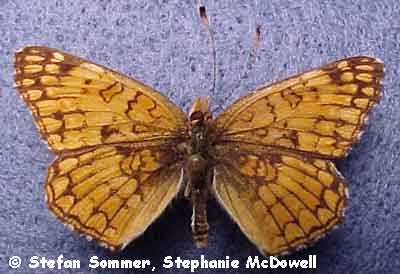
Sagebrush Checkerspot
Family: Nymphalidae
Family Description:
Alternate Common Name: Acastus Checkerspot.
Note: This is really a complex comprised of several species or subspecies, including C. neumoegeni and possibly others. This species is referred to by the genus name Charidryas by some authors.
Description:
Caterpillar: The caterpillar is black, covered with spines, and marked with off-white dots and rows of orange crescent-shaped spots along each side.
Adult: This is a medium-sized butterfly, with a wingspan of 1 ¼ to 2 inches. The upperside of the butterfly is checked with orange, yellowish orange, brown, and black; some females may be brownish black with checks of yellow only. The hindwing has three outer rows of orangish checks, the middle of which is the darkest. There is also dark shading where the hindwing attaches to the body. The underside of the forewing is orange marked with black, sometimes with several white checks at the tip and along the edge. The underside of the hindwing is marked with alternating bands of white and orange, divided into checks by black lines.
Range:
This species ranges from eastern Washington to eastern North Dakota, and south through eastern California over to northern New Mexico. In Idaho, it has been documented primarily in the southwest and eastern portions of the state.
Habitat:
It is found in dry habitats including sagebrush steppe and pinyon-juniper woodlands.
Diet:
Caterpillar: Caterpillars eat the leaves and flowers of rabbit brush (Chrysothamnus viscidiflorus) and other members of the sunflower family (Asteraceae).
Adult: Butterflies drink flower nectar.
Ecology:
The caterpillars feed in groups. There may be one to three generations of caterpillars each summer, the last of which overwinters under rocks in a physiological state called diapause. Some caterpillars may remain in diapause for multiple seasons or years before emerging to continue feeding and to pupate. Adults generally fly from February through November.
Reproduction:
Males perch to wait for receptive females, or they may actively patrol in search of them. Females lay groups of eggs on the bottomsides of leaves of host plants, and occasionally on flower buds.
Conservation:
| Global Rank: |
G4; population levels are secure, but may be of concern in the future. |
References:
Ferris, C. D. and F. M. Brown. (eds.) 1981. Butterflies of the Rocky Mountain States. Univ. of Oklahoma Press, Norman, Oklahoma, USA, 442 pp.
Opler, P. A., H. Pavulaan, and R. E. Stanford. 1995. Butterflies of North America. Jamestown, North Dakota, USA: Northern Prairie Wildlife Research Center Home Page. http://www.npwrc.usgs.gov/resource/distr/lepid/bflyusa/bflyusa.htm (Version 05Nov98).
Opler, P. A. and A. B.Wright. 1999. A Field Guide to the Western Butterflies. Second Edition. Peterson Field Guide Series. Houghton Mifflin Company, New York, New York, USA, 540 pp.
Pyle, R. M. 1981. National Audubon Society Field Guide to North American Butterflies. Alfred A. Knopf, Inc., New York, New York, USA, 924 pp.
Scott, J. A. 1986. The Butterflies of North America. Stanford University Press, Stanford, California, USA, 583 pp.
Stanford, R. E. and P. A. Opler. 1993. Atlas of Western U.S.A. Butterflies (Including Adjacent Parts of Canada and Mexico). Published by authors, Denver, Colorado, USA, 275 pp.
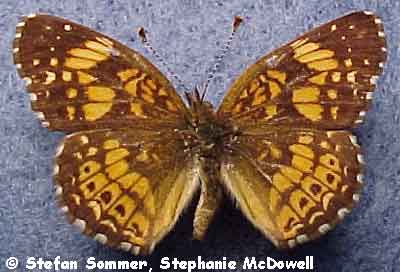
Gorgone Checkerspot
Note: This species is referred to by the genus name Charidryas by some authors.
Alternate Common Name: Great Plains Checkerspot.
Family: Nymphalidae.
Description:
- Caterpillar: The caterpillar can be one of three types: 1) bicolor – striped lengthwise with black and orange, the black dotted with white; 2) nigra – mostly black, with thin yellow stripes; or 3) rufa – uniformly orange. All are lined with branching, black spines.
- Adult: The butterfly is medium-sized, with a wingspan of 1 1/8 to 1 3/4 inches. Its upperside is orange marked with black, with a broken white edge on the wings. The inner portion of each of the wings is marbled with black. The forewing has more black at the tip while the hindwing has a row of black spots just in from the edge. Underneath, the forewing is shaded orange and marked with wavy brown lines. The underside of the hindwing is marbled with orange, white, and brown, and there is a line of white ">’s" down the center.
Range: This species spans a large portion of the central third of North America. It ranges from southeastern Alberta across to southern Ontario, south through the Great Plains states to northeastern New Mexico and northern Texas, and occurs in patches in the Rockies, the Appalachians, and the southeastern U.S. It has been documented to occur in south central Idaho.
Habitat:
It occurs in open areas such as fields, prairies, forest edges, and openings.
Diet:
- Caterpillar: The caterpillars feed on the leaves of members of the sunflower family (Asteraceae), such as sunflower (Helianthus spp.).
- Adult: Butterflies drink nectar, most frequently from yellow flowers.
Ecology:
Caterpillars feed in groups when young, often on the underside of leaves. The number of generations of caterpillars each year depends on the location, with there being only one in the north, three in the south, and two elsewhere. Young caterpillars overwinter in a physiological state called diapause, and emerge in the spring to feed, molt, and eventually pupate. In the case of multiple generations, only the last generation of caterpillars overwinters. Adults generally fly from the end of April through mid-July in the northern part of its range, flying until mid-October in the southern part of its range.
Reproduction:
Males perch to wait for receptive females, or may actively patrol for them. Females lay groups of cream-colored eggs on the bottomsides of leaves of host plants.
Conservation:
| Global Rank: |
G4; population levels are secure, but may be of concern in the future. |
References:
Ferris, C. D. and F. M. Brown. (eds.) 1981. Butterflies of the Rocky Mountain States. Univ. of Oklahoma Press, Norman, Oklahoma, USA, 442 pp.
Opler, P. A., H. Pavulaan, and R. E. Stanford. 1995. Butterflies of North America. Jamestown, North Dakota, USA: Northern Prairie Wildlife Research Center Home Page. http://www.npwrc.usgs.gov/resource/distr/lepid/bflyusa/bflyusa.htm (Version 05Nov98).
Opler, P. A. and A. B.Wright. 1999. A Field Guide to the Western Butterflies. Second Edition. Peterson Field Guide Series. Houghton Mifflin Company, New York, New York, USA, 540 pp.
Pyle, R. M. 1981. National Audubon Society Field Guide to North American Butterflies. Alfred A. Knopf, Inc., New York, New York, USA, 924 pp.
Scott, J. A. 1986. The Butterflies of North America. Stanford University Press, Stanford, California, USA, 583 pp.
Stanford, R. E. and P. A. Opler. 1993. Atlas of Western U.S.A. Butterflies (Including Adjacent Parts of Canada and Mexico). Published by authors, Denver, Colorado, USA, 275 pp.
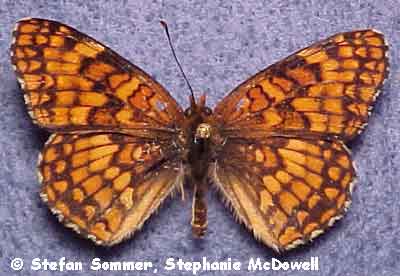
Northern Checkerspot
Note: This species is referred to by the genus name Charidryas by some authors.
Alternate Common Names:Creamy Checkerspot, Pale Checkerspot.
Family: Nymphalidae.
Description:
- Caterpillar: The caterpillar is black and covered with spines. It is lined with rows of white dots and orange dash marks.
- Adult: The butterfly is medium-sized, with a wingspan of 1 1/4 to 1 7/8 inches. The upperside is orange to red divided into checks with blackish brown lines. The wings have a lighter band of yellowish orange half way in from the edge, and the outside edges are checked with alternating white and brown. Underneath is brownish orange with bands of off-white and brown. Some females occur with an alternate color pattern: the upperside of the wings predominantly brownish-black and marked with light yellow to white spots or checks.
Range: A western species, it ranges from southern British Columbia and Alberta south through most of California and south to northern Utah and western Colorado. It occurs throughout most of Idaho.
Habitat:
This species tends to occur in open areas such as sagebrush steppe, chaparral, meadows, and open woodlands.
Diet:
- Caterpillar: Caterpillars feed on the leaves of a number of host plants in the sunflower family (Asteraceae), including rabbit brush (Chrysothamnus spp.), asters (Aster spp.), goldenrod (Solidago spp.), and showy daisy (Erigeron speciosus).
- Adult: Butterflies drink flower nectar, often from yellow flowers belonging to the sunflower family (Asteraceae).
Ecology:
Young caterpillars feed in groups, often in a small silk nest. There is one generation of caterpillars each summer. They overwinter in a physiological state called diapause, then emerge in spring to continue feeding and molting until they are ready to pupate. Adults generally fly from mid-March to August in most of its range but may fly later at high elevations.
Reproduction:
Males perch to wait for receptive females, or may actively patrol for them. Females lay clusters of eggs on the bottomsides of the leaves of host plants.
Conservation:
| Global Rank: |
G4; population levels are secure, but may be of concern in the future. |
References:
Ferris, C. D. and F. M. Brown. (eds.) 1981. Butterflies of the Rocky Mountain States. Univ. of Oklahoma Press, Norman, Oklahoma, USA, 442 pp.
Opler, P. A., H. Pavulaan, and R. E. Stanford. 1995. Butterflies of North America. Jamestown, North Dakota, USA: Northern Prairie Wildlife Research Center Home Page. http://www.npwrc.usgs.gov/resource/distr/lepid/bflyusa/bflyusa.htm (Version 05Nov98).
Opler, P. A. and A. B.Wright. 1999. A Field Guide to the Western Butterflies. Second Edition. Peterson Field Guide Series. Houghton Mifflin Company, New York, New York, USA, 540 pp.
Pyle, R. M. 1981. National Audubon Society Field Guide to North American Butterflies. Alfred A. Knopf, Inc., New York, New York, USA, 924 pp.
Scott, J. A. 1986. The Butterflies of North America. Stanford University Press, Stanford, California, USA, 583 pp.
Stanford, R. E. and P. A. Opler. 1993. Atlas of Western U.S.A. Butterflies (Including Adjacent Parts of Canada and Mexico). Published by authors, Denver, Colorado, USA, 275 pp.
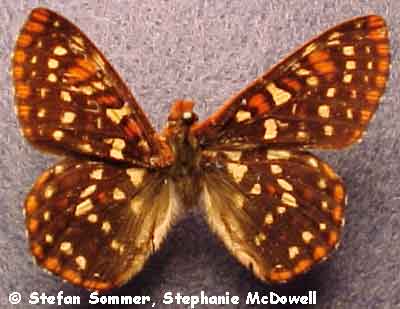
Variable Checkerspot
Family: Nymphalidae
Family Description:
Alternate Common Names:Western Checkerspot, Colon Checkerspot.
Note: This species is comprised of many subspecies, including anicia and colon; however, the subspecies are all variable and difficult to distinguish, and the delineations between them are debated. Some authors consider several of them to be independent species. Additionally, some authors refer to this species with the genus name Occidryas.
Description:
Caterpillar: The caterpillar varies in appearance, but generally is black marked with white, yellow, or orange. The body is covered with hair, and there are black and orange spines.
Adult: This butterfly is small to medium-sized, with a wingspan of 1 1/8 to 2 1/4 inches. Like the caterpillar, the butterfly is variable in appearance. Typically, the upperside is black to dark brown. The forewing is quite pointed and is marked with whitish to yellow and orange spots with the outer edge lined with red spots. The hindwing is marked mainly with whitish to yellow spots, with the outer edge lined with a row of small yellow dots spaced evenly apart. Underneath is reddish to orange and marked with yellow bands. The sides of the abdomen are often spotted with white.
Range:
This species ranges from parts of Alaska and western Canada south through California, through the Pacific Northwest east to the Dakotas, and through the Rocky Mountain and southwestern states. It occurs throughout Idaho.
Habitat:
It occupies a variety of open habitats, including tundra, open forests, chaparral, sagebrush steppe, and desert.
Diet:
Caterpillar: Caterpillars feed on the leaves, flowers, and bracts of a number of host plants representing several families, including the honeysuckle family (Caprifoliaceae) and the snapdragon family (Scrophulariaceae). Species include snowberry (Symphoricarpos spp.), Indian paintbrush (Castilleja spp.), and beardtongue (Penstemon spp.).
Adult: Butterflies drink flower nectar.
Ecology:
Caterpillars build nests of white silk in which they feed together. There is only one new generation of caterpillars each year in most of the range, but there may be several in the southwest. Caterpillars overwinter in leaf litter or under rocks in a physiological state called diapause. Those at high elevations may remain in diapause for several years. Adults generally fly from June to August through much of its range.
Reproduction:
Males actively patrol in search of receptive females. Females lay yellow eggs in clusters on the underside of host plant leaves. The eggs turn reddish brown before hatching.
Conservation:
| Global Rank: |
G5; populations are widespread, abundant, and secure. |
References:
Ferris, C. D. and F. M. Brown. (eds.) 1981. Butterflies of the Rocky Mountain States. Univ. of Oklahoma Press, Norman, Oklahoma, USA, 442 pp.
Opler, P. A., H. Pavulaan, and R. E. Stanford. 1995. Butterflies of North America. Jamestown, North Dakota, USA: Northern Prairie Wildlife Research Center Home Page. http://www.npwrc.usgs.gov/resource/distr/lepid/bflyusa/bflyusa.htm (Version 05Nov98).
Opler, P. A. and A. B.Wright. 1999. A Field Guide to the Western Butterflies. Second Edition. Peterson Field Guide Series. Houghton Mifflin Company, New York, New York, USA, 540 pp.
Pyle, R. M. 1981. National Audubon Society Field Guide to North American Butterflies. Alfred A. Knopf, Inc., New York, New York, USA, 924 pp.
Scott, J. A. 1986. The Butterflies of North America. Stanford University Press, Stanford, California, USA, 583 pp.
Stanford, R. E. and P. A. Opler. 1993. Atlas of Western U.S.A. Butterflies (Including Adjacent Parts of Canada and Mexico). Published by authors, Denver, Colorado, USA, 275 pp.
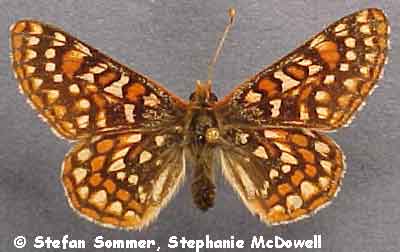
Edith’s Checkerspot
Family: Nymphalidae
Family Description:
Note: This species is referred to by the genus name Occidryas by some authors.
Description:
Caterpillar: The caterpillars vary in appearance, but generally are black and may be marked with stripes or spots of white or orange. The body is covered with black spines which may be colored orange at the base.
Adult: The butterfly is small to medium-sized, with a wingspan of 1 1/8 to 2 inches. Like the caterpillar, it can vary in its appearance. Typically, the upperside is dark brown to black and marked with red, orange, yellow and white spots or squares. The spots are arranged in bands broken up with black. Often, there is a band of red along the outer edge, followed by one or two rows of yellowish white dots. Underneath is marked with bands of yellow, orange, and offwhite outlined and broken up with brown.
Range:
This species ranges from southern British Columbia and Alberta south to southern California, Nevada, Utah, and Colorado. In Idaho, it occurs throughout most of the state.
Habitat:
It utilizes a variety of habitats, such as tundra, grasslands, open woodlands, sagebrush steppe, and chaparral along the coast.
Diet:
Caterpillar: Caterpillars feed on the leaves and flowers of a number of plant species, including Indian paintbrush (Castilleja spp.), lousewort (Pedicularis spp.), and plantain (Plantago spp.).
Adult: Butterflies feed on flower nectar.
Ecology:
Young caterpillars live in webs made of loose silk. There is one new generation of caterpillars each summer. Older caterpillars overwinter, often under rocks, in a physiological state called diapause. They may switch the host plants they feed on after they emerge in spring. Adults generally fly from March through late August.
Reproduction:
Males perch and actively patrol in search of receptive females. Females lay eggs in groups on the underside of leaves or on flowers of host plants.
Conservation:
| Global Rank: |
G5; most populations are widespread, abundant, and secure. Certain subspecies in California, however, are listed as T1, which means each is critically imperiled because of extreme rarity and is imminently vulnerable to extinction. |
References:
Ferris, C. D. and F. M. Brown. (eds.) 1981. Butterflies of the Rocky Mountain States. Univ. of Oklahoma Press, Norman, Oklahoma, USA, 442 pp.
Opler, P. A., H. Pavulaan, and R. E. Stanford. 1995. Butterflies of North America. Jamestown, North Dakota, USA: Northern Prairie Wildlife Research Center Home Page. http://www.npwrc.usgs.gov/resource/distr/lepid/bflyusa/bflyusa.htm (Version 05Nov98).
Opler, P. A. and A. B.Wright. 1999. A Field Guide to the Western Butterflies. Second Edition. Peterson Field Guide Series. Houghton Mifflin Company, New York, New York, USA, 540 pp.
Pyle, R. M. 1981. National Audubon Society Field Guide to North American Butterflies. Alfred A. Knopf, Inc., New York, New York, USA, 924 pp.
Scott, J. A. 1986. The Butterflies of North America. Stanford University Press, Stanford, California, USA, 583 pp.
Stanford, R. E. and P. A. Opler. 1993. Atlas of Western U.S.A. Butterflies (Including Adjacent Parts of Canada and Mexico). Published by authors, Denver, Colorado, USA, 275 pp.
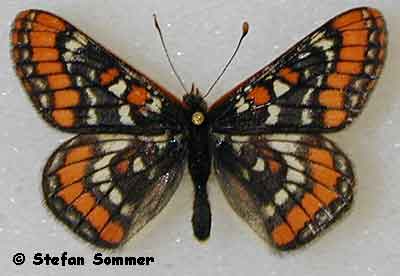
Gillette’s Checkerspot
Family: Nymphalidae
Family Description:
AlternateCommon Name: Yellowstone Checkerspot.
Note: This species is referred to with the genus name Hypodryas by some authors.
Description:
Caterpillar: The caterpillar is brown to black and marked lengthwise with a yellow stripe along the back and a white stripe along the side. The spines on the back are yellow, while all other spines are black.
Adult: This is a small to medium-sized butterfly, with a wingspan of 1 3/8 to 1 7/8 inches. The upperside is brown and marked with orange and white irregularly-shaped spots. There is a wide orange to red band, bordered on either side by white dots, along the outside edge of the wings. Underneath is similarly marked but paler in color.
Range:
This species is restricted to a small range which includes southwestern Alberta, western Montana and Wyoming, and portions of north, central and eastern Idaho.
Habitat:
It can be found in open, moist areas such as meadows, valleys, and open forests.
Diet:
Caterpillar: Caterpillars feed on the leaves and leaf buds of several species of plants, including twinberry honeysuckle (Lonicera involucrata), snowberry (Symphoricarpos albus), and Indian paintbrush (Castilleja spp.).
Adult: Butterflies drink flower nectar.
Ecology:
Young caterpillars live and feed together in nests made from leaves and silk. There is one new generation of caterpillars each summer. At low elevations, the older caterpillars overwinter in a physiological state called diapause. At high elevations, however, young caterpillars feed for several weeks, then overwinter; in spring, they emerge, feed and molt through the growing season, then overwinter a second time before emerging to pupate. Adults generally fly from late June to mid-August. Butterflies exhibit a slow flight, and tend to stay close to host plants. They roost in the tops of coniferous trees at night, and females may seek shelter there if approached.
Reproduction:
Males patrol for receptive females, often in treetops. Females lay eggs in clusters on the undersides of leaves. Investigation revealed that eggs are typically placed on leaves which receive the morning sun because the warmth promotes faster development.
Conservation:
| Global Rank: |
G3; vulnerable to population decline and extinction. |
References:
Ferris, C. D. and F. M. Brown. (eds.) 1981. Butterflies of the Rocky Mountain States. Univ. of Oklahoma Press, Norman, Oklahoma, USA, 442 pp.
Opler, P. A., H. Pavulaan, and R. E. Stanford. 1995. Butterflies of North America. Jamestown, North Dakota, USA: Northern Prairie Wildlife Research Center Home Page. http://www.npwrc.usgs.gov/resource/distr/lepid/bflyusa/bflyusa.htm (Version 05Nov98).
Opler, P. A. and A. B.Wright. 1999. A Field Guide to the Western Butterflies. Second Edition. Peterson Field Guide Series. Houghton Mifflin Company, New York, New York, USA, 540 pp.
Pyle, R. M. 1981. National Audubon Society Field Guide to North American Butterflies. Alfred A. Knopf, Inc., New York, New York, USA, 924 pp.
Scott, J. A. 1986. The Butterflies of North America. Stanford University Press, Stanford, California, USA, 583 pp.
Stanford, R. E. and P. A. Opler. 1993. Atlas of Western U.S.A. Butterflies (Including Adjacent Parts of Canada and Mexico). Published by authors, Denver, Colorado, USA, 275 pp.
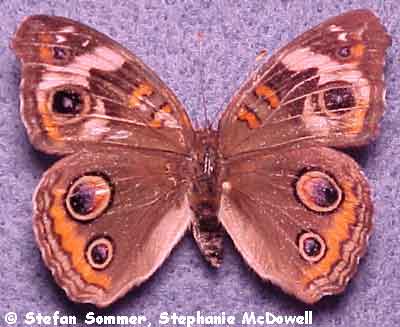
Common Buckeye
Family: Nymphalidae
Family Description:
Note: Some authors refer to this species with the genus name Precis.
Description:
Caterpillar: The caterpillar is dark gray to black and covered with black branching spines. It is marked lengthwise with two rows of orange spots along the back and two rows of white spots along the side. The legs and head are marked with orange. It can reach a maximum length of 1 1/4 inches.
Adult: This is a medium-sized to fairly large butterfly, with a wingspan of 1 5/8 to 2 3/4 inches. The upperside is brown and strikingly marked. The forewing has two orange bars and two eyespots, one larger than the other; both eyespots are black with purple centers. There is a beige wavy band that encircles the larger eyespot and continues to the upper edge of the wing. The hindwing also has two eyespots, both outlined with a wide yellow band and a thin black line, with black and purple in the center. The larger of the two also has a spot of pink in the inside. The hindwing is also marked with an orange band just inside from the edge, and two yellowish lines along the edge, both broken into bars by brown. The underside is brown and marked similarly to the upperside but much fainter. The underside of the hindwing varies in color from brown to tan to reddish.
Range:
This species is a resident of the southernmost portion of the U.S., north along both of the coasts, and south through Mexico. It migrates north through most of the U.S. during the spring and summer. It has been documented in two counties of Idaho, Owyhee and Franklin.
Habitat:
It occurs in open, lowland areas characterized by having low vegetation and areas of bare ground.
Diet:
Caterpillar: Caterpillars feed on the leaves of a variety of plants from several families, including snapdragon (Scrophulariaceae), acanthus (Acanthaceae), plantain (Plantaginaceae), and vervain (Verbenaceae).
Adult: Butterflies drink flower nectar, most often from flowers belonging to the sunflower family (Asteraceae).
Ecology:
There are multiple generations of caterpillars, essentially all year long, in the southernmost portion of its range; elsewhere there are two or three. Caterpillars and adults may overwinter in a physiological state called diapause, or they may remain active, depending on the climate of their locality. Adults generally fly from April through October in most of its range, but may fly all year in the south.
Reproduction:
Males perch to wait for receptive females, and although not truly territorial may actively chase anything passing by. Females lay eggs singly on the upperside of leaves or on leaf buds of host plants.
Conservation:
| Global Rank: |
G5; populations are widespread, abundant, and secure. |
References:
Ferris, C. D. and F. M. Brown. (eds.) 1981. Butterflies of the Rocky Mountain States. Univ. of Oklahoma Press, Norman, Oklahoma, USA, 442 pp.
Opler, P. A., H. Pavulaan, and R. E. Stanford. 1995. Butterflies of North America. Jamestown, North Dakota, USA: Northern Prairie Wildlife Research Center Home Page. http://www.npwrc.usgs.gov/resource/distr/lepid/bflyusa/bflyusa.htm (Version 05Nov98).
Opler, P. A. and A. B.Wright. 1999. A Field Guide to the Western Butterflies. Second Edition. Peterson Field Guide Series. Houghton Mifflin Company, New York, New York, USA, 540 pp.
Pyle, R. M. 1981. National Audubon Society Field Guide to North American Butterflies. Alfred A. Knopf, Inc., New York, New York, USA, 924 pp.
Scott, J. A. 1986. The Butterflies of North America. Stanford University Press, Stanford, California, USA, 583 pp.
Stanford, R. E. and P. A. Opler. 1993. Atlas of Western U.S.A. Butterflies (Including Adjacent Parts of Canada and Mexico). Published by authors, Denver, Colorado, USA, 275 pp.
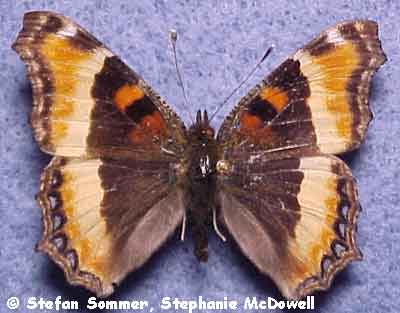
Milbert’s Tortoiseshell
Family: Nymphalidae
Family Description:
Alternate Common Name: Fire-Rim Tortoiseshell.
Description:
Caterpillar: The caterpillar is black on top with a yellow stripe, green on the sides, speckled with whitish dots, and dotted with spines.
Adult: The butterfly has a wingspan of 1 ¾ to 2 ½ inches. The upperside is dark brown to black, the sides edged with three stripes in this order: yellow, orange and black. Bluish dots may be present in the black edge stripe on the hindwings. There are two orange spots in the dark brown area of the forewings. Underneath, the wings are mottled dark brown edged with light brown.
Range:
This species occurs in southern Alaska, throughout the southern half of Canada and northern half of the U.S, and south to the Mexican border in the western third of the U.S. It occurs widely throughout Idaho.
Habitat:
These butterflies can be found in any environment but tend to be where it is cool, such as in woodlands or at higher elevations.
Diet:
Caterpillar: Caterpillars feed on the leaves of nettle (Urtica spp.).
Adult: Butterflies use flower nectar and occasionally sap for food.
Ecology:
Young caterpillars live together in web nests at the tops of nettle plants. Later they may live and feed independently in leaves wrapped up with silk. There can be one to three generations each summer, depending on the climate. Adults overwinter, often several together in a group, in a physiological state called diapause. When multiple generations occur during a given summer, only the adults of the last generation overwinter. Adults generally fly from June until winter and emerge in spring to fly again until June.
Reproduction:
Males perch to wait for receptive females, typically from noon to early evening. Females lay hundreds of pale green eggs in groups on the undersides of nettle leaves.
Conservation:
| Global Rank: |
G5; populations are widespread, abundant, and secure. |
References:
Ferris, C. D. and F. M. Brown. (eds.) 1981. Butterflies of the Rocky Mountain States. Univ. of Oklahoma Press, Norman, Oklahoma, USA, 442 pp.
Opler, P. A., H. Pavulaan, and R. E. Stanford. 1995. Butterflies of North America. Jamestown, North Dakota, USA: Northern Prairie Wildlife Research Center Home Page. http://www.npwrc.usgs.gov/resource/distr/lepid/bflyusa/bflyusa.htm (Version 05Nov98).
Opler, P. A. and A. B.Wright. 1999. A Field Guide to the Western Butterflies. Second Edition. Peterson Field Guide Series. Houghton Mifflin Company, New York, New York, USA, 540 pp.
Pyle, R. M. 1981. National Audubon Society Field Guide to North American Butterflies. Alfred A. Knopf, Inc., New York, New York, USA, 924 pp.
Scott, J. A. 1986. The Butterflies of North America. Stanford University Press, Stanford, California, USA, 583 pp.
Stanford, R. E. and P. A. Opler. 1993. Atlas of Western U.S.A. Butterflies (Including Adjacent Parts of Canada and Mexico). Published by authors, Denver, Colorado, USA, 275 pp.

Mourning Cloak
Family: Nymphalidae
Family Description:
Description:
Caterpillar: The caterpillar is black, covered with tiny white dots and marked with a row of orange spots along the back. It has several rows of black branching spines. The prolegs are red. It can reach a length of 2 inches.
Adult: This is a large butterfly, with a wingspan of 2 to 4 inches. It is purplish black on the upperside, edged with a wide yellow border, and marked with a row of blue spots just in from the border. The edges of the wings appear irregular or ragged, with several short projections extending from them. Underneath is grayish black, appearing much like dark tree bark. The underside of the wings is bordered with yellowish gray, with a row of bluish chevrons just in from the border.
Range:
This species occurs throughout North America and northern South America. It can be found everywhere in Idaho.
Habitat:
It can be found in a wide variety of habitats, including woodlands, gardens, suburbs, and along rivers and streams.
Diet:
Caterpillar: Caterpillars feed primarily on the leaves of deciduous trees, including willow (Salix spp.), elm (Ulmus spp.), cottonwood and aspen (Populus spp.), birch (Betula spp.), and hackberry (Celtis spp.).
Adult: Butterflies feed on tree sap (especially oaks (Quercus spp.)), fruit, and occasionally flower nectar.
Ecology:
There is usually one generation of caterpillars each summer, but there may be as many as three in some locations. Caterpillars feed together in groups, sometimes defoliating trees. Mature caterpillars pupate mid- to late summer; adult butterflies emerge, feed, then estivate (enter a sort of summer hibernation) until autumn. In autumn, butterflies feed again before overwintering in a physiological state called diapause. Butterflies emerge in spring to mate, and may be one of the first observable spring species. Adults generally fly from March to June and from September to Novemeber. Some butterflies may migrate instead of hibernating in the fall.
Reproduction:
Males perch to wait for receptive females. Females lay eggs in groups in a single layer, occasionally on leaves and more often encircling twigs of host plants.
Conservation:
| Global Rank: |
G5; populations are widespread, abundant, and secure. |
References:
Ferris, C. D. and F. M. Brown. (eds.) 1981. Butterflies of the Rocky Mountain States. Univ. of Oklahoma Press, Norman, Oklahoma, USA, 442 pp.
Opler, P. A., H. Pavulaan, and R. E. Stanford. 1995. Butterflies of North America. Jamestown, North Dakota, USA: Northern Prairie Wildlife Research Center Home Page. http://www.npwrc.usgs.gov/resource/distr/lepid/bflyusa/bflyusa.htm (Version 05Nov98).
Opler, P. A. and A. B.Wright. 1999. A Field Guide to the Western Butterflies. Second Edition. Peterson Field Guide Series. Houghton Mifflin Company, New York, New York, USA, 540 pp.
Pyle, R. M. 1981. National Audubon Society Field Guide to North American Butterflies. Alfred A. Knopf, Inc., New York, New York, USA, 924 pp.
Scott, J. A. 1986. The Butterflies of North America. Stanford University Press, Stanford, California, USA, 583 pp.
Stanford, R. E. and P. A. Opler. 1993. Atlas of Western U.S.A. Butterflies (Including Adjacent Parts of Canada and Mexico). Published by authors, Denver, Colorado, USA, 275 pp.
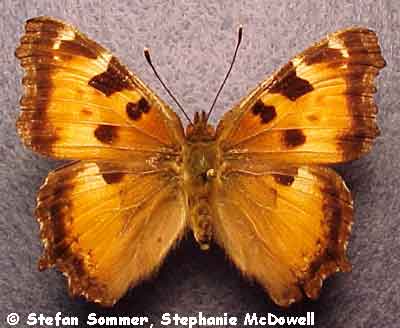
California Tortoiseshell
Family: Nymphalidae
Family Description:
Alternate Common Name: Western Tortoiseshell.
Description:
Caterpillar: The caterpillar is black, dotted with white, and striped lengthwise with yellow. The body has several rows of black and yellowish branching spines.
Adult: The butterfly has a wingspan of 1 ¼ to 2 ¾ inches. The edges of the wings appear jagged or scalloped. The upperside is orange-brown, with dark, brownish black borders and brownish shading on the wings close to the body. The forewing has several large patches of black near the forward edge, and one to several black spots. Underneath is grayish brown and mottled with varying shades of brown, resembling bark. Near the edge is an irregular, broken, thin line of blue.
Range:
This species normally ranges from southern British Columbia south to southern California, and east to western Montana south to northern Mexico. It may also migrate into the Midwest and parts of the northeastern U.S. In Idaho, it occurs throughout most of the state.
Habitat:
It utilizes a variety of habitats, including woodlands, chaparral, and forest clearings and edges.
Diet:
Caterpillar: Caterpillars feed on buck brush (Ceanothus spp.).
Adult: Butterflies drink flower nectar.
Ecology:
There is generally one generation of caterpillars each year in the northern part of its range, and up to three in the south. Adults overwinter in a physiological state called diapause. In spring, they emerge to mate and lay eggs. In those areas with multiple generations each year, as in central California, adults from the first generation often migrate east and reproduce; their adult offspring return in the fall to overwinter. Adult migration may also be triggered by high Tortoiseshell densities and other environmental factors. Adults generally fly from April to October.
Reproduction:
Males perch to wait for receptive females. Females lay groups of eggs on buck brush (Ceanothus spp.).
Conservation:
| Global Rank: |
G5; populations are widespread, abundant, and secure. |
References:
Ferris, C. D. and F. M. Brown. (eds.) 1981. Butterflies of the Rocky Mountain States. Univ. of Oklahoma Press, Norman, Oklahoma, USA, 442 pp.
Opler, P. A., H. Pavulaan, and R. E. Stanford. 1995. Butterflies of North America. Jamestown, North Dakota, USA: Northern Prairie Wildlife Research Center Home Page. http://www.npwrc.usgs.gov/resource/distr/lepid/bflyusa/bflyusa.htm (Version 05Nov98).
Opler, P. A. and A. B.Wright. 1999. A Field Guide to the Western Butterflies. Second Edition. Peterson Field Guide Series. Houghton Mifflin Company, New York, New York, USA, 540 pp.
Pyle, R. M. 1981. National Audubon Society Field Guide to North American Butterflies. Alfred A. Knopf, Inc., New York, New York, USA, 924 pp.
Scott, J. A. 1986. The Butterflies of North America. Stanford University Press, Stanford, California, USA, 583 pp.
Stanford, R. E. and P. A. Opler. 1993. Atlas of Western U.S.A. Butterflies (Including Adjacent Parts of Canada and Mexico). Published by authors, Denver, Colorado, USA, 275 pp.
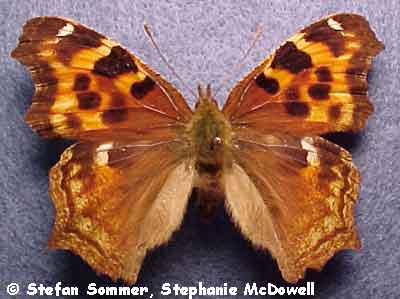
Compton Tortoiseshell
Family: Nymphalidae
Family Description:
Alternate Common Name: Comma Tortoiseshell.
Description:
Caterpillar: The caterpillar is pale green and marked with whitish dots and light stripes; the body and head are covered with black branching spines.
Adult: This is a large butterfly, with a wingspan of 2 ½ to 3 inches. The wing edges are wavy and irregular. The upperside is multi-colored: brownish close to the body, the rest orange to rust colored and marked with large black spots and patches, with the outermost edge golden yellow striped with black. There is a single white spot on both the fore- and hindwing. Underneath is mottled gray, brown, and tan, with the portions closest to the body darker than out toward the wing tips. There may be an irregular, discontinuous line of grayish blue just in from the outside edge. The hindwing has a very small silvery white "V" or comma-shaped mark towards the middle.
Range:
This species ranges from southern Alaska and most of Canada south to Oregon, through the Intermountain and Rocky Mountain states to central Utah and Colorado, through the Dakotas, the Midwest, and the northeastern U.S., extending south as far as Tennessee. In Idaho, it occurs mainly in the panhandle region but also in isolated patches of the southern half of the state.
Habitat:
Its primary habitat is deciduous forests, but it may also utilize coniferous forests and canyonlands.
Diet:
Caterpillar: Caterpillars feed in groups on the leaves of deciduous trees and shrubs including birch (Betula spp.), willow (Salix spp.), aspen and cottonwood (Populus spp.), and elm (Ulmus spp.).
Adult: Butterflies feed on sap, fruit, and sometimes flower nectar.
Ecology:
There is one generation of caterpillars each summer. Adults fly from June until late fall then overwinter, often in groups, in a physiological state called diapause. In spring, they emerge to mate and lay eggs, flying until June. Some adults may migrate to California and Florida. Butterflies may occur in large numbers in a given area one year and few to none may be observed the next.
Reproduction:
It is currently unreported in the scientific literature whether males perch or actively patrol for females; however, males of the other Nymphalis species are reported to perch. Females lay small groups of eggs on host plants.
Conservation:
| Global Rank: |
G5; populations are widespread, abundant, and secure. |
References:
Ferris, C. D. and F. M. Brown. (eds.) 1981. Butterflies of the Rocky Mountain States. Univ. of Oklahoma Press, Norman, Oklahoma, USA, 442 pp.
Opler, P. A., H. Pavulaan, and R. E. Stanford. 1995. Butterflies of North America. Jamestown, North Dakota, USA: Northern Prairie Wildlife Research Center Home Page. http://www.npwrc.usgs.gov/resource/distr/lepid/bflyusa/bflyusa.htm (Version 05Nov98).
Opler, P. A. and A. B.Wright. 1999. A Field Guide to the Western Butterflies. Second Edition. Peterson Field Guide Series. Houghton Mifflin Company, New York, New York, USA, 540 pp.
Pyle, R. M. 1981. National Audubon Society Field Guide to North American Butterflies. Alfred A. Knopf, Inc., New York, New York, USA, 924 pp.
Scott, J. A. 1986. The Butterflies of North America. Stanford University Press, Stanford, California, USA, 583 pp.
Stanford, R. E. and P. A. Opler. 1993. Atlas of Western U.S.A. Butterflies (Including Adjacent Parts of Canada and Mexico). Published by authors, Denver, Colorado, USA, 275 pp.
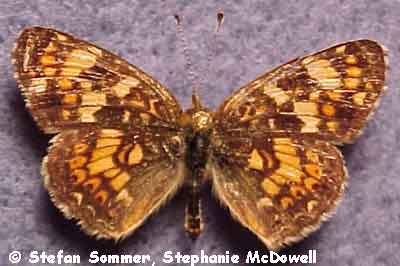
Field Crescent
Family: Nymphalidae
Family Description:
Alternate Common Name: Field Crescentspot.
Note: This species is listed as Phyciodes pratensis by some authors.
Description:
Caterpillar: The caterpillar is dark brown to black and marked lengthwise with blackish and cream-colored lines. The body is covered with branching spines.
Adult: The butterfly is small to medium-sized, with a wingspan of 1 to 1 ¾ inches. It varies in its appearance, but generally is dark brown to orangish brown on the upperside and marked with yellow and orange spots or squares aligned in patches or rows. The hindwing has a row of orange spots with blackish centers. Underneath, the forewing is orange and marked with patches of yellow, brown and offwhite; the hindwing is yellowish to orange with patches of offwhite, a curved row of small dark spots, and a row of crescent-shaped spots along the outside edge.
Range:
This species ranges from central Alaska, south through British Columbia and Alberta, through the western U.S. to southern California, Arizona, and New Mexico. It extends east as far as southeastern Montana, eastern Wyoming and western Nebraska. It can be found throughout much of Idaho.
Habitat:
It utilizes a variety of habitats, including meadows, grasslands, fields, forest openings, and swamps. It tends to be at low to mid-elevations in the Rockies and at high elevations in the northwestern part of its range.
Diet:
Caterpillar: Caterpillars feed on the leaves of asters (Aster and Machaeranthera spp.).
Adult: Butterflies drink flower nectar.
Ecology:
The number of generations of caterpillars each growing season varies within its range, with only one in the north and at high elevations, two to three in most of the range, and four in southern California. Caterpillars feed in groups, often in a loose web. Young caterpillars present at the end of the season overwinter in a physiological state called diapause; they emerge in spring to continue feeding and molting, and eventually pupate. Adults generally fly from May through September in most of its range.
Reproduction:
Males actively patrol in search of receptive females. Females lay groups of pale green eggs on the undersides of leaves of asters.
Conservation:
| Global Rank: |
G5; populations are widespread, abundant, and secure. |
References:
Ferris, C. D. and F. M. Brown. (eds.) 1981. Butterflies of the Rocky Mountain States. Univ. of Oklahoma Press, Norman, Oklahoma, USA, 442 pp.
Opler, P. A., H. Pavulaan, and R. E. Stanford. 1995. Butterflies of North America. Jamestown, North Dakota, USA: Northern Prairie Wildlife Research Center Home Page. http://www.npwrc.usgs.gov/resource/distr/lepid/bflyusa/bflyusa.htm (Version 05Nov98).
Opler, P. A. and A. B.Wright. 1999. A Field Guide to the Western Butterflies. Second Edition. Peterson Field Guide Series. Houghton Mifflin Company, New York, New York, USA, 540 pp.
Pyle, R. M. 1981. National Audubon Society Field Guide to North American Butterflies. Alfred A. Knopf, Inc., New York, New York, USA, 924 pp.
Scott, J. A. 1986. The Butterflies of North America. Stanford University Press, Stanford, California, USA, 583 pp.
Stanford, R. E. and P. A. Opler. 1993. Atlas of Western U.S.A. Butterflies (Including Adjacent Parts of Canada and Mexico). Published by authors, Denver, Colorado, USA, 275 pp.
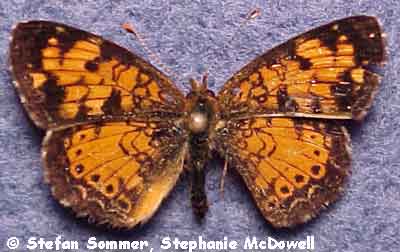
Northern Crescent
Family: Nymphalidae
Family Description:
Note: This species is not recognized by all authors; some consider it to be part of either P. tharos or P. morpheus.
Description:
Caterpillar: The caterpillar is brown to reddish brown to black, dotted with white to yellowish white, striped lengthwise with offwhite, and covered with branching spines tipped with white.
Adult: This is a medium-sized butterfly, with a wingspan of 1 1/4 to 1 7/8 inches. The upperside is mostly orange, marked with brown to black; females tend to be darker than males. The forewing has irregularly shaped patches of black and a black border; there may be thin or thick wavy lines of black near the body. The hindwing is orange, marked with black, wavy lines near the body, a black border, and possibly a curved row of black spots just in from the edge. Underneath, the forewing is orange to brown and marked with black and offwhite; the hindwing is yellowish to orange, marked with brownish lines and a single, whitish crescent-shaped spot near the edge.
Range:
This species ranges from the Yukon Territory southeast across lower Canada to Newfoundland, and south into the U.S. along the Rockies to Arizona and New Mexico, and along the Appalachians to Virginia. In Idaho, it occurs in the panhandle, central, and eastern portions of the state.
Habitat:
It occurs in open and moist areas, such as meadows, fields, and valley bottoms.
Diet:
Caterpillar: Caterpillars feed on various species of aster (Aster spp.).
Adult: Butterflies drink flower nectar.
Ecology:
There is typically only one generation of caterpillars each year. Young caterpillars feed in groups, and eat the undersides of leaves. Third-stage caterpillars overwinter in a physiological state called diapause. Adults generally fly from June through July in most of its range.
Reproduction:
Males actively patrol in search of receptive females. Females lay groups of green eggs on the undersides of host plant leaves.
Conservation:
| Global Rank: |
G5; most populations are widespread, abundant, and secure. However, certain isolated subspecies may require monitoring and preservation. |
References:
Opler, P. A., H. Pavulaan, and R. E. Stanford. 1995. Butterflies of North America. Jamestown, North Dakota, USA: Northern Prairie Wildlife Research Center Home Page. http://www.npwrc.usgs.gov/resource/distr/lepid/bflyusa/bflyusa.htm (Version 05Nov98).
Opler, P. A. and A. B.Wright. 1999. A Field Guide to the Western Butterflies. Second Edition. Peterson Field Guide Series. Houghton Mifflin Company, New York, New York, USA, 540 pp.
Scott, J. A. 1986. The Butterflies of North America. Stanford University Press, Stanford, California, USA, 583 pp.
Stanford, R. E. and P. A. Opler. 1993. Atlas of Western U.S.A. Butterflies (Including Adjacent Parts of Canada and Mexico). Published by authors, Denver, Colorado, USA, 275 pp.
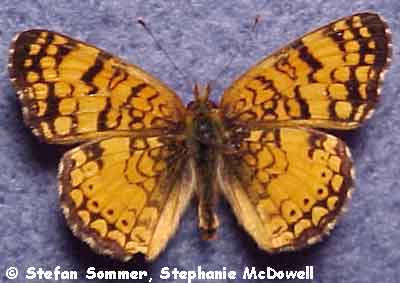
Mylitta Crescent
Family: Nymphalidae
Family Description:
Alternate Common Names:Mylitta Crescentspot, Thistle Crescent.
Description:
Caterpillar: The caterpillar is small, typically less than an inch long, and is reddish brown to black in color, marked lightly with white to yellowish tiny dots and several lengthwise stripes. The body has branching spines, black ones along the back and orangish ones on the sides.
Adult: This is a small to medium-sized butterfly, with a wingspan of 1 to 1 ½ inches. It is orange on the upperside and bordered with black. The bases of the wings are marked with thin, black, wavy lines. The forewing has orange spots in the black at the tip; the hindwing has a row of small black dots, followed by a row of crescent-shaped orange spots in the black border. Underneath, the forewing is orange and marked with brown lines and patches of yellow and possibly white. The underside of the hindwing is yellowish, marked with wavy brown lines, a curved row of small black dots, and a curved row of whitish, possibly faint, crescent-shaped spots along the edge. One of the crescents is particularly bright.
Range:
This species ranges from southern British Columbia south to southern California, Arizona, and New Mexico, and continuing south into Mexico. It extends east as far as central Montana, northwestern Colorado, and in isolated sections of Wyoming. It occurs through most of Idaho.
Habitat:
It can be found in a wide variety of habitats, including meadows, fields, disturbed areas, open woodlands, marshes, mountains, and canyons.
Diet:
Caterpillar: Caterpillars feed on the leaves of native and alien thistles, including species of Cirsium, Silybum, and Carduus.
Adult: Butterflies drink flower nectar.
Ecology:
There are many generations of caterpillars each year through most of its range. Young caterpillars may live together in small silk webs. Caterpillars of the year’s last generation overwinter in a physiological state called diapause. Adults generally fly from April through October in most of its range. Butterflies tend to remain in the same general vicinity, near a particular group of flowers, for example, for several days in a row.
Reproduction:
Males perch or actively patrol in search of receptive females. Females lay groups of off-white eggs on the undersides of thistle leaves.
Conservation:
| Global Rank: |
G5; populations are widespread, abundant, and secure. |
References:
Ferris, C. D. and F. M. Brown. (eds.) 1981. Butterflies of the Rocky Mountain States. Univ. of Oklahoma Press, Norman, Oklahoma, USA, 442 pp.
Opler, P. A., H. Pavulaan, and R. E. Stanford. 1995. Butterflies of North America. Jamestown, North Dakota, USA: Northern Prairie Wildlife Research Center Home Page. http://www.npwrc.usgs.gov/resource/distr/lepid/bflyusa/bflyusa.htm (Version 05Nov98).
Opler, P. A. and A. B.Wright. 1999. A Field Guide to the Western Butterflies. Second Edition. Peterson Field Guide Series. Houghton Mifflin Company, New York, New York, USA, 540 pp.
Pyle, R. M. 1981. National Audubon Society Field Guide to North American Butterflies. Alfred A. Knopf, Inc., New York, New York, USA, 924 pp.
Scott, J. A. 1986. The Butterflies of North America. Stanford University Press, Stanford, California, USA, 583 pp.
Stanford, R. E. and P. A. Opler. 1993. Atlas of Western U.S.A. Butterflies (Including Adjacent Parts of Canada and Mexico). Published by authors, Denver, Colorado, USA, 275 pp.
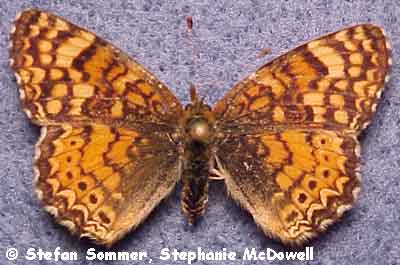
Pale Crescent
Family: Nymphalidae
Family Description:
Alternate Common Name: Pallid Crescentspot.
Description:
Caterpillar: The caterpillar is light brown, striped lengthwise with brown, and has a black head. The body is covered with branching spines.
Adult: The butterfly is medium-sized, with a wingspan of 1 ź to 1 ž inches. It is orange on the upperside and marked with brown to black, and possibly with patches of yellow in females. The forewing has thin, black, wavy lines near the body, a black patch on the bottom border of the wing, near the center, and a black edge. The hindwing is also marked with black wavy lines near the body, is edged in black, and has a curved row of black dots. Underneath, the forewing is orange with patches of yellow; the dark spot from above shows through. The underside of the hindwing is yellowish, marked with patches of whitish and light brown. There is a row or partial row of whitish, crescent-shaped spots near the edge. One of these spots is often one larger than the others.
Range:
This species ranges from southern British Columbia southeast to northern Arizona and northwestern Colorado, extending east as far as central Montana and western Nebraska. It occurs in sections of Idaho scattered throughout the state.
Habitat:
It occurs most frequently in fields, dry streambeds, valleys, and canyons.
Diet:
Caterpillar: Caterpillars feed on the leaves of certain thistles in the genus Cirsium.
Adult: Butterflies drink flower nectar from yellow flowers belonging to the sunflower family (Asteraceae).
Ecology:
There is one generation of caterpillars each summer. Young caterpillars feed in groups. The overwintering stage is unreported. Adults generally fly from the end of April to July, and from August through October.
Reproduction:
Males perch and rarely patrol for receptive females. Females lay groups of eggs on the undersides of host plant leaves.
Conservation:
| Global Rank: |
G5; populations are widespread, abundant, and secure. |
References:
Ferris, C. D. and F. M. Brown. (eds.) 1981. Butterflies of the Rocky Mountain States. Univ. of Oklahoma Press, Norman, Oklahoma, USA, 442 pp.
Opler, P. A., H. Pavulaan, and R. E. Stanford. 1995. Butterflies of North America. Jamestown, North Dakota, USA: Northern Prairie Wildlife Research Center Home Page. http://www.npwrc.usgs.gov/resource/distr/lepid/bflyusa/bflyusa.htm (Version 05Nov98).
Opler, P. A. and A. B.Wright. 1999. A Field Guide to the Western Butterflies. Second Edition. Peterson Field Guide Series. Houghton Mifflin Company, New York, New York, USA, 540 pp.
Pyle, R. M. 1981. National Audubon Society Field Guide to North American Butterflies. Alfred A. Knopf, Inc., New York, New York, USA, 924 pp.
Scott, J. A. 1986. The Butterflies of North America. Stanford University Press, Stanford, California, USA, 583 pp.
Stanford, R. E. and P. A. Opler. 1993. Atlas of Western U.S.A. Butterflies (Including Adjacent Parts of Canada and Mexico). Published by authors, Denver, Colorado, USA, 275 pp.
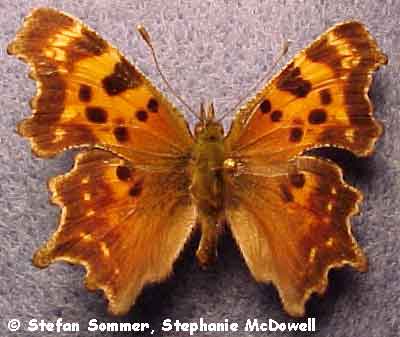
Green Comma
Family: Nymphalidae
Family Description:
Alternate Common Names:Green Anglewing, Faunus Anglewing.
Note: This species is really a complex comprised of several species or subspecies.
Description:
Caterpillar: The caterpillar is black, marked along the top with orange at the front and white dashed with black along the rest of the body. It is also marked with whitish and black rings between segments, and irregular orange lines on the side. The body bears both white and red spines. The black head is marked with orange and has two black horns. It reaches a maximum, full-grown length of 1 ž inches.
Adult: The butterfly is medium-sized to fairly large, with a wingspan of 1 ū to 2 ― inches. The edges of the wings are irregular and jagged, and there is a tail extending from each hindwing. The color varies, but generally the upperside is reddish to golden orange with a dark brown border. In newly emerged individuals, the border may have a greenish sheen. The forewing is spotted with black, and there may be smaller, yellow spots in or along the dark border. The hindwing has several black spots near the body, and a row of yellow spots in or along the dark border. Underneath is mottled brown, dark gray, and light gray, with the interior portion of the wings generally darker than the outer portion. The underside may be marked with a jagged row of greenish marks near the outer edge, and there is a white, comma-shaped mark in the center of the hindwing.
Range:
This species ranges from central Alaska south and east across most of southern Canada to Nova Scotia, extending into the U.S. through the Pacific Northwest to central California and along the Rockies; also from New England along the Appalachians to northern Georgia. It occurs through much of Idaho.
Habitat:
It occurs along streams, in coniferous forests, and in sunny openings.
Diet:
Caterpillar: Caterpillars feed on the leaves of several tree and shrub species, including alder (Alnus spp.), birch (Betula spp.), aspen (Populus spp.), currant (Ribes spp.), and wild rhododendron (Rhododendron spp.).
Adult: Butterflies drink flower nectar and may also use the liquids from mud, carrion, and dung as sources of nutrition.
Ecology:
There is one generation of caterpillars each summer through most of the range, but there may be two in California. Caterpillars rest on the undersides of leaves. Butterflies emerging late in the season overwinter in a physiological state called diapause. They may come out occasionally on warmer winter days, and emerge in spring to mate and lay eggs.
Reproduction:
Males perch to wait for receptive females. Females lay pale green eggs singly on the leaves and twigs of host plants.
Conservation:
| Global Rank: |
G5; populations are widespread, abundant, and secure. |
References:
Ferris, C. D. and F. M. Brown. (eds.) 1981. Butterflies of the Rocky Mountain States. Univ. of Oklahoma Press, Norman, Oklahoma, USA, 442 pp.
Opler, P. A., H. Pavulaan, and R. E. Stanford. 1995. Butterflies of North America. Jamestown, North Dakota, USA: Northern Prairie Wildlife Research Center Home Page. http://www.npwrc.usgs.gov/resource/distr/lepid/bflyusa/bflyusa.htm (Version 05Nov98).
Opler, P. A. and A. B.Wright. 1999. A Field Guide to the Western Butterflies. Second Edition. Peterson Field Guide Series. Houghton Mifflin Company, New York, New York, USA, 540 pp.
Pyle, R. M. 1981. National Audubon Society Field Guide to North American Butterflies. Alfred A. Knopf, Inc., New York, New York, USA, 924 pp.
Scott, J. A. 1986. The Butterflies of North America. Stanford University Press, Stanford, California, USA, 583 pp.
Stanford, R. E. and P. A. Opler. 1993. Atlas of Western U.S.A. Butterflies (Including Adjacent Parts of Canada and Mexico). Published by authors, Denver, Colorado, USA, 275 pp.
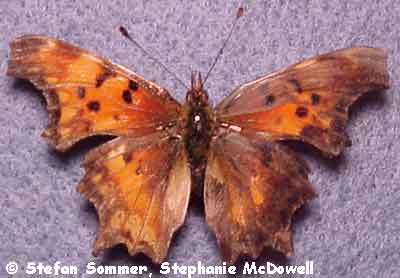
Hoary Comma
Family: Nymphalidae
Family Description:
Alternate Common Name: Hoary Anglewing.
Note: This species is composed of at least two subspecies, P. gracilis gracilis and P. gracilis zephyrus. They occur in different ranges as described below. P. gracilis zephyrus was previously described as an independent species, the Zephyr Anglewing.
Description:
Caterpillar: The caterpillar is black, marked along the top with orange at the front and with white along the rest of the body. There are black "v"-shaped marks along the back, whitish and black rings between segments, and irregular reddish lines on the side. The body is covered with spines of different colors – red, white, and black. The black head is sometimes marked with orange and has two black horns.
Adult: The butterfly is medium-sized (wingspan 1 3/8 to 2 1/4 inches), with irregular wing borders and a small tail extending from the hindwing. The upperside is dark orange with a thick, dark brown border. There are several black spots in the center of the forewing, and a row of yellowish spots along the border. The hindwing has two black spots and a row of yellow spots. Underneath is mottled with several shades of brown and gray, with the inner half noticeably darker than the outer half (the outer half may appear frosty or "hoary"). The underside of the hindwing has a white, comma-shaped mark near the center.
Range:
Subspecies zephyrus ranges from southern British Columbia and Alberta south to southern California, Arizona, and New Mexico, with isolated populations in the western Dakotas and Nebraska. It occurs throughout most of Idaho. Subspecies gracilis ranges from central Alaska south and east across southern Canada to Newfoundland and Nova Scotia, and does not occur in Idaho.
Habitat:
It occurs in and along forests, in valleys, and along streams and rivers.
Diet:
Caterpillar: Caterpillars feed on the leaves of a variety of shrubs, including currant (Ribes spp.), wild rhododendron (Rhododendron spp.), and mock azalea (Menziesia glabella).
Adult: Butterflies drink flower nectar, often from rabbitbrush (Chrysothamnus spp.), and may obtain additional moisture and nutrients from sap and mud.
Ecology:
There is typically one generation of caterpillars each summer. Caterpillars rest on the undersides of leaves. Butterflies emerge from chrysalises later in summer, and may fly to higher elevations to feed. Returning back down in the fall, they then overwinter in a physiological state called diapause until spring, when they emerge to mate and lay eggs.
Reproduction:
Males perch to wait for receptive females. Females lay eggs on the leaves and petioles of host plants.
Conservation:
| Global Rank: |
G5; populations are widespread, abundant, and secure. |
References:
Ferris, C. D. and F. M. Brown. (eds.) 1981. Butterflies of the Rocky Mountain States. Univ. of Oklahoma Press, Norman, Oklahoma, USA, 442 pp.
Opler, P. A., H. Pavulaan, and R. E. Stanford. 1995. Butterflies of North America. Jamestown, North Dakota, USA: Northern Prairie Wildlife Research Center Home Page. http://www.npwrc.usgs.gov/resource/distr/lepid/bflyusa/bflyusa.htm (Version 05Nov98).
Opler, P. A. and A. B.Wright. 1999. A Field Guide to the Western Butterflies. Second Edition. Peterson Field Guide Series. Houghton Mifflin Company, New York, New York, USA, 540 pp.
Pyle, R. M. 1981. National Audubon Society Field Guide to North American Butterflies. Alfred A. Knopf, Inc., New York, New York, USA, 924 pp.
Scott, J. A. 1986. The Butterflies of North America. Stanford University Press, Stanford, California, USA, 583 pp.
Stanford, R. E. and P. A. Opler. 1993. Atlas of Western U.S.A. Butterflies (Including Adjacent Parts of Canada and Mexico). Published by authors, Denver, Colorado, USA, 275 pp.
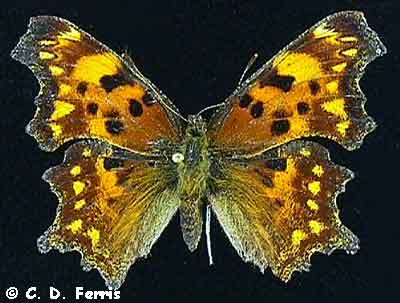
Oreas Comma
Family: Nymphalidae
Family Description:
Alternate Common Name: Oreas Anglewing.
Note: Some authors consider this species to be a subspecies of Polygonia progne, the Gray Comma.
Description:
Caterpillar: The caterpillar is generally dark brown, marked along the top with yellowish orange at the front fading to yellow along the back. There are black "v"-shaped marks and brownish dots on the back. It is also marked with white and black rings between segments, and irregular orange and yellow lines on the side. The body bears spines of different colors – orange, yellow, and black. The black head is marked with orange and has two black horns.
Adult: This butterfly has a wingspan of about 1 5/8 to 2 inches. The wings are ragged along the edges and there is a tail extending from the hindwing. The upperside is dark orange with large black spots and a dark, wide border. There is a row of "<"-shaped, yellowish spots edging the border. Underneath may be either very dark gray and striated (California population), or blotchy and two-toned with black and brown, or gray and brown (northwestern population). The underside of the hindwing has a white, comma-shaped mark near the center.
Range:
This species ranges from southern British Columbia, south through the Pacific Northwest, and along the coast of California; and from parts of Idaho and western Montana to Wyoming, Utah, and Colorado.
Habitat:
It occurs in forests, mountain meadows, canyons, and along streams.
Diet:
Caterpillar: Caterpillars feed primarily on the leaves of gooseberry and currants (Ribes spp.).
Adult: Butterflies feed on the liquids from sap, fruit, and mud, and only occasionally on flower nectar.
Ecology:
There is typically one generation of caterpillars each summer. Caterpillars rest on stems or the undersides of leaves, in a bent position. Butterflies emerge from chrysalises mid- to late summer, feed, then overwinter in a physiological state called diapause until spring. In early spring, they emerge to mate and lay eggs. The northwestern variety is uncommon.
Reproduction:
Males perch to wait for receptive females. Females lay eggs singly on the leaves of host plants.
Conservation:
| Global Rank: |
G5; populations are widespread, abundant, and secure. |
References:
Ferris, C. D. and F. M. Brown. (eds.) 1981. Butterflies of the Rocky Mountain States. Univ. of Oklahoma Press, Norman, Oklahoma, USA, 442 pp.
Opler, P. A., H. Pavulaan, and R. E. Stanford. 1995. Butterflies of North America. Jamestown, North Dakota, USA: Northern Prairie Wildlife Research Center Home Page. http://www.npwrc.usgs.gov/resource/distr/lepid/bflyusa/bflyusa.htm (Version 05Nov98).
Opler, P. A. and A. B.Wright. 1999. A Field Guide to the Western Butterflies. Second Edition. Peterson Field Guide Series. Houghton Mifflin Company, New York, New York, USA, 540 pp.
Pyle, R. M. 1981. National Audubon Society Field Guide to North American Butterflies. Alfred A. Knopf, Inc., New York, New York, USA, 924 pp.
Scott, J. A. 1986. The Butterflies of North America. Stanford University Press, Stanford, California, USA, 583 pp.
Stanford, R. E. and P. A. Opler. 1993. Atlas of Western U.S.A. Butterflies (Including Adjacent Parts of Canada and Mexico). Published by authors, Denver, Colorado, USA, 275 pp.

Satyr Comma
Family: Nymphalidae
Family Description:
Alternate Common Names:Satyr Anglewing, Golden Anglewing.
Description:
Caterpillar: The caterpillar is black and marked on the side with yellow and orange. There are white, greenish white, or yellow "v"-shaped marks on the back, and white to yellowish branched spines. The head is black marked with white, and has two black horns.
Adult: The butterfly is medium-sized to fairly large, with a wingspan of 1 ¾ to 2 ½ inches. It has irregular wing edges, and a short tail extending form the hindwing. The upperside is bright to golden orange with large black spots. The forewing has a darker border, while the hindwing has a faint border of brownish bars. Underneath is light to golden brown, mottled and striated. The underside may be marked with a faint row of tiny dark dots near the outer edge, and there is a whitish, comma-shaped mark near the center of the hindwing.
Range:
This species ranges from northern British Columbia south and east across southern Canada to Newfoundland and Nova Scotia. In the U.S., it ranges from the Pacific Northwest south to southern California, Arizona, and New Mexico, extending east as far as western Montana, western South Dakota, and central Colorado. It occurs through much of Idaho.
Habitat:
It occurs in wooded canyons and valleys and along streams and forests.
Diet:
Caterpillar: Caterpillars feed on the leaves of stinging nettles (Urtica spp.).
Adult: Butterflies use flower nectar, tree sap, and liquids from mud for food.
Ecology:
There are generally one to two generations of caterpillars each summer, and sometimes three along the Pacific coast. Caterpillars construct shelters by tying the edges of leaves together with silk. Butterflies feed through the fall, then overwinter in a physiological state called diapause. They emerge in the spring to mate and lay eggs, and may be seen as early as February on occasion.
Reproduction:
Males perch to wait for receptive females. Females lay pale green eggs, singly or in small stacks or groups, on the undersides of the leaves of host plants.
Conservation:
| Global Rank: |
G5; populations are widespread, abundant, and secure. |
References:
Ferris, C. D. and F. M. Brown. (eds.) 1981. Butterflies of the Rocky Mountain States. Univ. of Oklahoma Press, Norman, Oklahoma, USA, 442 pp.
Opler, P. A., H. Pavulaan, and R. E. Stanford. 1995. Butterflies of North America. Jamestown, North Dakota, USA: Northern Prairie Wildlife Research Center Home Page. http://www.npwrc.usgs.gov/resource/distr/lepid/bflyusa/bflyusa.htm (Version 05Nov98).
Opler, P. A. and A. B.Wright. 1999. A Field Guide to the Western Butterflies. Second Edition. Peterson Field Guide Series. Houghton Mifflin Company, New York, New York, USA, 540 pp.
Pyle, R. M. 1981. National Audubon Society Field Guide to North American Butterflies. Alfred A. Knopf, Inc., New York, New York, USA, 924 pp.
Scott, J. A. 1986. The Butterflies of North America. Stanford University Press, Stanford, California, USA, 583 pp.
Stanford, R. E. and P. A. Opler. 1993. Atlas of Western U.S.A. Butterflies (Including Adjacent Parts of Canada and Mexico). Published by authors, Denver, Colorado, USA, 275 pp.
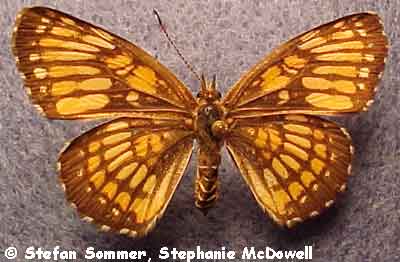
Leanira Checkerspot
Family: Nymphalidae
Family Description:
Alternate Common Name: Paintbrush Checkerspot.
Note: This species is referred to with the genus name Chlosyne by some authors. It is comprised of at least three subspecies: leanira, alma, and fulvia. Some authors consider fulvia to be a separate species.
Description:
Caterpillar: The caterpillar ranges in color from orange to yellow, and is marked lengthwise with several lines of black along the back and sides. It has seven rows of spines.
Adult: This is a medium-sized butterfly, with a wingspan of 1 ¼ to 1 ¾ inches. Its appearance varies regionally. Along the coast and in the Sierra Nevadas, individuals are black on the upperside and marked with offwhite spots and checks arranged in rows. Several offwhite spots are scattered at the bases of each of the wings, and there may be several red spots or small patches at the tip of the forewing. Individuals from desert populations are orange on the upperside and marked with brown wing veins and possibly with brown patches near the wing bases. There are two rows of offwhite spots marking the outer half of each wing. The undersides of all individuals are similar. The underside of the forewing is clouded with orange and spotted with yellow. The underside of the hindwing is offwhite and marked with blackish brown wing veins. Near the outside edge is a curved band of black, spotted with white, looking much like a linked chain.
Range:
This species ranges from southern Oregon and southwestern Idaho south through California, Nevada, and Utah, and in patches of the southwest, Colorado, and western Nebraska and Kansas.
Habitat:
It occurs in a variety of open areas, including chaparral, prairies, desert hills, open woodlands, and canyons.
Diet:
Caterpillar: Caterpillars eat the flowers and leaves of various species of paintbrush (Castilleja spp.).
Adult: Butterflies drink flower nectar.
Ecology:
There are one or two generations of caterpillars each summer. Young caterpillars live together in loose webs. Third stage caterpillars overwinter in a physiological state called diapause. Adults generally fly from March to June.
Reproduction:
Males perch on hilltops to wait for receptive females and occasionally actively patrol for them. Clusters of yellow eggs are laid on the undersides of host plant leaves. The eggs turn orange before hatching.
Conservation:
| Global Rank: |
G4; population levels are secure, but may be of concern in the future. |
References:
Ferris, C. D. and F. M. Brown. (eds.) 1981. Butterflies of the Rocky Mountain States. Univ. of Oklahoma Press, Norman, Oklahoma, USA, 442 pp.
Opler, P. A., H. Pavulaan, and R. E. Stanford. 1995. Butterflies of North America. Jamestown, North Dakota, USA: Northern Prairie Wildlife Research Center Home Page. http://www.npwrc.usgs.gov/resource/distr/lepid/bflyusa/bflyusa.htm (Version 05Nov98).
Opler, P. A. and A. B.Wright. 1999. A Field Guide to the Western Butterflies. Second Edition. Peterson Field Guide Series. Houghton Mifflin Company, New York, New York, USA, 540 pp.
Pyle, R. M. 1981. National Audubon Society Field Guide to North American Butterflies. Alfred A. Knopf, Inc., New York, New York, USA, 924 pp.
Scott, J. A. 1986. The Butterflies of North America. Stanford University Press, Stanford, California, USA, 583 pp.
Stanford, R. E. and P. A. Opler. 1993. Atlas of Western U.S.A. Butterflies (Including Adjacent Parts of Canada and Mexico). Published by authors, Denver, Colorado, USA, 275 pp.
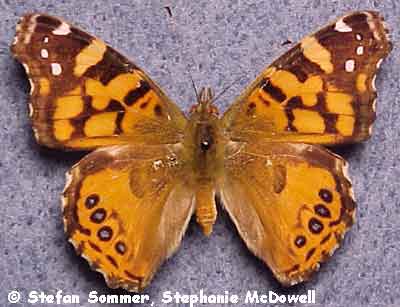
West Coast Lady
Family: Nymphalidae
Family Description:
Alternate Common Name: Western Painted Lady.
Note: This species is considered by some authors to be a subspecies of Vanessa carye. It and the other Painted Lady butterflies are sometimes grouped in their own genus or subgenus, Cynthia.
Description:
Caterpillar: The caterpillar is variable in its appearance. It ranges in color from light brown to black, and may be marked with yellow or orange patches. The body is covered with dark spines. It reaches a maximum, full-grown length of 1 ¼ inches.
Adult: This is a medium to large butterfly, with a wingspan of 1 ½ to 2 ¼ inches. The outer edge of the forewing is slightly scalloped, and the tip is squared off. The upperside is orange to pinkish orange and marked with thick, wavy black lines on the forewing. The tip of the forewing is solid black, spotted with white, with a large patch of yellow to golden orange on the leading edge. The hindwing is marked with a curved row of 3 to 5 bluish purple spots, some of which are ringed with black. Underneath, the forewing is pinkish orange near the base and yellow to white towards the tip, marked heavily with wavy black lines. The underside of the hindwing is mottled and marbled with white, light brown, and dark brown; the bluish spots from above faintly show through.
Range:
This species ranges from southern British Columbia south to southern California and Mexico, extending east as far as North Dakota south to New Mexico and Texas. It occurs through most of Idaho.
Habitat:
It can be found in a variety of open areas, including fields, gardens, vacant lots, and other disturbed areas.
Diet:
Caterpillar: Caterpillars feed on the leaves of many species of mallows (Family Malvaceae).
Adult: Butterflies drink flower nectar.
Ecology:
Caterpillars live in silk nests among the leaves of host plants. The number of generations of caterpillars each year varies regionally, with two in the Rockies, one at the highest elevations, and many occurring all year in parts of California and the southwest. Adults generally fly from early spring until fall through most of its range. Butterflies commonly overwinter in a physiological state called diapause, although caterpillars and pupae have been reported to overwinter, as well.
Reproduction:
Males perch to wait for receptive females. Eggs are laid singly on the uppersides of leaves of host plants.
Conservation:
| Global Rank: |
G5; populations are widespread, abundant, and secure. |
References:
Ferris, C. D. and F. M. Brown. (eds.) 1981. Butterflies of the Rocky Mountain States. Univ. of Oklahoma Press, Norman, Oklahoma, USA, 442 pp.
Opler, P. A., H. Pavulaan, and R. E. Stanford. 1995. Butterflies of North America. Jamestown, North Dakota, USA: Northern Prairie Wildlife Research Center Home Page. http://www.npwrc.usgs.gov/resource/distr/lepid/bflyusa/bflyusa.htm (Version 05Nov98).
Opler, P. A. and A. B.Wright. 1999. A Field Guide to the Western Butterflies. Second Edition. Peterson Field Guide Series. Houghton Mifflin Company, New York, New York, USA, 540 pp.
Pyle, R. M. 1981. National Audubon Society Field Guide to North American Butterflies. Alfred A. Knopf, Inc., New York, New York, USA, 924 pp.
Scott, J. A. 1986. The Butterflies of North America. Stanford University Press, Stanford, California, USA, 583 pp.
Stanford, R. E. and P. A. Opler. 1993. Atlas of Western U.S.A. Butterflies (Including Adjacent Parts of Canada and Mexico). Published by authors, Denver, Colorado, USA, 275 pp.

Red Admiral
Family: Nymphalidae
Family Description:
Alternate Common Name: Alderman.
Description:
Caterpillar: The caterpillar occurs in varying combinations of light and dark, such as black and yellow, or dark brown and light brown, and is dotted with white. The body is covered with tiny bumps and branching spines. It reaches a maximum, full-grown length of 1 ź inches.
Adult: This is a medium to large butterfly, with a wingspan of 1 ž to 3 inches. The outer edge of the forewing is slightly scalloped, and the tip is squared off. The upperside is black and marked with a wide, curved band of orange roughly forming a semi-circle across the fore- and hindwing. The tip of the forewing is spotted with white, and the orange on the hindwing is dotted with black. The rear, inside corner of the hindwing has a small patch of blue. Underneath, the forewing is pinkish orange near the base and mottled brown, black, and white towards the tip. The underside of the hindwing is mottled dark brown, black, and white.
Range:
This butterfly is holarctic, which means it occurs in the temperate regions of the entire Northern Hemisphere. It can be found everywhere in the U.S., and occurs throughout most of Idaho.
Habitat:
It utilizes virtually every kind of habitat, particularly moist woods, meadows, and fields.
Diet:
Caterpillar: Caterpillars feed on the leaves of stinging nettles (Urtica spp.), and other members of the nettle family (Urticaceae).
Adult: Butterflies use tree sap, rotting fruit, and bird droppings for food, and occasionally drink flower nectar.
Ecology:
Each caterpillar lives and eats in a nest made of young leaves bound by silk. There are two generations of caterpillars each summer in most of its range, and four or more in the extreme south. Adults migrate north every spring, and some may return south in the fall. They exhibit a fast and jerky flight. The butterfly can overwinter in a physiological state called diapause, but only where winter is relatively mild.
Reproduction:
Males perch typically in the afternoon or evening to wait for receptive females. Green eggs are laid singly by females on the uppersides of host plant leaves.
Conservation:
| Global Rank: |
G5; populations are widespread, abundant, and secure. |
References:
Ferris, C. D. and F. M. Brown. (eds.) 1981. Butterflies of the Rocky Mountain States. Univ. of Oklahoma Press, Norman, Oklahoma, USA, 442 pp.
Opler, P. A., H. Pavulaan, and R. E. Stanford. 1995. Butterflies of North America. Jamestown, North Dakota, USA: Northern Prairie Wildlife Research Center Home Page. http://www.npwrc.usgs.gov/resource/distr/lepid/bflyusa/bflyusa.htm (Version 05Nov98).
Opler, P. A. and A. B.Wright. 1999. A Field Guide to the Western Butterflies. Second Edition. Peterson Field Guide Series. Houghton Mifflin Company, New York, New York, USA, 540 pp.
Pyle, R. M. 1981. National Audubon Society Field Guide to North American Butterflies. Alfred A. Knopf, Inc., New York, New York, USA, 924 pp.
Scott, J. A. 1986. The Butterflies of North America. Stanford University Press, Stanford, California, USA, 583 pp.
Stanford, R. E. and P. A. Opler. 1993. Atlas of Western U.S.A. Butterflies (Including Adjacent Parts of Canada and Mexico). Published by authors, Denver, Colorado, USA, 275 pp.
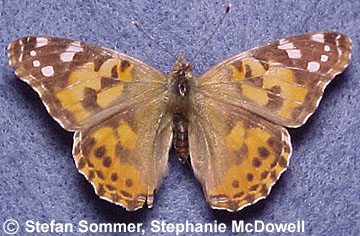
Painted Lady
Family: Nymphalidae
Family Description:
Alternate Common Names: Thistle Butterfly, Cosmopolite, Cosmopolitan.
Note: This and the other Painted Lady butterflies are sometimes grouped in their own genus or subgenus, Cynthia.
Description:
Caterpillar: The caterpillar varies in its appearance. It can be grayish brown ringed with yellow, greenish yellow, or black. It is always striped lengthwise with yellow along each side and covered with branching spines. It reaches a maximum, full-grown length of 1 1/4 inches.
Adult: This is a medium-sized butterfly, with a wingspan of 2 to 2 7/8 inches. The tip of the forewing is slightly elongated and rounded. The upperside is largely pinkish orange to brownish orange, and may be darker at the bases of the wings. The forewing is marked with uneven patches of black, and is solid black, spotted with white, at the tip. The hindwing is marked with a curved row of blue spots, followed by a row of black triangles, and is edged with an orange and black border. Underneath, the forewing is reddish pink towards the base and mottled brown and white towards the tip. The underside of the hindwing is entirely mottled with brown and white, and is marked with four to five blue or black eyespots.
Range:
This butterfly occurs on all of the continents except Australia and Antarctica, and is considered by some to be the world’s most widely distributed butterfly. In North America, it ranges from northern Mexico to the subarctic of Canada for part of the year. It can be found throughout most of Idaho.
Habitat:
It utilizes almost every habitat, particularly open or disturbed areas.
Diet:
Caterpillar: Caterpillars feed on the leaves of a wide variety of plants from over ten families including the sunflower family (Asteraceae), the goosefoot family (Chenopodiaceae), the mallow family (Malvaceae), and the pea family (Fabaceae); thistles (Cirsium spp.) seem to be preferred.
Adult: Butterflies drink flower nectar, most commonly from tall flowers in the sunflower family (Asteraceae). They may also use aphid honeydew for food.
Ecology:
Each caterpillar forms a nest of silk on the topside of host plant leaves. The number of generations of caterpillars each year varies regionally, with most areas having one to three, and with many occurring all year long in the south. Adults overwinter in a physiological state called diapause in the south and where winters are mild; pupae may overwinter, as well. Annually, butterflies migrate north in the spring, sometimes in large numbers; they do not usually exhibit a similar return trip en masse south in the fall. They generally fly from early spring to November.
Reproduction:
Males both perch to wait for and actively patrol in search of receptive females. Perching in the west typically occurs in shrubs located on hilltops, while in the east it occurs on open, bare ground. Females lay green eggs singly on the uppersides of the leaves of host plants.
Conservation:
| Global Rank: |
G5; populations are widespread, abundant, and secure. |
References:
Ferris, C. D. and F. M. Brown. (eds.) 1981. Butterflies of the Rocky Mountain States. Univ. of Oklahoma Press, Norman, Oklahoma, USA, 442 pp.
Opler, P. A., H. Pavulaan, and R. E. Stanford. 1995. Butterflies of North America. Jamestown, North Dakota, USA: Northern Prairie Wildlife Research Center Home Page. http://www.npwrc.usgs.gov/resource/distr/lepid/bflyusa/bflyusa.htm (Version 05Nov98).
Opler, P. A. and A. B.Wright. 1999. A Field Guide to the Western Butterflies. Second Edition. Peterson Field Guide Series. Houghton Mifflin Company, New York, New York, USA, 540 pp.
Pyle, R. M. 1981. National Audubon Society Field Guide to North American Butterflies. Alfred A. Knopf, Inc., New York, New York, USA, 924 pp.
Scott, J. A. 1986. The Butterflies of North America. Stanford University Press, Stanford, California, USA, 583 pp.
Stanford, R. E. and P. A. Opler. 1993. Atlas of Western U.S.A. Butterflies (Including Adjacent Parts of Canada and Mexico). Published by authors, Denver, Colorado, USA, 275 pp.
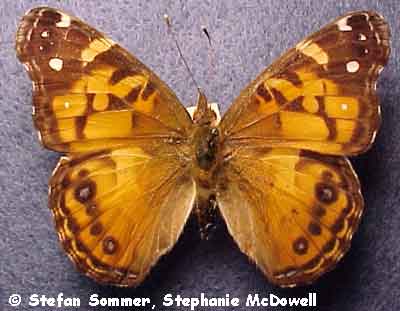
American Lady
Family: Nymphalidae
Family Description:
Alternate Common Names: American Painted Lady, Hunter’s Butterfly, Virginia Lady.
Note: This species was formerly known as Vanessa huntera. This and the other Painted Lady butterflies are sometimes grouped in their own genus or subgenus, Cynthia.
Description:
Caterpillar: The caterpillar ranges in color from white to yellow. It is marked with wide black rings (or half rings, covering the back and part of each side) spotted with reddish orange and/or white, alternating with sections of thin black rings. Each wide black ring bears black branching spines. The caterpillar can reach a maximum, full-grown length of 1 3/8 inches.
Adult: The butterfly is medium to large in size, with a wingspan of 1 3/4 to 2 5/8 inches. The outer edge of the forewing is slightly scalloped, and the wing tip is elongated and squared off. The upperside of the wings is pinkish orange to deep orange. The forewing is marked with uneven patches of black, and the tip is solid black spotted with white. Along the leading edge, about a third of the way in from the tip, is a bar of golden yellow; below the bar is a single white spot in a patch of orange. The hindwing is marked with a curved row of spots, some of which are black and some of which are blue ringed with black, followed by a row of black triangles. Underneath, the forewing is pink towards the base and mottled brown and white towards the tip. The underside of the hindwing is mottled and marbled with brown and white. Near the outer edge is a band of brown marked with two large eyespots.
Range:
This species ranges from southern Canada to Mexico, Central America, and Colombia, for at least part of the year. It occurs in parts of northern and central Idaho.
Habitat:
It can be found in a variety of open areas, such as meadows, gardens, and vacant lots.
Diet:
Caterpillar: Caterpillars feed on the leaves of many species of plants from the sunflower family (Asteraceae), particularly species of everlasting (Gnaphalium spp., Anaphalis spp.) and pussy toes (Antennaria spp.).
Adult: Butterflies drink nectar from a variety of flowers.
Ecology:
Individual young caterpillars live in nests made from plant hairs tied with silk; older ones construct nests of leaves tied with silk. There are two to four generations of caterpillars each year through much of its range, and many all year long in the extreme south. Adults generally fly from April to November. Butterflies may migrate north, but not to the extent of the other Painted lady species. Adult and pupal forms are capable of overwintering in a physiological state called diapause, and this may be the only species of Painted Lady capable of surviving a northern winter.
Reproduction:
Males perch on hilltops in the afternoons and evenings to wait for receptive females. Yellowish green eggs are laid singly on the topsides of the leaves of host plants.
Conservation:
| Global Rank: |
G5; populations are widespread, abundant, and secure. |
References:
Ferris, C. D. and F. M. Brown. (eds.) 1981. Butterflies of the Rocky Mountain States. Univ. of Oklahoma Press, Norman, Oklahoma, USA, 442 pp.
Opler, P. A., H. Pavulaan, and R. E. Stanford. 1995. Butterflies of North America. Jamestown, North Dakota, USA: Northern Prairie Wildlife Research Center Home Page. http://www.npwrc.usgs.gov/resource/distr/lepid/bflyusa/bflyusa.htm (Version 05Nov98).
Opler, P. A. and A. B.Wright. 1999. A Field Guide to the Western Butterflies. Second Edition. Peterson Field Guide Series. Houghton Mifflin Company, New York, New York, USA, 540 pp.
Pyle, R. M. 1981. National Audubon Society Field Guide to North American Butterflies. Alfred A. Knopf, Inc., New York, New York, USA, 924 pp.
Scott, J. A. 1986. The Butterflies of North America. Stanford University Press, Stanford, California, USA, 583 pp.
Stanford, R. E. and P. A. Opler. 1993. Atlas of Western U.S.A. Butterflies (Including Adjacent Parts of Canada and Mexico). Published by authors, Denver, Colorado, USA, 275 pp.
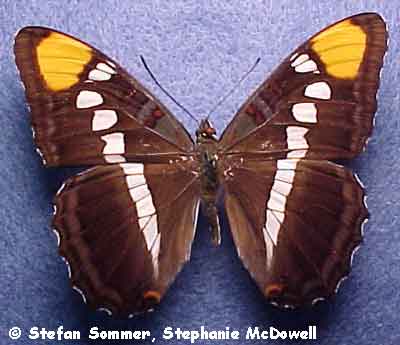
California Sister
Family: Nymphalidae
Family Description:
Note: This species is referred to with the genus name Limenitis by some authors.
Description:
Caterpillar: The caterpillar can reach a maximum length of 1 ž inches, and may appear humpbacked. It can be one of two forms: either greenish on top and brownish underneath, or yellow-orange on top and tan underneath. Both forms have four to six pairs of spines or tubercles on their upper surface.
Adult: This is a large butterfly, with a wingspan of 2 ž to 4 inches. The upperside is dark brown with a large orange spot on the outer tip of the forewing. A whitish stripe runs diagonally across the fore- and hindwings, from the orange spot to the abdomen. Underneath, the wings look like stained glass, with patches of dark brown, beige, light blue, and light orange.
Range:
This species can be found in the southwestern quarter of the U.S. and in Mexico, and rarely in the intermountain west. It has been documented in Idaho only in Bannock County. As the host plant for the caterpillar is oak (Quercus spp.), a non-native genus in Idaho found only where cultivated, this is a highly unlikely species to find in our area.
Habitat:
This species can be found in moist, low areas with oaks (Quercus spp.) and conifers.
Diet:
Caterpillar: Caterpillars feed on the leaves of oak (Quercus spp.).
Adult: Butterflies use fruit, flower nectar, and aphid honeydew for food.
Ecology:
Caterpillars use silk and their own dung pellets to build a rest that hangs from leaves. Typically there are two generations each summer, the second of which overwinters in a physiological state called diapause and then pupates in the spring. In desert mountain habitats there may be only one generation of caterpillars in the summer which then overwinters before pupating. Adults generally fly from April through September, and often perch on the tips of branches in the sun.
Reproduction:
Males seek receptive females by perching or actively patrolling throughout the day. Females lay one egg per leaf on host plants and position it near the leaf’s edge.
Conservation:
| Global Rank: | G5; population levels are secure, but may be of concern in the future. |
References:
Ferris, C. D. and F. M. Brown. (eds.) 1981. Butterflies of the Rocky Mountain States. Univ. of Oklahoma Press, Norman, Oklahoma, USA, 442 pp.
Opler, P. A., H. Pavulaan, and R. E. Stanford. 1995. Butterflies of North America. Jamestown, North Dakota, USA: Northern Prairie Wildlife Research Center Home Page. http://www.npwrc.usgs.gov/resource/distr/lepid/bflyusa/bflyusa.htm (Version 05Nov98).
Opler, P. A. and A. B.Wright. 1999. A Field Guide to the Western Butterflies. Second Edition. Peterson Field Guide Series. Houghton Mifflin Company, New York, New York, USA, 540 pp.
Pyle, R. M. 1981. National Audubon Society Field Guide to North American Butterflies. Alfred A. Knopf, Inc., New York, New York, USA, 924 pp.
Scott, J. A. 1986. The Butterflies of North America. Stanford University Press, Stanford, California, USA, 583 pp.
Stanford, R. E. and P. A. Opler. 1993. Atlas of Western U.S.A. Butterflies (Including Adjacent Parts of Canada and Mexico). Published by authors, Denver, Colorado, USA, 275 pp.
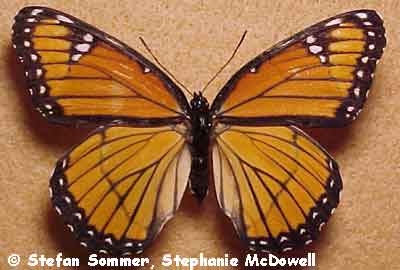
Viceroy
Family: Nymphalidae
Family Description:
Description:
Caterpillar: Caterpillars vary in color but generally are greenish to brown and dappled with white, with a whitish or beige patch on its back in the middle. They look much like a bird dropping and thus are well camouflaged from potential predators. The back has five pairs of small spines, the front end is humped, and the head has two bristly "horns."
Adult: This butterfly is the famous mimic of the well-known Monarch. It is smaller, usually measuring 2½ to 3 inches across the wings, compared to the 3½ to 4 inches of the Monarch. The upperside of the wings is orange and black like the Monarch’s, but the hindwings have a curved, continuous black line, forming a semicircle, a third of the way in from the edge. A black border with white spots outlines the wings. The orange may be more of a light to dark brown in certain parts of its range. The underside is similarly marked, but paler in color.
Range:
This species ranges from Alberta east to the east coast, south to central Mexico, and occurs in patches in the intermountain and southwestern states. In Idaho, it occurs in the southwest and in patches of the central and eastern parts of the state, as well as in an isolated patch of the panhandle.
Habitat:
It is found in open or shrubby areas, including meadows, roadsides, and water edges.
Diet:
Caterpillar: Caterpillars eat the leaves and catkins of willows (Salix spp.) primarily, but may also be found feeding on poplars (Populus spp.) and on some fruit trees (Prunus spp.).
Adult: Butterflies use aphid honeydew, fungi, dung, carrion, and mud for food early in the season and feed on the nectar of flowers in the sunflower family (Asteraceae) later in the summer.
Ecology:
Eggs are well camouflaged on host plant leaves, as they resemble galls commonly found on them. Caterpillars eat the shells of their eggs upon hatching. The young caterpillars eat the tips of leaves while leaving the midribs, which they rest upon. They make a dangling ball of leaf material and dung held together with silk, which hangs from where they are feeding and possibly serves as a distraction to potential predators. Mature caterpillars make a "sleeping bag" (a hibernaculum) out of a rolled leaf tied with silk in which they overwinter, in a physiological state called diapause. There is one generation of caterpillars each summer in the north, two in the middle parts of its range, and four or more in the south. In the case of multiple generations in a single season, only the last generation of caterpillars overwinters. Adults generally fly from April to October. Viceroy butterflies mimic the coloration of Monarchs. Predators find Monarchs distasteful to eat and learn to avoid consuming them, and because Viceroys are similarly colored and patterned, predators avoid them as well.
Reproduction:
Males perch on vegetation well above the ground to wait for receptive females to pass by, or they may actively patrol for them as well. Females lay eggs on the tips of host plant leaves, typically only two to three per plant.
Conservation:
| Global Rank: |
G5; populations are widespread, abundant, and secure. |
References:
Ferris, C. D. and F. M. Brown. (eds.) 1981. Butterflies of the Rocky Mountain States. Univ. of Oklahoma Press, Norman, Oklahoma, USA, 442 pp.
Opler, P. A., H. Pavulaan, and R. E. Stanford. 1995. Butterflies of North America. Jamestown, North Dakota, USA: Northern Prairie Wildlife Research Center Home Page. http://www.npwrc.usgs.gov/resource/distr/lepid/bflyusa/bflyusa.htm (Version 05Nov98).
Opler, P. A. and A. B.Wright. 1999. A Field Guide to the Western Butterflies. Second Edition. Peterson Field Guide Series. Houghton Mifflin Company, New York, New York, USA, 540 pp.
Pyle, R. M. 1981. National Audubon Society Field Guide to North American Butterflies. Alfred A. Knopf, Inc., New York, New York, USA, 924 pp.
Scott, J. A. 1986. The Butterflies of North America. Stanford University Press, Stanford, California, USA, 583 pp.
Stanford, R. E. and P. A. Opler. 1993. Atlas of Western U.S.A. Butterflies (Including Adjacent Parts of Canada and Mexico). Published by authors, Denver, Colorado, USA, 275 pp.
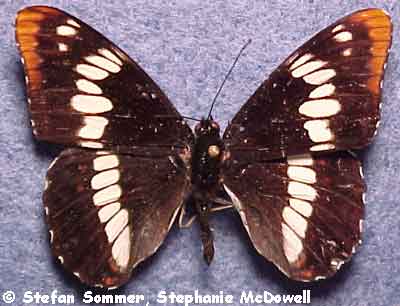
Lorquin’s Admiral
Family: Nymphalidae
Family Description:
Alternate Common Name: Orange-Tip Admiral.
Description:
Caterpillar: The caterpillar is dark to light greenish brown, mottled with white toward the front, with light bands on the sides and a white patch on the back. There are two feathery-looking horns behind the head, a yellowish hump before the white mark, and several bumps on the back.
Adult: This butterfly is fairly large, with a wingspan of 2 to 2 ¾ inches. The upperside is dark brown to black, with an off-white to beige band on either of the body side running diagonally across both the fore- and hindwing. There is a single white spot on the forewing, to the inside of the off-white band. The outermost tip of the forewing is marked with orange. The underside is marked with varying widths of vertical bands of orange, red, brown, and white.
Range:
This is a species of the west coast, ranging from central British Columbia south to southern California, and east as far as western Montana, Idaho, and northern Nevada. In Idaho it ranges throughout the north and center, and in patches of the southwestern corner of the state.
Habitat:
It can be found in a variety of habitats, including forest edges, poplar groves, orchards, river bottoms, and canyons.
Diet:
Caterpillar: Caterpillars feed on the leaves of willows (Salix spp.), cottonwoods and poplars (Populus spp.), and some fruit trees (Prunus spp.).
Adult: Butterflies have a diversified diet, including dung, bird droppings, and flower nectar from species such as the California buckeye (Aesculus californica), yerba santa (Eriodictyon spp.), and privet (Ligustrum spp.).
Ecology:
Young caterpillars overwinter in a physiological state called diapause, immerging in the spring to feed, molt, and eventually pupate. A "sleeping bag", called a hibernaculum, is constructed for overwintering from a leaf rolled with silk. In the northern parts of the range there is typically one generation each year. There may be several in California, in which case only the caterpillars of the last generation overwinter. Adults generally fly from March to Novemeber. They may hybridize with another Limenitis species, Limenitis weidemeyerii, where the ranges of the two species overlap. The butterflies can be aggressive, pursuing anything passing by where they have perched. The name of the species is in honor of Pierre Lorquin, a French butterfly collector from the mid-1800s.
Reproduction:
Males perch to wait for receptive females to fly by, and may occasionally actively patrol for them. Females lay eggs on the topside of the tips of leaves of host plants.
Conservation:
| Global Rank: |
G5; populations are widespread, abundant, and secure. |
References:
Ferris, C. D. and F. M. Brown. (eds.) 1981. Butterflies of the Rocky Mountain States. Univ. of Oklahoma Press, Norman, Oklahoma, USA, 442 pp.
Opler, P. A., H. Pavulaan, and R. E. Stanford. 1995. Butterflies of North America. Jamestown, North Dakota, USA: Northern Prairie Wildlife Research Center Home Page. http://www.npwrc.usgs.gov/resource/distr/lepid/bflyusa/bflyusa.htm (Version 05Nov98).
Opler, P. A. and A. B.Wright. 1999. A Field Guide to the Western Butterflies. Second Edition. Peterson Field Guide Series. Houghton Mifflin Company, New York, New York, USA, 540 pp.
Pyle, R. M. 1981. National Audubon Society Field Guide to North American Butterflies. Alfred A. Knopf, Inc., New York, New York, USA, 924 pp.
Scott, J. A. 1986. The Butterflies of North America. Stanford University Press, Stanford, California, USA, 583 pp.
Stanford, R. E. and P. A. Opler. 1993. Atlas of Western U.S.A. Butterflies (Including Adjacent Parts of Canada and Mexico). Published by authors, Denver, Colorado, USA, 275 pp.
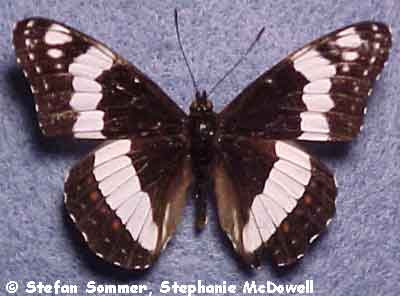
Weidemeyer’s Admiral
Family: Nymphalidae
Family Description:
Alternate Common Name: Western Admiral.
Description:
Caterpillar: The humpbacked caterpillars vary in color, but generally are grayish, mottled with white, and lined with white on the sides. The head is red to brown and the back has a white patch.
Adult: The butterfly is large, with a wingspan of 2 ź to 3 ž inches. It is black on the upperside, with a white band on either side of the body running diagonally across both the fore- and hindwing, and meeting at the tip of the abdomen. The edges of the wings have a single row of white dots, and the black portion of the forewing closest to the body has a single white spot. Underneath, the butterfly is largely white, marked with brown to black lines and a curved, vertical row of orange on the outer edge of the hindwings.
Range:
It ranges from southern Alberta south through the intermountain west down to Arizona and New Mexico, and east to portions of the Dakotas and Nebraska. In Idaho it can be found in the central and southern portions of the state.
Habitat:
These butterflies are found along streams, in woodlands, in aspen groves, on mountainsides, in canyons, and in town.
Diet:
Caterpillar: Caterpillars eat the leaves of willows (Salix spp.), cottonwoods and poplars (Populus spp.), ocean-spray (Holodiscus spp.) and serviceberry (Amelanchier spp.).
Adult: Butterflies feed on flower nectar, tree sap, and carrion.
Ecology:
Young caterpillars overwinter in a physiological state called diapause, immerging in the spring to feed, molt, and eventually pupate. A "sleeping bag", called a hibernaculum, is constructed for overwintering from a rolled leaf tied with silk. In the northern parts of its range there is typically one generation each year. There may be two in the southern parts of its range, in which case only the caterpillars of the second generation overwinter. Adults generally fly from June to September. They may hybridize with another Limenitis species, Limenitis lorquini, where the ranges of the two species overlap. The butterflies actively defend territories.
Reproduction:
Males generally perch to wait for receptive females and very seldom patrol. Females lay eggs singly on the topside of the tips of leaves on host plants.
Conservation:
| Global Rank: |
G5; populations are widespread, abundant, and secure. |
References:
Ferris, C. D. and F. M. Brown. (eds.) 1981. Butterflies of the Rocky Mountain States. Univ. of Oklahoma Press, Norman, Oklahoma, USA, 442 pp.
Opler, P. A., H. Pavulaan, and R. E. Stanford. 1995. Butterflies of North America. Jamestown, North Dakota, USA: Northern Prairie Wildlife Research Center Home Page. http://www.npwrc.usgs.gov/resource/distr/lepid/bflyusa/bflyusa.htm (Version 05Nov98).
Opler, P. A. and A. B.Wright. 1999. A Field Guide to the Western Butterflies. Second Edition. Peterson Field Guide Series. Houghton Mifflin Company, New York, New York, USA, 540 pp.
Pyle, R. M. 1981. National Audubon Society Field Guide to North American Butterflies. Alfred A. Knopf, Inc., New York, New York, USA, 924 pp.
Scott, J. A. 1986. The Butterflies of North America. Stanford University Press, Stanford, California, USA, 583 pp.
Stanford, R. E. and P. A. Opler. 1993. Atlas of Western U.S.A. Butterflies (Including Adjacent Parts of Canada and Mexico). Published by authors, Denver, Colorado, USA, 275 pp.
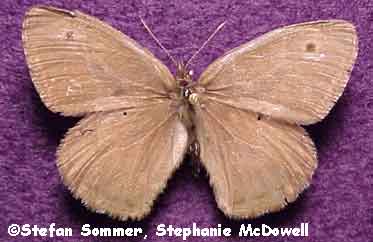
Small Wood-Nymph
Family:Satyridae
Family Description:
Alternate Common Names:Least Wood-Nymph, Dark Wood-Nymph.
Description:
Caterpillar: The caterpillar is yellow to light green, with dark green and yellow stripes along the back and a yellow stripe along each side. The head is green, the back end has two red "tails", and the body is covered with fine white hair.
Adult: The butterfly is medium-sized, with a wingspan of 1 1/4 to 1 7/8 inches. The upperside of the forewing is light to dark brown and marked with one eyespot (in males) or two (in females), in which case the top spot is larger and the bottom spot is noticeably closer to the edge. Underneath, both sexes have two eyespots on the forewing, the lower one being smaller and nearer to the edge. The underside of the hindwing is black to mottled brown, marked with irregular brown lines.
Range:
This species ranges from southern British Columbia, Alberta, and Saskatchewan, south through the northwestern quarter of the U.S., and extending further south through northern Arizona and most of New Mexico. It occurs throughout most of Idaho.
Habitat:
It is commonly found in drier habitats, such as grasslands, sagebrush steppe, chaparral, and pine forests.
Diet:
Caterpillar: Caterpillars feed on grasses (Poaceae).
Adult: Butterflies are known to drink flower nectar from yellow flowers in the sunflower family (Asteraceae) and from the buckwheat family (Polygonaceae).
Ecology:
There is one generation of caterpillars each summer. The young caterpillars do not feed before overwintering in a physiological state called diapause. In spring, they emerge to feed, molt, and eventually pupate. Adults generally fly from early June to October.
Reproduction:
Males actively patrol in search of receptive females. Females lay off-white, barrel-shaped eggs singly on host plants.
Conservation:
| Global Rank: |
G5; populations are widespread, abundant, and secure. |
References:
Ferris, C. D. and F. M. Brown. (eds.) 1981. Butterflies of the Rocky Mountain States. Univ. of Oklahoma Press, Norman, Oklahoma, USA, 442 pp.
Opler, P. A., H. Pavulaan, and R. E. Stanford. 1995. Butterflies of North America. Jamestown, North Dakota, USA: Northern Prairie Wildlife Research Center Home Page. http://www.npwrc.usgs.gov/resource/distr/lepid/bflyusa/bflyusa.htm (Version 05Nov98).
Opler, P. A. and A. B.Wright. 1999. A Field Guide to the Western Butterflies. Second Edition. Peterson Field Guide Series. Houghton Mifflin Company, New York, New York, USA, 540 pp.
Pyle, R. M. 1981. National Audubon Society Field Guide to North American Butterflies. Alfred A. Knopf, Inc., New York, New York, USA, 924 pp.
Scott, J. A. 1986. The Butterflies of North America. Stanford University Press, Stanford, California, USA, 583 pp.
Stanford, R. E. and P. A. Opler. 1993. Atlas of Western U.S.A. Butterflies (Including Adjacent Parts of Canada and Mexico). Published by authors, Denver, Colorado, USA, 275 pp.
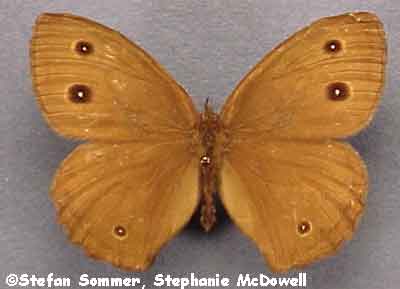
Common Wood-Nymph
Family:Satyridae
Family Description:
Alternate Common Names:Large Wood-Nymph, Blue-Eyed Grayling.
Description:
Caterpillar: The caterpillar is bright green and covered with hair, making it appear fuzzy. The head is green, the length of the body is marked with four yellow or white stripes, and there are two reddish "tails."
Adult: The butterfly is medium to large, with a wingspan of 1 ¾ to 3 inches. Its appearance is variable, but generally it is light to dark brown on the upperside, and light brown underneath. The upperside typically has two large eyespots outlined in yellow on the forewing, which may be lying in a yellowish band. The hindwing may have two or more similar but smaller spots. Underneath may be striped, particularly toward the interior of the wings, and marked with eyespots as above.
Range:
This species is found throughout the southern half of Canada and the entire continental U.S., except for parts of the southwest and Texas. It occurs commonly throughout Idaho.
Habitat:
It is found in open, grassy areas such as fields, meadows, prairies, and open woodlands.
Diet:
Caterpillar: Caterpillars eat the leaves of various grasses (Poaceae), such as purpletop (Tridens flavus).
Adult: Butterflies use flower nectar, often from alfalfa (Medicago spp.) and spiraea (Spiraea spp.). They are also known to use rotting fruit and tree sap for food.
Ecology:
There is generally one generation of caterpillars each year, with possibly two or more in the southern part of its range. The caterpillars hatch close to the end of the growing season and do not feed; instead, they enter a physiological state called diapause and overwinter until spring. Upon emergence, they feed, molt, and eventually pupate. Adults generally fly from late May to mid-September.
Reproduction:
Males actively patrol in search of receptive females. Females lay off-white, barrel-shaped eggs typically on the leaves of host plants.
Conservation:
| Global Rank: | G5 populations are widespread, abundant, and secure. |
References:
Ferris, C. D. and F. M. Brown. (eds.) 1981. Butterflies of the Rocky Mountain States. Univ. of Oklahoma Press, Norman, Oklahoma, USA, 442 pp.
Opler, P. A., H. Pavulaan, and R. E. Stanford. 1995. Butterflies of North America. Jamestown, North Dakota, USA: Northern Prairie Wildlife Research Center Home Page. http://www.npwrc.usgs.gov/resource/distr/lepid/bflyusa/bflyusa.htm (Version 05Nov98).
Opler, P. A. and A. B.Wright. 1999. A Field Guide to the Western Butterflies. Second Edition. Peterson Field Guide Series. Houghton Mifflin Company, New York, New York, USA, 540 pp.
Pyle, R. M. 1981. National Audubon Society Field Guide to North American Butterflies. Alfred A. Knopf, Inc., New York, New York, USA, 924 pp.
Scott, J. A. 1986. The Butterflies of North America. Stanford University Press, Stanford, California, USA, 583 pp.
Stanford, R. E. and P. A. Opler. 1993. Atlas of Western U.S.A. Butterflies (Including Adjacent Parts of Canada and Mexico). Published by authors, Denver, Colorado, USA, 275 pp.
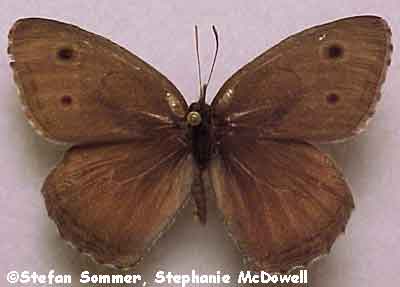
Great Basin Wood-Nymph
Family:Satyridae
Family Description:
Alternate Common Names:Sthenele Wood-Nymph, Scrub Wood-Nymph, Boisduval’s Wood-Nymph.
Description:
Caterpillar: The caterpillar is light green and marked lengthwise with dark green stripes along the back and yellowish stripes along the sides.
Adult: The butterfly is medium-sized, with a wingspan of 1 3/8 to 2 inches. The upperside is brown, with two eyespots that may be edged in yellow on the forewing. The hindwing may or may not have smaller eyespots. Underneath is brown to gray and lightly striped; the hindwing is divided into a darker, inner half and a lighter, outer half by a wavy dark line. Eyespots similar to the upperside are present.
Range:
This species is found only in the west, ranging from southern British Columbia south through California, and east to western Montana, Wyoming, Colorado, and northwestern New Mexico. In Idaho, it occurs primarily in the central and southern portions of the state.
Habitat:
It is found in drier habitats, such as sagebrush steppe, chaparral, and woodlands of oak, pine, or juniper.
Diet:
Caterpillar: Caterpillars feed on the leaves of various grasses (Poaceae).
Adult: Butterflies are known to drink flower nectar from California buckeye (Aesculus californica), white sweet clover (Melilotus alba), and other flowers.
Ecology:
There is one generation of caterpillars each year. The caterpillars hatch close to the end of the growing season and overwinter in a physiological state called diapause, without ever feeding. In spring they emerge to feed, molt, and eventually pupate. Adults generally fly from May through September. Butterflies often rest on tree trunks.
Reproduction:
Males actively patrol to find receptive females. Females lay off-white, round eggs singly on host plants.
Conservation:
| Global Rank: | G5 populations are widespread, abundant, and secure. |
References:
Ferris, C. D. and F. M. Brown. (eds.) 1981. Butterflies of the Rocky Mountain States. Univ. of Oklahoma Press, Norman, Oklahoma, USA, 442 pp.
Opler, P. A., H. Pavulaan, and R. E. Stanford. 1995. Butterflies of North America. Jamestown, North Dakota, USA: Northern Prairie Wildlife Research Center Home Page. http://www.npwrc.usgs.gov/resource/distr/lepid/bflyusa/bflyusa.htm (Version 05Nov98).
Opler, P. A. and A. B.Wright. 1999. A Field Guide to the Western Butterflies. Second Edition. Peterson Field Guide Series. Houghton Mifflin Company, New York, New York, USA, 540 pp.
Pyle, R. M. 1981. National Audubon Society Field Guide to North American Butterflies. Alfred A. Knopf, Inc., New York, New York, USA, 924 pp.
Scott, J. A. 1986. The Butterflies of North America. Stanford University Press, Stanford, California, USA, 583 pp.
Stanford, R. E. and P. A. Opler. 1993. Atlas of Western U.S.A. Butterflies (Including Adjacent Parts of Canada and Mexico). Published by authors, Denver, Colorado, USA, 275 pp.
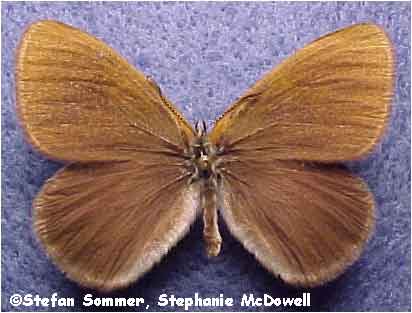
Hayden’s Ringlet
Family:Satyridae
Family Description:
Alternate Common Names:Wyoming Ringlet, Yellowstone Ringlet.
Description:
Caterpillar: The caterpillar is yellow to green and marked lengthwise with white stripes along the back and white and pink stripes along the sides.
Adult: The butterfly is medium-sized, with a wingspan of 1 3/8 to 1 7/8 inches. It is brown to gray and without markings on the upperside. Underneath, the hindwings are marked with a curved row of black eyespots, each edged in yellow and with a white center. The edges of the fore- and hindwings are lined with silver and fringed with white.
Range:
This species has a very narrow range that spans southeastern Idaho, southwestern Montana, and western Wyoming.
Habitat:
It tends to occur at middle elevations, primarily in meadows, forest openings, and bogs. Generally, males prefer drier sites while females frequent wetter sites.
Diet:
Caterpillar: Caterpillars feed on the leaves of grasses (Poaceae) and possibly sedges (Cyperaceae).
Adult: Butterflies drink flower nectar.
Ecology:
There is one generation of caterpillars each summer. Adults generally fly from the end of June through mid-August. Little is known about its life cycle.
Reproduction:
Males patrol to find receptive females. The sites chosen by females for laying eggs have not been observed or reported.
Conservation:
| Global Rank: | G5 populations are widespread, abundant, and secure. |
References:
Ferris, C. D. and F. M. Brown. (eds.) 1981. Butterflies of the Rocky Mountain States. Univ. of Oklahoma Press, Norman, Oklahoma, USA, 442 pp.
Opler, P. A., H. Pavulaan, and R. E. Stanford. 1995. Butterflies of North America. Jamestown, North Dakota, USA: Northern Prairie Wildlife Research Center Home Page. http://www.npwrc.usgs.gov/resource/distr/lepid/bflyusa/bflyusa.htm (Version 05Nov98).
Opler, P. A. and A. B.Wright. 1999. A Field Guide to the Western Butterflies. Second Edition. Peterson Field Guide Series. Houghton Mifflin Company, New York, New York, USA, 540 pp.
Pyle, R. M. 1981. National Audubon Society Field Guide to North American Butterflies. Alfred A. Knopf, Inc., New York, New York, USA, 924 pp.
Scott, J. A. 1986. The Butterflies of North America. Stanford University Press, Stanford, California, USA, 583 pp.
Stanford, R. E. and P. A. Opler. 1993. Atlas of Western U.S.A. Butterflies (Including Adjacent Parts of Canada and Mexico). Published by authors, Denver, Colorado, USA, 275 pp.
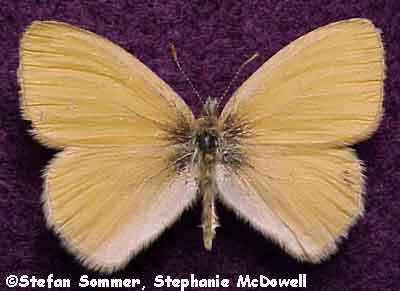
Common Ringlet
Family:Satyridae
Family Description:
Alternate Common Name: Ochre Ringlet.
Note: This is really a complex of species or subspecies, including ochracea, ampelos, california, and others.
Description:
Caterpillar: The caterpillars vary in appearance, but generally are green to brown and striped lengthwise with dark green along the back and lighter shades of green and white along the sides. The head and body appear bumpy and there may be two pinkish "tails."
Adult: This is a medium-sized butterfly, with a wingspan of 1 1/3 to 1 1/2 inches. Its appearance can vary, both between and within localities. The upperside can be brown to orange to cream, and may be marked with a small eyespot at the tip of the forewing. Underneath can be brown to gray to green. The underside of the forewing may be clouded with orange and may have an eyespot. The underside of the hindwing often has a wavy cream-colored line, and may have one or several eyespots.
Range:
The species is holarctic, which means it generally can be found throughout the temperate regions of the Northern Hemisphere. In North America, it occurs from Alaska south to southern California, throughout the western third of the U.S., and east through all of southern Canada and the northern portion of the middle and eastern U.S. It occurs commonly in Idaho.
Habitat:
It can be found in any variety of open habitats, from fields and meadows to open woodlands and tundra.
Diet:
Caterpillar: Caterpillars eat the leaves of various grasses (Poaceae).
Adult: Butterflies drink flower nectar.
Ecology:
There can be one to many generations of caterpillars each summer, with the last brood overwintering in a physiological state called diapause, typically in a mat of dead grass. Chrysalises can be found suspended from grass leaves. The timing of the flight of adults varies within its range, with most flying from May through August or September. Butterflies fly slowly and erratically. In California, butterflies may enter estivation, a sort of summer hibernation.
Reproduction:
Males actively patrol for receptive females. Females lay yellow eggs on or near grasses (Poaceae).
Conservation:
| Global Rank: | G5 populations are widespread, abundant, and secure. |
References:
Ferris, C. D. and F. M. Brown. (eds.) 1981. Butterflies of the Rocky Mountain States. Univ. of Oklahoma Press, Norman, Oklahoma, USA, 442 pp.
Opler, P. A., H. Pavulaan, and R. E. Stanford. 1995. Butterflies of North America. Jamestown, North Dakota, USA: Northern Prairie Wildlife Research Center Home Page. http://www.npwrc.usgs.gov/resource/distr/lepid/bflyusa/bflyusa.htm (Version 05Nov98).
Opler, P. A. and A. B.Wright. 1999. A Field Guide to the Western Butterflies. Second Edition. Peterson Field Guide Series. Houghton Mifflin Company, New York, New York, USA, 540 pp.
Scott, J. A. 1986. The Butterflies of North America. Stanford University Press, Stanford, California, USA, 583 pp.
Stanford, R. E. and P. A. Opler. 1993. Atlas of Western U.S.A. Butterflies (Including Adjacent Parts of Canada and Mexico). Published by authors, Denver, Colorado, USA, 275 pp.
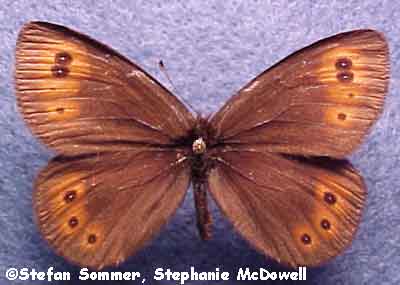
Common Alpine
Family:Satyridae
Family Description:
Alternate Common Name: Butler’s Alpine.
Description:
Caterpillar: The caterpillar is yellowish green, marked lengthwise with a dark green stripe along the back and yellow and brown stripes along the sides. The head is yellowish brown, and there are two short, erect extensions at the rear.
Adult: The butterfly is medium-sized, with a wingspan of 1 ¾ to 2 inches. It is dark brown on the upperside. The forewing has an orange patch at the tip; inside the patch are two black eyespots with white centers. The hindwing has a row of small black spots outlined in orange along the outer edge. Underneath, the wings are brown to gray and similarly marked.
Range:
This species occurs from central Alaska south to northern Oregon, along the Rockies to northern New Mexico, and east to western Manitoba and central Montana. It occurs through much of Idaho.
Habitat:
This species utilizes a wide variety of open habitats, including open woodlands, meadows, bogs, fields, and sagebrush steppe.
Diet:
Caterpillar: Caterpillars feed on grasses (Poaceae); the specific host plant species have not been observed or reported.
Adult: Butterflies drink flower nectar.
Ecology:
There is one generation of caterpillars each summer. Caterpillars overwinter in a physiological state called diapause, and emerge in spring to continue feeding and molting, and eventually to pupate. Adults generally fly from June to July, but may be seen as early as May and as late as October.
Reproduction:
Males actively patrol to search for receptive females. Females lay white eggs, either singly or in small clusters, on grasses (Poaceae) or dead leaves.
Conservation:
| Global Rank: | G5 populations are widespread, abundant, and secure. |
References:
Ferris, C. D. and F. M. Brown. (eds.) 1981. Butterflies of the Rocky Mountain States. Univ. of Oklahoma Press, Norman, Oklahoma, USA, 442 pp.
Opler, P. A., H. Pavulaan, and R. E. Stanford. 1995. Butterflies of North America. Jamestown, North Dakota, USA: Northern Prairie Wildlife Research Center Home Page. http://www.npwrc.usgs.gov/resource/distr/lepid/bflyusa/bflyusa.htm (Version 05Nov98).
Opler, P. A. and A. B.Wright. 1999. A Field Guide to the Western Butterflies. Second Edition. Peterson Field Guide Series. Houghton Mifflin Company, New York, New York, USA, 540 pp.
Pyle, R. M. 1981. National Audubon Society Field Guide to North American Butterflies. Alfred A. Knopf, Inc., New York, New York, USA, 924 pp.
Scott, J. A. 1986. The Butterflies of North America. Stanford University Press, Stanford, California, USA, 583 pp.
Stanford, R. E. and P. A. Opler. 1993. Atlas of Western U.S.A. Butterflies (Including Adjacent Parts of Canada and Mexico). Published by authors, Denver, Colorado, USA, 275 pp.
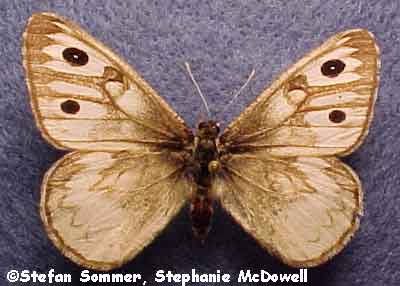
Ridings' Satyr
Family:Satyridae
Family Description:
Alternate Common Name: Grasshopper Satyr.
Description:
Caterpillar: The caterpillar is reddish to light brown and marked lengthwise with white, greenish and brownish stripes. The body has tiny bumps and short white hairs.
Adult: The butterfly has a wingspan of 1 ½ to 2 inches. It is grayish to light brown on the upperside, marked with large, oblong-shaped spots of off-white to very light brown on the outer halves of both the fore- and hindwings. The forewing is marked with one to three blackish eyespots with tiny white centers; the hindwing may also be marked with a small eyespot or black dot. Underneath is grayish to very light brown and appears speckled and marbled. The eyespots from above show through on the underside.
Range:
This species ranges from southern Alberta and Saskatchewan and southwestern Manitoba south through the Rockies and western Plains of the U.S. to central New Mexico and Arizona, and west into Nevada and central California. In Idaho, it has been documented to occur in Owyhee, Lemhi, and Custer counties.
Habitat:
It occurs in open, dry areas such as prairies, grasslands, and sagebrush steppe.
Diet:
Caterpillar: Caterpillars feed on the leaves of blue grama grass (Bouteloua gracilis).
Adult: Butterflies feed rarely; the food of choice is flower nectar, primarily from yellow flowers in the sunflower family (Asteraceae).
Ecology:
There is usually only one new generation of caterpillars each year. Third and fourth instar caterpillars may overwinter in a physiological state called diapause. In a small portion of its range in California (Tuolumne County), the species is biennial. There, adults are only seen in even-numbered years because the caterpillars overwinter twice, the first winter as young caterpillars and the second after having molted several times. Pupation occurs in the spring. Adults generally fly from late May to early August. They hide in vegetation and exhibit an erratic flight when flushed.
Reproduction:
Males perch to wait for receptive females. Females lay white eggs singly on the host grass and other plants.
Conservation:
| Global Rank: | G5 populations are widespread, abundant, and secure. |
References:
Ferris, C. D. and F. M. Brown. (eds.) 1981. Butterflies of the Rocky Mountain States. Univ. of Oklahoma Press, Norman, Oklahoma, USA, 442 pp.
Opler, P. A., H. Pavulaan, and R. E. Stanford. 1995. Butterflies of North America. Jamestown, North Dakota, USA: Northern Prairie Wildlife Research Center Home Page. http://www.npwrc.usgs.gov/resource/distr/lepid/bflyusa/bflyusa.htm (Version 05Nov98).
Opler, P. A. and A. B.Wright. 1999. A Field Guide to the Western Butterflies. Second Edition. Peterson Field Guide Series. Houghton Mifflin Company, New York, New York, USA, 540 pp.
Pyle, R. M. 1981. National Audubon Society Field Guide to North American Butterflies. Alfred A. Knopf, Inc., New York, New York, USA, 924 pp.
Scott, J. A. 1986. The Butterflies of North America. Stanford University Press, Stanford, California, USA, 583 pp.
Stanford, R. E. and P. A. Opler. 1993. Atlas of Western U.S.A. Butterflies (Including Adjacent Parts of Canada and Mexico). Published by authors, Denver, Colorado, USA, 275 pp.

Chryxus Arctic
Family:Satyridae
Family Description:
Note: This is really a complex made up of several species or subspecies, including chryxus, strigulosa, and calais.
Description:
Caterpillar: The caterpillar is greenish to brownish green, covered with reddish hair, and striped lengthwise along the body with a number of different colored stripes, including yellowish, white, and brownish. The yellowish head is striped with brown. It can reach a maximum length of 1 ź inches.
Adult: The butterfly is medium-sized, with a wingspan of 1 ž to 2 inches, and it varies in appearance. The upperside can be off-white, yellowish, orangish, or brownish orange, possibly bordered by gray or brown. Typically it is marked with one to several small, dark eyespots on the forewing and one or two on the hindwing. Males have a stigma (region of scent scales used in attracting females) on the forewing that often appears as a dark cloudy area near the center. Underneath, the forewing is orangish to light brown; the eyespots from above show through, and it may be additionally marked with a dark to faint irregular line. The hindwing is mottled black, brown, gray and white, and marked with one small dark eyespot and possibly a wide, brownish band of color across the center.
Range:
This species ranges from eastern Alaska and the Yukon Territory across Canada to southern Quebec; in the U.S., it ranges from Washington along the Rockies to northern New Mexico. It also occurs in central California and in parts of Utah, Nevada, and the Great Lakes region. It can be found through much of Idaho.
Habitat:
It occurs in a variety of habitats, including tundra, forest openings, meadows, northern prairies, and rocky slopes.
Diet:
Caterpillar: Caterpillars feed on select grasses (Poaceae) such as poverty oat-grass (Danthonia spicata) and Idaho fescue (Festuca idahoensis).
Adult: Butterflies drink flower nectar. They are often found "puddling" at muddy seeps where they gather salts and nutrients by sipping moisture.
Ecology:
There is one new generation of caterpillars each summer in most locations. Young caterpillars overwinter in a physiological state called diapause. They emerge in spring to feed and molt, then enter diapause again for a second winter, this time as grown or nearly grown caterpillars. The process can be synchronized in certain populations, resulting in the appearance of adults only every other year in some locations. Adults generally fly from the first of May through August.
Reproduction:
Males perch to wait for receptive females. Females lay eggs singly on grasses (Poaceae).
Conservation:
| Global Rank: | G5 populations are widespread, abundant, and secure. |
References:
Ferris, C. D. and F. M. Brown. (eds.) 1981. Butterflies of the Rocky Mountain States. Univ. of Oklahoma Press, Norman, Oklahoma, USA, 442 pp.
Opler, P. A., H. Pavulaan, and R. E. Stanford. 1995. Butterflies of North America. Jamestown, North Dakota, USA: Northern Prairie Wildlife Research Center Home Page. http://www.npwrc.usgs.gov/resource/distr/lepid/bflyusa/bflyusa.htm (Version 05Nov98).
Opler, P. A. and A. B.Wright. 1999. A Field Guide to the Western Butterflies. Second Edition. Peterson Field Guide Series. Houghton Mifflin Company, New York, New York, USA, 540 pp.
Pyle, R. M. 1981. National Audubon Society Field Guide to North American Butterflies. Alfred A. Knopf, Inc., New York, New York, USA, 924 pp.
Scott, J. A. 1986. The Butterflies of North America. Stanford University Press, Stanford, California, USA, 583 pp.
Stanford, R. E. and P. A. Opler. 1993. Atlas of Western U.S.A. Butterflies (Including Adjacent Parts of Canada and Mexico). Published by authors, Denver, Colorado, USA, 275 pp.
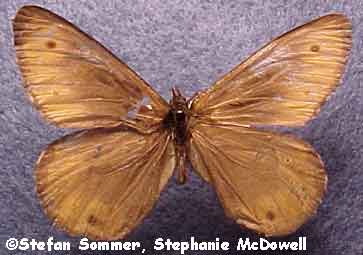
Jutta Arctic
Family:Satyridae
Family Description:
Alternate Common Name: Forest Arctic.
Description:
Caterpillar: The caterpillar is greenish, covered with red hairs, and striped lengthwise with green, brown and white stripes. The head is reddish brown, or greenish and dotted with brown.
Adult: The butterfly has a wingspan of about two inches, and is variable in appearance. The upperside is grayish to olive brown, with lighter colored veins. Both the fore- and hindwings are marked with several dark eyespots; the spots are either ringed with, or lie in a wide band of, hazy yellowish orange. Males have a stigma (region of scent scales used in attracting females) which appears as an area of dark shading near the center of the forewing. Underneath, the forewing is grayish brown and marked with eyespots; the hindwing is mottled with gray, brown, and black, and may have an irregular, wide band of color across the center of the wing.
Range:
This species is holarctic, which means it occurs in the northern temperate regions of the entire Northern Hemisphere. Specifically in North America, it occurs in Alaska, through most of Canada, and in the Rocky Mountains, the northern portions of the Great Lakes states, and Maine. In Idaho, it has been documented to occur in Lemhi, Clark, and Madison Counties.
Habitat:
It occurs in wet spruce-sphagnum bogs and tundra, and in grassy lodgepole-pine forests.
Diet:
Caterpillar: Caterpillars feed on the leaves of sedges such as cotton grass (Eriophorum spissum).
Adult: Butterflies drink flower nectar.
Ecology:
There is one new generation of caterpillars each summer in most locations. Young caterpillars overwinter in a physiological state called diapause. They emerge in spring to feed and molt, then enter diapause again for a second winter, this time as grown or nearly grown caterpillars. The process can be synchronized in certain populations, resulting in the appearance of adults only every other year in some locations. Adults generally fly from the end of June to August.
Reproduction:
Males perch and occasionally patrol for receptive females. Females lay eggs near their host plants.
Conservation:
| Global Rank: | G5 populations are widespread, abundant, and secure. |
References:
Ferris, C. D. and F. M. Brown. (eds.) 1981. Butterflies of the Rocky Mountain States. Univ. of Oklahoma Press, Norman, Oklahoma, USA, 442 pp.
Opler, P. A., H. Pavulaan, and R. E. Stanford. 1995. Butterflies of North America. Jamestown, North Dakota, USA: Northern Prairie Wildlife Research Center Home Page. http://www.npwrc.usgs.gov/resource/distr/lepid/bflyusa/bflyusa.htm (Version 05Nov98).
Opler, P. A. and A. B.Wright. 1999. A Field Guide to the Western Butterflies. Second Edition. Peterson Field Guide Series. Houghton Mifflin Company, New York, New York, USA, 540 pp.
Pyle, R. M. 1981. National Audubon Society Field Guide to North American Butterflies. Alfred A. Knopf, Inc., New York, New York, USA, 924 pp.
Scott, J. A. 1986. The Butterflies of North America. Stanford University Press, Stanford, California, USA, 583 pp.
Stanford, R. E. and P. A. Opler. 1993. Atlas of Western U.S.A. Butterflies (Including Adjacent Parts of Canada and Mexico). Published by authors, Denver, Colorado, USA, 275 pp.
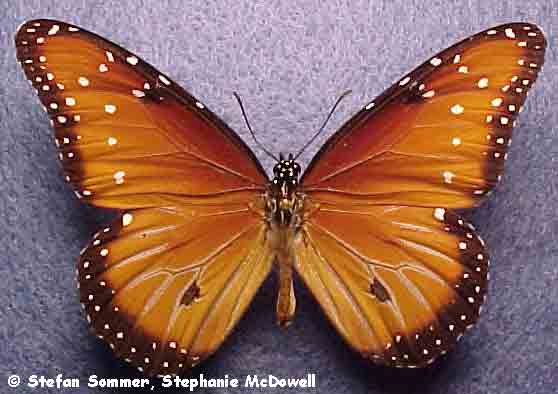
Queen
Sub-Family: Danaidae
Sub-Family Description: Milkweed Butterflies
Description:
Caterpillar: The caterpillar is brightly colored to discourage potential predators. It is black and marked with yellowish white rings in sets of three. It is also dotted with greenish yellow on the back and along the bottom edge of each side. There are three pairs of long filaments, resembling antennae: two towards the front and one at the rear. It reaches an average, full-grown length of two inches.
Adult: This is a large butterfly, with a wingspan of 3 to 3 7/8 inches. It is reddish brown on the upperside, edged with a dark brownish black border. The wing veins are outlined thinly in black. The forewing is spotted with white on the outer half, and there are two rows of smaller white dots in the dark border. The border of the hindwing may also have a few tiny white dots, and there may be white faintly clouding the wing veins (western individuals). Males have a patch of darker scent scales near the center of the hindwing. Underneath is colored and marked similarly, although the white dots may be more pronounced and the veins on the underside of the hindwing may be outlined thickly in black.
Range:
This species is a resident of southern California and Florida south to South America. It migrates north each year into portions of the U.S. as far north as northern Nevada, northern Idaho, southern North Dakota, and southern Iowa, and along the east coast north as far as North Carolina.
Habitat:
It occurs in open areas such as fields, open woodlands, and deserts.
Diet:
Caterpillar: Caterpillars feed on the stems, leaves, and flowers of various species of milkweeds (Asclepias spp., Sarcostemma spp.).
Adult: Butterflies drink flower nectar, often from milkweeds. They may also obtain moisture and salts from mud.
Ecology:
There are several generations of caterpillars occurring all year long in the southern part of its range, and fewer are produced in the north. Queen caterpillars and butterflies, like the Monarch, are distasteful to most predators, due to noxious compounds obtained from feeding on milkweeds. Potential predators learn to avoid the brightly colored caterpillars and adults. Other "tasty" butterfly species, such as the dark Viceroy subspecies in the south, have come to mimic the Queen’s color pattern in order to take advantage of this predator avoidance. Butterflies may migrate northward in large numbers, and roost together in trees. Adults generally fly from July to August. The Queen can not survive freezing temperatures.
Reproduction:
Males actively patrol in search of receptive females. They produce pheromones during courtship, which they direct towards the female using a brush (hair pencil) located at the tip of the abdomen. Females lay light green or white eggs singly on the stems, leaves, and flower buds of host plants.
Conservation:
| Global Rank: | G5 populations are widespread, abundant, and secure. |
References:
Ferris, C. D. and F. M. Brown. (eds.) 1981. Butterflies of the Rocky Mountain States. Univ. of Oklahoma Press, Norman, Oklahoma, USA, 442 pp.
Opler, P. A., H. Pavulaan, and R. E. Stanford. 1995. Butterflies of North America. Jamestown, North Dakota, USA: Northern Prairie Wildlife Research Center Home Page. http://www.npwrc.usgs.gov/resource/distr/lepid/bflyusa/bflyusa.htm (Version 05Nov98).
Opler, P. A. and A. B.Wright. 1999. A Field Guide to the Western Butterflies. Second Edition. Peterson Field Guide Series. Houghton Mifflin Company, New York, New York, USA, 540 pp.
Pyle, R. M. 1981. National Audubon Society Field Guide to North American Butterflies. Alfred A. Knopf, Inc., New York, New York, USA, 924 pp.
Scott, J. A. 1986. The Butterflies of North America. Stanford University Press, Stanford, California, USA, 583 pp.
Stanford, R. E. and P. A. Opler. 1993. Atlas of Western U.S.A. Butterflies (Including Adjacent Parts of Canada and Mexico). Published by authors, Denver, Colorado, USA, 275 pp.
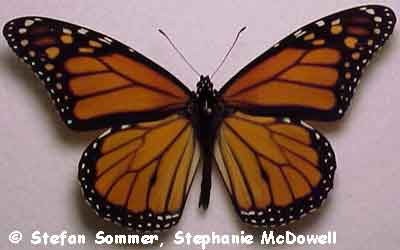
Monarch
Family:Danaidae.
Family Description:
Idaho's State Insect:
The Monarch Butterfly (Danaus plexippus) was adopted as the state insect by the state legislature in 1992.
Description:
Caterpillar: The caterpillar is very colorful and eye-catching. It is striped vertically with black, white, and yellow, and has two long filaments in front and two shorter filaments on the rear.
Adult: The butterfly is large, with a wingspan of 3½ to 4 inches. The upperside is bright orange and marked with black, both along the wing borders and the wing veins. The outer wing border is dotted with white. The outermost tip of the forewing is spotted with orange and white. The hindwing is marked with black veins only, and is lacking the continuous curved black line present on Viceroys. Underneath is paler orange but similarly marked.
Range:
This species is found throughout North America, from the southern two-thirds of Canada south through the U.S., Mexico, Central and South America. It also occurs in Australia, Hawaii, and other islands of the Pacific. In Idaho, it occurs through most of the state.
Habitat:
Habitats include a variety of open places, including meadows, fields, and valley bottoms.
Diet:
Caterpillar: Caterpillars feed on the leaves and flowers of milkweeds (Asclepius spp.) and dogbane (Apocynum spp.).
Adult: Butterflies drink flower nectar from milkweeds, members of the sunflower family (Asteraceae), and other flowers.
Ecology:
A great deal is known about the biology of Monarchs. In most of its range in North America, there can be several generations each summer, and as many as six in the south. Certain populations, in Florida, southern Texas, and southeastern California, may breed all year. Monarchs in temperate locations migrate thousands of miles to overwintering sites located primarily in California and Mexico, or along the Gulf or Atlantic coasts. The migrating butterflies roost in trees as night, and may form huge groups in trees at overwintering sites. In spring, the butterflies head back up north, mating before or along the journey. Females lay eggs on the way, and it is the offspring which complete the journey.
Monarch caterpillars and butterflies are distasteful to most predators, due to compounds retained in the body obtained from feeding on milkweeds. Potential predators learn to avoid the brightly colored caterpillars and adults; other "tasty" butterfly species, such as the Viceroy, have come to appear similarly to take advantage of the Monarch’s warning coloring.
Reproduction:
Males actively patrol in search of receptive females. Females lay eggs singly on the undersides of host plant leaves, and sometimes on the stems or flowers.
Conservation:
| Global Rank: | G5 populations are widespread, abundant, and secure. Some critical overwintering sites in California and Mexico require protection to ensure the continued abundance of the species in our area. |
References:
Ferris, C. D. and F. M. Brown. (eds.) 1981. Butterflies of the Rocky Mountain States. Univ. of Oklahoma Press, Norman, Oklahoma, USA, 442 pp.
Opler, P. A., H. Pavulaan, and R. E. Stanford. 1995. Butterflies of North America. Jamestown, North Dakota, USA: Northern Prairie Wildlife Research Center Home Page. http://www.npwrc.usgs.gov/resource/distr/lepid/bflyusa/bflyusa.htm (Version 05Nov98).
Opler, P. A. and A. B.Wright. 1999. A Field Guide to the Western Butterflies. Second Edition. Peterson Field Guide Series. Houghton Mifflin Company, New York, New York, USA, 540 pp.
Pyle, R. M. 1981. National Audubon Society Field Guide to North American Butterflies. Alfred A. Knopf, Inc., New York, New York, USA, 924 pp.
Scott, J. A. 1986. The Butterflies of North America. Stanford University Press, Stanford, California, USA, 583 pp.
Stanford, R. E. and P. A. Opler. 1993. Atlas of Western U.S.A. Butterflies (Including Adjacent Parts of Canada and Mexico). Published by authors, Denver, Colorado, USA, 275 pp.
